OUR 14 DAY RED CENTRE ROAD TRIP

Our Red Centre Road Trip. The best spots to visit in Australia’s Red Centre – Uluru, Kata Tjuta, Kings Canyon, West & East MacDonnell Ranges & more.
After 2 cancelled trips in 2020 (thanks covid!), we finally made it to Australia’s Red Centre. A first for myself and a second trip for Chris, we were excited to finally tick this region off our travel bucket list as a couple. There’s a lot to see and do in this part of Australia. But it’s remoteness makes travelling here a little less accessible and a little more expensive. We had read about a drive called the Red Centre Way. From what we could see, this drive, along with a few extra bits, offered the perfect Red Centre itinerary!


Red Centre Road Trip – Day 1: Yulara – Alice Springs
Our first day was a pretty standard travel day, flying from Melbourne to Yulara, arriving at 11.30am. The flight took 2.15hrs and was the fist plane we had been on in over a year. We didn’t realise how much we missed sitting on a plane for hours on end! Flying directly into Ayers Rock Airport, the highlight of our flight was capturing views of Uluru on our descent. We already knew that the next 2 weeks were going to be epic!
After arriving, we passed through the necessary covid screenings before collecting our Toyota Prado from Hertz . The next 5 hours were a little less exciting as we drove the very uneventful 4.5hrs directly to Alice Springs . Apart from seeing a few rouge camels and a brief stop at the Mount Connor Lookout, the drive was very boring! Referred to a ‘Fooluru’, Mount Connor was a pretty impressive sight. We can see how tourists may mistake Mt Connor for Uluru… well, kinda!
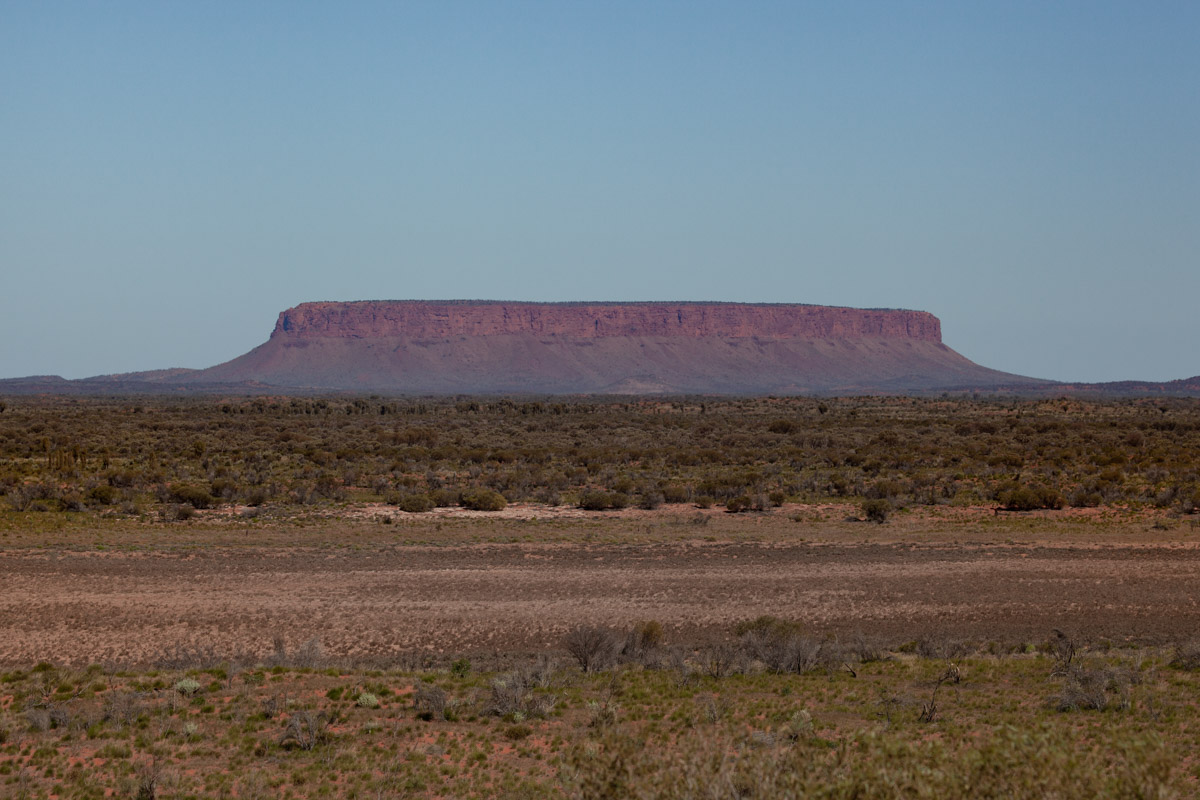
We arrived at our very cute accommodation ‘Nature’s Delight Granny Flat’ in Alice Springs . After meeting our host Emma, we unloaded our car and stocked up on food and beer for the next few days. Day one ended with a little BBQ for dinner and the first of many ‘holiday beers’.
Red Centre Road Trip – Day 2: Alice Springs – Emily Gorge – Jessie Gorge – Trephina Gorge, East MacDonnell Ranges
To be perfectly honest, there wasn’t much that interested us in and around Alice Springs . We generally shy away from towns and cities as wildlife and the outdoors are what we love the most. So we kicked off our second day with an early morning visit to the Olive Pink Botanic Gardens .
Olive Pink Botanical Gardens
Olive Pink Botanic Gardens are not your typical botanical gardens. There was no lush green grass or manicured gardens here. Instead, they were replaced with red rocky hills and dry native plants. A perfect reflection of environment we were in. We arrived at 8am as the gates opened, hoping to spot some native birdlife and Black-footed Rock Wallabies. The gardens were actually quite small, but packed a decent punch! For anyone wanting to see Black-footed wallabies, we recommend climbing up Tharrarletneme (Annie Meyers Hill). Not only did we see a mob of Euro’s (Wallaroo’s) bouncing by, we also saw dozens of Black-footed Rock Wallabies. We got get pretty close to some, who where warming up in the morning sun. But others were a bit skittish as they protected their little joey’s snuggling in their pouches.

We found numerous native flowers and some beautiful birdlife too. These included Australian Ringneck, Western Bower Birds and Budgies, just to name a few. For us, it was a brilliant start to our day and our Red Centre road trip!
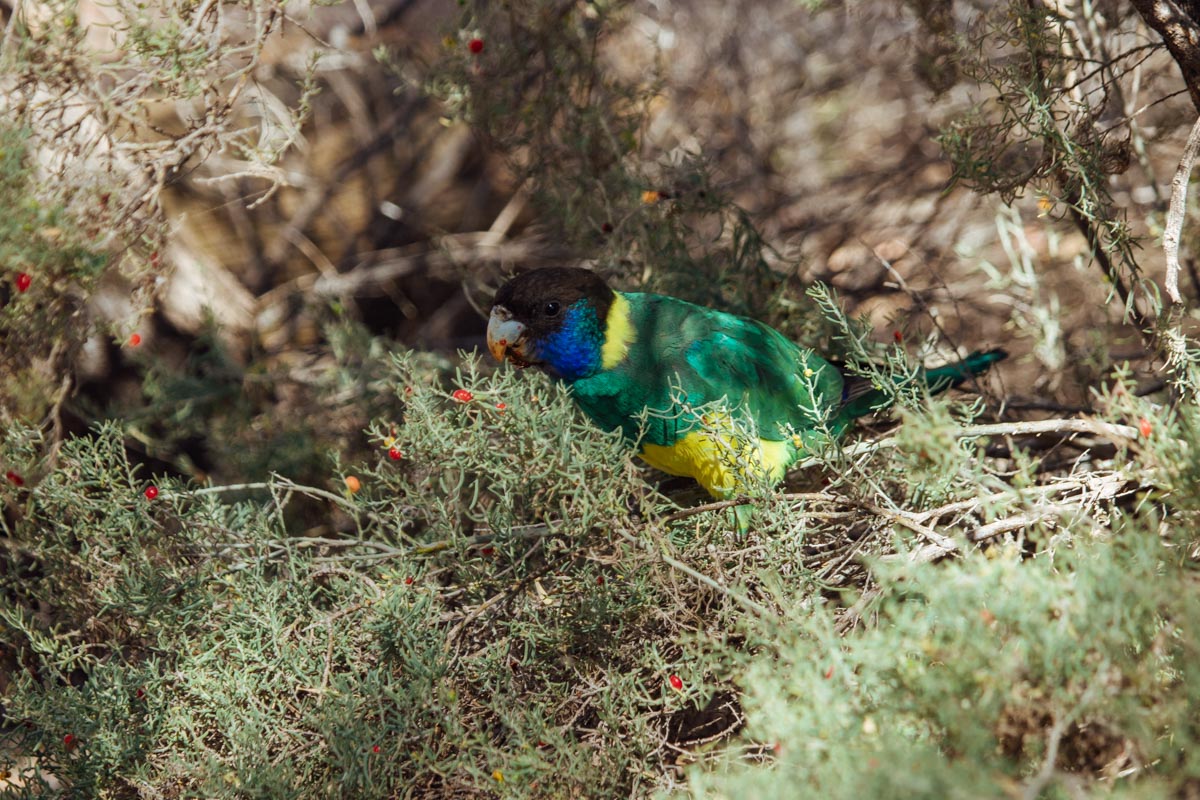
**Read the full blog: Olive Pink Botanic Garden – A must see for wildlife lovers in Alice Springs !
Emily Gap & Jessie Gap
Our next stop was Trephina Gorge in the East MacDonell Ranges, a short drive from Alice Springs . But we made 2 brief stops at Emily Gap & Jessie Gap along the way. Both gaps are small spiritual sites and were nice and peaceful, with no one else around. We walked along the dry river beds at both which didn’t take long. It’s possible to see rock art at Emily Gap. However as these are both sacred sites, photos are restricted at some points. We saw loads of colourful budgies here, which kept us and our cameras busy! But the highlight of the drive though was passing a Perentie to the side of the road. Perentie are actually the largest Monitor Lizard (Goanna) native to Australia and this guys was particularly photogenic!
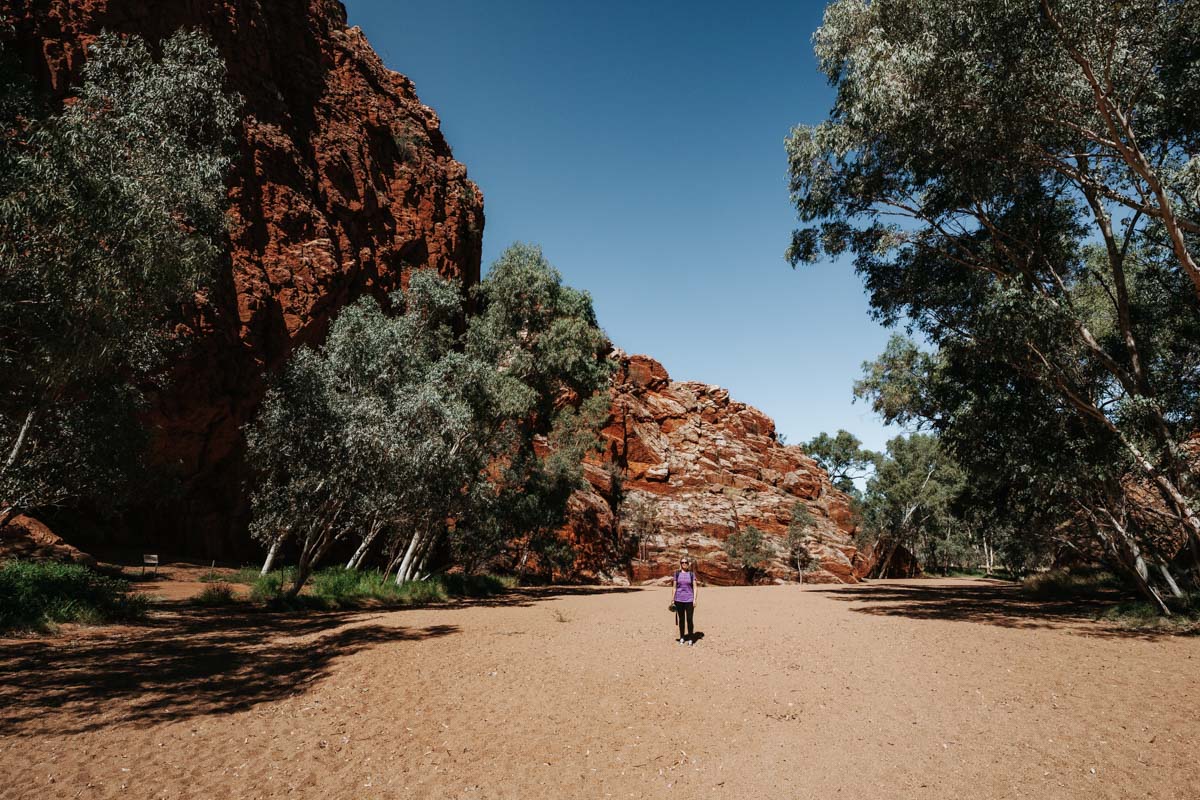
Trephina Gorge – East MacDonell Ranges
Arriving at Trephina Gorge we found a place to park and pitch our tent at Trephina Gorge Campground. This was the bigger of the 3 tent friendly campgrounds. It offered better valley views and was located closer to the trailhead of a few different walks.
There were a number of walks available in the area and after settling in, we set off on the Trephina Gorge Walk. Wow, what a stunning start to our visit to the East MacDonnell Ranges! The 1hr loop offered stunning views over the deep red cliffs and dry river bed below, totally exceeding our expectations. After soaking in the vistas, we continued onto the Panorama Walk. This walk also offered beautiful views and from its peak, was a great place to watch the sunset. On top of the stunning outback scenery, there was an abundance of birdlife around too.

**Read the full blog: Trephina Gorge – East MacDonnell Ranges
Red Centre Road Trip – Day 3: Trephina Gorge – Simpsons Gap – Standley Chasm
After an early morning spent bird watching at a small water hole, we made our way back to Alice Springs. The next stop on our Red Centre road trip was the more popular West MacDonnell Ranges. So we stocked up on food, ice and refuelled, as we would have no access to shops for a while.
Simpsons Gap
Our first stop in the West MacDonnell Ranges was Simpsons Gap , a short drive from the centre of Alice Springs. Simpsons Gap is a beautiful gorge, home to a permanent water hole with dramatic red cliffs towering above. As we stepped out of our car, we followed a well maintained path down to the water filled gorge. This was a really beautiful spot to spend some time and a perfect place to enjoy a picnic. When we arrived, there were very few other people around, giving us the opportunity to really soak in our surroundings.

Standley Chasm
After spending some time at Simpsons Gap , we continued on our Red Centre road trip to Standley Chasm , a privately owned and operated Aboriginal enterprise. The property consists of a grassy camp area, cafe, ablution block, 2 hot water showers and the chasm itself. Chris ventured off to check out the chasm before it closed for the day. There were no people down at the chasm, however as it was getting darker, he didn’t spend too much time there. The campsite was reasonably busy, but as most campers were Larapinta Trail hikers, we experienced a very quiet night.
Red Centre Road Trip – Day 4: Standley Chasm – Ellery Creek Big Hole
We visited the chasm as it opened at 8am, before the day trippers arrived. And we only had to share the experience with the outrageously strong wind which tunnelled through the chasm. The chasm is essentially another gorge, with 80m of sheer red rock face towering above. It was every bit as beautiful as we imagined and we would loved to have spent more time there. However the freezing cold wind gusts killed the moment. The chasm was in full shade, which we preferred in some ways as it eliminated any shadows in our photos. But the shade also made it pretty chilly!

Most people only visit the chasm and leave. But we were keen to explore the area a little more. So we hiked to a few viewpoints above and around the chasm for a different perspective. We first hike up part of section 4 of the Larapinta Trail to a lookout. The views were nice, but we wanted more! Following the path back towards the chasm, we found the trail leading to section 3 of the Larapinta Trail. We took the uphill trail until we reached a peak, which offer stunning views back over the West MacDonnell Ranges. We had read that this section of the Larapinta Trail is one of the most scenic and we can totally see why. However the wind from up there was relentless.

Before we left, we popped back down to the chasm. It was noon and we’d been told this was the best time to photograph the chasm as it would be in full sun. The chasm was now glowing a rich red, quite the contrast to the shaded colours we’d seen earlier. At this stage, we were wondering if the West MacDonnell Ranges could get much better?
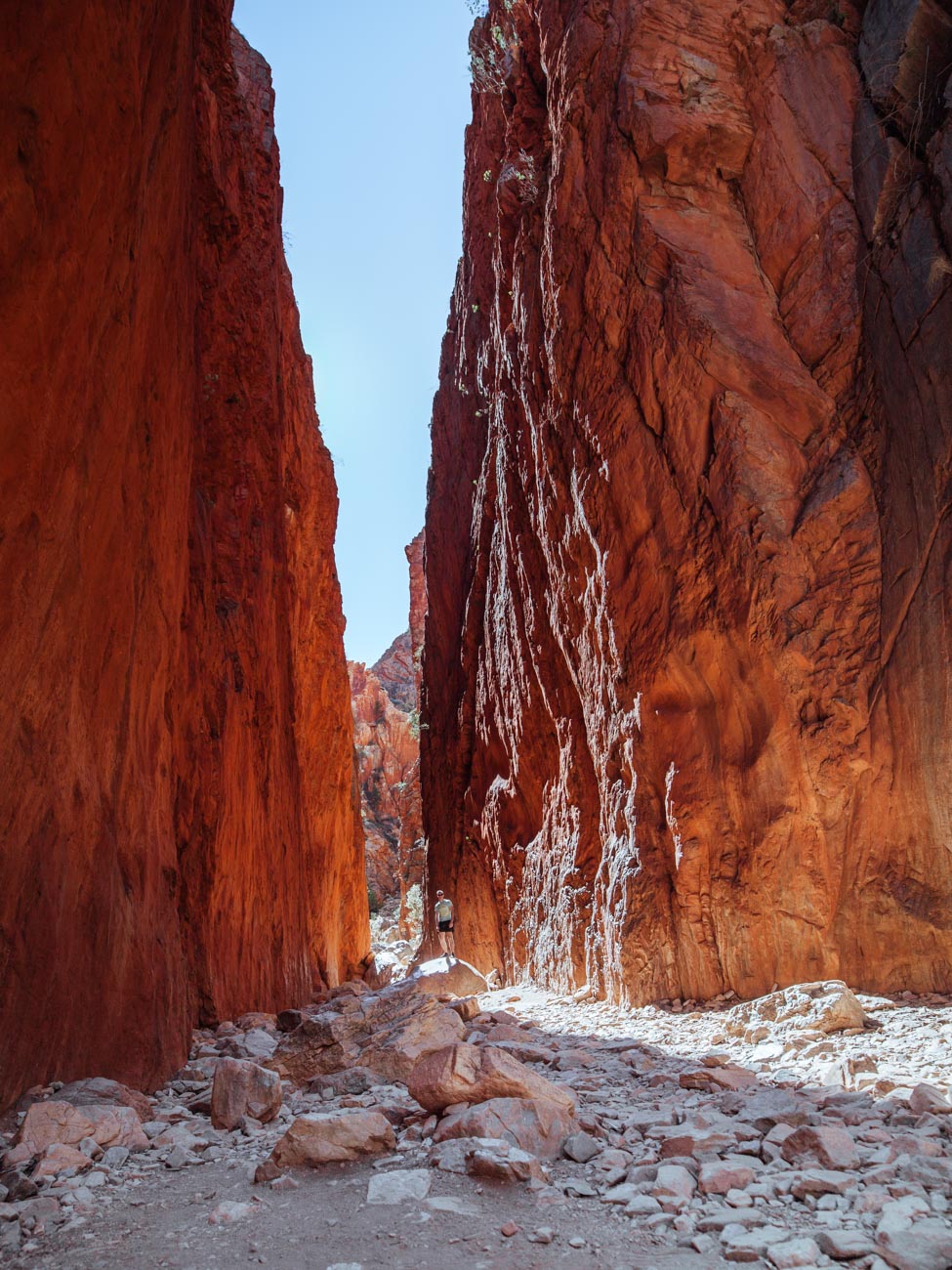
Ellery Creek Big Hole
Continuing on our Red Centre road trip, we drove the short 40mins to Ellery Creek Big Hole . After claiming one of the few remaining campsites and setting up camp, we made our way down to the waterhole late afternoon. Again, we stood in front of another stunning water filled gorge, surrounded by native trees and birds. Ellery Creek is a popular spot for day trippers, especially in the hotter months. It was a little busy down by the waterhole and way too cold to swim. So we decided to hike the nearby Dolomites Trail. This was a really nice hike with some more beautiful scenery.
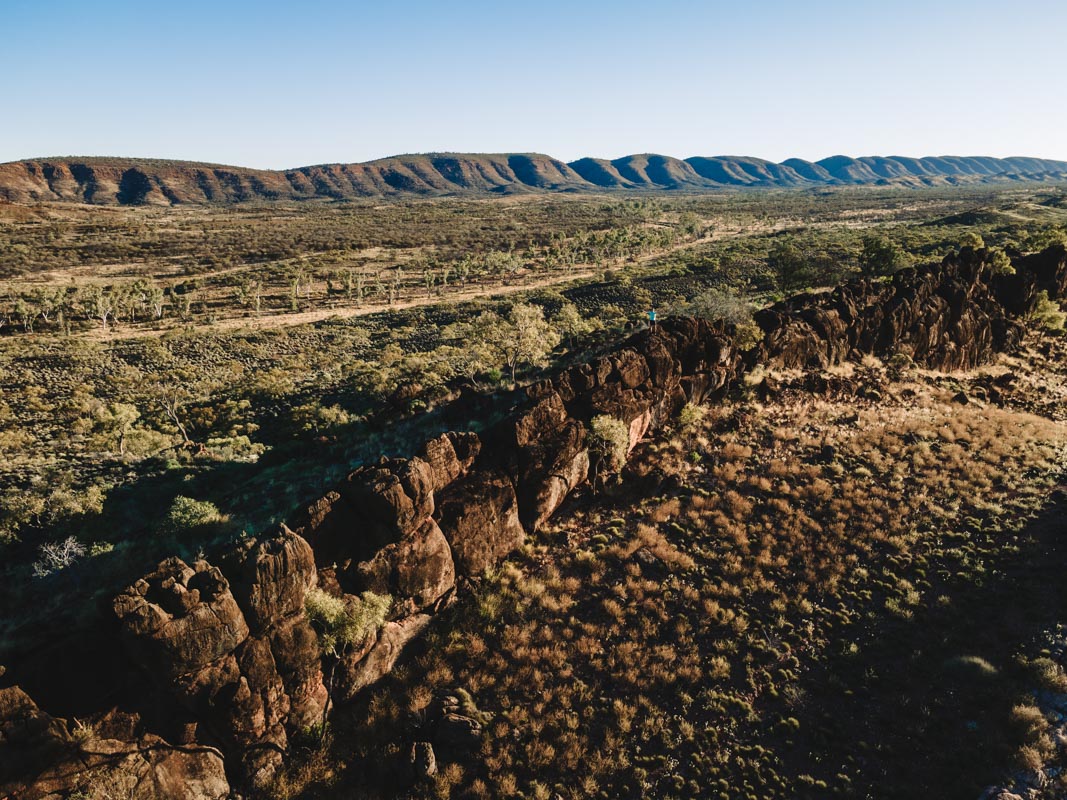
After capturing some epic views along the trail, we saw our first pair of Major Mitchell Cockatoos. These guys were so beautiful and as avid wildlife lovers, we spent some time following them around. As with everywhere we’d visited on our Red Centre road trip, the birdlife here was pretty good. It was the perfect way to end our day.

Red Centre Road Trip Day 5: Ellery Creek Big Hole – Serpentine Gorge – Ormiston Gorge – Fink River
One of the best things about camping for us, is that we tend to wake up early without an alarm. This is particularly helpful when we want to go sightseeing and beat the crowds. If you camp at Ellery Creek , we recommend heading down to the water early in the morning. Chances are you’ll have this magical place all to yourself, just as we did. Chris even braved the freezing cold water and went in for a morning dip…. although the water was so cold he didn’t make it the whole way in! There was no wind when we first arrived, but it didn’t take long for that to change!
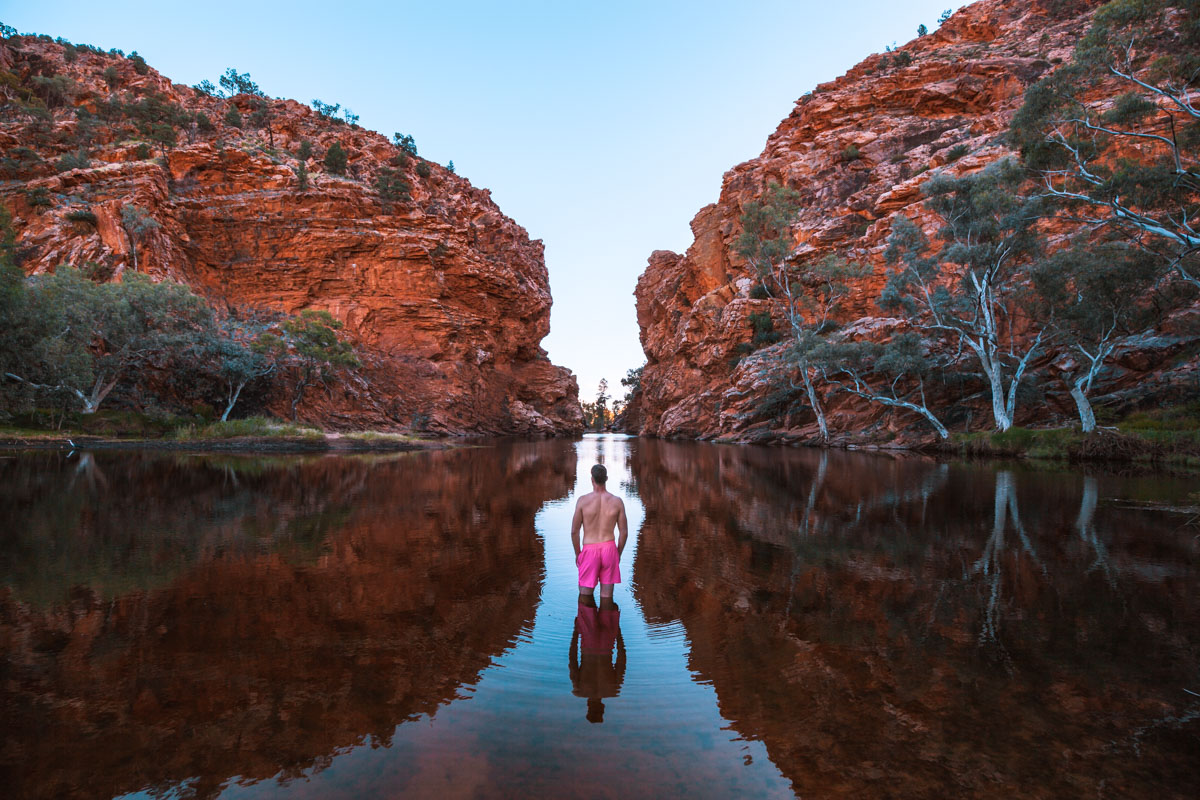
After drying off, we packed up camp and continued on our Red Centre road trip. We were only a few kms down the road when we saw a Dingo in the bushes. This was a first for me; Chris had seen some years before on Fraser Island. We were both pretty excited to see a wild Dingo, as we’d only heard them howling during the night so far.
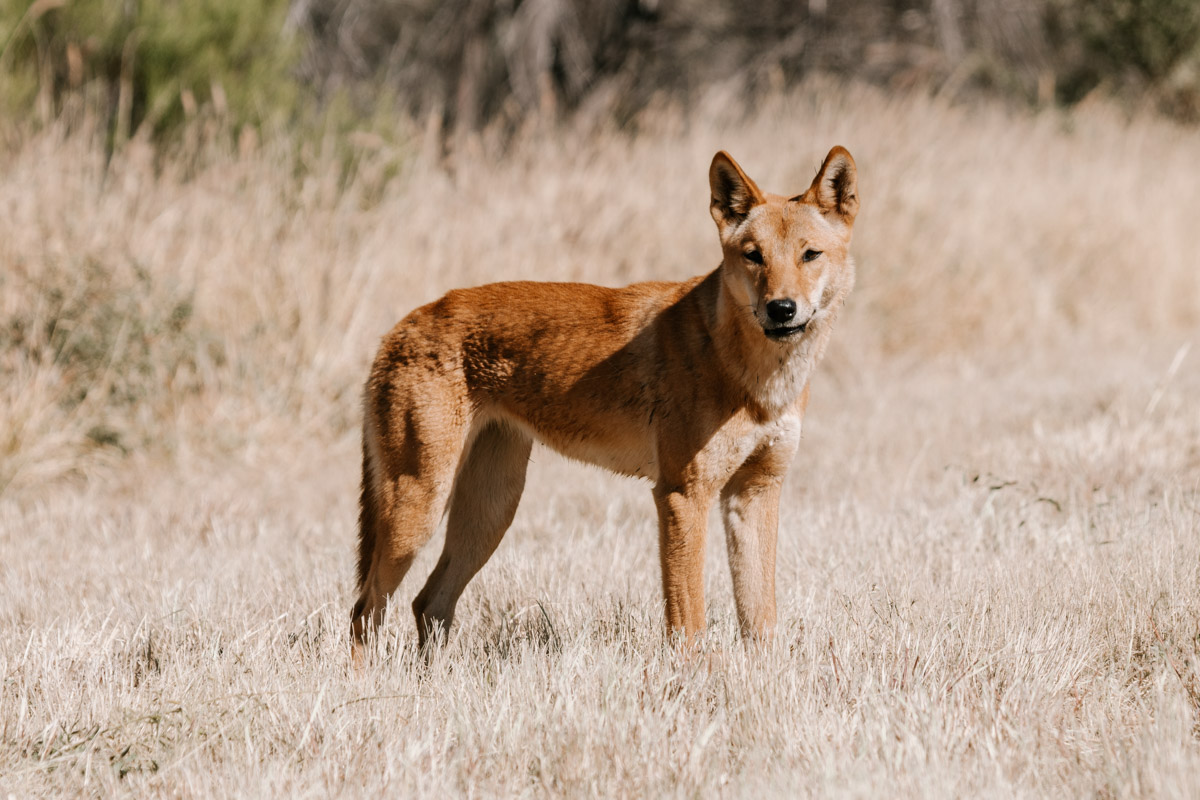
Serpentine Gorge
Our next stop was Serpentine Gorge . By the time we reached the gorge, the soft morning light had pretty much disappeared. Not the best time for photos, so we hiked up to the lookout above the gorge. This was our favourite part of this place, as the surrounding views were really beautiful. On our way down, we swung by the gorge for another look. This time, the light was little better, but we still preferred the views from above!

As we drove on towards Ormiston Gorge , we quickly pulled in to check out the Ochre Pits . It was interesting to see defined red walls of ochre, mined for generations by the local Aboriginal people. Ochre is a mineral with various earthy tones, with cultural importance in the Aboriginal community. It has been used for a range of different things in everyday life.

Ormiston Gorge
After reaching Ormiston Gorge , we noticed how busy the car park was. This was definitely the busiest attraction we’d visited on our Red Centre road trip. We wandered down to the gorge and wow, what a stunning place. Despite the chilly water, there were a few people swimming, with many others basking on the surrounding banks. As we’d experienced everyday so far, the wind was blowing through the gorge, ensuring we weren’t too hot! We decided to hike the Ghost Gum trail, which led straight to a lookout above the gorge. We followed the trail along the side of the gorge, but eventually came to a stand still. The trail was taking us right into the water. Not keen to wade through deep cold water to reach the other side, we doubled back, returning the way we came.
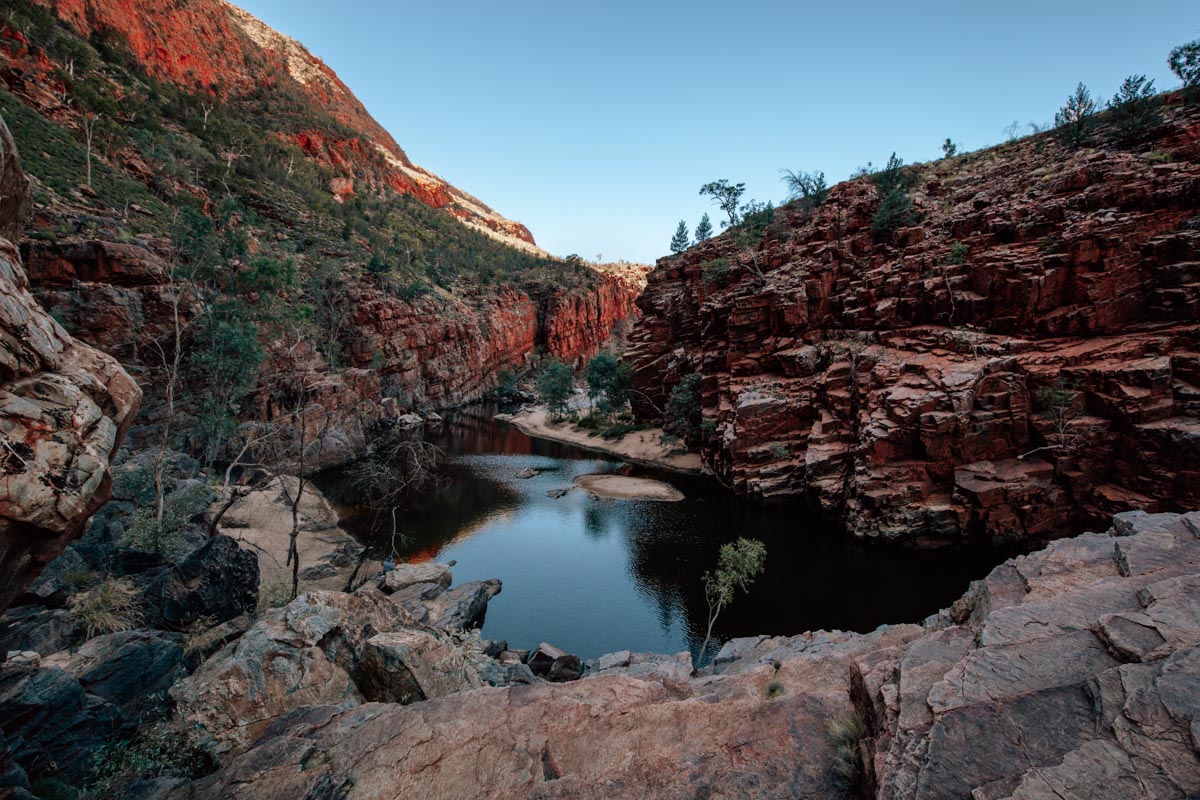
Despite not completing the entire loop, we’d recommend doing the first section of the trail as it offered some beautiful views. By this stage, it was late afternoon and most day trippers had left. This gave us the perfect opportunity to enjoy the gorge pretty much to ourselves! Ormiston Gorge is actually quite big, so it’s worth allowing a good amount of time to explore the area.

It’s possible to camp at the gorge, however the campground was full and way too busy for our liking anyway. Chris tried to brave the cold water again, but still couldn’t fully submerge himself haha. After drying off, we hit the road.
Finke River 2 Mile bush camp
We drove a short distance to the nearby Finke River 2 Mile camping area and found a spot to camp. As a bush camp with no amenities, 2 Mile turned out to be our favourite camping spot. Not only was it peaceful, there were only a few other campers nearby and there were loads of birds around. Major Mitchell’s filled the trees nearby and drank at the rivers bank, whilst Red-tailed Black Cockatoos and budgies were flying overhead. We were able to have a small fire while we watched the sunset over the river, beer in hand. The best part was that it was free. Absolutely our kind of place!

**Read the full blog: Finke River 2 Mile – The best bushcamp in the West MacDonnell Ranges
Red Centre Road Trip – Day 6: 2 Mile – Glen Helen – Redbank Gorge
We were up before sunrise and drove a few kms to the Mt Sonder lookout. From here, we put the drone up at sunrise, catching a glimpse of our campsite with Mount Sonder in the distance. Such a beautiful lookout and a great start to our morning.

Glen Helen Gorge
Once we packed up our camp, we drove the few kms to Glen Helen Gorge . Due to Covid-19, the popular Glen Helen Lodge has closed along with the road leading to the lodge. Although access to the gorge used to be from the lodge, the gorge is still open. It’s now accessible via an alternative trail which starts right by the road block and next to an information sign.
Marked with blue arrows, the trail is a short and easy walk. However, the arrows eventually stop in the middle of a partially dry river bed. And from there, it took us a while to figure out where to go next. After walking around in circles for a few minutes, we finally found a way across the river and reach the gorge. We’re glad we made the effort to check it out as it was really beautiful. We spent an hour or so at Glen Helen Gorge completely alone, then continued on our Red Centre road trip to Redbank Gorge .

Redbank Gorge
Redbank Gorge has 2 structured campgrounds. After doing a recce of both, we chose a secluded campsite at the Woodlands Campground. We pitched our tent, had lunch, then went to check out the gorge. The trail to the gorge cuts through a dry rocky river bed and requires a reasonable amount of rock hoping. Of course, it was well worth the while as the gorge was just stunning.
Chris braved the cold water yet again only this time, he fully submerged himself and swam right down the gorge. By the time he returned, the few other people who were around had left. The only downside with visiting Redbank Gorge late afternoon was that the sun had dropped below the gorge. On a hot day, this would probably be a nice relief from the heat. But as the temperature was only a little above 20°c during our visit, it was pretty cold, made even colder by the strong wind.

We had no real plans for the rest of the afternoon, other than to chill by our camp fire. We were keen to get an early night as we were going to hike Mt Sonder for sunrise the following morning!
**Read the full blog: Mount Sonder sunrise hike
Red Centre Road Trip – Day 7: Mount Sonder – Tylers Pass -Finke Gorge National Park (Palm Valley)
There is absolutely nothing appealing about a 2am alarm, especially when it’s a chilly 3°c outside! Feeling less than enthused, we dragged ourselves out of bed and made a coffee. Our plan was to hike Mt Sonder, reaching the peak in time to watch the sunrise.
Hiking Mt Sonder
The hike starts and finishes at the Redbank Gorge carpark and is actually section 12 of the Larapinta trail . Rated Moderate to difficult with a 3.5hr climb time, we started hiking just before 3am. We were conscious that hiking in the dark may take us longer and wanted to make sure we didn’t miss sunrise.
We need not have worried, as we reached the summit at 5.15am, over an hour faster than suggested. Sunrise was at 7am, which meant we had a loooong and extremely cold wait at the top. Of course it was the coldest morning of our travels, with the temperature dropping to about 1°. But the kicker was the gale force winds which made sitting still a truely awful experience! But it was all worth it in the end, as we witnessed the sun light up the sky. Gradually, about 30 other hikers appeared, who soon after the sun rose, disappeared en-mass. The vistas from the summit were breathtaking, making it hard for us to leave.

When we finally did start our descent, we got to enjoy the scenery we couldn’t see on the way up. Yep, another WOW moment! What a seriously beautiful hike. We would highly recommend hiking Mt Sonder if you’re in the area and want to witness some epic views of the Red Centre.
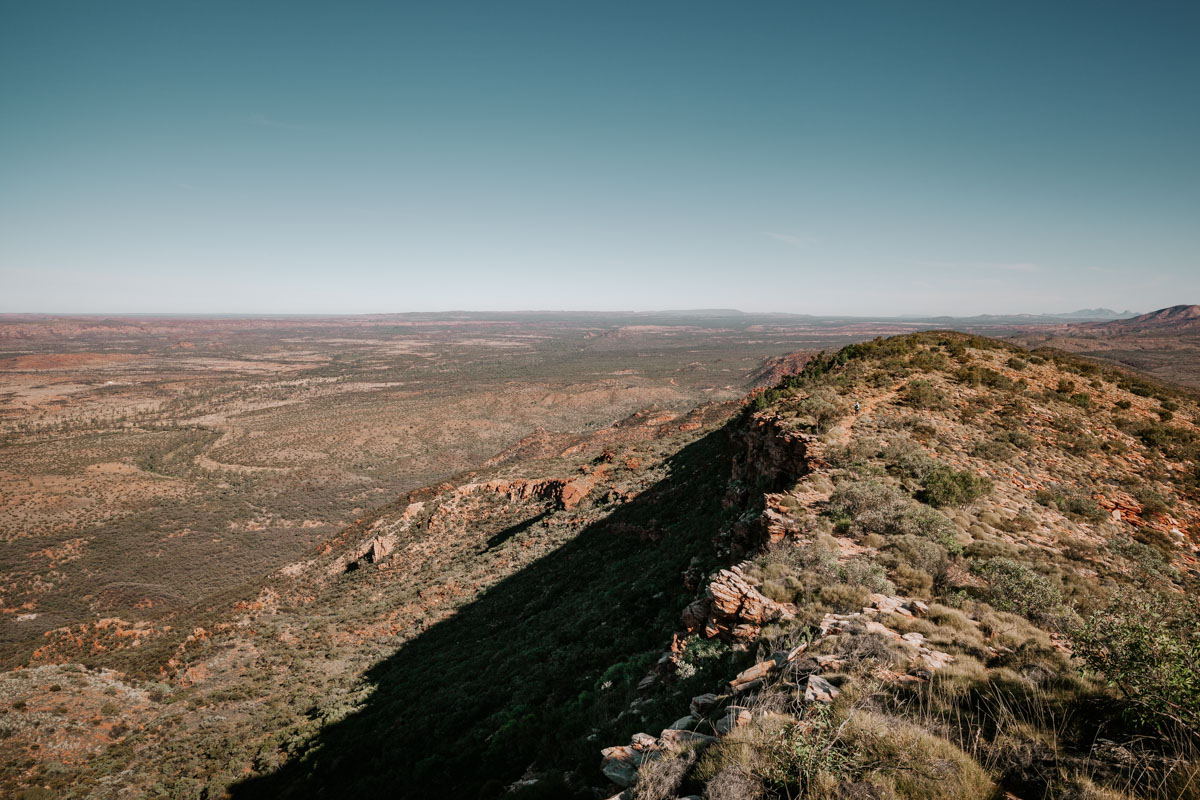
Tylers Pass
It took us 2.5hrs to reach the car and return to our tent. A shower at this point would have been amazing, but seeing as we didn’t have that option, we continued on our Red Centre road trip, leaving the West MacDonnell Ranges. But not before stopping at Tyler’s Pass where we took advantage of the views of the nearby Tnorala Gosse Bluff Conservation Reserve. The scenery we’d witnessed over the past few days was nothing short of incredible and we were excited to see what the rest of our trip would bring.

Finke Gorge National Park
At this point, we were a couple of days ahead of our schedule. So we decided to take the Inner Mereenie Loop to Finke Gorge National Park via Hermannsburg . This small outback town has little more than a fuel station, 2 small minimarts and a historical precinct. But we were able to grab some ice and a permit to drive the Mereenie Loop (more on that later), before making our way to Finke Gorge National Park . We found a spot to pitch our tent at Palm Valley Campground, right by the Palm Valley Creek, before tuning into a free nature talk hosted by one of the parks rangers.
Our excitement grew as we learnt about the hot showers which were waiting for us! I wasted no time in washing my Mt Sonder sweat away before heading off to explore the surrounding area. We had more Major Mitchell’s, budgies and water birds nearby to admire, along with the occasional lizard. But the best part of the evening was the spectacular sunset which came our way!

Red Centre Road – Trip Day 8: Finke Gorge National Park – Palm Valley
After yesterday’s early morning, we didn’t set an alarm. But of course we were up with the birds in time to see the sunrise. As we rolled out of our tent, we caught the colourful morning sky reflecting into the nearby creek. Palm Valley Campground was super peaceful in the mornings, especially down by the water.
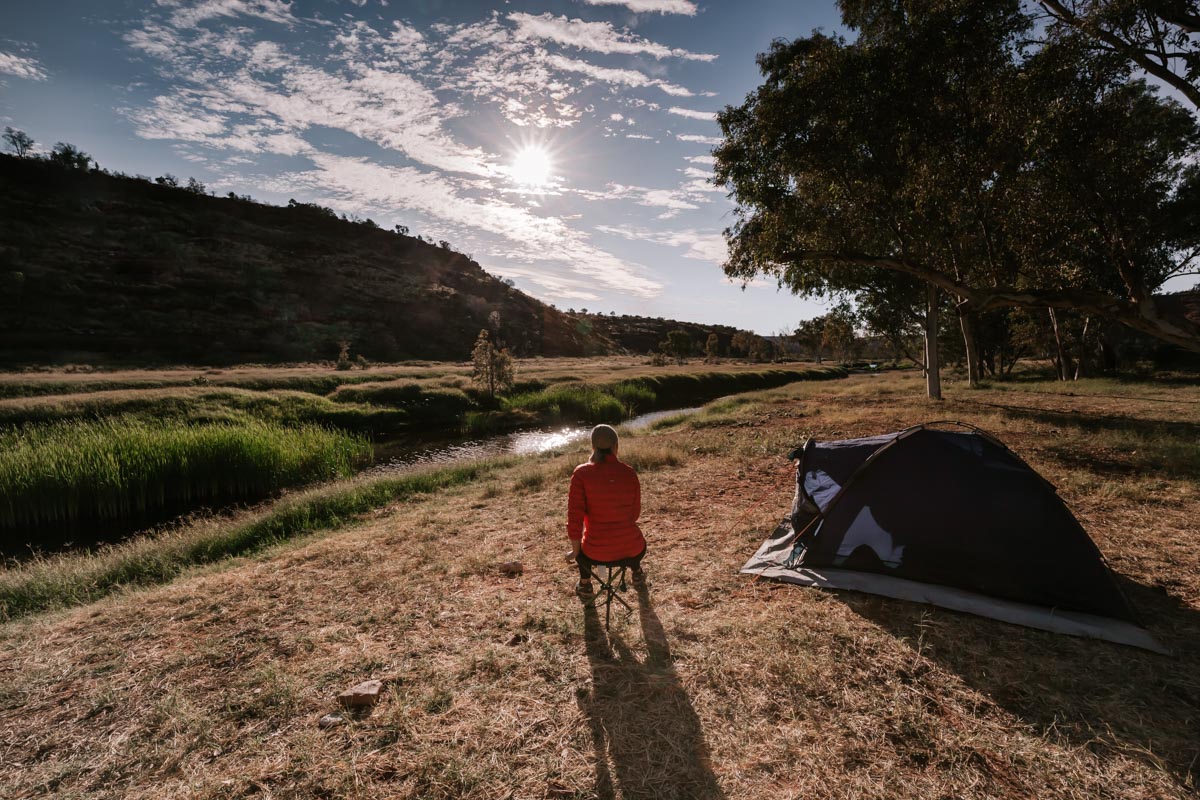
Palm Valley
Once we’d had our morning coffee and breakfast, we took the road to Palm Valley , located inside Finke Gorge National Park . This 4km stretch of road crisscrossed over thick sandy sections, steep rocky drops and dry river beds. A interesting and nerve racking drive for a novice 4WD driver! And no, there’s no way you could access Palm Valley in a 2WD! This road is strictly high clearance 4WD territory!
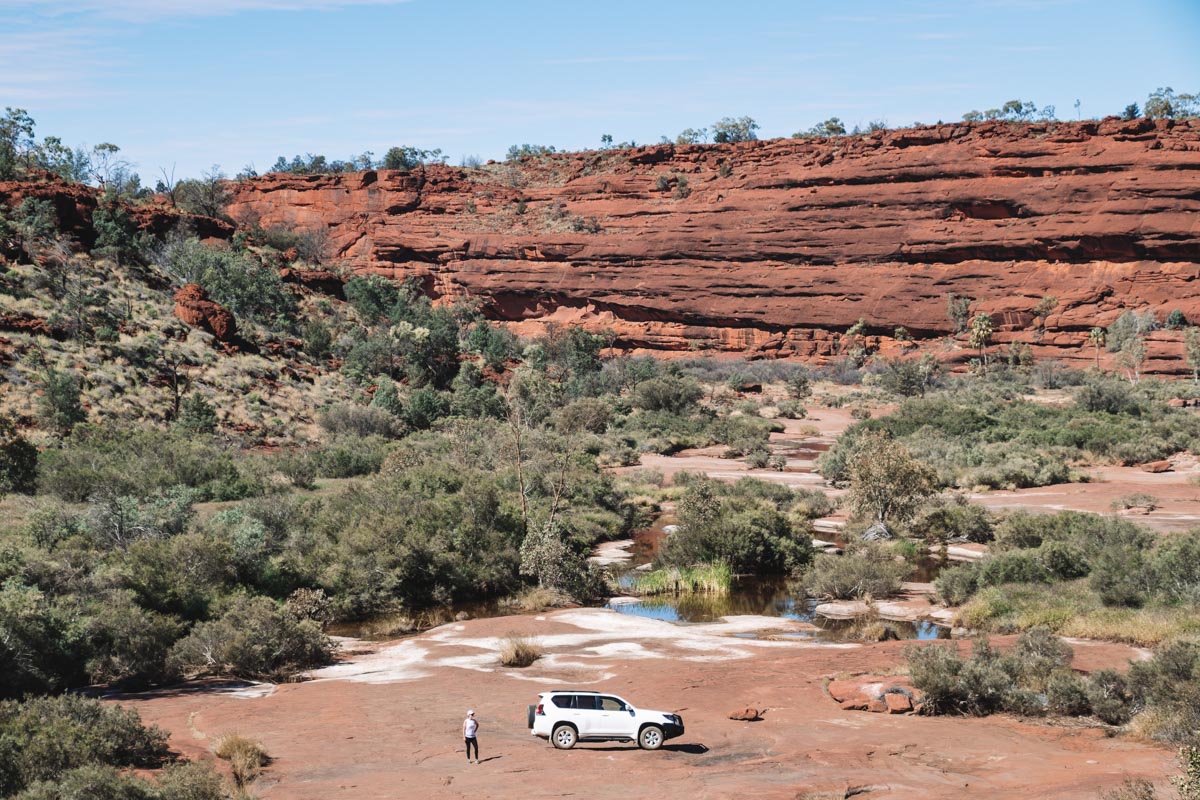
Once we reached the information board, we had 2 hike options. We of course did both, one shorter and one longer hike. The lower section which stretched along the valley floor, beside the Cabbage Palms, forming part of both hikes, was by far the most stunning part. These same Cabbage Palms are found nowhere else in Australia and is where the valleys name comes from. The landscape here was insane and such a welcome surprise. We weren’t really sure to what to expect from this part of the Red Centre, as we had done very little research on the area. It was a bit of a gamble for us which paid off big time. As it turns out, Palm Valley was one of our favourite spots on our Red Centre road trip!
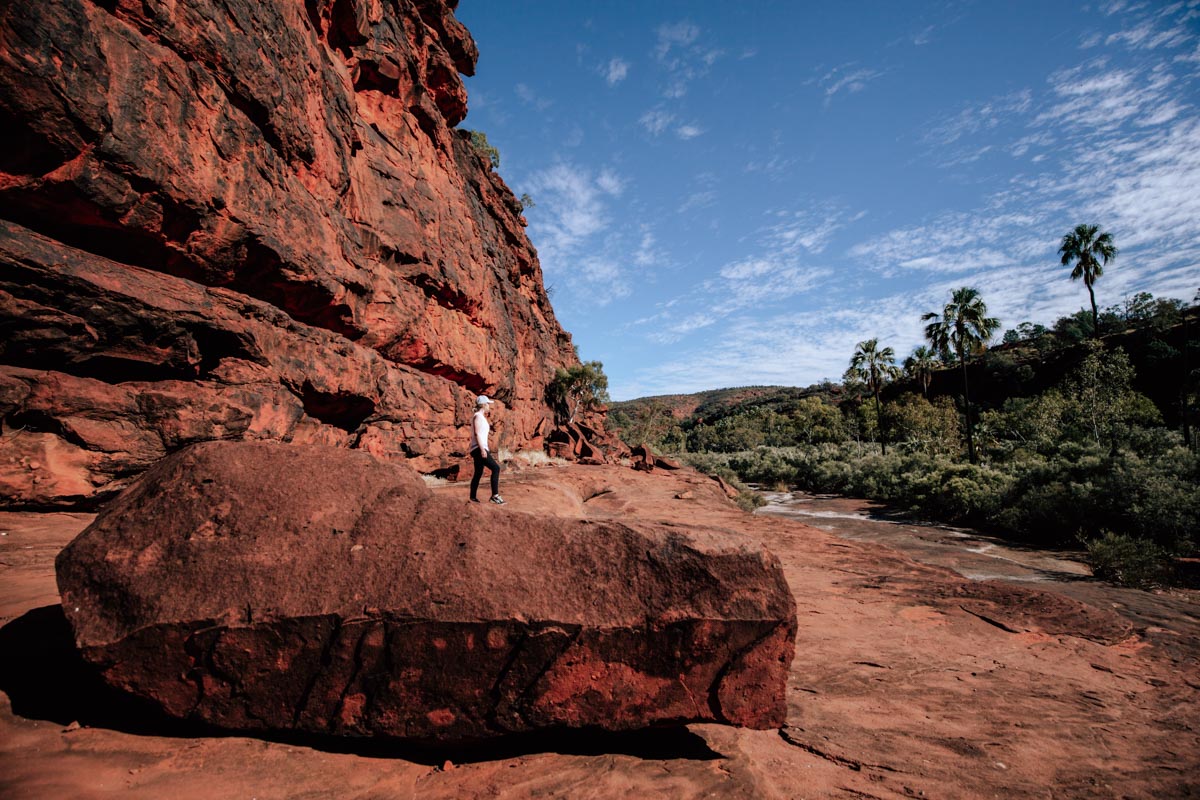
The upper sections of the hike were less impressive, other than a view of the valley right at the end of the trail. But we did see a lot of native reptiles, which as always, we took the time to admire. After taking a gazillion photos, we finally retreated to the campsite for lunch and a rest. But not for too long. We still had so much to see!

The Mpaara Walk & Kalarranga Lookout
We set off on the 5km Mpaara Walk late afternoon, which took us along the road and up behind an area known as the amphitheatre. The first section of the walk was actually pretty boring and we were beginning to wonder if we were wasting our time? But as we started to climb up the surrounding hills, the scenery just got better and better. We reached a lookout over the amphitheatre with epic views across the red rock formations. And as the sun began to slowly drop, the colours of the rock developed a deeper shade of red. It was hard to drag ourselves away from this spot, but as it was getting darker, we eventually pushed on. The hike finished at the Kalarranga Lookout , for another stunning sunset.
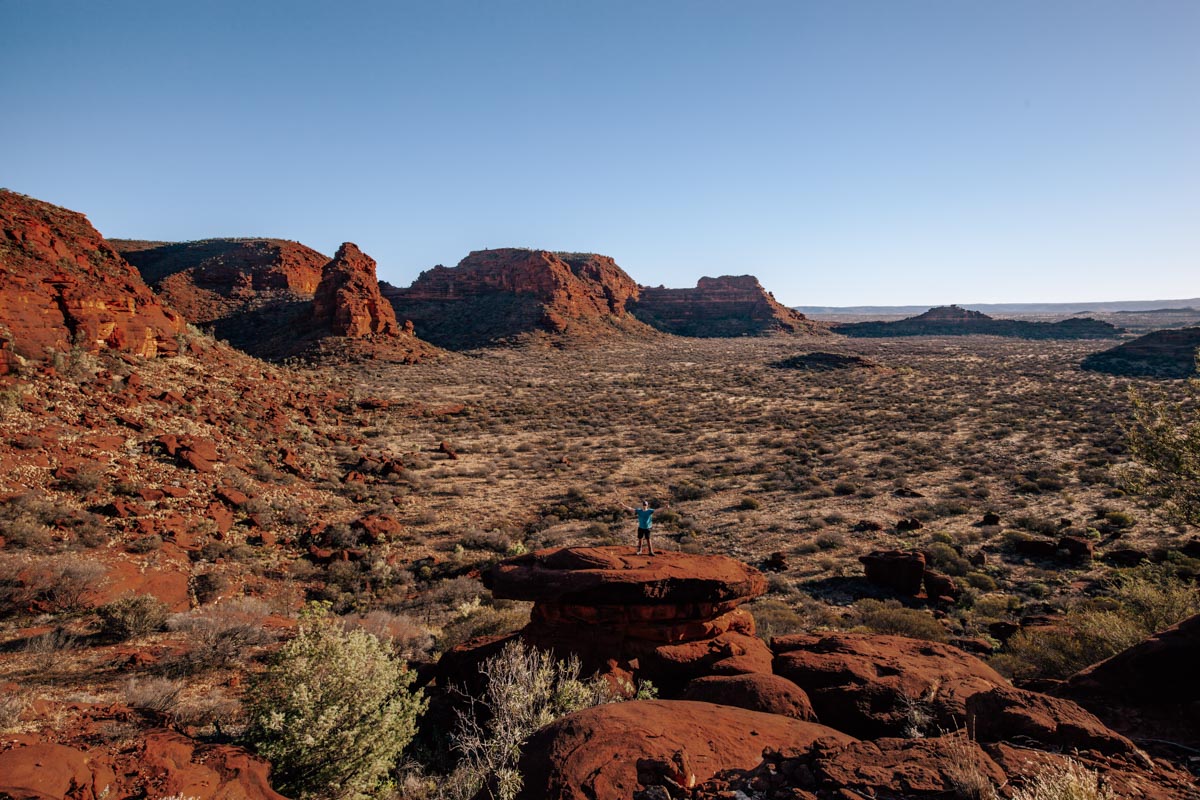
After an epic day of hiking, we walked back to the campground and made the most of another hot shower! As we sat and reflected on our day, we couldn’t believe how stunning, yet underrated this area was. If you can squeeze and extra day or two into your Red Centre itinerary, we would definitely recommend a visit!
Red Centre Road Trip – Day 9: Finke Gorge National Park – Mereenie Loop – Ginty’s Lookout
Sadly, our time at Finke Gorge National Park had come to an end. We made a quick dash back into Hermannsburg for ice and fuel before continuing on our Red Centre road trip. Fuel in the the Red Centre, with the exception of Alice Springs, is pretty expensive. We had previously paid $1.42 for diesel in Alice Springs, but were about to pay $1.86 at Hermannsburg . And the prices escalated to near $2 a litre in Yulara. Yikes! After stocking up, we hit the road. We drove back along the Inner Mereenie Loop towards Kings Canyon . After seeing dozens of signs warning of Brumbies in the area, we finally saw some. They kept their distance, with the stallion carefully protecting his family, which loitered a reasonable distance away.
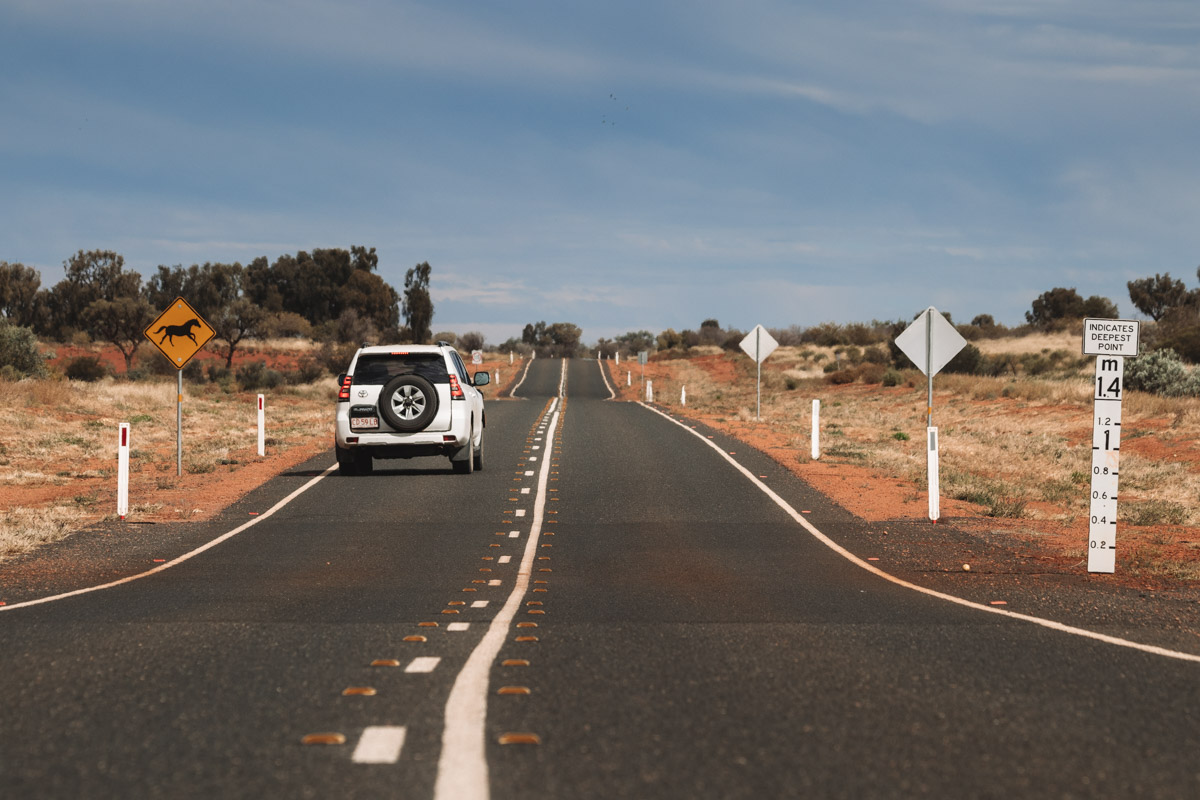
Driving the Mereenie Loop
We spent the next couple of hours driving the Mereenie Loop, a 160km stretch of predominantly unsealed road connecting the West MacDonnell Ranges to Kings Canyon . The road is rough and corrugated, sandy in patches and smooth in others. There’s a lot of flood zones and the road would be boggy in parts and possibly underwater in others after rain. A 4WD is recommended to drive this road. In fact, all rental car companies insisted on a 4WD for this section. We would’t have been insured in a 2WD. This area is quite remote and we had no wifi or phone signal for the duration of the journey.
A permit is required to travel on the Mereenie Loop, although we still aren’t 100% sure why? Permits can be purchased at Alice Springs Tourist Information and Kings Canyon Resort for $5, and Hermannsburg supermarket for $6.50. As permits are only valid for 3 days from purchase date, we couldn’t buy one in Alice Springs as it would have expired before we used it. Annoyingly, Glen Helen Lodge used to sell them, which made it convenient for travellers taking their time like us. But as Glen Helen Lodge was closed (at the time of our visit), travellers are forced to drive to Hermannsburg just to grab a permit, adding an additional 80kms to their journey. Luckily we wanted to visit Palm Valley anyway.

What is truely bizarre, is that no one checks the permits! Once you buy one, that’s it! We weren’t advised that our details were registered with authorities either. So from what we understand, no-one would have even known if we had used that road. If you plan on driving the Mereenie Loop on your Red Centre road trip, check the road conditions and drive accordingly. We found 80kms, give or take a touch, was the perfect speed.
Ginty’s Lookout
Our initial plan was to drive straight to Kings Canyon Resort and stay 2 nights. But we followed the advice of a traveller we’d met the day before and pulled into Ginty’s Lookout instead. Ginty’s Lookout is a free 24hr rest stop, located to the side of a ridge with views of Kings Canyon in the distance. It was one of few rest stops that we came across which allowed camping. And wow, what an awesome place to pitch a tent! We shared our lunch with the resident flies of which there were many, whilst gazing out at Kings Canyon . The views of were pretty special and were only enhanced by a spectacular sunset! We had a small fire that evening and although there were a few other campers around, we enjoyed a peaceful night.

Red Centre Road Trip Day – 10: Ginty’s Lookout – Kings Canyon
The Red Centre sure knows how to put on a sunrise! And today was no exception. We woke to a beautifully coloured sky which lit up our camp. I don’t think we will ever tire of watching the sun rise or set, especially when it looks like this! The great thing about staying at Ginty’s Lookout was its short 28km drive to Kings Canyon Resort . Considering a nights camping in an unpowered site at the resort costs $25 p/p, we were pretty happy with our decision to ‘rough it’ for a night.
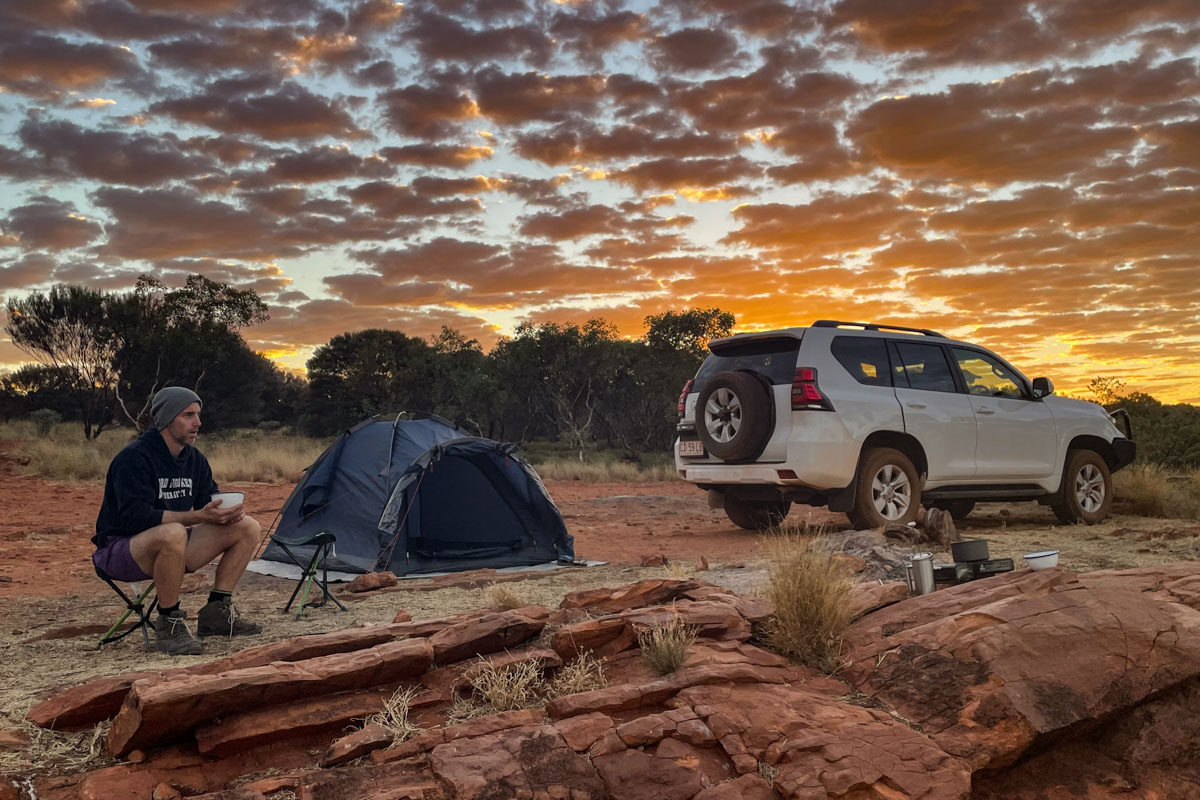
Kings Canyon – Watarrka National Park
After checking in and setting up our camp, we had breakfast and drove down to Kings Canyon , which is located inside Watarrka National Park. We noticed that the large carpark was quite full and it quickly became apparent that we had entered prime tourist territory! Haha. To this point, we’d mostly rubbed shoulders with Grey Nomads. But we were now seeing a lot of families and younger couples.
There’s a few hiking options at Kings Canyon . We elected to do the gentle 2.6km return walk to Kings Creek first. This was a nice way to start our day at the canyon and once complete, we quickly had lunch. After filling our bellies, we decided to embark on the spectacular 6km Rim Walk. And all we can say is wow, wow, wow! Every corner we turned unveiled another spectacular view. The most dramatic views were of the sheer cliff drops across the centre of the canyon. But the most serene spot was down the Garden of Eden.

We spent around 3 hours exploring Kings Canyon before making our way back to Kings Canyon Resort . The day passed so quickly and before we knew it, it was almost time for sunset. So we had a quick shower, grabbed a beer and headed to the sunset viewpoint within the resort. There were quite a lot of people there waiting for the sun to set and the very moment it did, most people left. We along with a few others stood and enjoyed the best part of any beautiful sunset – the afterglow. What an incredible day!

Red Centre Road Trip – Day 11: Kings Canyon – Yulara – Uluru
We only had one more area to tick off on our Red Centre road trip. Blown away with the beauty we had seen so far, we knew the best was yet to come! We made the 3 hour journey from Kings Canyon to Yulara. This drive was anything but exciting, broken up briefly by a stop at Kathleen Springs, only 23kms from Kings Canyon . When we finally got to Yulara, we went straight to Ayers Rock Resort , checking into the campground. We’d allowed 3 nights here, giving us ample time to visit Uluru and Kata Tjuta at both sunrise and sunset.
Sunset at Uluru
We expected the Uluru sunset viewpoint to be busy. So we purchased our entry tickets online , grabbed some ice and made our way to the park. As one of the first to arrive, we got a great spot. We were hoping for a stunning sunset and boy did did we get one! We watched in awe as the colours of the rock glowed and changed colours as the sun dropped behind us. There is something quite mesmerising about Uluru and we couldn’t help but wonder if we could get a better view?
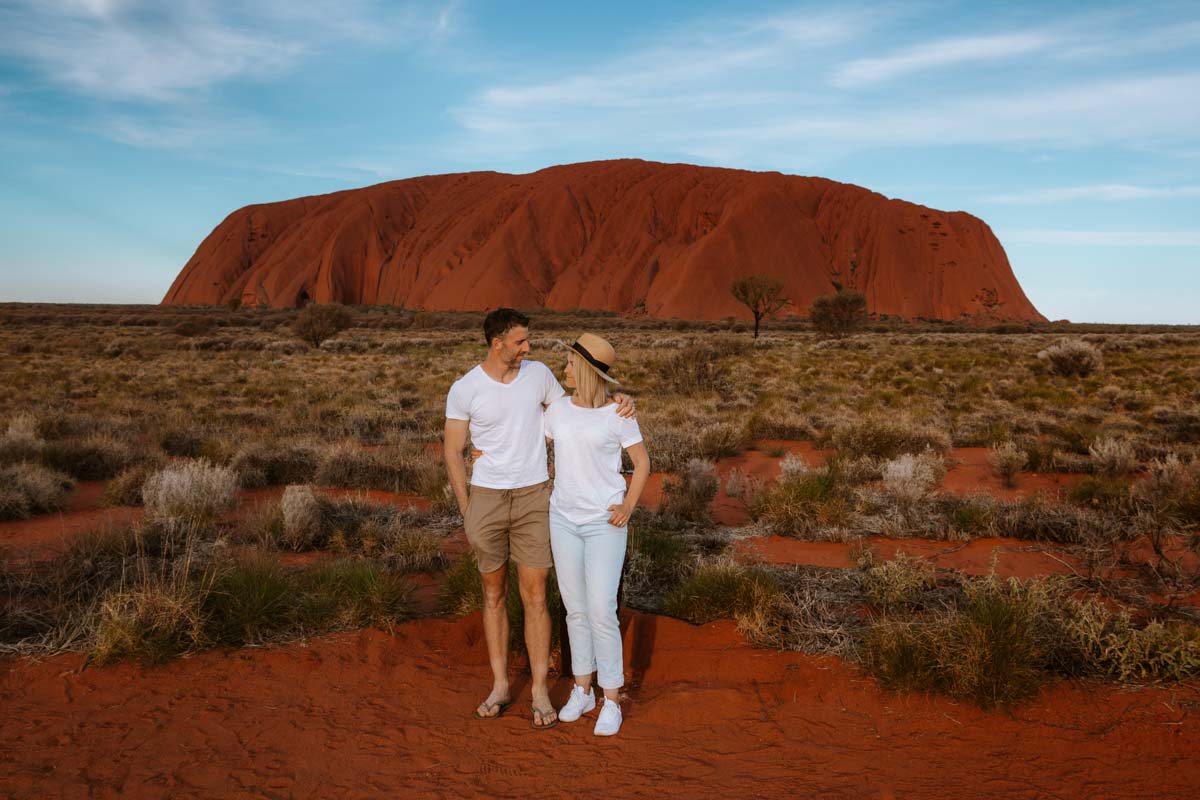
Just before the sunsets afterglow began, we decided to drive on and see if we could find a different angle. It was a gamble, as we didn’t know where to stop and if we’d left it too late. But our gamble paid off. Just around the corner, we pulled onto the side of the road with awesome unobstructed views of Uluru . And the best part was that no one else was around. The fairy floss like clouds lit up hues of pink and purple, leaving us speechless. Another big WOW moment on our Red Centre road trip!

Red Centre Road Trip Day 12: Uluru
Uluru sunrise.
We couldn’t visit Uluru without trying to see a sunrise. So we found ourselves at the sunrise viewing area super early, trying to find the perfect spot to settle into. This proved to be more difficult that we expected as the official sunrise viewing area consists of kilometres of walking paths, along with a viewing platform. At first, we couldn’t find the platform in the dark. And by the time we finally found it, the best spot was taken. So we had to settle for what seemed to be the second best spot. As the sun rose, the sky lit up deep shades of red and orange, with pinks and purples. This as always was the best time to photograph Uluru as the clouds and sky looked amazing.

But it wasn’t our day for an Uluru light show. The clouds rolled in and shaded the rock, eliminating any chance of Uluru changing colour with the sun. We guess you win some and loose some right?!
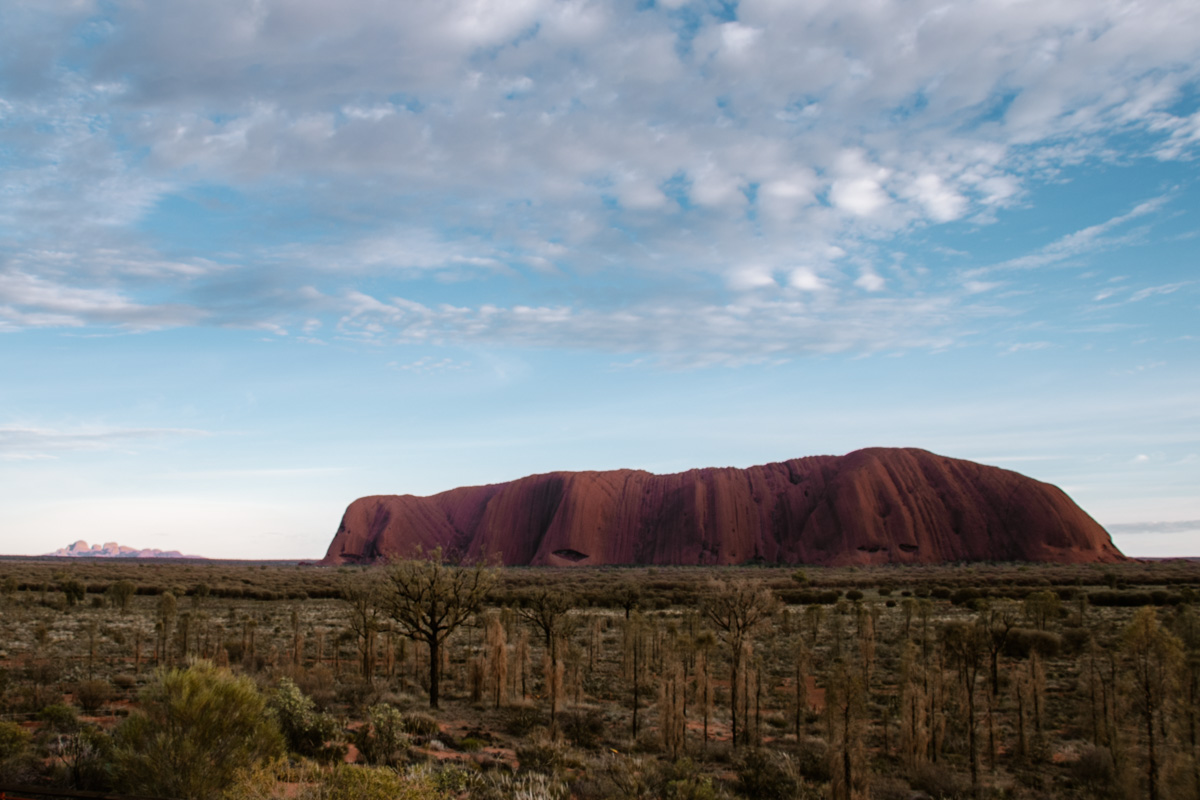
Uluru Base Walk
Given that we were so close to Uluru , we continued on to the Kuniya carpark at the base of Uluru . After coffee and breakfast, we commenced our walk around Uluru . There’s several walks available here, with the longest being the 10.6km base walk. We headed clockwise toward the Mala carpark, completing the Lungkata Walk section, before continuing on to complete the Mala Walk. These initial sections of the walk hug the base of Uluru , before the track stretches further away. We ended our walk back at the Kuniya carpark, after exploring Mutitjulu Waterhole and Indigenous rock art inside a nearby cave. Overall, this was a beautiful walk which gave a totally different perspective of Uluru and its surroundings.

Helicopter flight over Uluru/Kata Tjuta
We had a few hours to chill back at the campsite before experiencing what we call the ‘main event’. We had booked a sunset helicopter flight with Professional Helicopter Services over Uluru and Kata Tjuta and couldn’t wait to see these famous landmarks from above. Annoyingly the clear sky had all but completely clouded over. That said, we had just enough break in the clouds for some beautiful sunset colours and a few golden moments over Uluru. Our 36min flight took us over to Kata Tjuta and of course, Uluru . I had the front seat and arguably the best views, where as Chris had a window seat in the back. Between us, we managed to get some shots that we’re pretty happy with. Of course, this was a highlight of our trip. If you have the time and money, we’d highly recommend a sunset flight.
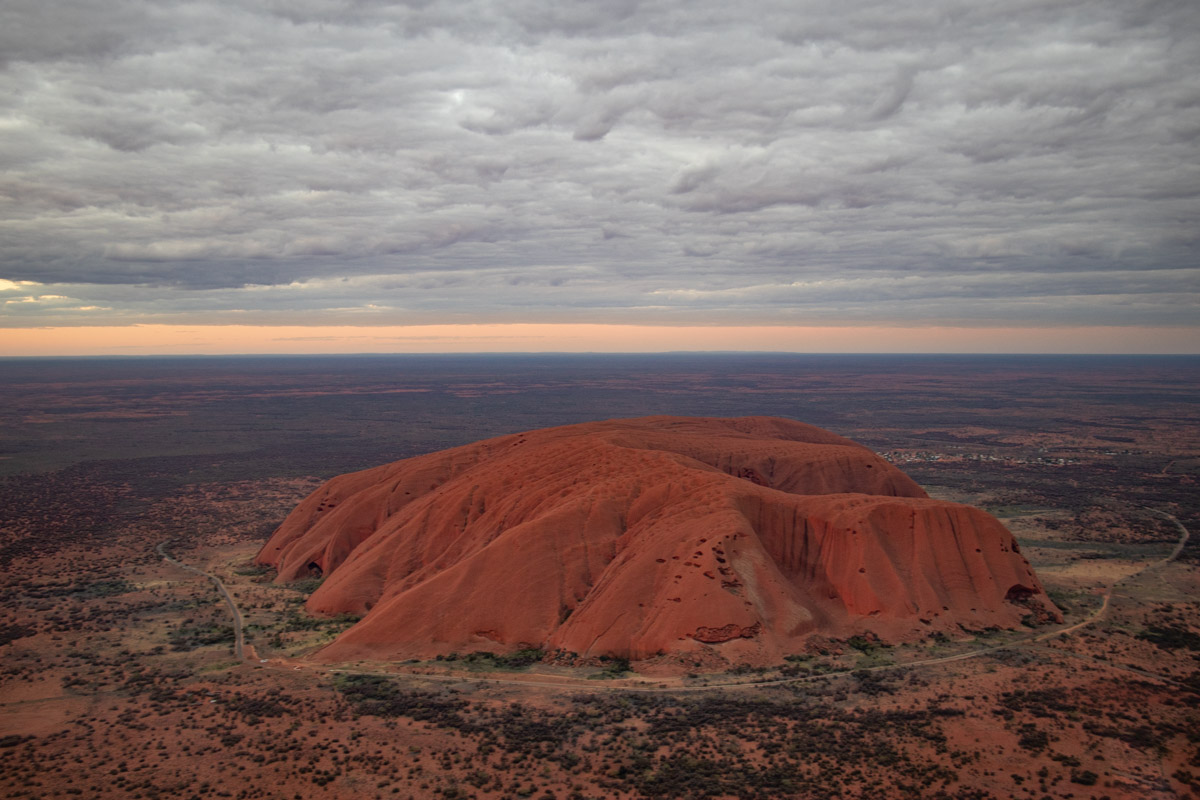
Red Centre Road Trip – Day 13: Kata Tjuta
We were tempted to get up for another sunrise at Uluru , but the weather wasn’t looking good. Wind and cloud was on the horizon, so we didn’t bother. We had reserved our final full day of our Red Centre road trip to explore Kata Tjuta . As Kata Tjuta , also referred to as Mt Olga/The Olga’s, was a 52km drive from our campsite, we only wanted to drive there once.
The word Kata Tjuta literally means ‘many heads’. And when you see this series of rock formations up close, its name all makes sense. We stopped briefly at the Kata Tjuta Dunes viewing area along the way which offered awesome views of Kata Tjuta . And we also got some great views from the sunset view point. But it wasn’t until we were almost at the carpark that the scale and beauty of Kata Tjuta really showed. Im not sure how many times we said wow during our Red Centre road trip….. but WOW!
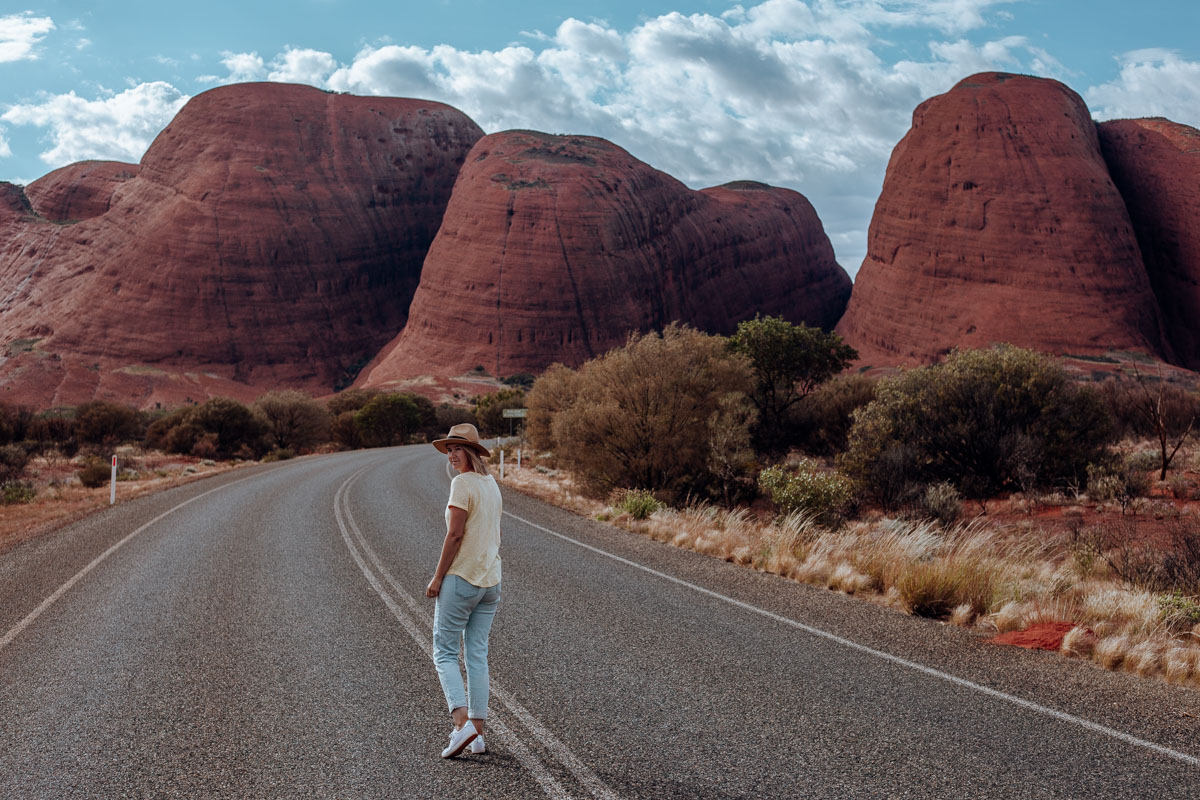
Valley of the Winds Walk
Whilst there was still some blue in the sky, we set off on the Valley of the Winds Walk . The entire circuit is a grade 4 – ‘moderate – difficult’, but we personally found it moderate. For sure the views from the Karingana lookout were spectacular and some of the best along the walk. We felt so small amongst the huge domes towering above us. And true to its name, the wind blowing through the valley almost knocked us off our feet! This walk well and truely exceeded our expectations and we highly recommend it to anyone visiting Kata Tjuta .

Despite taking a gazillion more photos, we were back at the carpark within 3 hours. The only thing that bothered us about visiting Kata Tjuta were the flies! Holy moly they were intense, worse than any other place we’d visited in the past 2 weeks. They were literally everywhere! We stopped to check out Walpa Gorge as we headed back to our campsite. It was a nice stop but didn’t compare to the Valley of the Winds Walk! We’d planned on watching the sunset at Kata Tjuta , but the weather again had different plans. Thick dark cloud covered the sky and we’re glad we didn’t wait around. The sky only got darker, leading to a night of desert rain! We quickly found ourselves sleeping in the back of our car – lucky we had a big roomy 4WD!
Red Centre Road Trip – Day 14: Yulara – Melbourne
And just like that, our Red Centre road trip was over! We can honestly say that this is such an incredible part of Australia that everyone should see. A few days may be enough for some, but we’d highly recommend taking a couple of weeks to soak it all in. And whilst our international borders are still firmly closed, now is the best time for Aussies to road trip the area! We got one last view of Kata Tjuta and Uluru as we flew out of Ayers Rock Airport and a view of the thick clouds that covered Melbourne’s sky on our return home!
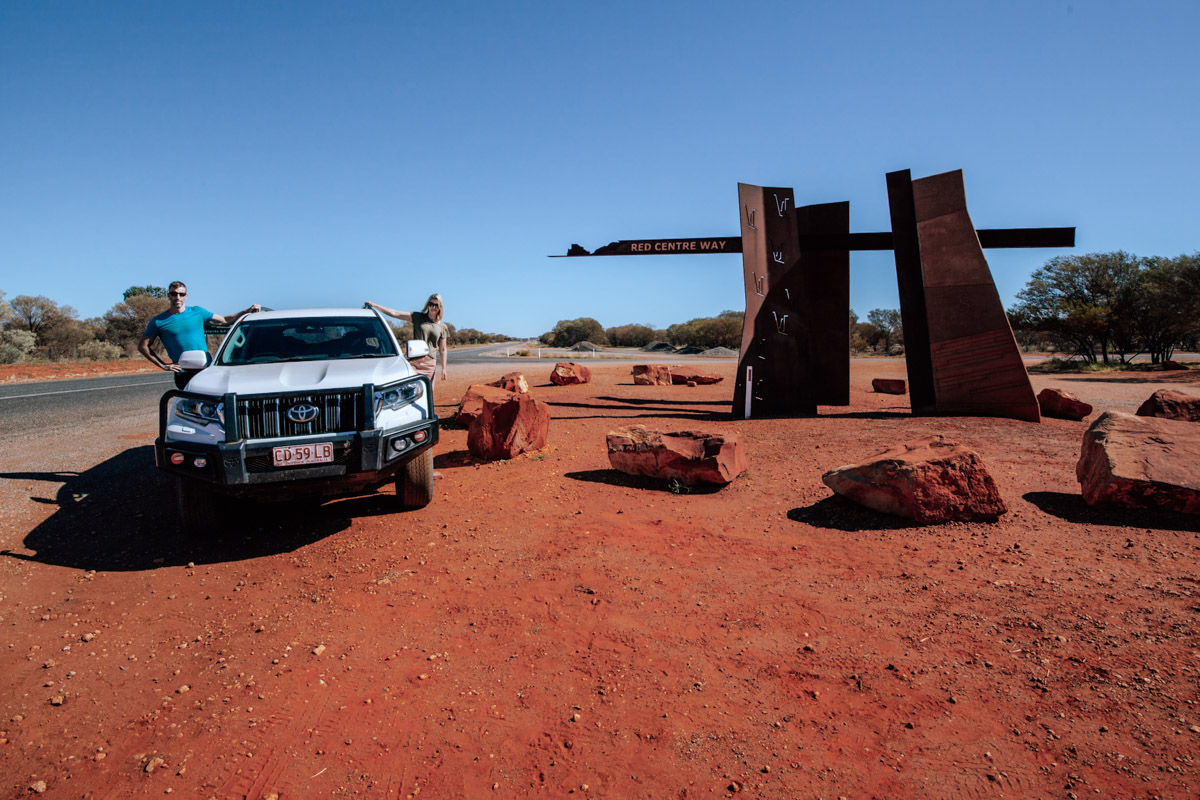
Like this post? Then pin it!
Planning a trip to Australia’s Red Centre? Check out our blogs to help you plan the perfect trip!
Olive Pink Botanic Garden – A must see for wildlife lovers in Alice Springs !
Trephina Gorge – East MacDonnell Ranges
Visiting the West MacDonnell Ranges – A complete guide
Visiting Standley Chasm: A complete guide
Finke River 2 Mile – The best bush camp in the West MacDonnell Ranges
Mount Sonder sunrise hike
Walks in & around Palm Valley – Finke Gorge National Park
Palm Valley – Finke Gorge National Park
The best things to do at Uluru – A complete guide
Hiking the Valley of the Winds – Kata Tjuta
Wow!!! Thank you for sharing. This looks like the perfect trip to the Red Centre. I would love to know if you took your own camping equipment or hired it when you arrived and what you packed for the trip. Thank you again, love your adventures.
You’re very welcome Maree! Glad you love our adventures 🙂
We took our own gear with us for this trip. Our key items wer: light weight tent, lightweight roll mats & sleeping bags along with some basic cooking equipment. We had some small light weight camping saucepans/fry pans, tongs egg flip etc, a couple of camping plates, bamboo cutlery and big camping cups which doubled as bowls. We also took a camping gas burner and a Furno 360 camping stove which was super compact and very convenient for boiling water, heating soups etc. We picked up gas cartridges in Alice Springs for these. We also got a big esky bag from Kmart which we filled with ice every day or 2, rather than a hard esky. We were able to use public BBQ’s here and there but when we couldnt, we either cooked on our gas cooker or over a campfire.
It’s possible to hire gear from Alice, but as we already had most of our gear, we purchased a little extra checked luggage so we could take it with us. The key for this kind of adventure is have lightweight gear. From memory, we had about 25kg of equipment and 20kg of clothes between the 2 of us! Hope this helps xx
Thank you, that’s awesome, look forward to reading about your next adventure x
Leave a Reply Cancel reply
Your email address will not be published. Required fields are marked *
Yes, sign me up to your newsletter!
Instagram @alittleofftrack

Alice Springs – Uluru Itinerary & Map (Australia’s Red Center Road Trip)
By Author Jurga
Posted on Last updated: November 11, 2023
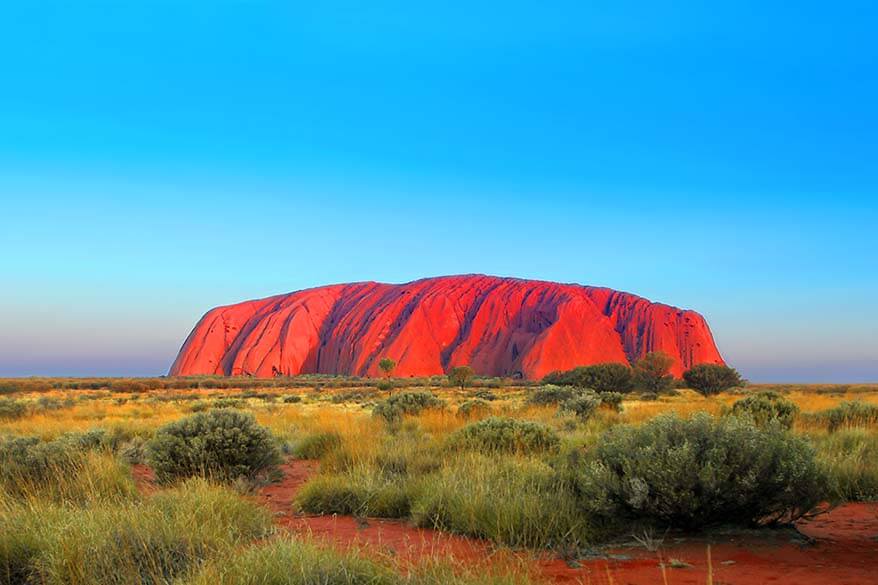
Are you thinking of visiting the Red Center of Australia and are not sure where to start? This article features a simple itinerary from Alice Springs to Uluru and back and the most beautiful places to see along the way. Find out!
Planning a family trip to outback Australia was not an easy task. We wanted to see a lot but had to take into account that we were traveling with the three young children. Nevertheless, we prepared our Alice Springs Uluru itinerary in such a way that it would bring us to all the nicest places in the region .
Despite the young age of our children and the extreme November temperatures of over 40°C (100°F), we saw all the highlights of the Red Center. In fact, we did more than expected. In this article, you can find our 6-day Australia Red Center road trip itinerary: from Alice Springs to Uluru and all the best places in between . I also included a map to make it easier to plan your trip.
If you want to see all the best places between Alice Springs and Uluru, then look no further – this road trip itinerary brings you to all the nicest places in Central Australia. If you are on a tight budget, scroll all the way to the bottom for some suggestions for a budget trip to Uluru. Find out!
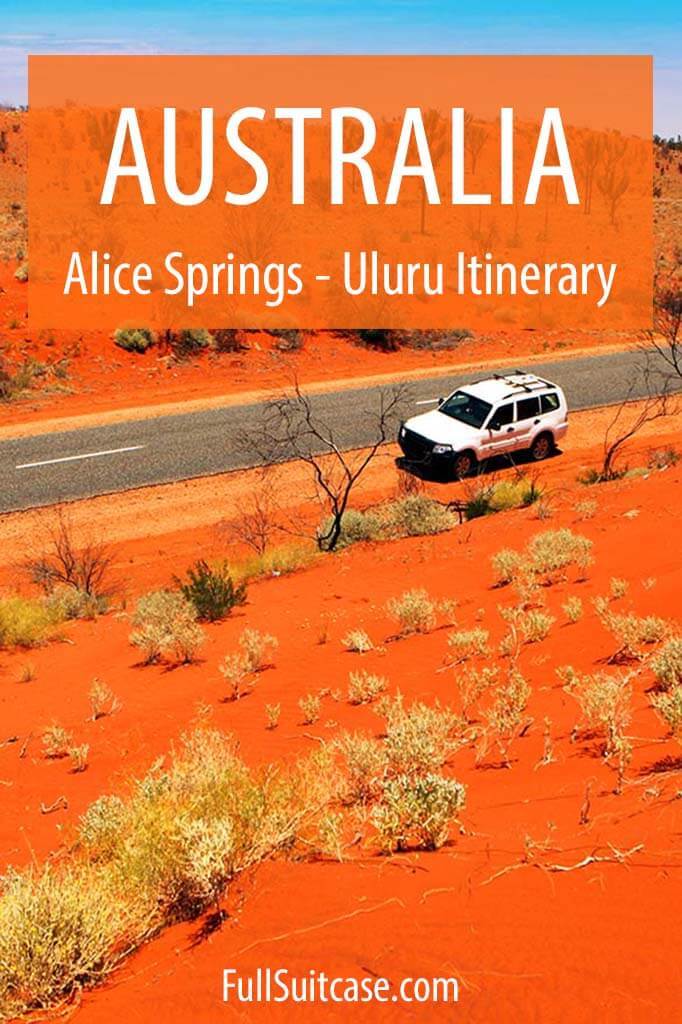
Australia Red Centre itinerary – OVERVIEW
Day 1: alice springs.
- Day 2: Alice Springs – MacDonnel Ranges – Glen Helen
Day 3: Glen Helen – Kings Canyon
- DAy 4: Kings Canyon – Uluru – Kata Tjuta National Park
Day 5: Uluru – Kata Tjuta National Park
- Day 6: Uluru and back to Alice Springs
Australia’s Red Centre on a Budget
Map of alice springs – uluru itinerary.
To make your travel planning easier, I created this map showing all of the places mentioned in this post, as well as our driving route.
Below, you can find all the details of this trip. Read on!
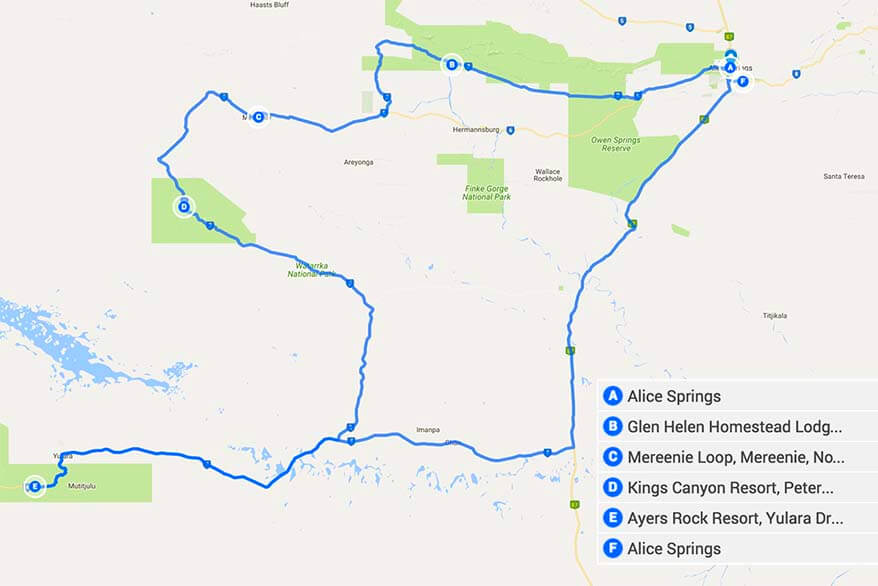
Here’s our recommended Alice Springs – Uluru itinerary:
We left Sydney in the morning and after a very scenic flight of less than three hours, we landed in a whole other world – Alice Springs.
It was 2,5 hours earlier in Alice Springs (and we were still dealing with jet lag coming from Europe) and at least 10°C warmer than in Sydney. We quickly threw away the last apples and bananas from our hand luggage in the quarantine bins (for more info check our practical tips for traveling to Australia ) and headed to the car rental stands.
We rented a 4×4 vehicle and the one they gave us was full of scratches and had a dented roof. This didn’t look promising! They explained to us that it was not the best idea to enjoy the sunset at Ayers Rock from the roof of your car as the previous renters did, and we were set to go.
In principle, you don’t need a 4WD vehicle in Australia’s Red Centre , since most of the main roads are paved. So if you are driving to Uluru (Ayers Rock) only, you can do it with any regular car as well. We rented a 4WD because we were planning to drive the gravel Mereenie Loop Road – read further for more info.
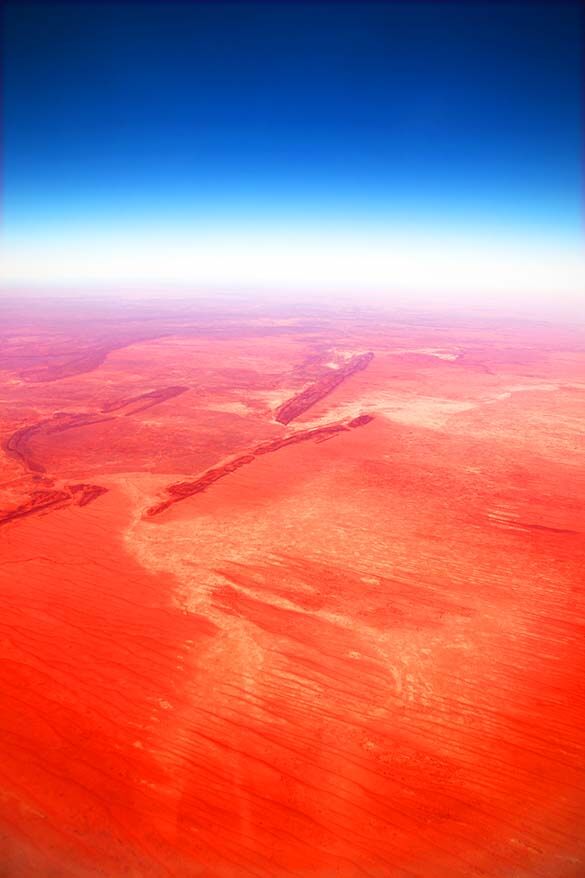
Now back to Alice Springs…
We checked in at our hotel and then headed to the town center which was completely deserted! No wonder, with temperatures around 36°C… And it was only spring – we visited the Red Center in early November.
After a while, we found an air-conditioned shopping mall. It looked like the whole town was there, escaping the heat, just like us… We stocked up on water and food supplies for the next couple of days (there are not many shops in the outback, so it’s really a must!). Since there was not much exciting to do downtown, we headed back to our hotel where we spent the rest of the afternoon by the pool.
I still don’t understand how it’s possible, but all the swimming pools in Australia’s Red Centre were freezing cold! The kids went swimming anyway, but we found it too cold and stayed on the side. 32°C in the shadow and the water too cold to swim – you have to experience it to believe it!
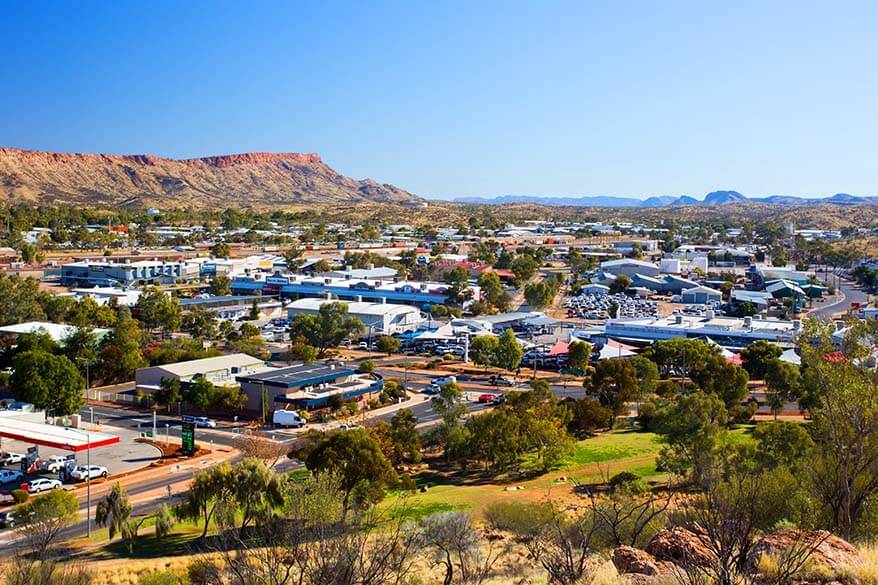
What to See and Do in Alice Springs
While the town itself isn’t that impressive, there are quite some activities you can do in Alice Springs. The nicest things to do are nature and wildlife – outside of town.
Here are a few suggestions for things to do in Alice Springs:
- Alice Springs Reptile Centre
- Alice Springs Desert Park
- The Kangaroo Sanctuary
- The Royal Flying Doctor Service
- You can also opt for this popular Alice Springs Highlights Tour and see the best of Alice Springs in half a day.
- A popular thing to do in Alice Springs is a hot air balloon tour .
- Rainbow Valley Conservation Reserve is well worth visiting, especially at sunset. But you do need a 4X4 for driving in the outback.
- West MacDonnell Ranges is another popular day tour from Alice Springs . We visited it as a part of our road trip – see day 2 itinerary further below, but if you want to stay in Alice Springs, you can easily do this with a tour.
- One of the best organized day tours from Alice Springs is a 4×4 tour to the Palm Valley . It’s a place that’s not very easy to visit on your own, so if you want to see it, consider a tour.
TIP: Depending on how much you want to see and do in and around Alice Springs, you might want to add an extra day to your itinerary.
Where to Stay in Alice Springs
There are many accommodation options in Alice Springs . We stayed in Alice on Todd self-catering apartments and it was ideal for a family.
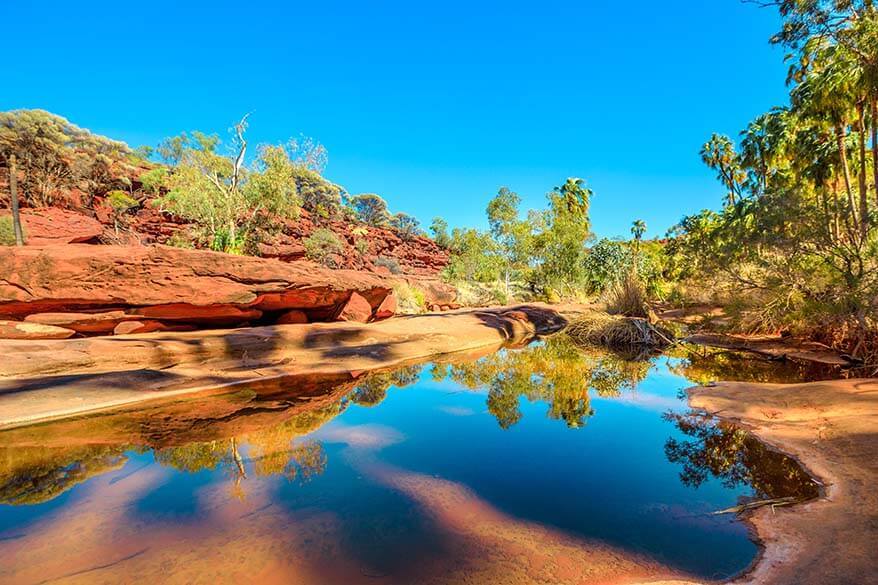
Day 2: Alice Springs – West MacDonnell Ranges – Glen Helen
While you could simply drive from Alice Springs to Uluru, we highly recommend that you include West MacDonnell Ranges (and also Kings Canyon – more info below) in your Uluru itinerary! It will make your trip so much more special!
The drive from Alice Springs to Glen Helen is only 130km and the road is paved. However, there is a lot to see and do in the area, so we took an early start before it got too hot to do anything.
Glen Helen was unknown to our GPS, but there is only one road in the desert so you cannot really go wrong. We followed Larapinta Drive and then Namatjira Drive towards Glen Helen and visited West MacDonnell Ranges along the way.
West MacDonnell Ranges
The West MacDonnell Ranges are simply stunning! There are hiking trails, beautiful gorges, and waterholes where you can swim…
We visited Simpsons Gap, Standley Chasm, Ormiston Gorge, Glen Helen Gorge on the first day, and the Redbank Gorge on the second day, on our way to Kings Canyon. Don’t miss this incredible place if traveling to Australia’s Red Centre!
LEARN MORE: West MacDonnell Ranges

Accommodation. We stayed at Glen Helen Homestead Lodge for one night. It’s a very basic accommodation, but there is really no other option here unless you return to Alice Springs.
I have to add that the food was very good and the location near the Glen Helen Gorge – simply spectacular. If we were to go back to Australia’s Northern Territory, I would book at least two nights at Glen Helen and take an extra day to explore the beautiful gorges of West MacDonnell Ranges.
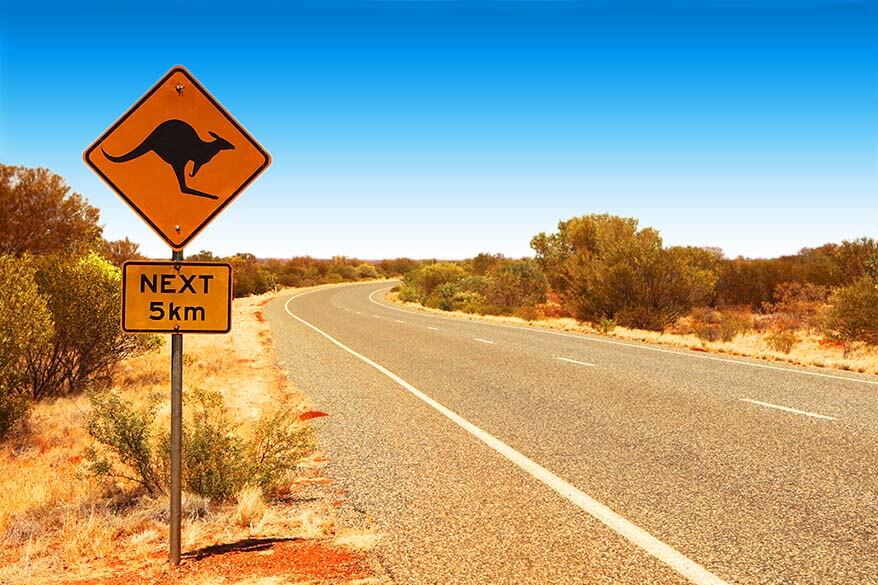
There are two ways to reach Kings Canyon – Watarrka National Park.
One is on the sealed road from Alice Springs, Stuart Hwy, Lasseter and Luritja Road. This would take you 6 hours from Alice Springs and about 8 hours from Glen Helen.
The shorter road – the Mereenie Loop Road – is a gravel road through the real outback of Australia. We took this road. See below!
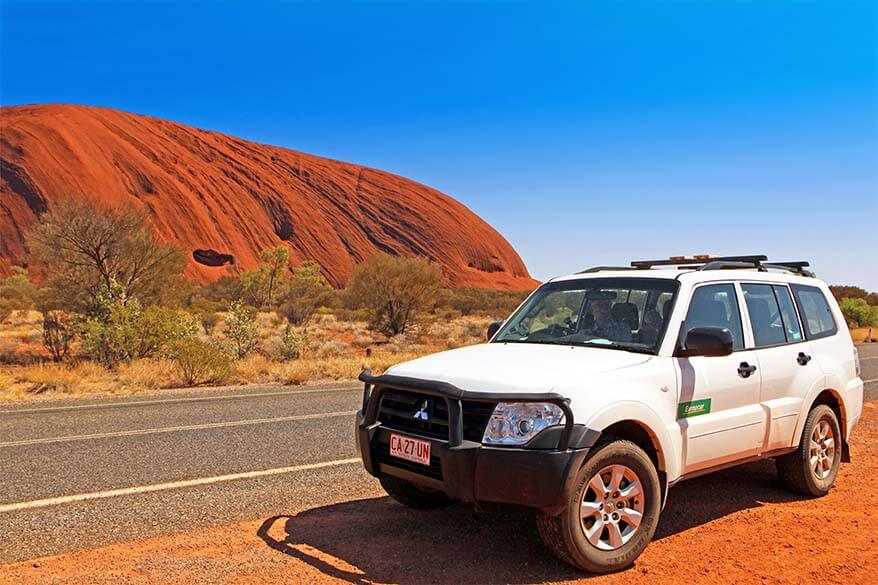
Mereenie Loop Road
We took the Mereenie Loop Road and it took us about 3hrs to get to Kings Canyon from Glen Helen. Three rather stressful hours, I have to say. You’re literally in the middle of nowhere: no houses, no shadow, only a handful of other cars and a desert as far as you can see.
Please note that the Mereenie Loop Road is recommended for 4×4 vehicles only. You really shouldn’t attempt this road in a standard vehicle. We passed one and they drove so slowly that I don’t think they got there by dark. In any case, you cannot do this road with a rented car if it’s not a 4×4.
You also need to buy a Mereenie loop permit in order to drive this road (you can get it in your hotel in Glen Helen).
The biggest part of the Mereenie Loop Road is gravel and it was in a pretty bad state when we visited. We found that driving faster made the ride smoother (go figure), but at 80km/h you just have to hope you don’t have to stop quickly as that would be practically impossible.
The landscape was somewhat uninspiring along the road, but we got to see a wild camel crossing the road. Somehow I never realized that there were wild camels in Australia. How cool is that! We saw two other animals – a snake and a lizard. But no exotic lizards and no Red Kangaroo (remember Kangaroo Jack ?) that we so much hoped to see in the outback…
Fuel is available at Glen Helen and at Kings Canyon, so fill up before driving the Mereenie loop road. It’s also a good idea to have water and some snacks with you. Petrol prices were 30% higher at Glen Helen than in Alice Springs and about double of Sydney prices. That’s the price to pay for traveling in the outback.
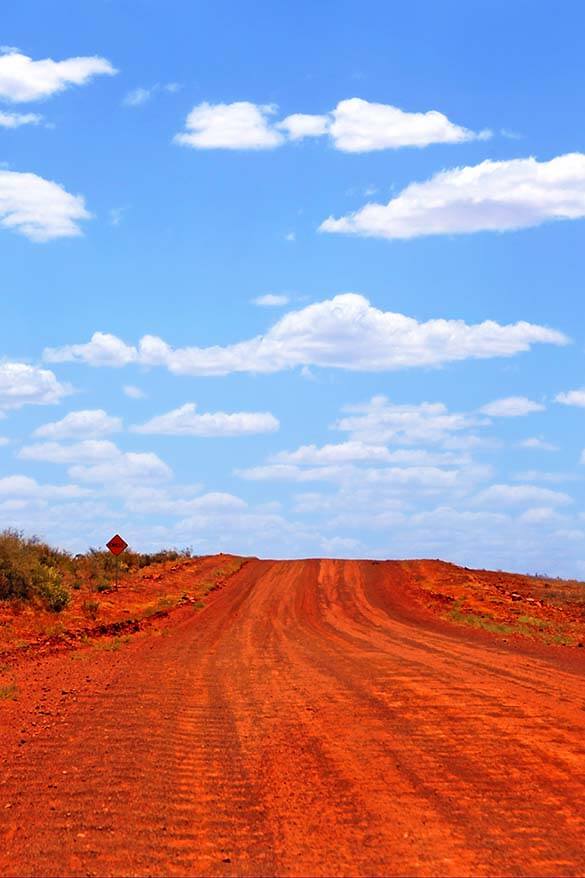
Palm Valley
One place we had heard about but didn’t visit was the Palm Valley in the Finke National Park. It’s home to the world’s oldest river, the Finke River and the Red Cabbage Palm, which is only found here.
You need a 4WD to access Palm Valley (which we had), but it’s also such a long drive that you’d either need to spend a night camping there or be prepared to drive for 10-12 hours through the Australian outback in one day. Again, it’s not something for a family with very young kids. But I read that some people visit Palm Valley on the way from Glen Helen to Kings Canyon and so apparently it is doable.
Another option would be to spend an extra night in Glen Helen and visit the Palm Valley as a day trip from there. As already mentioned, a good alternative stress-free way to visit Palm Valley is by booking this organized day tour from Alice Springs .
Kings Canyon Resort
Accommodation. Kings Canyon Resort where we stayed for the night was a luxury oasis in the desert! We had two big deluxe rooms with a terrace and a whirlpool with a view over the mountains… What a difference compared to the hotel at Glen Helen! The swimming pool was also cold, but it was bearable and we spent the rest of the afternoon at the pool.
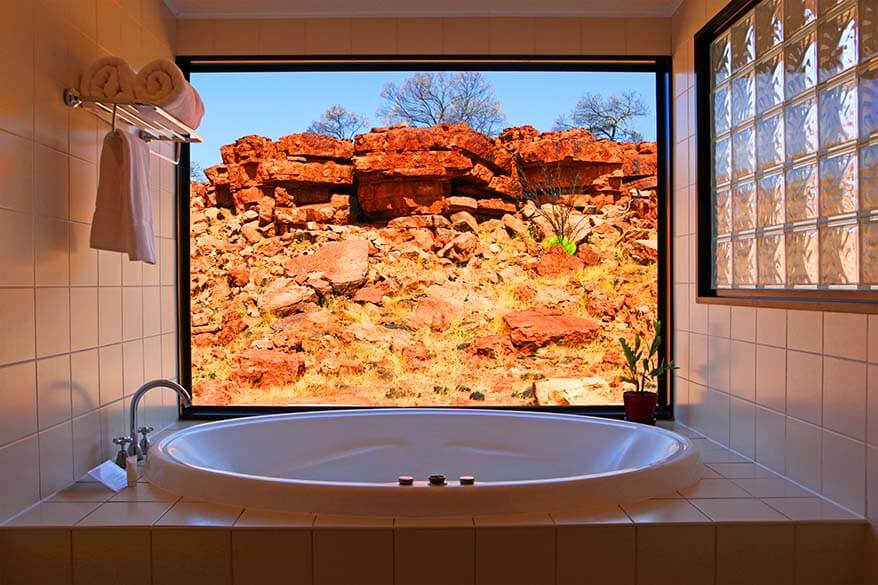
Day 4: Kings Canyon & Driving to Uluru – Kata Tjuta National Park
Kings canyon – watarrka national park.
The most beautiful walk at Kings Canyon is the Kings Canyon Rim Walk . It’s a 3-4 hour strenuous hike and you have to take a very early start if you intend to do it. It’s recommended to start at sunrise, at 6-7 AM and on a hot day they close the starting point of the walk by 9 AM.
With pain in our hearts, we decided not to do KingsCanyon Rim Walk with our kids. The 5-year-old could have probably done it without too many problems, but we just didn’t want to take the risk of taking three little kids up there on such a hot day. Temperatures reached 43°C by noon! We could have carried one or even two children if need be, but there is no way we could do this with three kids…
We chose to do the shorter walk at the bottom of the Kings Canyon instead – the Kings Creek Walk . It’s an easy yet spectacular walk between the red sheer walls of the canyon. Even the kids were impressed with the beauty around us. If you can, try to do both of these walks at Kings Canyon: the Rim Walk first thing in the morning and the Kings Creek Walk when you’re back down.
Afterwards we made a short walk at Kathleen Springs . This walk is easily accessible with a stroller, but not very spectacular. It’s ok if you are looking to fill your time here, but if you only do one walk, you better go for the Kings Canyon Rim Walk or Kings Creek Walk and skip Kathleen Springs altogether.
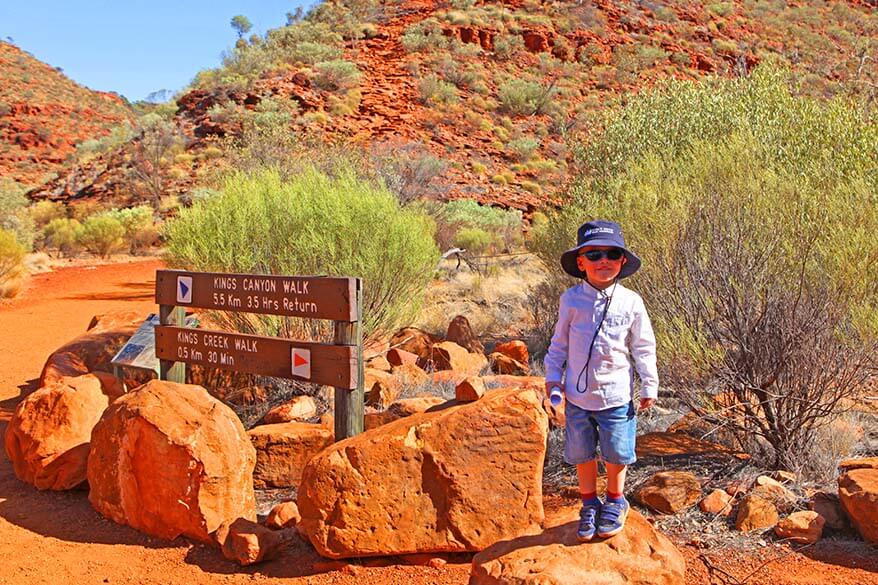
Kings Canyon to Ayers Rock Resort
In the afternoon we left the Kings Canyon and headed towards the Uluru – Kata Tjuta National Park.
The road from Kings Canyon to Uluru (Ayers Rock) is sealed. What a relief after yesterday!
On the way to Ayers Rock Resort, we stopped at Mt Conner outlook . The landscape is very impressive with bright orange/red sand all around you, Mt Connor in the distance, and an endless dried salt lake on the other side of the hill.
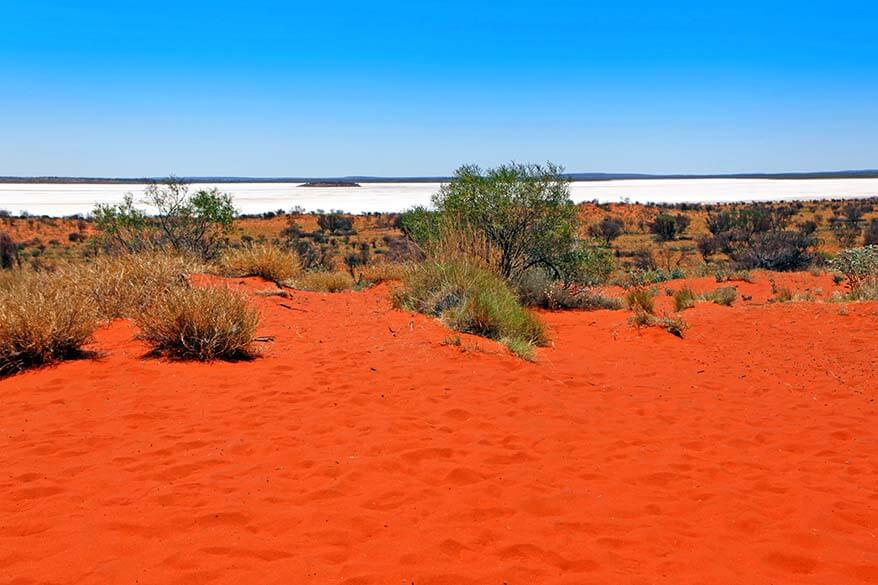
Yulara – Ayers Rock Resort
After a long drive through the beautiful red sand dunes landscape, we finally reached Yulara with Ayers Rock Resort.
Located only 15km from Uluru (Ayers Rock), the resort looks more like a little village with several hotels and other accommodation, a swimming pool, a petrol station, several shops, restaurants, and a small supermarket.
There are several accommodation options at the Ayers Rock Resort:
- We stayed at Emu Walk Apartments for 2 nights. This self-catering accommodation is ideal for families with children.
- The most luxury hotel at Ayer’s Rock is the 5* Sails in The Desert
- A bit cheaper 4* accommodation – Desert Gardens Hotel
- The best-priced hotel at Ayers Rock is probably the Outback Pioneer Hotel
- If all of the above are above your budget, the only other option is the Ayers Rock campground.
Sunset at Uluru – Ayers Rock
We decided to visit Uluru at sunset . There are just a few areas where you are allowed to park and watch the sunset, so we headed to one of them.
We found a huge car park that was full of cars and tourists. Some people were cooking dinner, some others were sitting on the roof of their cars (not a good idea, remember? :)) having a drink, somebody was singing… We counted almost 50 tripods and at least a hundred camping chairs. Unbelievable! It reminded me of those images you see on the news when thousands of people gather together expecting the end of the world… What a circus!
And as it often goes when expectations are this high, the reality disappoints. If you are looking for a romantic sunset experience at Uluru-Kata Tjuta, you may want to go somewhere else than the designated ‘sunset parking’.
The Olgas (Kata Tjuta) looked much nicer from afar, so that might be a good place or the base of Uluru itself. It will definitely be quieter.
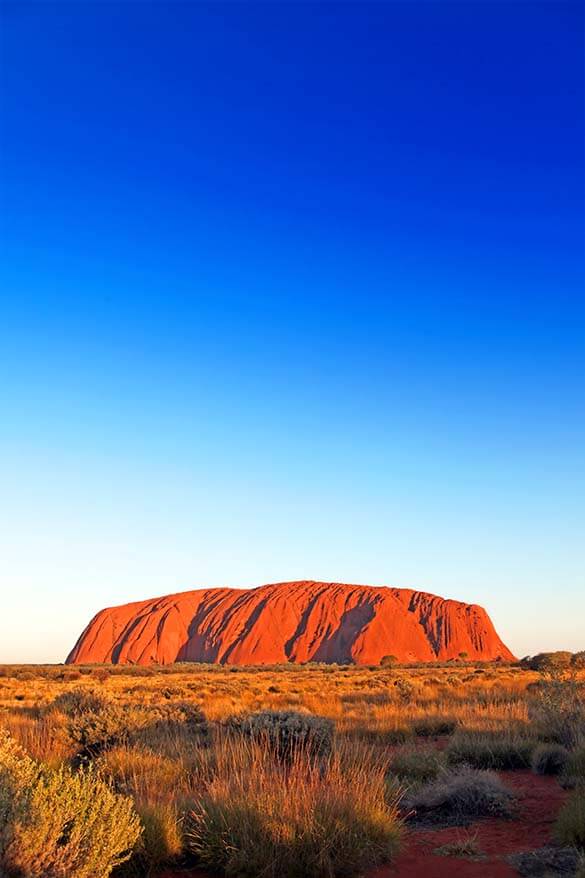
The highlight of any Uluru itinerary is a visit to the Uluru – Kata Tjuta National Park itself. If you don’t plan to hike much and the weather is not too hot, you could easily see everything here in just a day. We split our sightseeing over two mornings and could see everything we wanted and even do some hiking.
It was really hot when we visited Uluru. So we started the day early again because we wanted to try to do as much as we could in the morning before it got too hot to even be outside. Daytime temperatures were simply not human in November!
As if that was not enough, there were a lot of flies here. Swarms of flies EVERYWHERE. They were on your face, the lips, inside your nose, and your ears. That’s something you don’t see on the postcards or in promotional movies…
If I could give you one piece of advice it would be to bring a mosquito head net with you. They sell them in the area too, at about six times the regular price, but by the time you realize you need one, you are nowhere near the shops…

Hiking at Kata Tjuta (The Olgas)
The Olgas, or Kata Tjuta , are extremely spectacular, in a way more special and maybe even more impressive than the Ayers Rock. They are bright red in the midday sun and the view changes constantly as you approach these amazing rocks.
Our first stop was at the Kata Tjuta Dune Viewing Area . It’s only a short walk from the car (wheelchair accessible) and definitely worth a stop. Millions of flies though, so once again a head net would have been really useful!
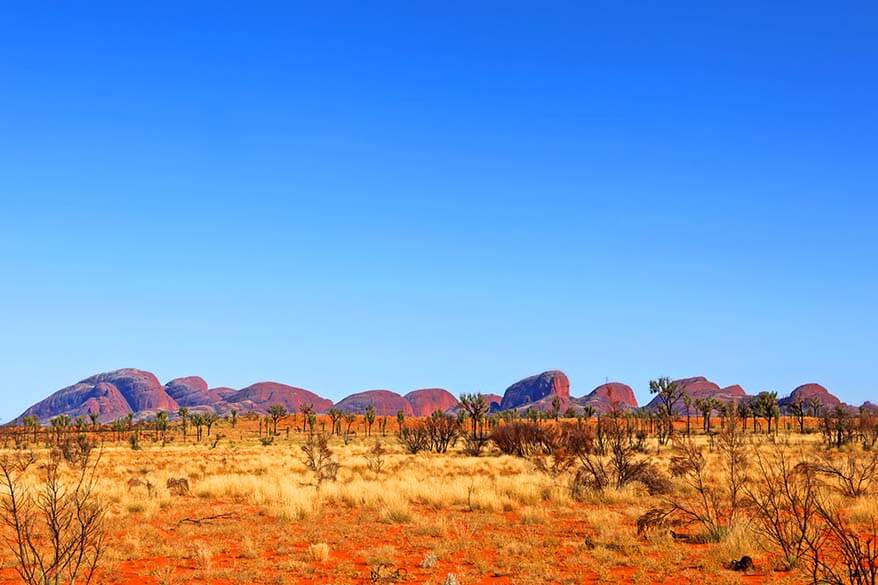
There are lots of beautiful hikes at Kata Tjuta and while not strenuous, they can become practically not doable in the desert heat, with or without kids.
Some walks get closed at 9 AM because of the heat, so if you plan to do any hiking, start very early.
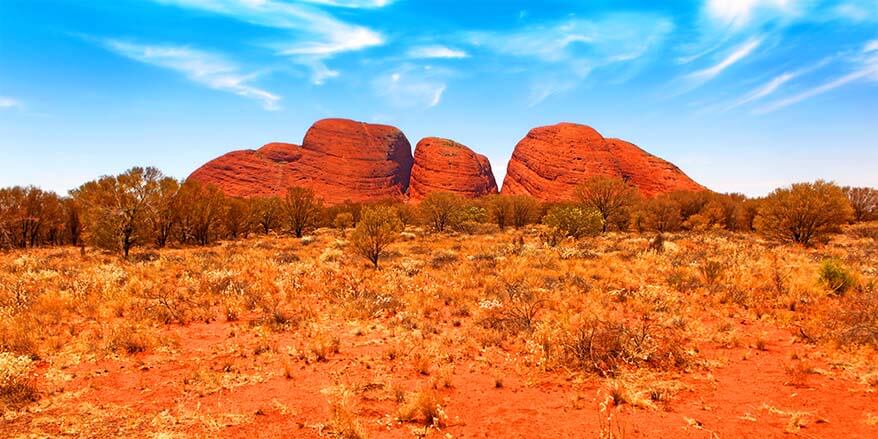
Walpa Gorge Walk at Kata Tjuta
We chose the Walpa Gorge walk since it was an easy short walk (2,6km, 1hr return) and we simply loved it! Phenomenal views along the way! If you are planning a trip to Uluru, make sure to visit Kata Tjuta as well!
LEARN MORE: Kata Tjuta & Walpa Gorge Hike
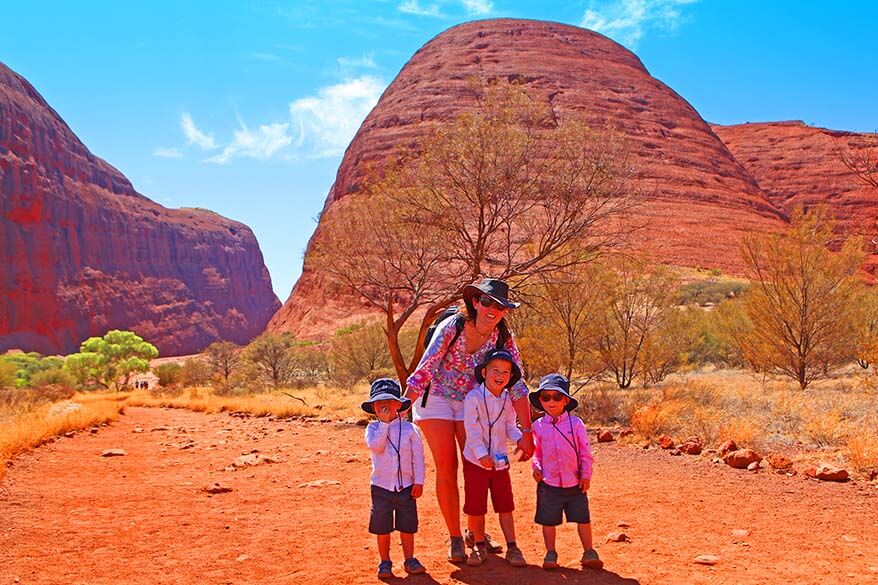
The Valley of the Winds
The Valley of the Winds Walk is said to be the most beautiful walk of Kata Tjuta. It’s a strenuous long walk (7,5km, 4hrs round) and it’s definitely not for everyone, certainly not in high temperatures. We didn’t even consider it.
However, you can easily do a part of the walk up to the Karu lookout point (2,2km, 1 hr return). I went on my own (my family decided to have a picnic in the air-conditioned car instead) and it took me half an hour return (I do walk fast). It was definitely worth the walk!
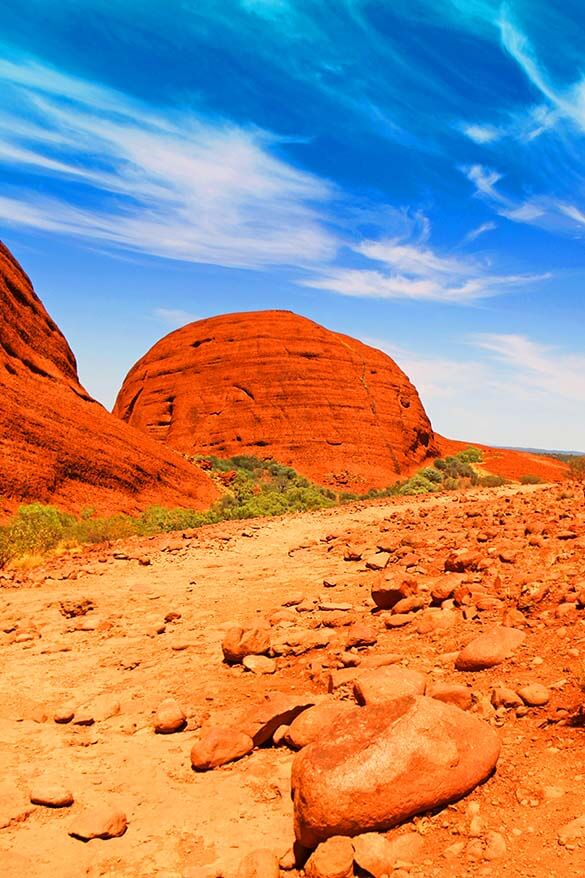
More Things to Do in Uluru
Hiking is not the only way to experience the Uluru – Kata Tjuta National Park.
Here is a short overview of some amazing things to do at the Ayers Rock:
- Uluru Sunrise or Sunset Camel Tour
- Uluru and Kata Tjuta Helicopter Experience (bucket list!)
- Uluru Sacred Sites Tour & BBQ dinner
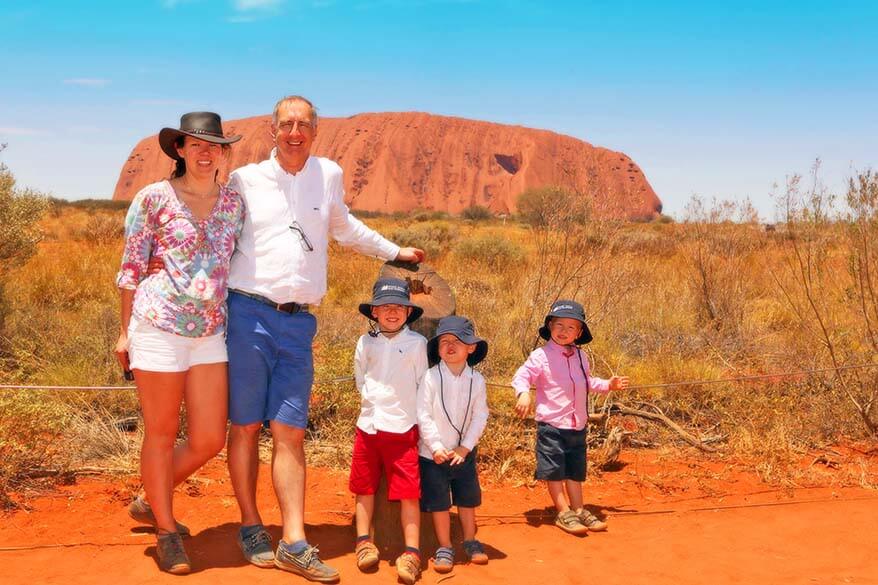
Day 6: Uluru (Ayers Rock) and back to Alice Springs
We had seen Uluru from a distance several times already – the classic view you see in all holiday brochures. But on our last day, we drove to the base of Uluru in order to explore it from close-by.
We found that it is so much more impressive from close by than it is from a distance!
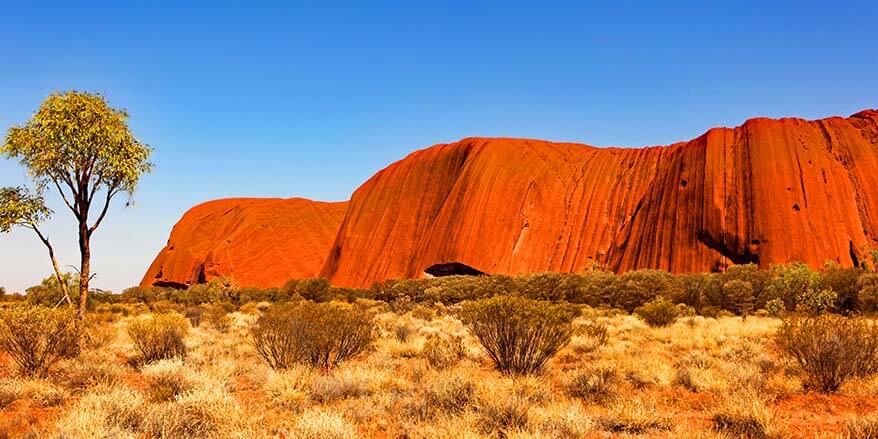
Climbing Uluru
There are several walks you can do at Uluru. You can opt for the Uluru Base Walk (10,6km, 3-4 hrs) that goes all the way around Ayers Rock, or you can choose one of the shorter options – sections of the long walk.
All the walks at Uluru are easy as the terrain is flat. When we visited, it was possible to climb Uluru, but Uluru is a sacred aboriginal site, so we chose not to do it. Nowadays, it’s forbidden to climb Uluru and I strongly urge you to respect this.
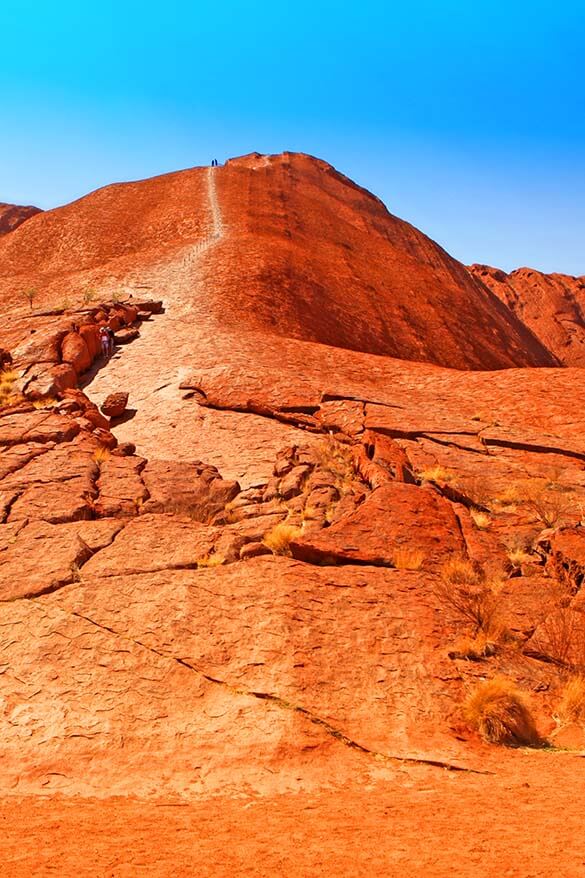
Uluru Base Walk
Uluru Base Walk is one of the best hikes you can do at Uluru. However, it’s a long hike of over 10km and takes at least 3,5-4 hours to complete.
It looked very nice, but it’s too long for a family with three young kids visiting in the summer. Instead, we decided to drive around by car and stop at some places to experience Uluru from close by. Of course, it’s not the same, but it’s definitely worth the short drive and it is a good alternative if for whatever reason you cannot do the long base walk.
If you like to get to know the aboriginal culture a bit more, make sure to visit the Aboriginal Cultural Centre as well. It’s a bit busy though as this is where all the tour busses stop. But this is also the only place where it is busy in Australia’s Red Centre. You’ll see no busses at Kata Tjuta, and you won’t meet groups of tourists on any of the walks.
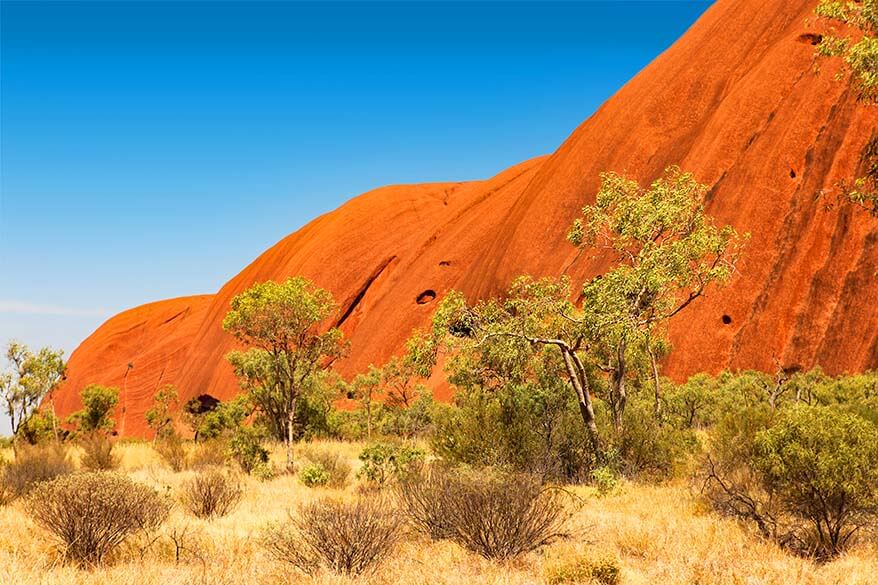
Mala Walk to Kantju Gorge
Based on some recommendations we found before our trip, we opted to do the Mala Walk to Kantju Gorge (2km, 1,5hr return, wheelchair accessible) and it didn’t disappoint! Magnificent scenery all around!
You have to see Uluru from close by to truly appreciate how special it is! It’s not ‘just a rock’ as someone told us before the trip. I would go back all the way to Australia to see it again and to explore this extraordinary region more in-depth.
The Mala Walk takes you to the profoundly peaceful Kantju Gorge. Sheer vertical walls and aboriginal rock paintings (Anangu rock art) make this walk really special. The kids enjoyed it a lot, and so did we.
Practical info: the Mala walk is flat and completely accessible for wheelchairs or strollers. This walk is partially in the shadow, so it can be done even when it’s really hot. Once a day (at 8 AM or 10 AM, depending on the season) you can join a free ranger-guided Mala walk, but the place was so peaceful that we definitely wouldn’t have wanted to share this experience with a group.
You can find more info in regards to Uluru and Kata Tjuta walks on the official website of Parks Australia .
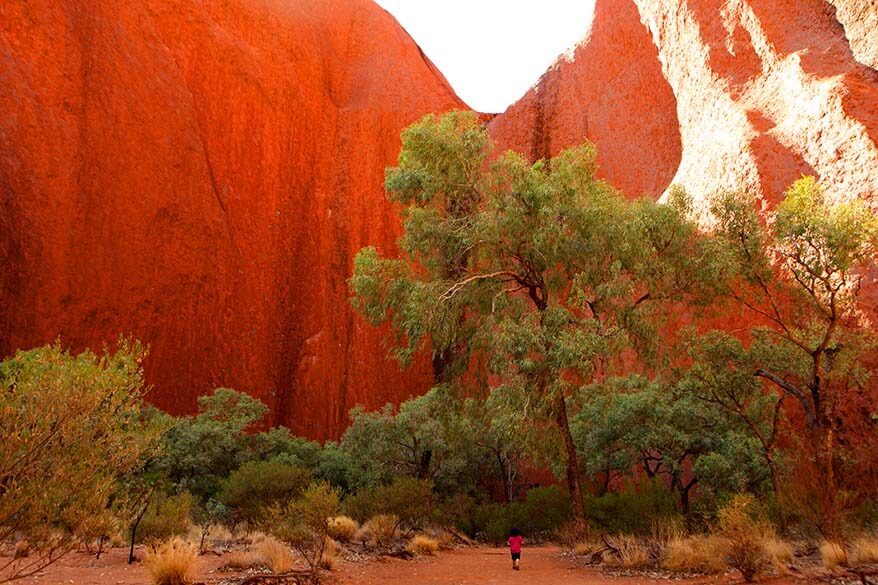
Uluru to Alice Springs
In the afternoon we left the Uluru – Kata Tjuta National Park for a long drive to Alice Springs. The road from Uluru to Alice Springs is sealed all the way. The driving distance is about 470km and it takes at least 5 hours. It took us 6 hours, photo stops included.
There is not much to see along the way, so we didn’t plan any stops. However, the first section of the highway has amazing scenery. You drive through a spectacular landscape with red sand dunes as far as the eye can see. A truly phenomenal sight!
At this point, we realized that we didn’t take any pictures of the red sand, and so we made a short photo stop in the desert. It was over 45°C and my family proclaimed me mad for getting out of the car to photograph sand, but as far as I’m concerned, I would do it again!
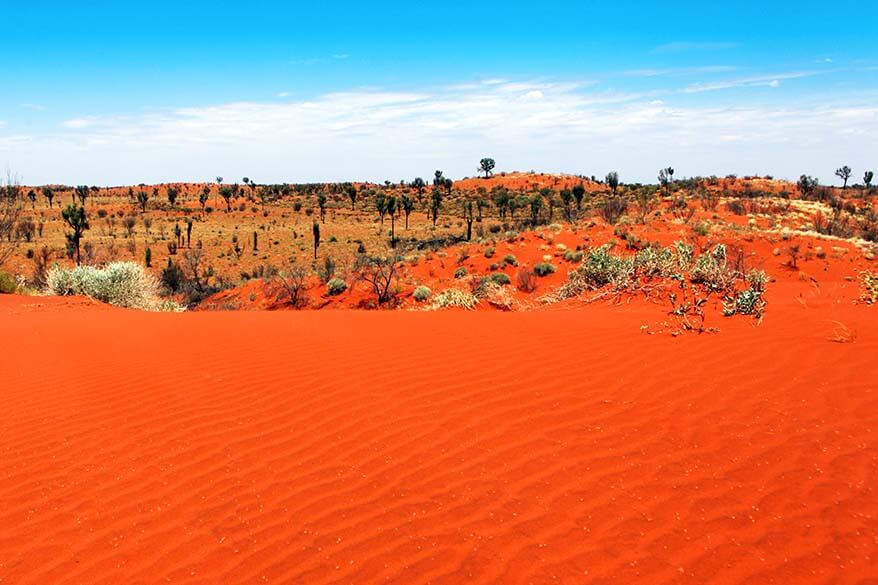
Back in Alice Springs
In Alice Springs we stayed at the same hotel as on the first night of our trip in the Red Centre – Alice on Todd . It felt like coming home.
The next day we flew to Adelaide from where we continued our Australian trip with a visit to Kangaroo Island , Great Ocean Road, and later also Tasmania. It was 20°C colder in Kangaroo Island than in Alice Springs and it probably made the whole Red Centre experience even more special.
Australia is so big and there is so much to see that we are definitely planning to return one day. If there is one place I would definitely want to visit again, it’s the Red Centre!
Below are those Red Centre trip suggestions I promised for budget travelers. Take a look!
If you have a limited budget and don’t want to spend money on expensive resorts and 4WD rental, there are several multi-day camping tours available in the Red Centre.
Most of them start and end in Alice Springs, which saves a lot of money and time. It might look not so cheap in the beginning, but if you consider the cost of a 4WD rental car, hotels, and food, it is. Especially if you’re traveling solo or just with two people.
Here is the best highly-rated budget-friendly Australia’s Red Centre camping tour that I found – the 3-Day Uluru – Kata Tjuta – Kings Canyon Camping Tour .
So, this is our Uluru itinerary starting and ending in Alice Springs.
As you can see, in 6 days, you can see all the highlights of Australia’s Red Center. If the temperatures are cooler when you travel, you could do much more hiking and explore most of the places deeper, or you could do a similar trip in 4-5 days as well. It’s really a matter of planning well and using the best hours of the day wisely.
Enjoy your trip!
More travel tips for Australia:
- Planning a trip to Australia
- Australia Itinerary
- One Day in Sydney
- Great Ocean Drive Best Stops
- Kennet River Koala Walk
- Kangaroo Island
- One Day in Melbourne
- Darwin Itinerary
- Hobart, Tasmania
If you found this post helpful, don’t forget to bookmark it and share it with your friends. Are you on Pinterest? Pin this image!
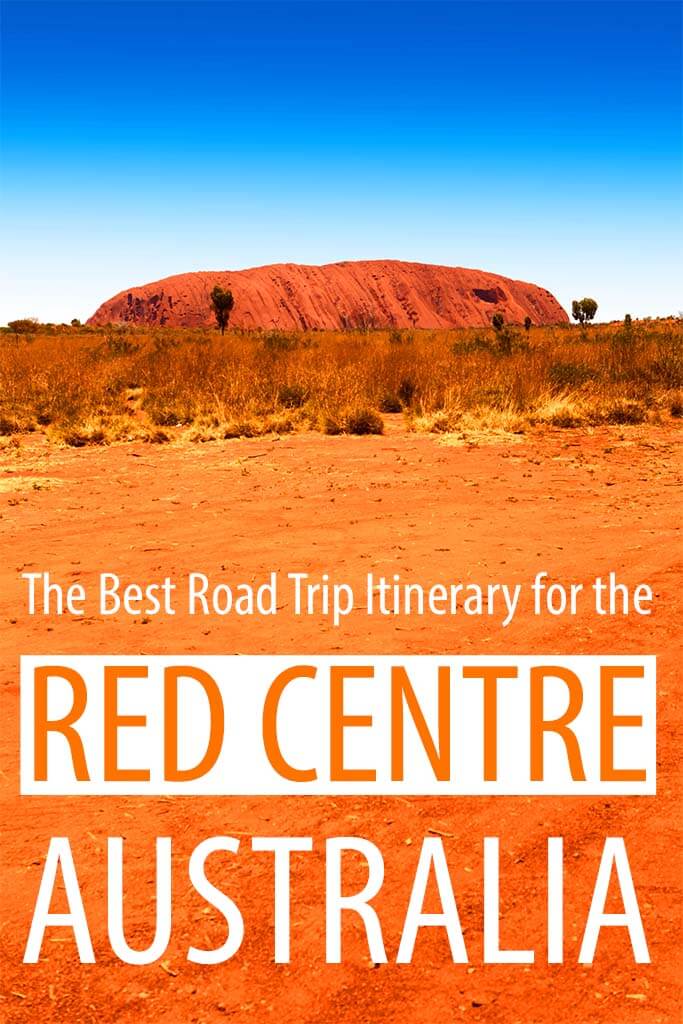
This site uses Akismet to reduce spam. Learn how your comment data is processed .
Saturday 1st of July 2023
Hi Jurga, thank you so much for all the great travel advice - I am just starting to plan a big Australia trip for my wife and I for next march and april - you have helped a lot !!! Trust all is good with you and your family and happy and safe travels.
Glad to help, Steve. Good luck with the planning and have a great time in Australia!
Wayne Power
Wednesday 5th of October 2022
Hi Thank you for sharing. Great job..My wife and I are planning on visiting Australia in mid February for at least six weeks. We are both in our mid-sixties but are in fairly good physical condition. I will be just the two of us and would really appreciate any advice you could give. Our dates are flexible but we want to avoid extreme heat . Thanks Wayne
Sunday 9th of October 2022
Hi Wayne, it's really difficult to give any useful advice not knowing what your interests are, your budget, where you fly to/from, or anything else really. And I really have no time to help our readers with detailed trip planning either. Take a look at this article for some information on how to approach this: Things to consider when planning a trip to Australia. You can also take a look at this 5-week Australia itinerary based on one of our trips. We did this trip in November, so it could work for February too, but yes, it will be hot at some places like Uluru. You can take away the places that don't interest you and/or add the areas that look more interesting (e.g. Great Barrier Reef or Perth) and make an itinerary that could work for you. Good luck with the planning!
Stephen Crocker
Thursday 30th of April 2020
As a "local" (or at least someone who has explored much there after my travels from NSW) may I suggest you should, if at all possible, plan to visit between late May and up to the end of September. Wonderful! Yes, some of the scenery may seem monotonous at times but have an relaxed attitude and you'll find yourself adjusting quite quickly. We took our 3 little ones across the Nullabour in 1992 and some of the great memories we and they have are of just stopping when they were getting a bit stroppy and just kicking a football around. We brewed up a cuppa on the side of the road. There don't seem many places these days where you can stop safely virtually the second you decide to. There will always be a tree or decent sized bush to give at least partial shade but in the winter/spring months it won't be a problem anyway. In places like those it can be eerie in near soundlessness, just hearing your blood going through your ear canals
Saturday 2nd of May 2020
Thanks for sharing your experience, Stephen. We'll be back Down Under one day again. The Red Center is a place like no other. Loved it, despite the heat.
Thursday 29th of August 2019
Reading your post brings back splendid memories :-) We were there in Uluru Aug last year & it was a fantastic experience. Thank goodness there were no flies, yes practically fly-free during winter. Especially love the Red Centre, views & walks of Uluru, Kata Tjuta & Kings Canyon was simply stunning. Never miss watching the sunrise & sunset. Every view has their 'WOW' effect. Our stay at Emu Walk Apartments was great too. My advise, to at least stay 3 days to truly enjoy this fascinating place.
Hi Kelly, just reading this I want to go back and visit again :) It's an amazing place, indeed. I hope we get back there one day and explore it more in-depth now that the kids are older. Happy travels!
Monday 4th of March 2019
This is so helpful, thank you. We are tentatively planning a trip to the Red Center in May of this year. We have a 3 yr old and a 9 month old baby. Would this trip be okay with a baby? I know your kids were a bit older -- I can't seem to find any blogs or info on Uluru/Alice/Kings with a baby. We hike and use baby carriers at home. Just worried about stocking up on food (I imagine the grocery options out there are limited - baby food even more so?) flies, potential danger from spiders/snakes since he will want to crawl on occasion despite our best efforts haha. Any tips would be appreciated!
Sunday 10th of March 2019
Hi, I really don't see why you couldn't visit the Red Centre with a baby. There are shops and even quite a big supermarket in Yulara, just next to the entrance to Uluru-Kata Tjuta NP, where all accommodations are also located. So you'll find whatever you need there. I'm not sure specifically about baby food or diapers, but I think it shouldn't be a problem. In any case, in Alice Springs you'll be able to buy all you need, so you can stock up there before leaving the town. As for spiders or snakes, we didn't see any. Flies - we visited in November and it was indeed a problem. Not sure how it is in May, I imagine it will be much cooler and also maybe less flies. But you may want to get a headnet just in case. Enjoy the trip - there will always be challenges, but it's a beautiful area and well worth visiting!
Beyond Wild Places
Your guide to the wilder side of life
The Ultimate Red Centre Way Road Trip Itinerary
If you’re heading to Central Australia, this Red Centre Way itinerary will help you see the very best that this region has to offer on an incredible road trip. The Northern Territory was made for driving holidays, with plenty of incredible sights and attractions taking hours to reach on remote outback roads. However, all the driving is rewarding with some seriously epic scenery and some of Australia’s most famous natural landmarks.
From Uluru and Kata Tjuta to the underrated West MacDonnell Ranges, a road trip on the Red Centre Way is definitely a highlight of any trip to the Northern Territory. I spent more than six weeks in Central Australia in my van, and I can say that it’s a place that every Aussie should visit one day.
I’ve put together this Red Centre Way road trip itinerary for anyone heading to the Northern Territory and wanting to explore the best places on a self-drive trip. Whether you’ve got a 2WD or 4WD, I’ve got you covered!
Disclaimer: This post contains affiliate links which means I get a commission if you buy a product through my link at no extra cost to you. By doing so, I can keep this blog going and continue to create helpful guides for you. Read more: Privacy Policy
About the Red Centre Way
The Red Centre Way is the name given to the road trip connecting Uluru and Kata Tjuta National Park with Watarrka National Park and Kings Canyon, up to the West MacDonnell Ranges and Alice Springs. It’s considered one of Australia’s most iconic road trips, taking in some of the best sights in the Northern Territory.
While it’s usually described as a sort-of loop road trip, this is unfortunately reserved for 4WD vehicles as the Mereenie Loop requires a permit which is usually not given to a 2WD. However, it’s not the end of the world! This doesn’t mean that you get to miss out on a lot, it simply means that you have to drive a few more kms to get around to all the spots.
I’m going to detail my recommended Red Centre Way itinerary for 2WD vehicles below. If you have a 4WD, I will also include how you can complete the Mereenie Loop and head to a couple more sights as well. This itinerary is based on driving north from South Australia and finishing in Alice Springs, but you can easily complete this in reverse if you’re starting in Alice Springs.

Essential information about the Red Centre Way
Fuel: There’s not a whole lot of fuel stops on the Red Centre Way. You need to be aware of how much you have in your tank and where the next fuel station is. Most of the fuel can be found at roadhouses on the way. I’ve detailed the fuel available in the itinerary below to make things easier for your planning.
Phone reception: Another thing that is quite limited out in Central Australia! You won’t find a lot of phone signal at all on the Red Centre Way. Yulara and Alice Springs are the only places that you’ll find 4G network. Erldunda Roadhouse, Curtin Springs and Kings Canyon Resort have some Telstra and Optus reception (although not so reliable). In the West MacDonnell National Park, Optus has good reception at Ormiston Gorge and Glen Helen Gorge, while Telstra has reception at Standley Chasm and Neil Hargrave Lookout.
Road conditions: The 2WD itinerary I outline below is all on sealed roads in good condition. The Mereenie Loop is the only part of the Red Centre Way that is unsealed, with about 150km on dirt road. It’s usually in pretty good condition with some corrugations. However, conditions can change after heavy rain. It’s best to ask at Kings Canyon Resort or the Alice Springs Tourist Information Centre for the latest updates on the road.
Permits: You will need a permit to drive on the Mereenie Loop, which is on Aboriginal land. A Mereenie Loop Permit is valid for three days and can be purchased from Alice Springs Tourist Information Centre, Kings Canyon Resort or Hermannsburg General Store. It costs $6.50 currently (in 2021).
Accommodation: You can opt for a range of accommodation on the Red Centre Way. Hotels and resorts can be found in Yulara, Alice Springs and at Kings Canyon Resort. Otherwise, outside of these places you’ll be limited to roadhouses and camping. Camping is definitely the most convenient way to stay on the Red Centre Way, whether you have a motorhome or tent, there are some great campgrounds.
Drones: You can’t use your drone in Uluru and Kata Tjuta National Park or above Kings Canyon. However, you can fly your drone pretty much everywhere else on the Red Centre Way, including in the West MacDonnell Ranges, as long as you have a free drone permit which you can get online.
Walks: If you’re a keen hiker then Central Australia has some fantastic trails to check out on your Red Centre road trip. I’ve put together a guide to 8 of the best walks in Central Australia , if you want to add some decent day hikes into your trip.
Don’t forget your NT Parks Pass. Get yours here !

Red Centre Way itinerary
If you’re driving north on the Stuart Highway from Coober Pedy in South Australia, your Red Centre road trip begins once you reach Erldunda Roadhouse on the highway. This is where the Lasseter Highway turnoff and detour to Uluru begins!
1. Erldunda Roadhouse to Yulara
Distance: 246km or 2.5 hour drive Fuel: Curtin Springs Station, 160km from Erldunda Roadhouse
Erldunda Roadhouse is on the corner of Stuart Highway and Lasseter Highway. The roadhouse is known as the “centre of the centre” (one of the spots claimed as the very centre of Australia) and is where you leave the Stuart Highway and head west for Yulara and Uluru.
The roadhouse has fuel, a basic shop, hot food and cafe, bar, public toilets and accommodation. They offer motel units and camping sites with powered and unpowered options. The facilities are also pretty good, with a swimming pool, laundry and hot showers.
After stopping for fuel and food or even for the night, turn off down the Lasseter Highway and drive the 246km to Yulara. This highway is in good condition, with a number of basic rest stops to have a break along the way.
A couple of spots worth stopping at are: Mt Conner Lookout Rest Area , which offers a nice view across to Mt Connor or Atila , and Curtin Springs Wayside Inn , which is a fuel station, bar and restaurant.
Once you get to Yulara, there are plenty of accommodation options, restaurants and a few shops, including a fuel station. This is the main town from which you can explore Uluru and Kata Tjuta.

2. Uluru-Kata Tjuta National Park
Obviously the highlight of any Red Centre Way road trip, Uluru and Kata Tjuta is the ultimate destination in Central Australia. Yulara is the main town and base from which you can explore the national park and is just 4km from the park entry station.
You’ll need a Parks Pass, which you can either buy at the entrance gate or online prior to your arrival. The pass is a three day entry pass which must be scanned every time you enter through the park station and costs $38. This means that most people make full use of the pass and stay at Yulara for three days.
However, a little known fact is that the pass can be extended to five days, free of cost. You just have to ask at the entrance gate on your third day, I you want to linger a little longer.
There’s plenty of things to see and do, including walks, viewpoints and tours. Some of my top recommendations, if you have at least three days in the park are:
- Free ranger guided Mala walk: A great 2km guided walk with a park ranger which leaves from the Mala car park at Uluru every day at around 10am.
- Uluru base walk: This 10km trail takes you around the entire base of the rock, and can be either walked or cycled.
- Valley of the Winds walk: The 7.5km moderate loop hike at Kata Tjuta is simply spectacular with incredible views of the dome sandstone rocks.
- Uluru car sunset viewing: The best spot to watch the sunset in the park, from the comfort of your vehicle. Get there very early for a good spot.
- Uluru Sunrise Viewing Platform/Talinguru Nyakunytjaku : The famous sunrise location at Uluru is located past the cultural centre and can be very crowded in high season.
- Kata Tjuta Dune Viewing Sunrise: This purpose built platform at Kata Tjuta is actually nice at both sunrise and sunset, but is a lot more popular at sunrise.
I go into a lot more detail about some of these walks and viewing spots in my Guide to Uluru and Kata Tjuta National Park .

3. Yulara to Watarrka National Park and Kings Canyon
Distance: 304km or 3.5 hour drive Fuel: Curtin Springs, 86km from Yulara
Once you’ve admired Uluru and Kata Tjuta for long enough, you can continue on your Red Centre Way to another famous natural landmark: Kings Canyon. From Yulara, you can easily drive there in half a day. You have to head back along Lasseter Highway and then take the turnoff towards Watarrka National Park on Luritja Road.
There’s not a whole lot to see on the way with the 304km journey taking you north across the desert. You will pass Curtin Springs again and then Kings Creek Station as you get closer to Watarrka National Park, if you need fuel or want to stop for some food.
After you enter the national park (there’s no parks pass required), you’ll come across Kathleen Springs on your right. This is a nice spot to stop and enjoy an easy 2.6km return walk to a natural spring to stretch your legs.
Once you continue your drive, you’ll see the turn-off for Kings Canyon and the main trailhead for the walks on your right. But if you continue a little further, you’ll finally come to Kings Canyon Resort, which is the only place with facilities and services including accommodation inside the national park.
They have a large caravan park area with powered and unpowered sites, a swimming pool and toilet and shower blocks. If you’re not a camper, then they also have resort accommodation with private rooms and glamping available. There’s a restaurant, petrol station and basic shop on site too for supplies. From there, you can easily explore Kings Canyon.

4. Kings Canyon and Watarrka National Park
Kings Canyon is one of the most incredible sights in Central Australia. The beautiful canyon is best explored on foot, with a couple of walking trails, including a rim walk which is one of the best hikes in the state.
It is conveniently only 10km between Kings Canyon Resort and Kings Canyon car park and walking trails. Most people spend just a night to have enough time to do the Kings Canyon Rim Walk, but if you’re a keen hiker, you can easily spend two nights and hit some more trails as well. The must do walks at Kings Canyon are:
- Kings Creek Walk: An easy 2.6km return trail into the canyon floor.
- Kings Canyon Rim Walk: A spectacular 6km loop walk is one of the best hikes in the Northern Territory with incredible views from the rim. It requires some steep climbing to begin, but is worth all the effort.
- Giles Track: A 22km one way trail connecting Kings Canyon with Kathleen Springs which can be done as an overnight walk or you can just do a section as a day hike.
If you want to read more about visiting King Canyon, then I have a guide to Watarrka National Park , with more information on these walks.

5. Watarrka National Park back to Erldunda Roadhouse (2WD option)
Distance: 274km or 3 hour drive Fuel: None available after Kings Creek Station, 39km from Kings Canyon
If you’ve finished exploring Kings Canyon, this is where you have a couple of options depending on your vehicle. The Red Centre Way technically heads up to the West MacDonnell Ranges via the Mereenie Loop. However, this is an unsealed road and a permit is required as it travels through Aboriginal land. When I was there in mid-2021, they were only issuing permits to 4WD vehicles, which means that 2WDs must head back out to the Stuart Highway and up to Alice Springs.
This may change in the future, but if not, from Watarrka National Park you must drive back out to Erldunda Roadhouse on the Stuart Highway. This 274km drive follows the same roads that you drove in from, with very limited services on the way. You can either stop in Erldunda Roadhouse to camp the night or continue onto Alice Springs which is another 200km.
If you want to take the Mereenie Loop, keen reading below.

Alternative 4WD option: Watarrka National Park to West MacDonnell Ranges via Mereenie Loop
Distance: 226km or 3 hour drive to Glen Helen Gorge or 197km or 2.5 hour drive to Hermannsburg Fuel: None until Alice Springs, but if you need to refuel you can detour to Hermannsburg (Glen Helen does not currently have fuel available)
If you have a 4WD or manage to secure a permit with a 2WD, then you can take the Mereenie Loop up to the West MacDonnell Ranges. This drive requires a permit which can be bought at Kings Canyon Resort and costs $6.50. The loop road continues past Kings Canyon Resort and heads around and connects onto Larapinta Drive and Namatjira Drive. The unsealed section lasts for around 115km and is fairly corrugated. The conditions can vary but it is graded a couple of times per year. You don’t technically need a high clearance vehicle, but it’s recommended for 4WD only as it can be rough.
After 150km, you’ll reach the major intersection at the western end of the MacDonnell Ranges. You can either continue straight to Hermannsburg and the Finke Gorge National Park (a 4WD only park) or turn left onto Namatjira Drive towards Glen Helen and the rest of the West MacDonnell National Park (accessible for all vehicles).
If you have a 4WD it’s worth checking out both the West Macs and the Finke Gorge National Park, if you can. The latter is far less explored and includes the incredible Palm Valley, with a great campground that is high clearance 4WD accessible only.
Fuel is a little concern for those taking this itinerary option. Once you leave Kings Canyon Resort, there is no fuel until Hermannsburg which is 197km, but if you plan on heading up to the West MacDonnell Ranges on Namatjira Drive instead, there is no fuel until Alice Springs. Unfortunately, Glen Helen does not have fuel at the moment, so you may have to detour to Hermannsburg to get some fuel before heading to the West Macs.
If you end up taking this route to the West Macs via the Mereenie Loop, you can skip the next two sections to number 8.

6. Erldunda Roadhouse to Alice Springs
Distance: 200km or 2 hour drive Fuel: Stuarts Well Roadhouse, 108km from Erldunda Roadhouse
The drive along the Stuart Highway between Erldunda Roadhouse and Alice Springs isn’t all that exciting. The 200km stretch only has supplies available at Stuarts Well Roadhouse.
Alice Springs is the major town of Central Australia and a great base for exploring the MacDonnell Ranges. There’s everything that you’ll need in town, from caravan parks to hotels and plenty of shops, cafes and supermarkets. If you have the time, it’s worth staying a couple of days in town to check out the shops and cafes, before exploring both the West MacDonnell Ranges and East MacDonnell Ranges.
Read next: Best Things to Do in Alice Springs

7. Alice Springs to West MacDonnell Ranges
Distance: 133km or 1.5 hour drive to Glen Helen Gorge Fuel: None available
The West MacDonnell National Park is one pf my favourite national parks. The incredible mountain range hides gorges, gaps and water holes that can easily be explored west of Alice Springs.
Most of the sights and attractions, are all located off Larapinta and Namatjira Drive, making it easy to get around the park for all vehicles.
While you can technically head out there on a day trip, it’s worth staying at least a night in either a national park campground or the Glen Helen Resort. There are campgrounds at many of the major attractions, including Standley Chasm, Ellery Creek, Ormiston Gorge and Redbank Gorge. I would recommend staying up to three nights, which will enable you to explore the park at a slower pace and do some of the walks.

8. West MacDonnell Ranges
The West MacDonnell Ranges known as Tjoritja are a stunning part of Central Australia, with most of the attractions accessible by 2WD vehicle. Some of the best spots to stop and check out include:
- Simpsons Gap: One of the prettiest gaps, Simpsons Gap is only 24km from Alice Springs.
- Standley Chasm: This towering chasm is a very sacred sight for the Arrernte people and a unique place to visit. There’s also a campground, kiosk and shop in the car park.
- Ellery Creek Big Hole: A popular attraction, this gorge and permanent water hole is a great swimming spot if you’re keen. There’s also a campground there as well.
- Ormiston Gorge: The highlight of the West Macs for many people, Ormiston is a stunning gorge and semi-permenant water hole with red rock walls that tower high above the sandy creek bed. There’s a wonderful kiosk, campground and some excellent walks to do there too.
- Redbank Gorge: A bit further along, Redbank Gorge is a lesser visited spot and a bit further off the road, but is worth a visit. It’s also at the base of Mt Sonder, which you can climb to the top for a beautiful sunrise.
I have a complete guide to the West MacDonnell Ranges if you want to read more about these spots and more.

9. Alice Springs to East MacDonnell Ranges
Distance: 78km or 1 hour drive to Trephina Gorge Fuel: None available, unless you go to Ross River Resort, 19km from Trephina Gorge
Most people finish their Red Centre Way road trip once they’ve explored the West MacDonnell Ranges and head back to Alice Springs. However, I would encourage you to head out to the East MacDonnell Ranges as well. This more rugged and less visited part of the ranges is equally as spectacular.
Many of the sights are sacred Aboriginal places, so it’s a nice way to explore more of the local Arrernte culture. There are also gorges, water holes and some varied walks, so you can easily extend your visit longer than a day.
Most of the main attractions can be seen off the Ross Highway, and can be done in one long day trip from Alice Springs. However, as always, I. would recommend you camp at least a night out there, preferably at Trephina Gorge. Some of the best things to see in the East Macs are:
- Emily and Jessie Gaps/Yeperenye: Two gaps outside of Alice Springs where you can admire some unique Aboriginal rock art telling the dreaming story of Yeperenye .
- Corroboree Rock: A sacred men’s site and unique geological formation estimated at 800 million years old.
- Trephina Gorge Nature Park: An incredible park with two gorges, waterholes and some of the best walks in the area. Plus you’ll also find a few bush campgrounds to get away from it all.
If you have a 4WD you can spend even longer out there, with some other more remote places such as Ruby Gap and N’Dhala Gorge Nature Park to check out and camp at.
You can find more information about these places, plus the walks to do in my guide to the East MacDonnell Ranges .
Pin this post

Share this:

The Ultimate Adelaide to Darwin Road Trip Itinerary

A Complete Guide to Nitmiluk National Park – Katherine Gorge

An Essential Guide to Visiting Edith Falls / Leliyn

Perth to Kalbarri Road Trip: The Perfect 5 Day Itinerary
[…] epic views across the heart of Australia. So, don’t forget to pack your hiking boots on your Red Centre Way road trip and get ready to hit some of these trails that I outline […]
[…] at the Ayers Rock Campground. It was definitely a highlight of my time travelling along the Red Centre Way through Central Australia and even after five days, I still found myself staring in awe at this […]
Leave a Reply Cancel reply
Discover more from beyond wild places.
Subscribe now to keep reading and get access to the full archive.
Type your email…
Continue reading

8 Reasons To Visit The Red Centre in Australia!
Categories Australia , Oceania
Visiting the Red Centre in Australia is a must! The Red Centre is the very centre of Australia within the Northern Territory state and it’s known as the Red Centre because its landscape is, well, very red!
Whilst many people, especially Australian’s, may tell you there is nothing to see in the centre of Australia, they are wrong! Yes, Central Australia is extremely vast, dusty and empty in many places but there are National Parks to visit, road trip adventures to be had, cultural learning opportunities and one of the most famous places in the world to see… Uluru!
I did an organised 3 day Red Centre Tour from Alice Springs when I lived in Australia and along with living in Darwin for a short time I realised how many people miss out on the iconic and in some ways ‘real’ Australia by not visiting the Northern Territory state and the Red Centre specifically.
So in this post I am reliving my Red Centre tour and along with the help of NT Tourism , I’m going to tell you why you should add the Red Centre to your Australia itinerary!
Reasons to visit the Red Centre
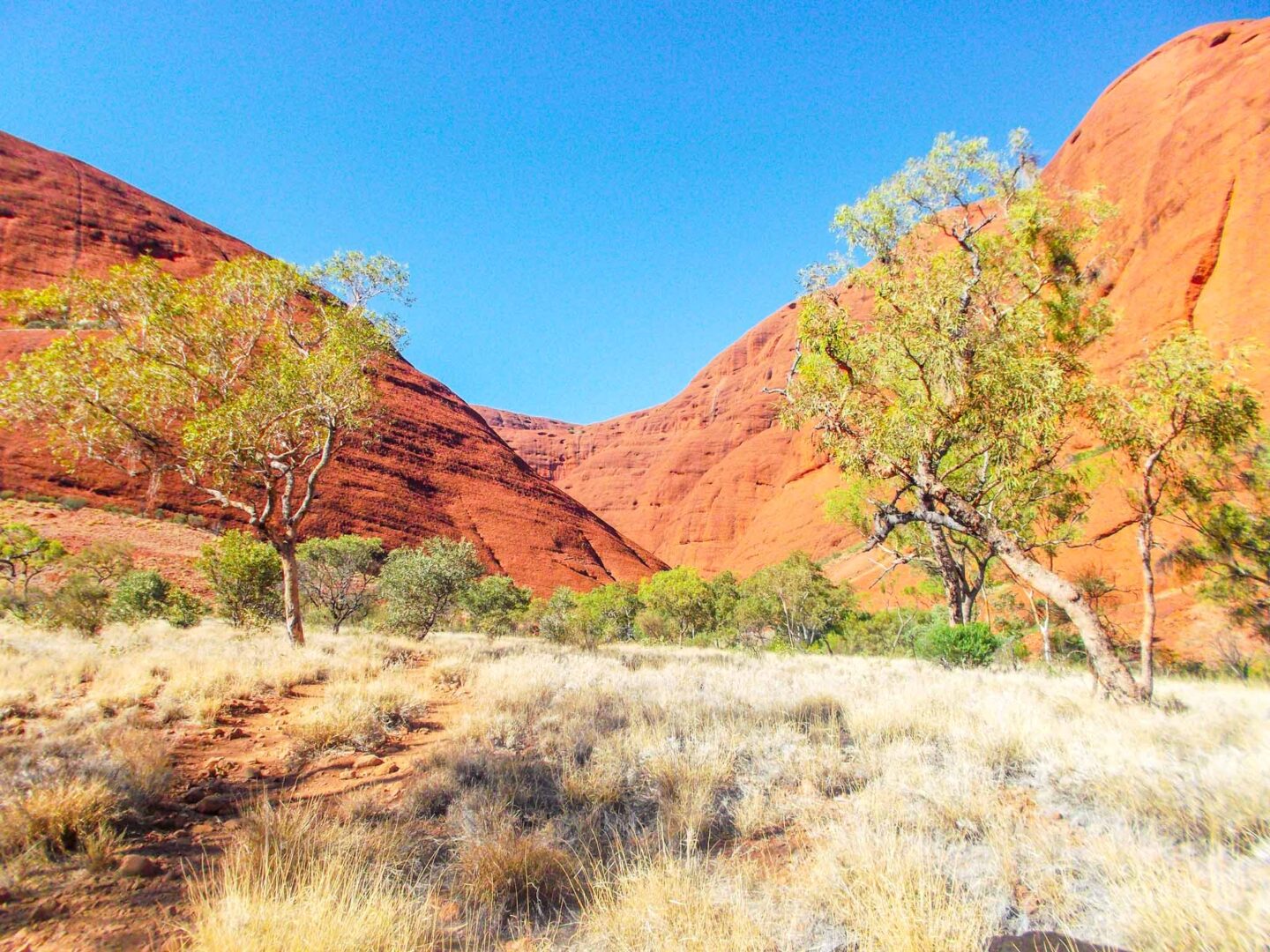
Related Post: 10 Things To Do In The Northern Territory On My Bucket List!
1. Uluru = Bucket List Tick!
Uluru / Ayers Rock is easily the most iconic place in Australia and one of the top iconic places in the world! You can’t leave Australia without seeing it and you can’t see it without visiting Australia’s Red Centre!
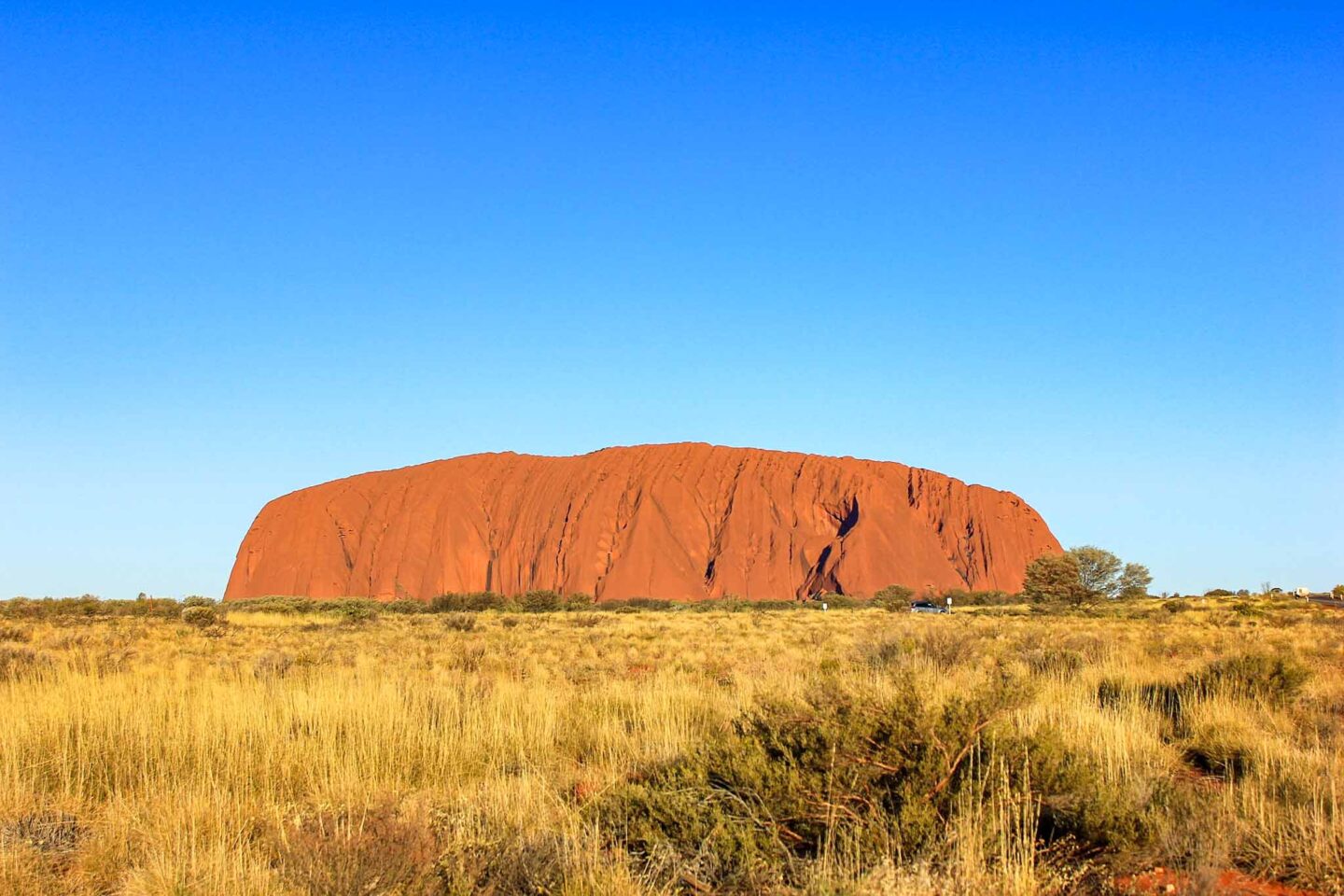
For many of us, a trip to the Red Centre in the Northern Territory will be because we want to see Uluru in real life and based on my experience, it doesn’t disappoint and is well worth the trip into the centre of Australia alone!
Uluru really is magical and incredibly impressive, it’s a pure wonder of the world and it is also a deeply spiritual place.
Uluru and the surrounding area has huge cultural significance to the local Aboriginal people and learning about this whilst at Uluru and feeling the presence of the land around you somehow makes it feel even more special.
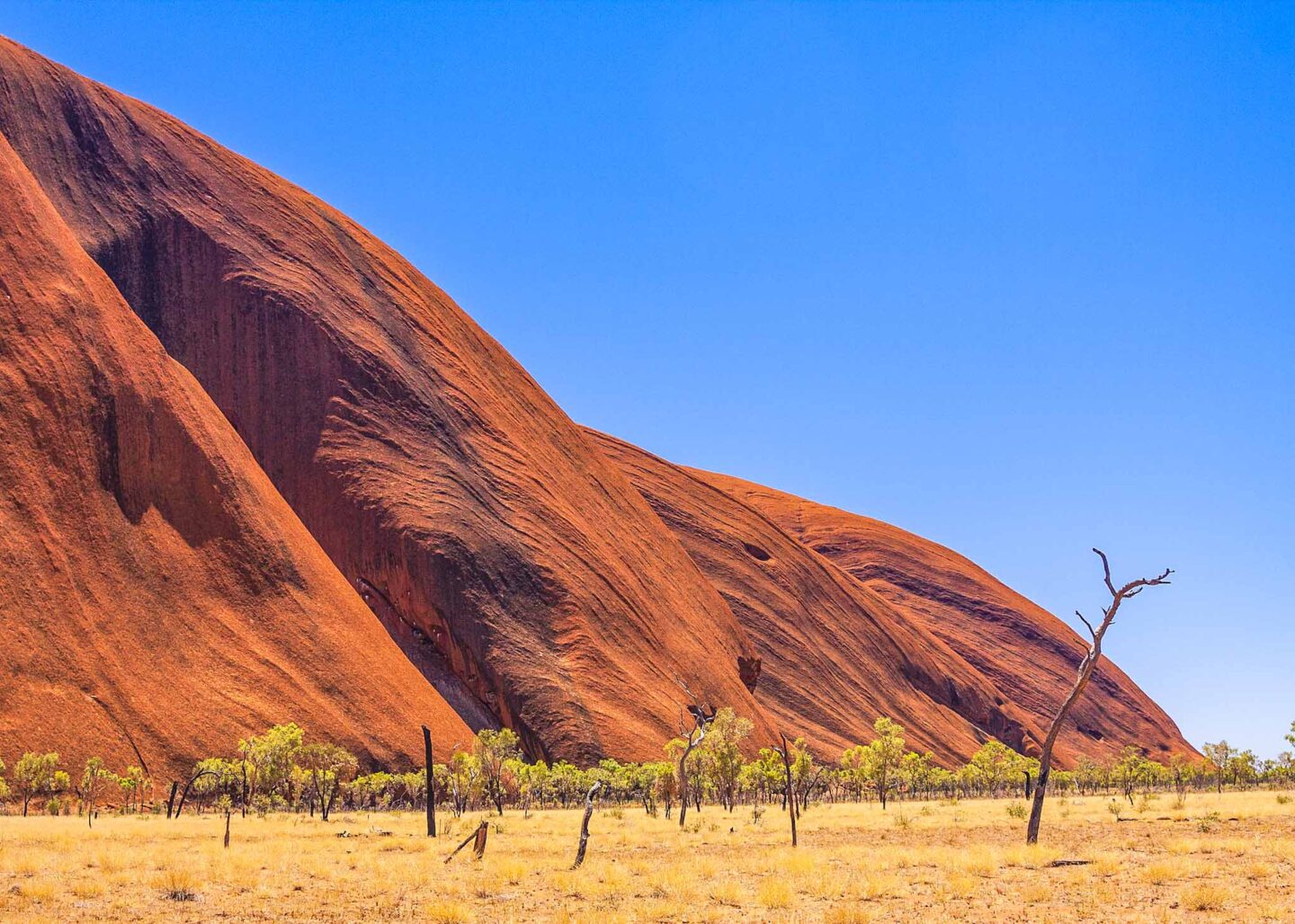
2. Seeing Uluru in All Forms
Another amazing thing about Uluru is how the colour of the rock changes throughout the day from sunrise, day time, sunset and night time.
Your Red Centre itinerary should include watching the sunrise over Uluru, visiting the base in the day time (if visiting during the hot months, try to avoid doing this in the middle of the day when it’s extra hot!), and at sunset .
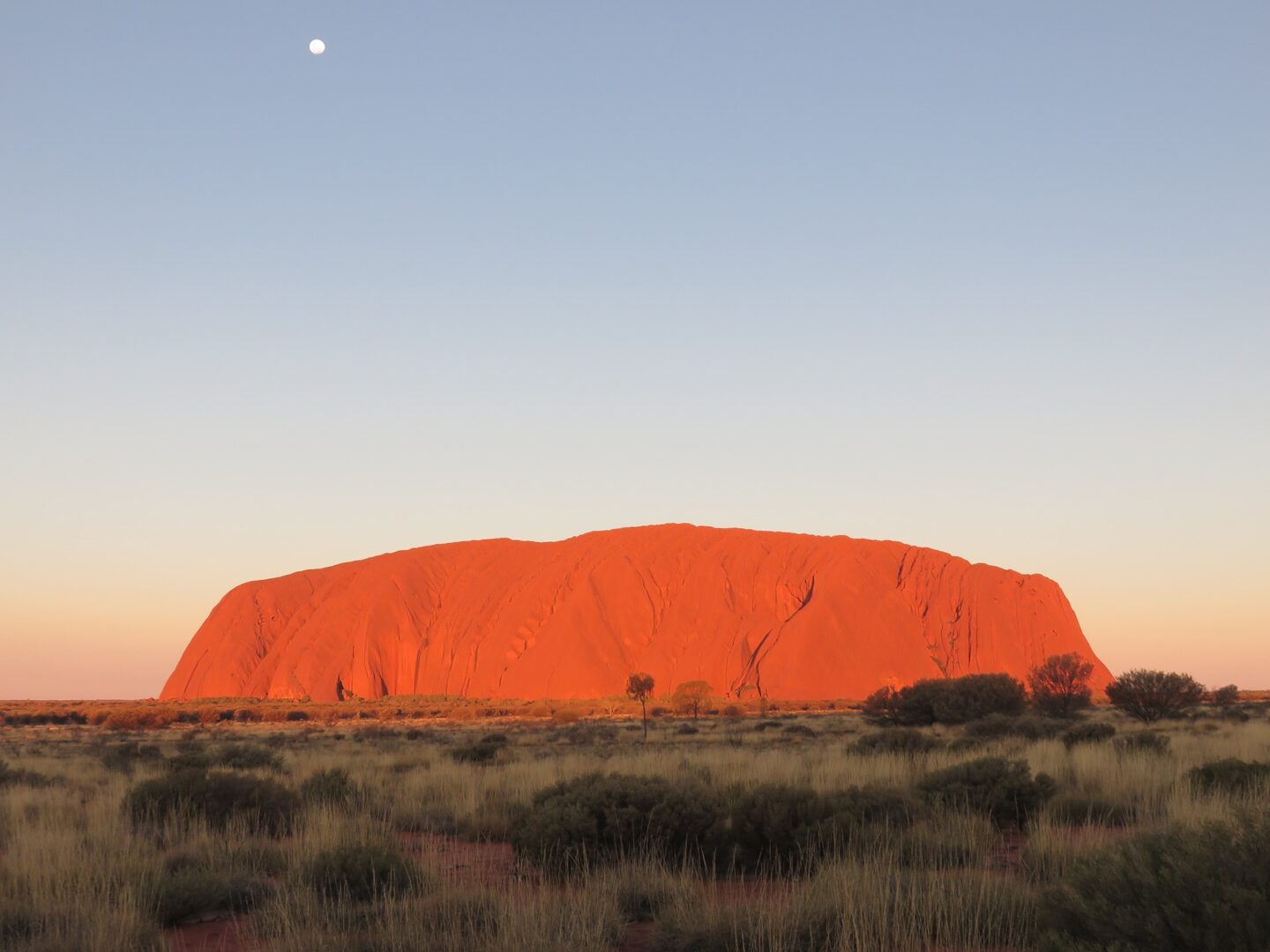
3. Amazing Stargazing
On my Red Centre tour we camped outside without any tents! Yes, we slept in something called a swag , which is a sleeping bag with a bit more protection put on the open floor outside.
I did the basic and budget option of the Red Centre tour, however this way of sleeping was amazing!
One of the reasons it was so amazing to camp in the Red Centre was because of the stars !
Still to this day, I have never seen so many stars in the sky! I was so tired but on both nights I didn’t want to close my eyes because the sky was so full of stars and I remember waking up in the middle of the night because of a noise and not even being annoyed because when I opened my eyes to see what was happening, I got to see the shining sky again!
This memory remains one of my best memories from my travels which is why it’s on my reasons to visit the Red Centre, and I really recommend staying in accommodation that allows you to stargaze, or camping outside on the floor in a designated and recommended place.
4. Visit Other Amazing Places Near Uluru
Uluru is the main draw to the Red Centre of the Northern Territory but its certainly not all there is to see, there are many more places to visit in the Red Centre.
To fly to the Red Centre you’ll fly into the capital city Alice Springs . Alice Springs is a small and quiet city and I found it fascinating because of how rural it is! I mean, it takes over 3 hours to fly from Sydney to Alice Springs, you can travel from the U.K over a dozen countries into Eastern Europe in that time!
If you decide to do an organised group Red Centre tour, Kings Canyon will definitely be on the itinerary and if you visit independently you have to go and it’s worth spending a few days in the area, especially if you like hiking, the post popular is the iconic Kings Canyon Rim Walk .
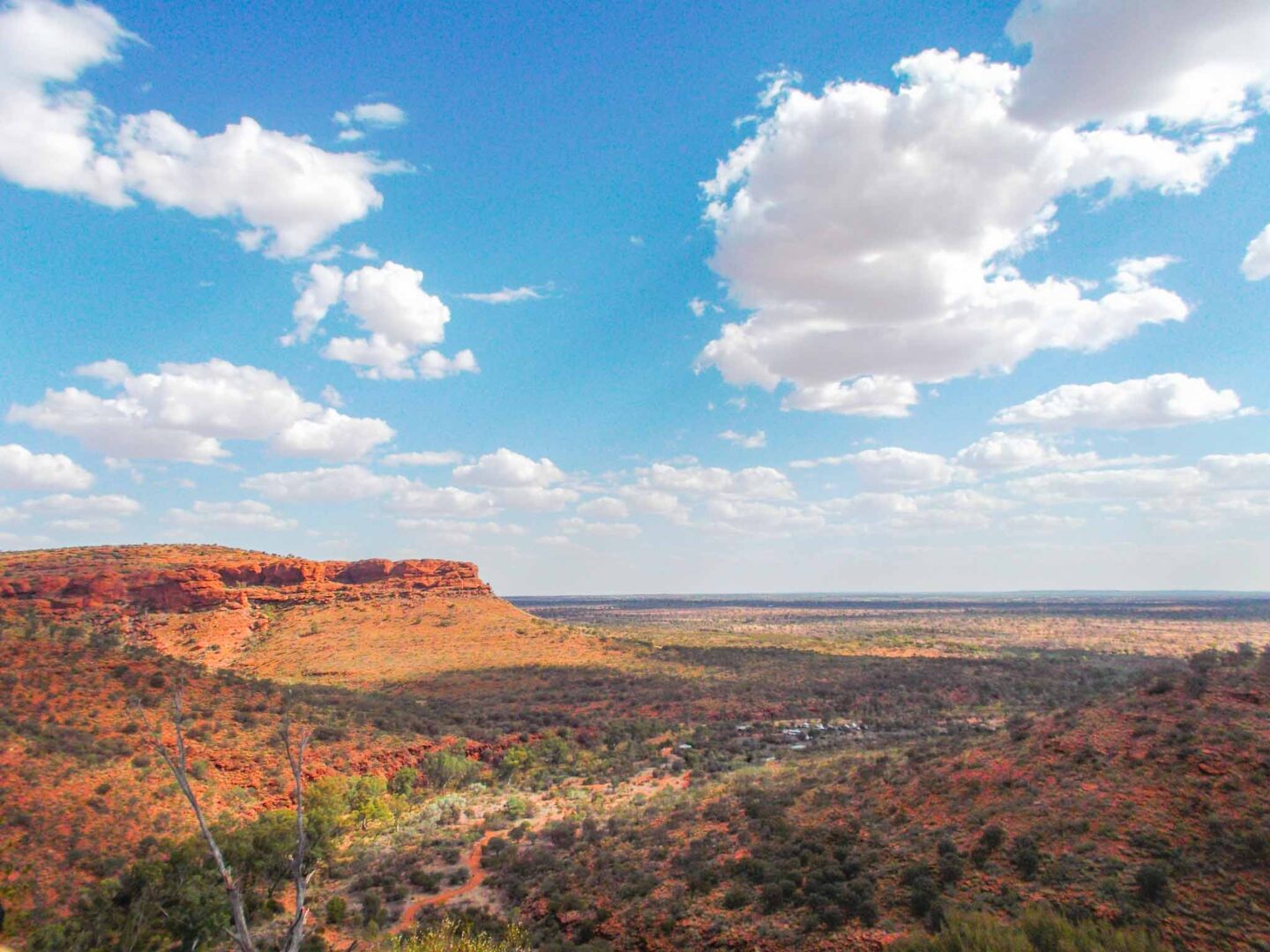
Kata Tjuta / the Olgas is another must visit place in the Red Centre and great for hiking too. Kata Tjuta means ‘many heads’ because of the shapes of the rocks. Kata Tjuta is sacred to the local Aboriginal Anangu people, just as Uluru is.
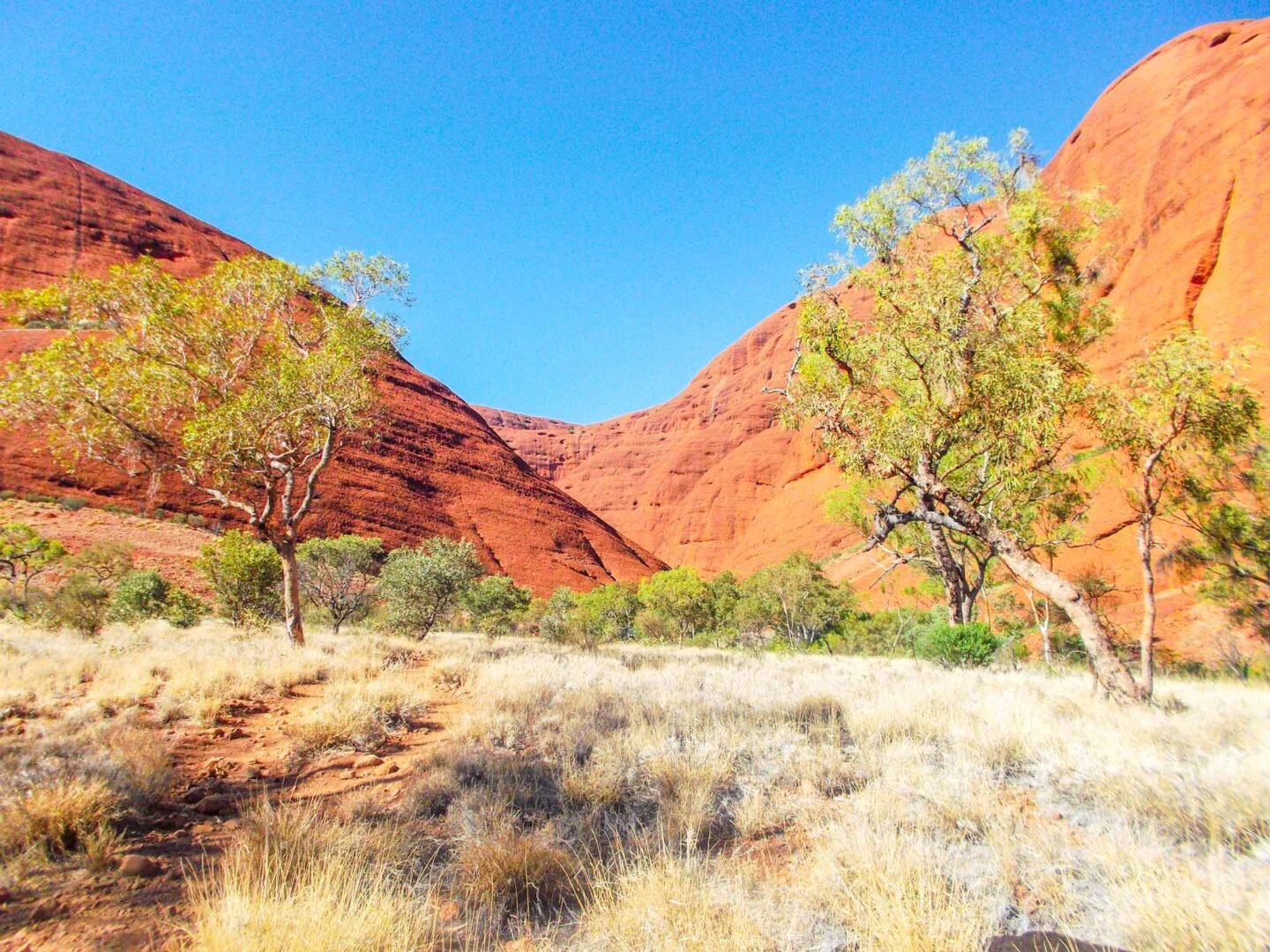
5. Education on Aboriginal Culture
The local Aboriginal Anangu people have inhabited the area for more than 22,000 years and visiting the Northern Territory gives you a lot of opportunities to hear and learn about their traditions, culture and history.
In the Red Centre specifically there are many places to visit where you can see Aboriginal art, hear stories, listen to music and try bush food.
Be sure to add Maruka Arts , Walkatjara Art Centre and the Araluen Cultural Precinct to your list of places to visit in the Red Centre where you can see Aboriginal art.
6. Many Group Tours Available
The Red Centre is vast and far away from the big cities of Sydney, Melbourne and Perth but there are many group tours around the Red Centre available for a range of budgets making it really easy to visit!
There’s options to do an overland Red Centre tour from Darwin visiting many places like Kakadu National Park and Katherine on the way down to Central Australia.
READ NEXT: 10 Things To Do In The Northern Territory On My Bucket List!
Or, you can start your tour in Alice Springs where flights fly regularly to from all the major cities in Australia.
Choose from a 3 day Red Centre tour which based on my experience gives a really good chance to see a lot of the Red Centre and learn a lot too, but if you have more time a 5 day Red Centre tour or even 7 day Red Centre tour would be amazing and worth it!
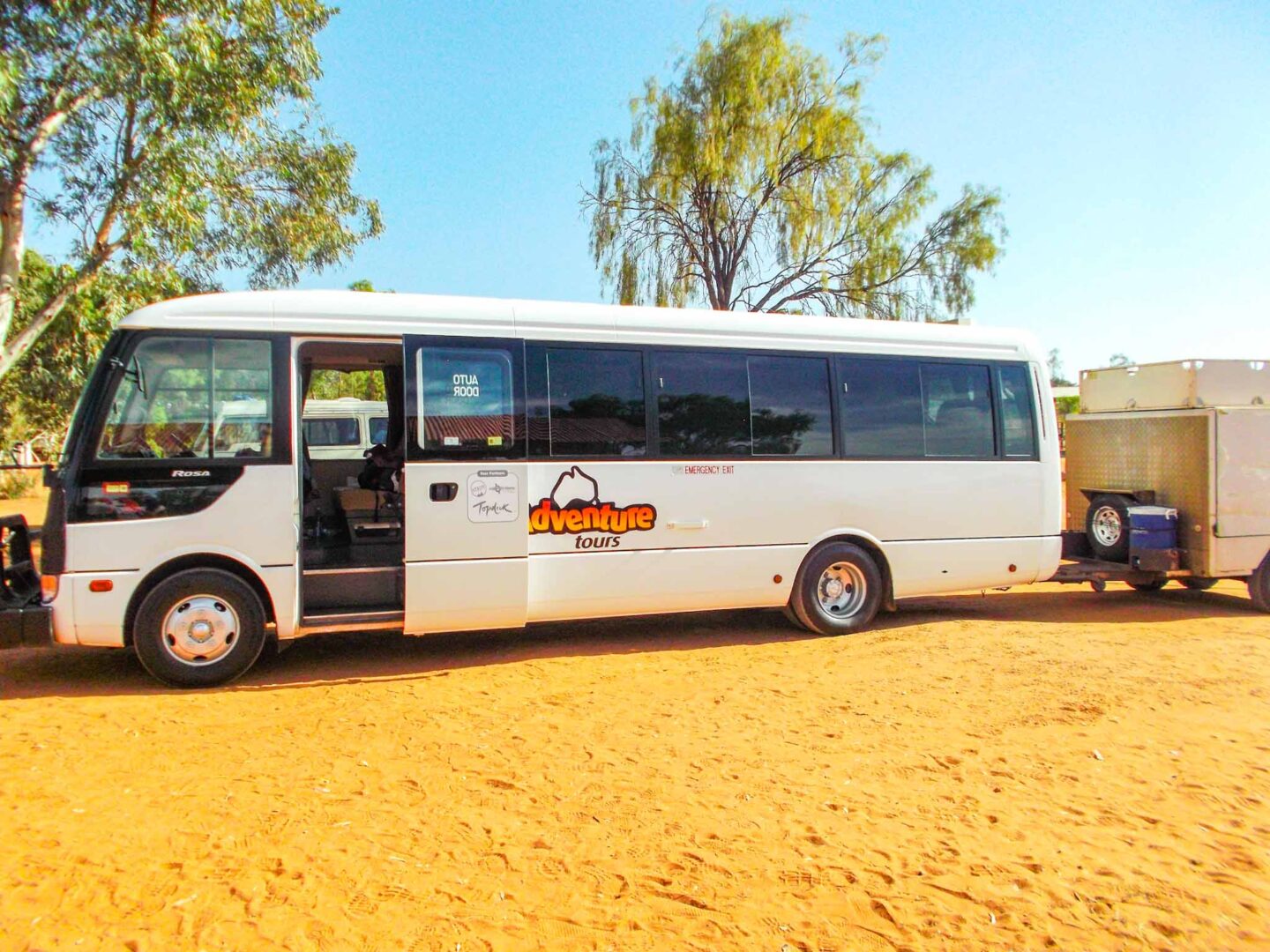
7. Great For All The Family
The Australian outback is a real road trip destination of long, open, dusty roads surrounded by nothing but nature and best of all, it’s great for all the family !
In Summer, this part of Australia gets extremely hot so it is best to plan your Red Centre family trip around the best and coolest months to visit, especially with little ones but it’s bound to provide an adventure and lots of learning opportunities!
I would love to re-visit the Red Centre with my family and road trip in a camper van for a few days!
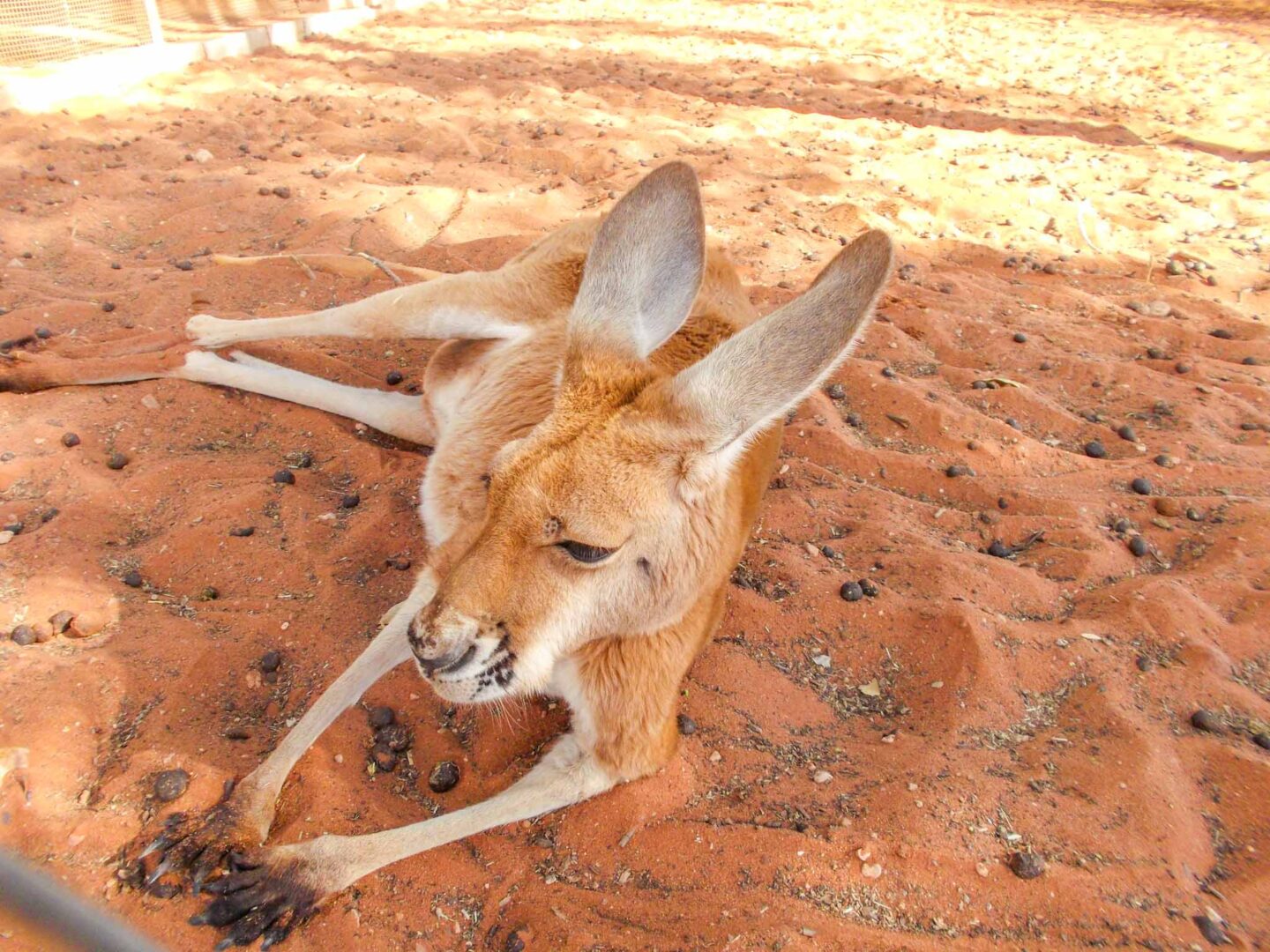
8. Once in a Lifetime Experience
It sounds cliche but it’s true, visiting Australia’s Red Centre really is a once in a lifetime experience .
It does take some effort to get to because of the 3-4 hour flight from any major city into Alice Springs, or the 30 hour journey by car from Sydney for example, so if you’re visiting Australia from oversea’s it’s likely you won’t visit on multiple occasions, but whilst you’re in Australia you must visit once!
For me, Uluru is one of the most iconic places in the world. I remember seeing photos of it when I was younger so to go as a adult and see it in real life was something I’ll always remember and treasure and the trip didn’t disappoint at all.
I hope this gives you enough reasons to visit Australia’s Red Centre in the Northern Territory!
This post is in collaboration with Tourism NT , all thoughts, opinions and personal experiences noted are my own.
Read Next: 10 Things To Do In The Northern Territory On My Bucket List!
If you liked this please share it! 🙂
- Click to share on Facebook (Opens in new window)
- Click to share on Twitter (Opens in new window)
- Click to share on Pinterest (Opens in new window)
- Click to email a link to a friend (Opens in new window)
By using this form you agree with the storage and handling of your data by this website. *
- Free eBook guide
- Before coming to Australia
- Budget for your Working Holiday
- The Working Holiday Visa
- Which city to arrive
- Packing Guide
- Backpacker Travel Insurance
- Cheap flights to Australia
- What to do on arrival
- Open an bank account
- How to transfer money
- CurrencyFair 5 free transfers
- WISE money transfers
- How to migrate to Australia
- Tourist Visa
- Working Holiday Visa
- Student Visa
- TSS Visa Sponsorship
- Partner Visa
- Travel insurance options
- Australian healthcare system
- Working Holiday Insurance
- Backpacker travel insurance
- Short term travel insurance
- International student insurance
- Travel insurance companies
- Go Walkabout promo code
- Living in Australia
- Accommodation guide
- Phone Plans in Australia
- Driving in Australia
- Cost of living in Australia
- Climate and Seasons
- Claim GST on expenses
- How to claim your tax return
- Claim your Superannuation
- New South Wales
- South Australia
- Western Australia
- Northern Territory
- POPULAR SPOTS
- NEW ZEALAND
- ASIA PACIFIC
- Travel Budget
- Climate and seasons
- Customs in Australia
- Itineraries ideas
- Road Trip Complete Guide
- Budget Road Trip
- Where to camp in Australia
- Choose and buy a vehicle
- Tips for everyday life
- News in Australia
- Festivals & events in Australia
- Just for fun
- Best stopovers from Europe
- When to buy your plane ticket
- Rent a cheap campervan in Australia
- Motorhome rental in Australia
- Car rentals in Australia
- How to rent a vehicle in Australia
- Rent a cheap campervan in NZ
- Motorhome hire in New Zealand
- Best Diving spots in Australia
- Great Barrier Tours – Best tours
- Best spots to surf in Australia
- Working in Australia
- Setting yourself up for work
- Writing a resume in Australia
- Wages in Australia
- Typical Backpacker jobs and salaries
- Certificates & training
- Getting your Tax File Number
- How to get an ABN
- How to claim your superannuation
- Housekeeping work
- Hospitality jobs
- How to find a job in hospitality
- Working in a bar
- RSA Certificate
- Coffee Barista course
- Gambling establishments (RSG / RCG)
- Work in construction
- Work as a Traffic Controller
- White Card certificate
- Become an Au Pair in Australia
- Get your Blue Card
- Fruit picking jobs
- Fruit picking map – contacts
- Fruit picking season – calendar
- How to apply for a second year
- How to calculate your 88 days
- Eligible areas for a second year
- Eligibles jobs for a second year
- Volunteering in Australia
- Work as a freelance
- Best Outback jobs
- Work in a road house
- Working in a cattle station
- Become a Hairdresser in Australia
- Find a professional job
- More job experiences
- Study in Australia
- International Student insurance
- Budget to study
- Diploma equivalency
- How to finance your studies
- Universities in Australia
- ANU: Australia’s number one uni
- Medicine studies in Australia
- Top 10 online courses
- Getting ready for your IELTS Test
- Find a student job
- Orientation Week
- Free study advice
- Internship in Australia
- $25 OFF RSA Courses
- $16 OFF White Card Courses
- $25 OFF RSG / RCG Courses
- 5% OFF Travellers Autobarn
- Cheap Campervan rental
- 10% OFF Go Walkabout
- 5 Free transfer with CurrencyFair

- Great Barrier Tours - Best tours
- News in Australia Be up to date. Here you will find all the news from Australia that are relevant for backpackers! All news at a glance!
- Festivals & events in Australia
- Wildlife Discover Australia’s wildlife! Find everything you ever wanted to know about Australia’s animals. Kangaroos, wombats, koalas, wallabies, crocodiles, Tasmanian devil, kookaburras, sharks, wales and many more… Understand Australia s animal kingdom and discover some adorable Aussie animals.
- Just for fun Funny articles about random things happening in Australia: Unusual events, illustrations, competitions and much more. Just for fun is entertaining and funny!

- Certificates & training
- Fruit picking map - contacts
- Fruit picking season - calendar

- More info Australia is a popular destination for both Working Holiday Visas and tourists, however, it is also worth considering Australia as a destination for studying. Better yet, foreign students are in great demand, with many nationalities. Many choose to study in Australia to improve their English skills, travel around Australia and to gain an international degree. Many choose to study in Australia.
- ANU: Australia's number one uni

- Discover Australia
Australia’s Red Centre: Itinerary and tips
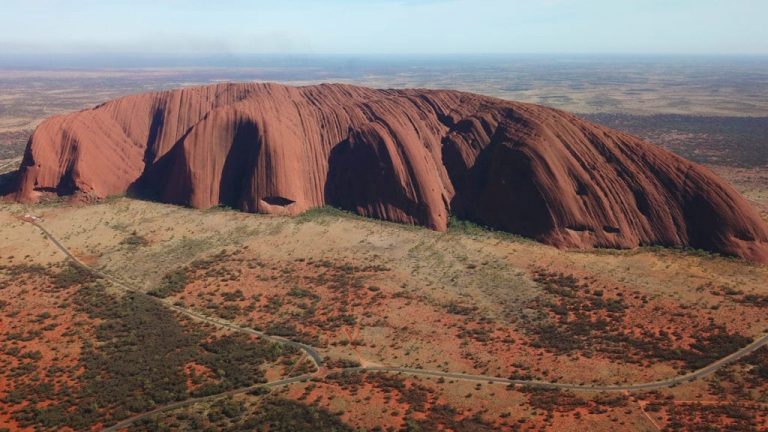
The Red Centre of Australia is a land of endless possibilities, incredible colours and unforgettable adventures. For many, it’s the perfect place to go on a road trip , where the expansive landscapes force you to slow down and enjoy the moment . Even if you don’t have much time to play with, experiencing even a small part of the remoteness and wilderness of the area is sure to thrill you.
If you want to experience the Red Centre of Australia, you have two main options. The first option is to join a tour group. This is a good choice if you don’t have your own vehicle, or you’re short on time. A second option is exploring the area by going on a road trip in a motorhome/campervan. Here we’ve put together a comprehensive guide to help you plan your trip to Australia’s Red Centre, from your itinerary to your budget, with helpful travel tips and more.
Table of Contents
How to explore the area?
If you want to explore Australia’s Red Centre, you have several options. If you have your own vehicle or wish to rent one, driving is an easy way to see all the sights. However if you’re short on time or don’t have a vehicle, it’s best to join an organised tour.
Organised tours
Australia’s Red Centre is huge, but it’s still possible to see most of the highlights in just 3-4 days with an organised tour.
Here are some of the best tours on offer:
- 3 Days tours departing from Alice Springs or Ayers Rock
- 4 Days tours departing from Ayers Rock
- A helicopter flight over the Red Centre from Yulara More information and reservations: Helicopter flight over Uluru
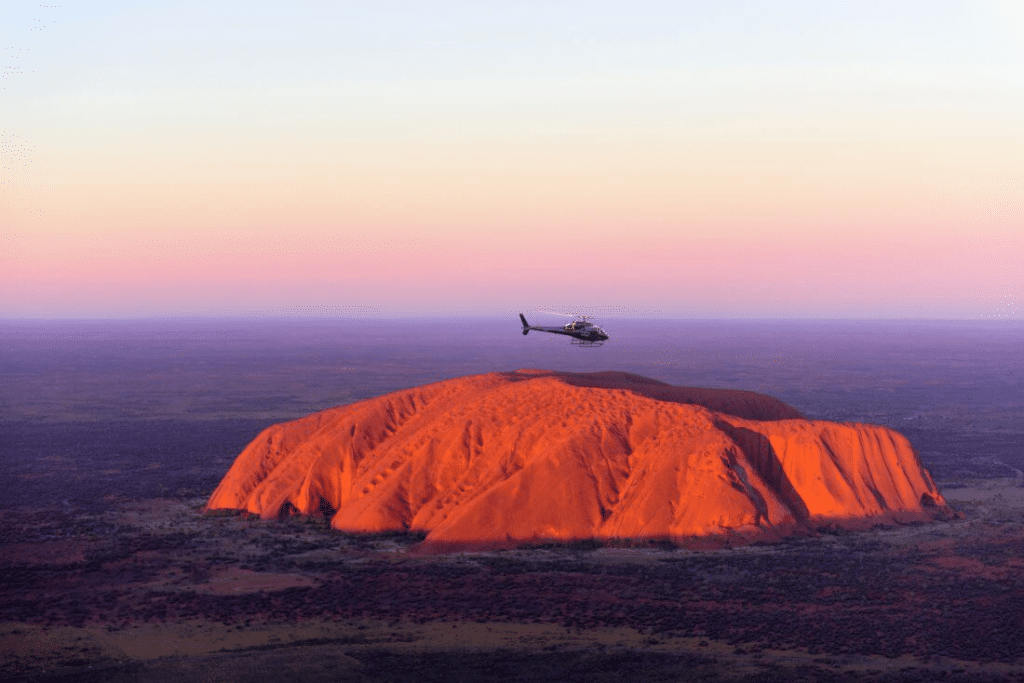
Road trip in a campervan / motorhome
Time and distances involved.
We recommend you give yourself about 10 days of travel from Alice Springs. However, it is possible to do this road trip faster – 7 days if you don’t waste any time, and 5 days if you only visit Uluru and Kata Tjuta. It’s also possible to fly directly to Ayers Rock Airport (Uluru) to save time. Bear in mind, though, that it’s not possible to rent a motorhome from here, only a car. Located in the middle of the Australian desert, visiting Uluru takes on another dimension when you realise the vastness of the region! That’s why driving to get there can actually be a valuable part of the trip.
Alice Springs – Uluru: 463km Uluru – Kings Canyon: 320km Kings Canyon – Alice Springs: 474km MacDonnell Ranges (AR Alice Springs): 260km
TOTAL over 10 days: 2000km
What type of vehicle do you need?
Contrary to what some may think, a 4WD is not necessary to explore this region. All major sites are accessible via a tarmac road. Also be warned that 4WD rental is quite expensive in Australia, so don’t spend extra money for no reason! The only advantage of having a 4WD in this region is that you can take the Mereenie Loop , which connects Alice Springs to Kings Canyon via a 322km track (vs 475km by road). If you have a 4WD you can also see more of the eastern part of the MacDonnell Ranges , the many sites of which are accessible by unpaved tracks.
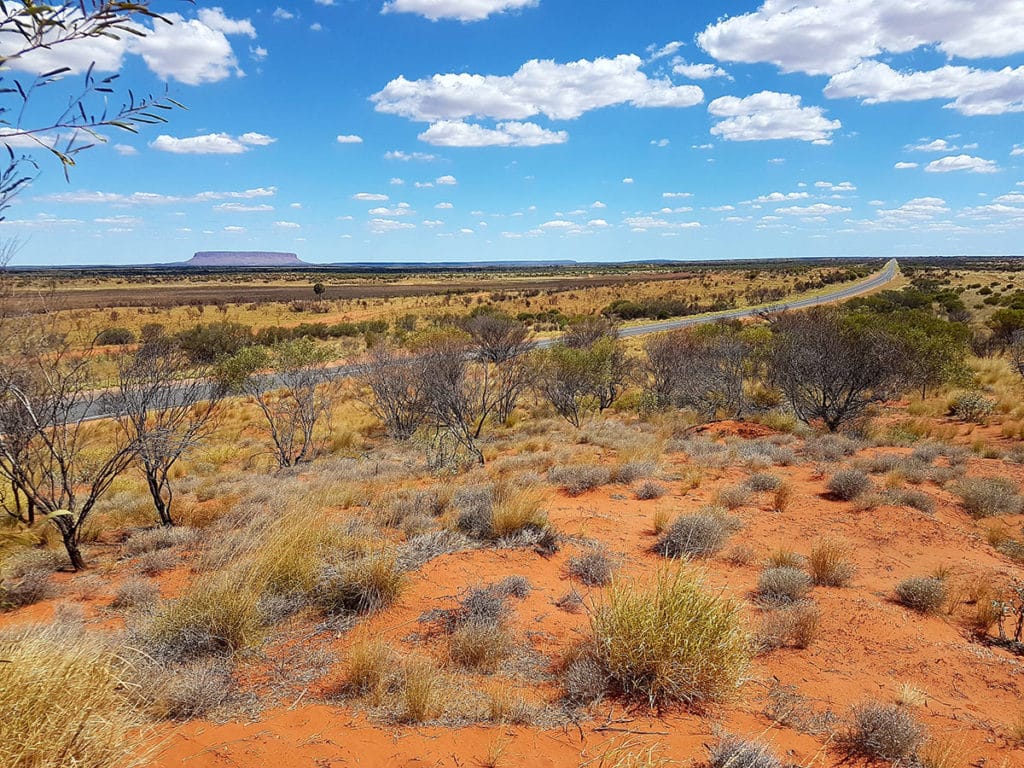
Best time to visit the Red Centre
In summer (December to February), temperatures are between 20 and 35°C. In winter (June to August), they range from 3 to 20°C.
Autumn and spring are the best seasons to visit this part of Australia. April and May are among the nicest months in Alice Springs. September and October are also pleasant months to visit the Red Centre, it is also the time of year when colourful flowers pepper the desert.
Read more: Climate zones and seasons in Australia
Recommended road trip itinerary (10 days)
Alice springs – uluru: 2 days.
When you arrive at Alice Springs Airport you will need to pick up your vehicle (budget about $40 taxi fare between the airport and the city). We advise you to stock up on food and then leave the city to sleep in a free rest area south of it. The next day will be mainly dedicated to driving to get closer to Uluru . There’s not much to do on the road. However, you will be able to stop at Road Houses (Outback gas stations), where you can refuel, pick up snacks and souvenirs and stretch your legs. We recommend you stop for the night a few kilometres from Uluru, so you can get there early the next day. You have to pay to enter the park ($38) and your ticket is valid for three days, so if you go in the morning you can make the most of it. If you want, you can also request an extension of your pass, allowing you to stay five days.
Uluru: 2 days
To explore Uluru and the area around it, we recommend staying for 2 days . The first day will allow you to take a short walk around, go to the Cultural Centre to learn a little more about the site and the Aboriginal culture and possibly end the day by watching the sun go down. On the second day, you can (for example) start with the sunrise and then continue with a long walk around the rock (it’s always better to do this type of walk early in the morning to avoid the hot weather).
You can sleep at the only campsite available in the area – Yulara , which includes a caravan park, hotels, shops, a shopping centre etc. Be aware that you can only buy alcohol in Yulara if you are a client of one of the hotels or the caravan park.
Things to do
- Sunrise: Parking is specially provided for admiring Uluru at sunrise. We recommend you go there at least 30 minutes before sunrise in order to get a good spot. This is definitely a must during your visit to the Red Centre.
- Sunset: Another car park is also provided to admire Uluru at sunset. It is recommended to go there at least 1/2 hour before sunset in order to have a good place.
- Long walk around the rock: The “Base Walk” allows you to walk 10.6km around the rock. This is an easy walk and takes 3-4 hours.
- Short walks: There are also four short walks around the rock, from 1 to 4km.
- Cultural Centre: You will find a Cultural Centre at Uluru, which contains information about Aboriginal culture, art galleries, shops etc. A cultural/nature presentation also happens every day of the week at 10am.
All available walks can be found here .
Uluru is sacred to the Aboriginal people. Previously, it was permitted to climb Uluru , but since 2019 this is no longer allowed, following a decision to respect the requests of its traditional owners.
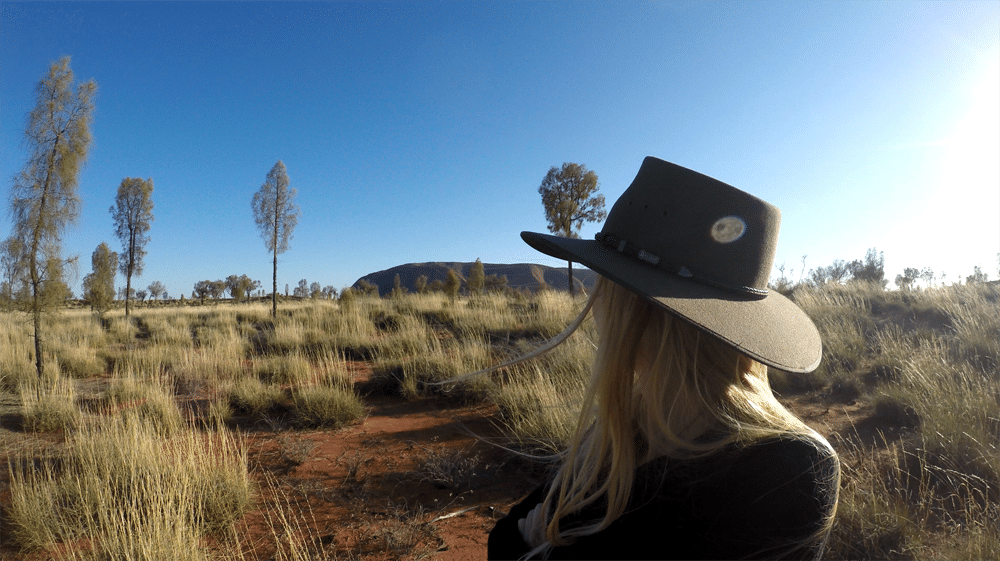
Kata Tjuta: 1 day
The Kata Tjuta or Monts Olgas are located 40 km from the campground or 25km from Uluru, so give yourself 20 to 30 minutes to get to the site. The highest of the 36 domes culminates at 1070m and dominates the surrounding plain.
- We recommend doing the long Valley of the Winds walk in the morning. Allow about 4 hours to complete the 7.4 km path. The site is stunning and very few tourists do the full walk, so you might have the place to yourself! Make sure you bring water as it is very hot in the valley. Two water points are also available during the walk.
- You can also take the short Walpa Gorge walk , which takes around 30 min.
- The sunset over the Olgas can be viewed from the parking lot.
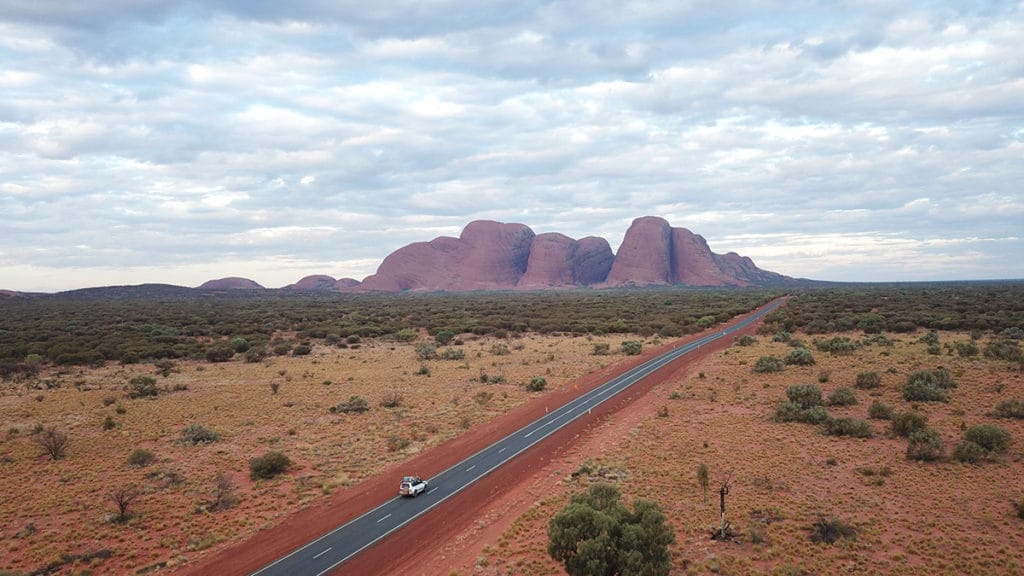
Kings Canyon: 1.5 days
Give yourself about 1.5 days for this because the drive to Kings Canyon from Uluru is over 300km. Kings Canyon is a canyon located in Warrtaka National Park . The site is accessible for free.
The short Kings Creek Walk is a 2km round trip in the heart of the canyon. This walk runs along the bed of the river and can be done in the afternoon because it is very shaded. Don’t miss the Kings Canyon Rim Walk , a 6km loop on the upper part of the canyon. Allow 3 to 4 hours for this walk. The walk begins with a difficult path that leads to the top of the canyon. In the middle of the walk, a detour leads to the Garden of Eden , a permanent water hole. Remember to bring enough water with you as no water point is available during the walk. For experienced walkers, Giles Track , a 22 km route, connects Kings Canyon to Kathleen Springs.
If you want to stay 2 days in Kings Canyon, you can sleep at the resort located a few kilometres away from the site ($25 per person for sites without electricity and $30 with electricity). The caravan park is very popular with dingoes, so be careful. The sunset can be admired from an observation platform located a few meters from the caravan park.
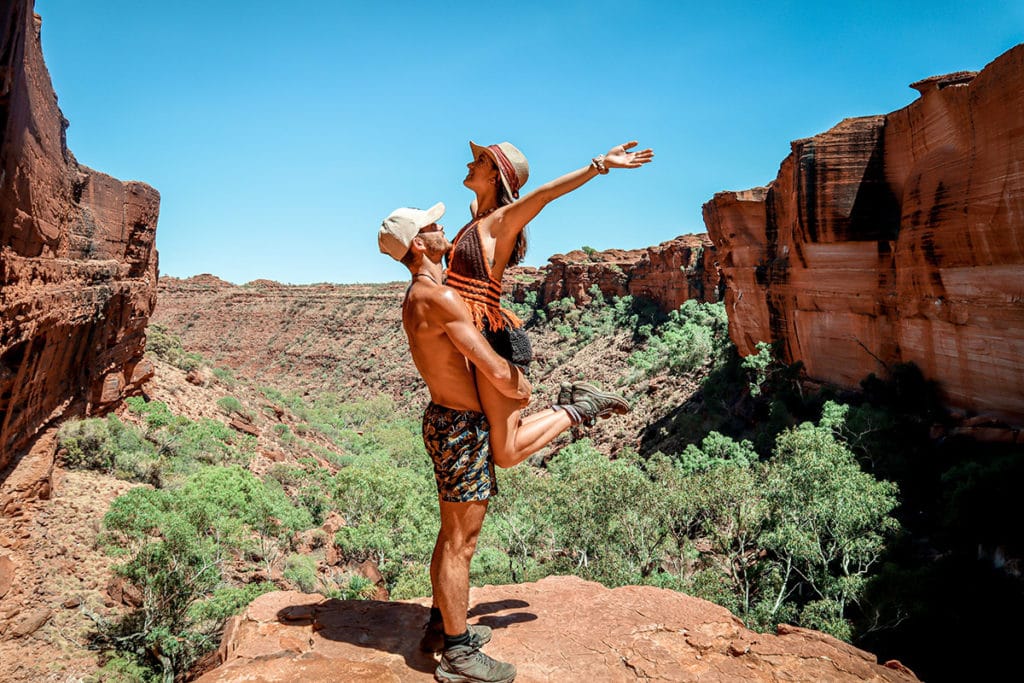
Alice Springs return: 1.5 days
From Kings Canyon, you have around 300km to cover. Depending on how much time you have, what type of vehicle you are driving etc. the journey can take a day or a little longer. If you can, you can spend some time in Alice Springs. There is not much to visit on the way apart from the few typical roadhouses.
MacDonnell Ranges: 1.5 days
The MacDonnell Mountains form a 650km long mountain range and separate Alice Springs in two. There are two parts to discover, the East part and the West part. There are more things to see in the West part.
West of the MacDonnell Ranges
This part of the ranges is accessible via a paved road (Larapinta drive). The sites are then accessible via unpaved roads but are often short distances.
The first site to visit is the Simpson Gap , where a nice walk takes you to a water hole. From this site, the departure points for two different walks (10 and 23km) are accessible.
Ellery Creek Big Hole will be a perfect spot for a swim and picnic by the water. The Dolomite Walk (3km) will take you about an hour and a half. The site is accessible via a 2km dirt road.
A 300m walk from the car park will take you to the Ochre Pits , ochre cliffs whose colours are used during sacred ceremonies.
At 8km from the main road, Ormiston Gorge is worth a detour. You can take a short walk there to reach a permanent water hole or the Gum Ghost Walk , which is a 2.5km loop. This walk leads first of all to a viewpoint (20min walk) then makes a loop on the gorge and ends up joining the water hole where you can refresh yourself. Possibility to camp on this site ($10) or to have a drink or a snack at the visitor center.
On the western part, you can also visit the sites of Serpentine Gorge or Chandley Chasm (ticketed). This part can be done in one day, however, if you plan to do long walks, you will need two days.
East of the MacDonnell Ranges
Via a paved road, you can access the sites of Emily Gap and Jessie Gap Natural Park , where you can admire rock paintings.
Trephina Gorge and N’Dhala Gorge are also worth seeing if you visit the eastern part.
We advise you to do a few sites on the way out and others on the way back because you will be taking the same route both ways.
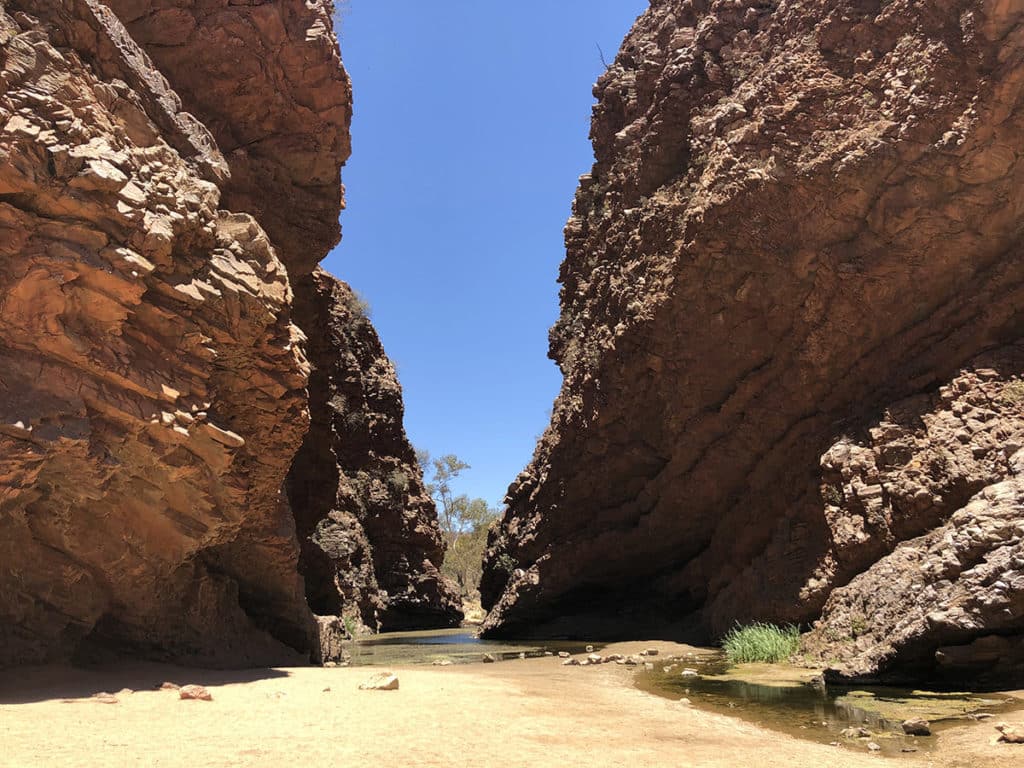
Alice Springs tour: 0.5 day
With 28,000 inhabitants, Alice Springs is a small isolated town in the middle of the desert. You can visit some museums, shops and many Aboriginal art galleries here.
- Anzac Hill is one of the must-sees in Alice Springs. This viewpoint located at the top of a hill offers a 360° view of the city and its surroundings. Panels tell the story of the city and its development.
- You can also stroll through the Olive Pink Botanic Garden or visit the Reptile Centre near Alice with a wide variety of reptiles.
- Some museums can also be visited or the Royal Flying Doctor Service , still in operation today.
One day is enough to explore the city of Alice Springs, however if you want to do all the shops and art galleries, plan a little more time.
The Camel Cup which takes place in July of each year is a must if you are around at this time.
The biggest artistic and cultural event, the Alice Desert Festival , takes place in September each year.
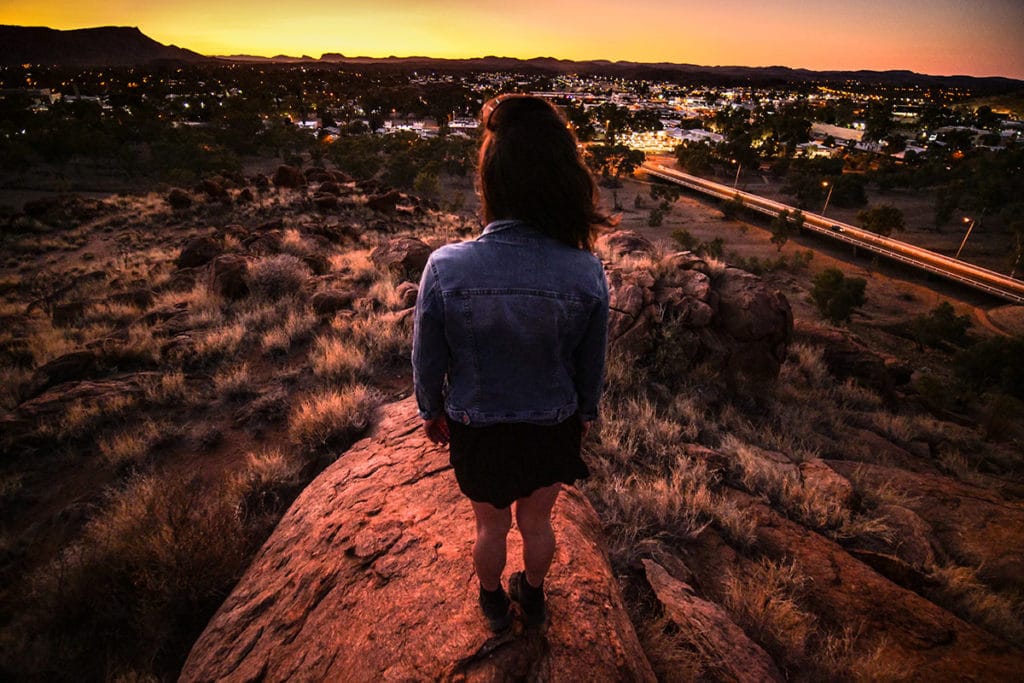
Must-sees in the Red Centre
Rainbow valley.
Rainbow Valley is a natural wonder you won’t want to miss. This great expanse of coloured sandstone rock glistens with hues of purple, orange and gold as the sun’s glow creates a dazzling spectacle. Best seen either at sunrise or sunset, Rainbow Valley is a great day trip from Alice Springs or an overnight camp spot if you want to really experience the wilderness of the Red Centre.
Alice Springs
The capital of Australia’s Red Centre region, Alice Springs is a fascinating and diverse town. If you’re used to towns and cities on the East Coast, this place is going to feel very different…
Uluru is probably the number one thing people want to see when they travel to the Red Centre. Ignore everyone who says it’s “just a big rock” and go see it for yourself. The immense power and awe-inspiring qualities of this huge monolith are hard to put into words.
Do you know that wild camels and emus roam the desert! Originally brought to Australia by Indian and Afghani traders as a means of transport, motorcars soon became the preferred way of travelling the great distances of the Red Centre and the camels were left to roam free. Now there are several camel farms in the area that cater to tourists. After all, what better way to take in the views of the arid Outback than on the back of the most iconic desert animal? There’s plenty of options to choose from if you’re looking for a camel tour in the Red Centre, but we recommend the award-winning sunset ride at Uluru . With breathtaking views guaranteed, what a way to end a day in this magical place!
Devils Marbles
Devil’s Marbles is on the drive from Alice Springs to Darwin. There’s something about the way the round boulders sit on top of each other in bizarre patterns, towering above the landscape, with little else in any direction around them! This is a great pitstop if you’re on a road trip – you get to stretch your legs by climbing over the rocks and can enjoy a picnic with a great view too. Stay until sunset to enjoy the view and the campsite close to the boulders.
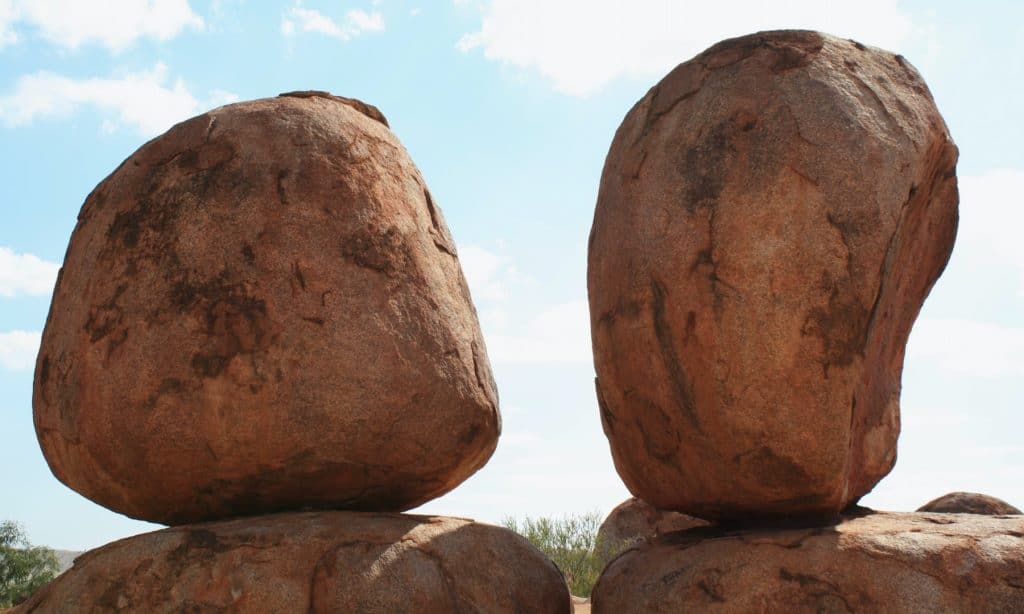
Palm Valley
Palm Valley is named after the Red Cabbage Palm, which is found nowhere else in the world apart from here. The valley is part of Finke Gorge National Park – an area of great significance for the local aboriginal people. This is the place to go to really get a sense of the remoteness of the Outback, with fantastic bush walks , 4WD tracks and camping facilities on offer. The scenery here is amazingly lush and green, due to a precious year-round water supply. The contrast with the red earth is incredibly striking – don’t forget to bring your camera!
West & East MacDonnell Ranges
Situated just west of Alice Springs, Ormiston Gorge is a fantastic spot you need to check out if you’re travelling the Red Centre. With a great walk that meanders around the gorge, stunning views for miles and a refreshing (to say the least!) waterhole to swim in at the end, this is a great spot to spend an afternoon.
The region is home to several important natural and cultural attractions, including the Emily and Jessie Gaps Nature Park , which features a unique rock formation with significant cultural significance to the local Arrernte people.
Kings Canyon
Whereas Uluru stands out from the ground at an impressive height, Kings Canyon seems to bury itself into the earth of Australia Red Centre at an impressive depth. The walls of this natural canyon fall away so sharply that even the trees seem to be holding on for dear life, and a peek over the side of this natural canyon is sure to make you dizzy! Follow the Mereenie Loop – a great unsealed road – around from Uluru to get to King’s Canyon and stay the night nearby if you can. That way you’ll be able to undertake the famous Kings Canyon Dawn Walk , which is one of the most impressive in the whole of Central Australia and well worth getting up early for.
Right next door to Uluru is the far less famous, but even more beautiful rock formation known as Kata-Tjuta . It’s actually 53km away, but this is considered a short drive in the Red Centre and they are in the same National Park! Whereas Uluru is one giant rock, Kata Tjuta is a series of smaller rocks all deposited together. Their silhouette against the otherwise flat landscape is perhaps even more stunning at sunset than that of their giant neighbour. The Valley of Winds walk, which takes you directly through Kata Tjuta, is an absolute must.
Budget for a trip to the Red Centre
Flight from Sydney: $750pp
Flying with Qantas , your return ticket from Sydney to Alice Springs will be around 740 AUD per person (for a departure in September, booking 2 months in advance)
Motorhome rental: $500pp
Budget around $3000 for a 10 day motorhome rental, including comprehensive insurance. Which makes $750 pp for 4 adults. You can event hire a 6-seater motorhome to give yourselves a bit more space (there’s not much in the price between a 4-seater and a 6-seater anyway). If you’re on a backpacker budget, you can find cheaper vehicles (around $1500 for a 2 seater campervan).
Fuel: $125 pp
Budget about $500 worth of gas (Diesel) for the whole trip. It’s possible to reduce this budget a little by filling up at the cheapest gas stations and reducing the speed/consumption of your vehicle (allow around $2.80/litre for diesel).
Food: $165 pp
It’s a good idea to do a big grocery shop before you leave Alice Springs. If you plan to eat out (there are several steak restaurants in Alice Springs), budget around $650 for four people.
Campsites: $87pp
Budget at least four nights over 10 days at a campsite/caravan park. That’s 2 nights in Uluru, 1 night in Kings Canyon and 1 night in Alice Springs. Total: $348
Extras: $100pp
Allow a small budget to buy souvenirs and other little miscellaneous things. It’s hard to resist a few purchases on such a beautiful trip! You’ll also need $38pp for the entry fee for Uluru/Kata Tjuta park (valid for 3 days).
TOTAL: $1727pp
Organised tours lasting 4 days/3 nights allow you to visit the same sites (fast-track!) and cost around $950pp all-inclusive (excluding your plane ticket). If you are traveling alone, this may be a good option.
Practical information
National park entry fee, campervan rental, road conditions, travel tips.
RELATED ARTICLES MORE FROM AUTHOR
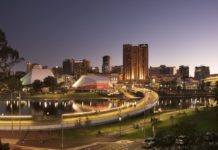
Best things to do in Adelaide: A journey through South Australia’s Capital
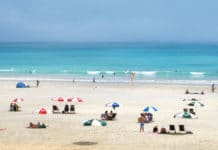
Visit Broome (WA): What to do and see

Best Caravan Itineraries in New South Wales
Leave a reply cancel reply.
Save my name, email, and website in this browser for the next time I comment.

Motorhome rental prices in Australia

The Coral Coast – Western Australia

Traveling with children in New Zealand
- Terms of Use
- GDPR – Privacy Policy


The Ultimate Red Centre Way Road Trip Guide
The Red Centre Way is an epic road trip, taking you through the best of Central Australia. There’s no better way to explore the vast Northern Territory outback than driving this route, stopping at as many of the lookouts, gorges, waterholes and landmarks as you can.
We spent almost two weeks exploring the Red Centre Way and Central Australia and had the absolute best time. This part of Australia is unlike any other. You can drive for hours and not see another car. You can have the most beautiful waterhole all to yourself. You can stand in the middle of the road and see nothing but red dirt in every direction. It’s absolutely amazing and a place every Aussie should try to visit at some point in their lives.
There are a few things to know before you start your Red Centre Way road trip though, so we’ve tried to put together all the information you might need to know before you take off on your trip. Here’s our ultimate guide to driving the Red Centre Way.
In this post:
Where to find fuel
First things first, if you’re going to drive the Red Centre Way you need to make sure that you have enough fuel, and know where the next fuel stops are so that you don’t run into trouble. There are huge remote distances between petrol stations, with limited phone reception most of the time and few cars passing by, so the last thing you want to do is run out of fuel.
The fuel stops along the Red Centre Way can be found at:
- Glen Helen Lodge
- Hermannsburg Historic Precinct (although when we visited the fuel “wasn’t working”, so I’m not sure what that means)
- Kings Canyon Resort – this is the best fuel stop along the way
- Kings Creek Station
- Curtain Springs Inn
And along the main road that connects Yulara and Alice Springs you can also find fuel at Erldunda Desert Oak Resort and Stuarts Well.
Expect high prices for petrol and diesel at all of these stops. These places are incredibly remote, so you can’t expect the prices that you would normally find in the city. The most expensive fuel we found was at King Canyon Resort which was $1.95 a litre for diesel, although depending on when you travel there are regular reports of diesel exceeding $2.20 per litre.
Where to stop along the Red Centre Way
There are so many different places to stop along the Red Centre Way, with campgrounds at many of the gorges and some great free camps to be found all along the way. Here is a bit about the route that we took and some of our favourite places to stop along the way.
Alice Springs to Neil Hargrave Lookout
Distance: 107 kilometres, 1 hour 10 minutes
The first part of our road trip was the shortest, but that’s just because there are so many places to stop along the way here. The West MacDonnell Ranges are full of some amazing landscapes, and is definitely worth taking the time to explore. This short stretch has almost half of the stops in the West Macs, so give yourself the time to check out as many as you can.
What to see along the way:
Simpsons Gap: The first stop along the way and one of the most prominent gaps in the MacDonnell Ranges. There’s a little waterhole in the middle of the gap, although swimming isn’t allowed at this spot. Plus it’s only 20 minutes from Alice Springs.
Standley Gorge: The only privately owned attraction in the West MacDonnel Ranges, it costs a small admission fee to visit Standley Gorge but it’s definitely worth it. Stand in the middle of the Chasm with the tall walls reaching high into the sky. The walls change colours throughout the day, with vibrant red and orange colours, depending on the time of day you visit. Around midday is thought to be the best time to visit, when the sun is right above the chasm lighting up both sides.
Ellery Creek Big Hole: A favourite spot to everyone along this track, visit the Ellery Creek Big Hole in the early afternoon for the best views. This is one of the permanent waterholes in the West MacDonnell Ranges, even if it is freezing cold all year round, and you are able to go swimming here if you can brave the cold. A great spot to camp for the night as well.
Serpentine Gorge: The only gorge we missed out on along the way, Serpentine Gorge is the next stop along the Red Centre Way. There is a short hike with beautiful views over the ranges and the outback, as well as a small waterhole to visit on the way.
Neil Hargrave Lookout is a great free camp, and one of the few places along the Red Centre way that have Telstra phone reception. It’s free to stay here for 24 hours and is only a short drive away from some of the best sights in the West MacDonnell Ranges. There are bins available as well as fire pits, but that’s all so you need to be self-contained if you’re going to camp here for the night.
We parked our van at the camp spot right next to the satellite dish and were able to have full reception in our van with our celfi-go boosting the signal. There were no issues making phone calls, using the internet and social media for the whole night. Without the boost we were able to get adequate reception standing right next to the dish. Perfect spot if you need some reception during your trip.
Neil Hargrave Lookout to the Mereenie Loop
Distance: 96 kilometres, 1 hour
The next part of the drive is home to our two favourite places in the West MacDonnell Ranges, Ormiston Gorge and Redbank Gorge. At the end of Larapinta Drive there is a fork in the road. You can either turn left towards Hermannsburg, which continues you on a sealed road to Palm Valley and then on towards Alice Springs, or you can turn right which leads you towards the unsealed Mereenie Loop road.
We woke up early in the morning the next day, ready to check out some more of the gorges and hidden secrets of the West MacDonnell Ranges, and when we thought it couldn’t get any better we found two of our favourites the second day.
Ochre Pits: The local Aboriginal people still use this spot to mine ochre that they use in their traditional ceremonies and decorations. Visit the pits to see the rainbow coloured walls, streaked with red, orange, yellow and white ochre.
Ormiston Gorge: One of our favourites, this is a great gorge for everyone to visit. There is a paved pathway that takes you down to the waterhole, that is surrounded by a sandy bank and is the perfect place to spend an afternoon. The water here is ice cold, but you are able to go for a swim if you dare! Take the time to walk up to the Ghost Gum Lookout for amazing views over the water hole and the whole gorge.
Glen Helen Gorge: One of the only spots in the West MacDonnell Ranges that has a fuel stop. Walk through the tall river reeds to get some great views over the gap in the ranges here. There are many dreamtime stories that originate from Glen Helen Gorge, including the one about the well-known Rainbow Serpent.
Redbank Gorge: The most difficult gorge to get to, but by far the most beautiful. This gorge is absolutely stunning, with tall rugged red cliffs towering over the small waterhole. It’s about 1.5 kilometres to get to the actual gorge and you need to clamber over a rocky pathway to get here, but the views at the end are absolutely worth it.
Originally we had planned to spend the night at Hermannsburg – also known as Ntaria to the locals, so that we could visit the Palm Valley. However, when we arrived we found that they had no fuel (or that it “wasn’t working”, we’re not really sure what was going on) and that the campground was chained up and not accepting visitors. So unfortunately we decided to keep moving. We didn’t want to take our van to Palm Valley, as the roads are meant to be pretty bad, and we needed fuel if we were going to make it all the way to Kings Canyon. So we continued on along the Mereenie Loop.
The Mereenie Loop
Distance: 154 kilometres, 1 hour 43 minutes
The Mereenie Loop is an unsealed dirt road that continues the Red Centre Way out towards Kings Canyon. It takes you along the road less travelled, through some really beautiful landscapes in the Central Australian Outback. We only passed one other car on the road out here, and loved every minute of this route. We were very excited to see a handful of wild camels along the way, just hanging out on the side of the road at around sunset, as well as a family of dingoes. Nothing better than seeing animals in the wild of the Australian Outback!
When we were still in Alice Springs a fellow traveller told us that the Mereenie Loop was the most difficult dirt road we would encounter across Australia with our caravan, so I was a little bit nervous before we started. But it was actually absolutely fine. Once we let the pressures down it was actually quite a smooth drive, the corregations weren’t that bad at all, and much of the road was actually a pretty smooth drive. There are a few dips along the way that shook things up a little bit, but overall the caravan was an absolute champ and did a great job through the outback!
If you’re planning on travelling the Mereenie Loop (especially with a caravan) our top tips are:
- Let the pressures down on your tyres before you start, makes a huge difference
- Watch out for dips in the road and drive a little slower over them as some of them can be quite deep
- Make sure you know where your next fuel stop is, as we only saw a small handful of cars along the way
We spent the night at the Morris Point Lookout (also known as Ginty’s), a free camp along the Red Centre Way. There was no reception here, with a few bins and epic views over the outback. Another spot where you need to be self-contained, as there are no toilets or anything here. The lookout is about 29 kilometres to Kings Canyon and the resort, so it was a great place to stay to save us an extra night of paid accommodation. You can stay here for up to 24 hours for free.
Kings Canyon
The epic Kings Canyon is a top highlight for anyone driving along the Red Centre Way. Found in the Watarrka National Park, the canyon was formed millions of years ago and following one of their walking trails will offer you some jaw dropping views over many different types of landscapes. From the vast depths of the canyon, to a mini tropical oasis in the middle of the walk, there is something different around every turn.
Spend the time to walk the Kings Canyon Rim Walk for the best views over the canyon. The 6 kilometre walk takes 3-4 hours to complete, starting with a steep 500 step incline that can be quite difficult, especially on a hot day. In fact, the rim walk closes at 9am on days which are forecast to be hotter than 35°C for safety reasons.
There are also a number of shorter walks you can try in the Rim Walk seems a bit much for you. We’d recommend the South Wall Return Walk , which will still give you those amazing views over the canyon, but is only 4 kilometres return and doesn’t have the harsh incline of the Rim Walk.
We spent the night in the Kings Canyon Resort campground, which is the closest accommodation to the Canyon. It’s an expensive stay but understandable given it’s such a remote location. Make sure to check out a sunset from the viewing area close to the campground, the canyon glows red at sunset and is absolutely beautiful. There is no Telstra reception at Kings Canyon, although there is apparently limited Optus reception. Avoid paying for wifi at the resort by taking advantage of the free wifi at the Kings Canyon car park, what an absolute gift that is.
Kings Canyon Resort || Luritja Road, Watarrka National Park || Ph: 1800 837 168
Kings Canyon to Yulara
Distance: 305 kilometres, 3 hours 11 minutes
The drive from Kings Canyon to Yulara is all on sealed roads and is very easy, although sometimes quite boring. There’s only a handful of stops and things to see along the way, with most of the drive just being through the vast outback. It’s a good idea to fill up in Kings Canyon before you leave.
The between Kings Canyon and Yulara you will find:
Kings Creek Station: a working cattle and camel station that also offers camping, accommodation, helicopter tours, camel rides and quad bike riding. There is also a fuel stop here at the station, as well as a small shop that offers basic supplies, meals and drinks. The station was still closed due to Covid-19 when we passed through Red Centre Way, so unfortunately we didn’t get to check them out this time.
Mt Connor: often easily mistaken as Uluru by first time visitors, Mt Connor can be seen in the distance from the highway and is a huge looming rock in the distance. It’s a very sacred site for Aboriginal men, known in the local language as Atila . There’s a rest stop lookout here to stop and take a photo on your way through.
Curtain Springs: the only roadhouse between Kings Canyon and Yulara, Curtain Springs is a great place to stop and stretch your legs. There is a small shop here, a petrol station and they also have a menu of hot food if you’re looking for something to eat. Even better, if you’re looking for somewhere to stay they offer unpowered campsites for free, with powered sites for only $3 per night.
The spiritual heart of Australia is a place that needs to be on everyone’s bucket list. It is a place that needs to be felt to be seen, needs to be experienced to be understood. There is just something so magical about Uluru and there are so many different experiences to be had there during your visit. This was our second visit to Uluru and it was just as memorable and amazing as the first. It’s a place that will keep us coming back again and again.
Here are some of our posts from Uluru to help you plan your visit:
- Where To Stay At Uluru: Ayers Rock Resort
- A Magical Night At The Field of Light
- The Best Can’t Miss Things To Do At Uluru
- Flying Over The Outback With Ayers Rock Scenic Flights
Yulara to Alice Springs
Distance: 447 kilometres, 4 hours 40 minutes
It’s an easy drive from Yulara back to Alice Springs along the Lasseter Highway and then onto the Stuart Highway. It’s a completely sealed highway road all the way and is a much faster way of getting back to Alice! There are a few different roadhouses and places to stop along the way:
- The first two are Curtain Springs and Mt Connor that we mentioned earlier, which takes you back to the Red Centre Way turn off.
- The next is Erldunda Roadhouse at the corner where you turn onto the Stuart Highway. Make sure you check out their emus out the back, they love to come right up to the fence to say hello and you can also buy some food at the roadhouse if you’d like to feed them.
- And finally there’s Stuarts Well Roadhouse which is right next to a camel farm. If you haven’t seen any camels on your trip around the Red Centre Way, here’s a great place to stop and see one.
YOU’VE DONE IT!
That completes the epic Red Centre Way road trip!! After all that adventuring there is a much faster way to get back to Alice Springs, along the Lasseter Highway and then onto the Stuart Highway. It’s an amazing road trip and is definitely worth taking the time to explore all the different spots along the way.
Explore more our adventures around the Northern Territory
Pin for later >>
Happy travels, if you enjoyed this post, we'd love you to share it for us follow us on instagram @exploreshaw to see our latest adventures around australia. check out our travel favourites: click here to subscribe to our newsletter, for blog posts and updates emailed straight to your inbox use this link for $25 aud off your next hotel stay with booking.com, or this link for $55 aud off your first booking with airbnb..
Emma is a travel writer, photographer and blogger, chasing the sun around Australia. Travelling in her recently renovated vintage Viscount caravan, along with her husband Thom and daughter Macey, she's sharing the very best experiences from around her beloved sunburnt country.
Related posts

Top 15 Things To Do In Darwin

A Day Trip to the Tiwi Islands with SeaLink NT

A Sleepover at the Top End Safari Camp
No comments, leave a reply cancel reply.
We're travelling around Australia, exploring all the best destinations and experiences our beautiful country has to offer. We'd love to have you along for the ride!

for all the best bits on the site

destinations

follow on insta
@exploreshaw.
- Work With Us
- Privacy Policy
- Travel Resources
for updates to your inbox
current location melbourne
© 2023 EXPLORE SHAW
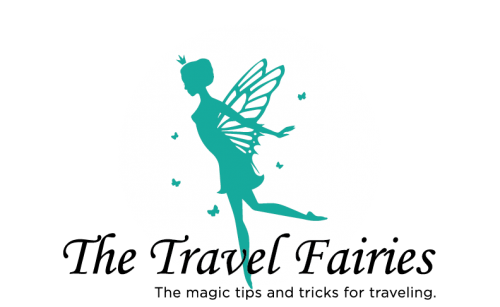
The Travel Fairies
The magic tips and tricks for traveling
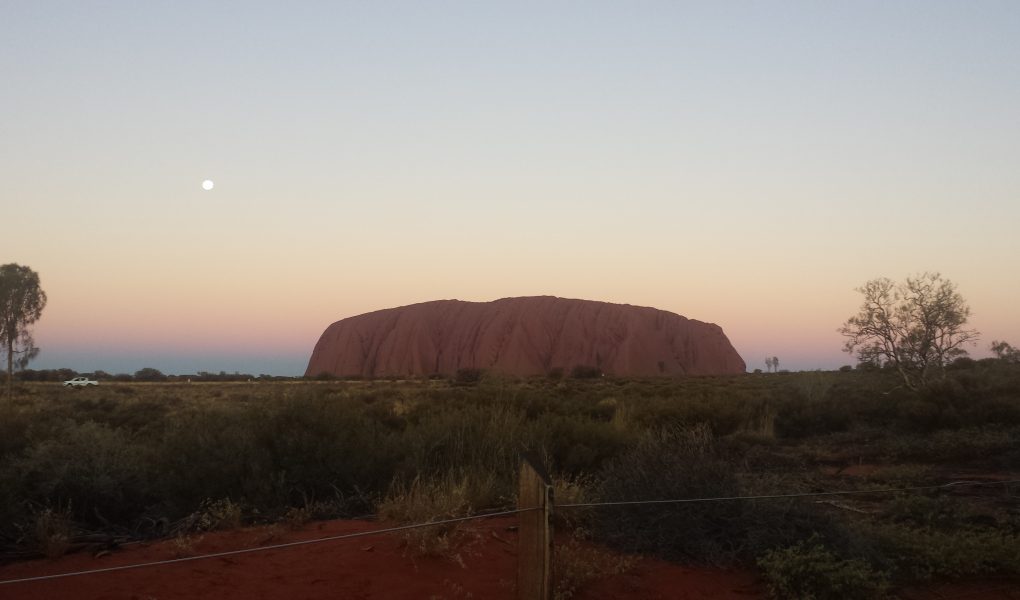
Australia’s Red Centre with Adventure Tours 5 Day Itinerary
When I was visiting Sydney on my study abroad trip , I knew that I needed to see as much of the country as I could. I mean I’d come all that way so might as well! I decided to try and see some of the most famous sights in all of Australia, the great ocean road, Sydney opera house, the great barrier reef. And of course the most well-known place of all Uluru (also known as Ayers Rock) in Australia’s red centre.
*Disclosure* This post may contain affiliate links. This means when you buy through the link, the Travel Fairies will receive a small commission at no extra cost to yourself.
I was traveling on my own and didn’t fancy my chances driving solo through the Outback so instead, I opted for joining a guided tour. I had seen a leaflet for The Rock Tour which offered trips from Ayers Rock Airport to Alice Springs (Or vice versa), a round trip from Alice Springs or a round trip from Ayers Rock Airport. I compared the flights using Skyscanner and found flights to Ayers Rock Airport were a lot cheaper so I booked the rock to rock tour. Unfortunately, it turned out The Rock Tour wasn’t running any of those on the dates I booked so instead they passed me over to Adventure Tours . And with all that sorted, I was off for 5 days in the Australian outback!
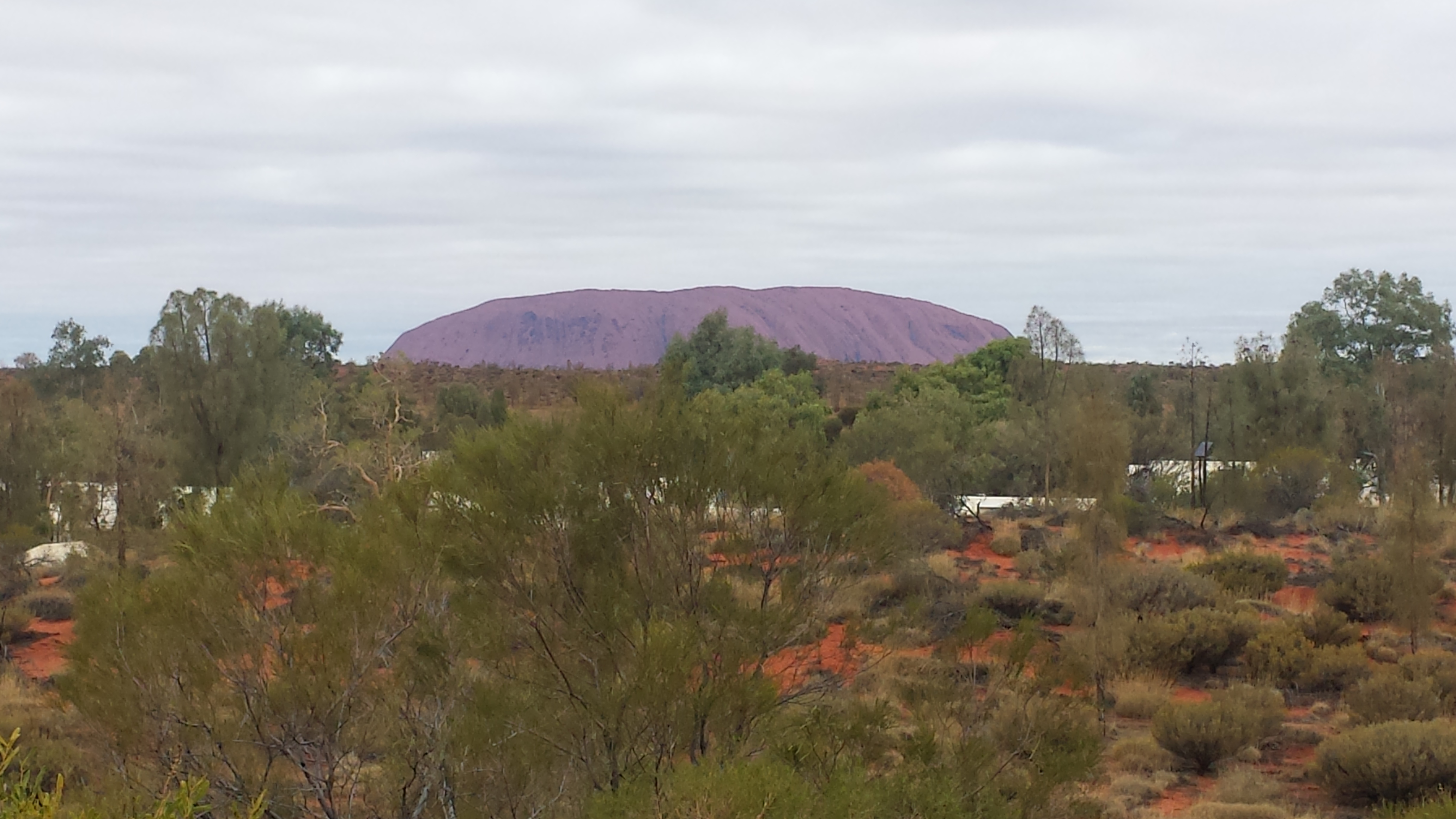
Travel from Sydney to Ayers Rock Airport. Get to Ayers Rock Resort and explore. Stay in the Outback Pioneer Lodge.
Take part in some of the cultural activities and get picked up from Ayers Rock Resort. Visit Kata Tjuta and do the Valley of the Winds walk. Watch the sunset over Uluru with refreshments. Sleep under the stars in a swag at the nearby campsite.
Watch the sunrise during the Uluru base walk before having a guided nature walk with a local Aboriginal. Visit the Uluru Cultural Center to view some arts and crafts. Drive to kings canyon and watch the sunset from the local bar. Sleep under the stars in a swag at the nearby campsite.
Hike Kings Canyon at sunrise. Drive to Alice Springs including a few small stops. Sleep at a local hostel.
Drive from Alice Springs to Ayers Rock Airport making a few stops on the way including at a camel farm. Take the flight from Ayers Rock Airport back to Sydney.
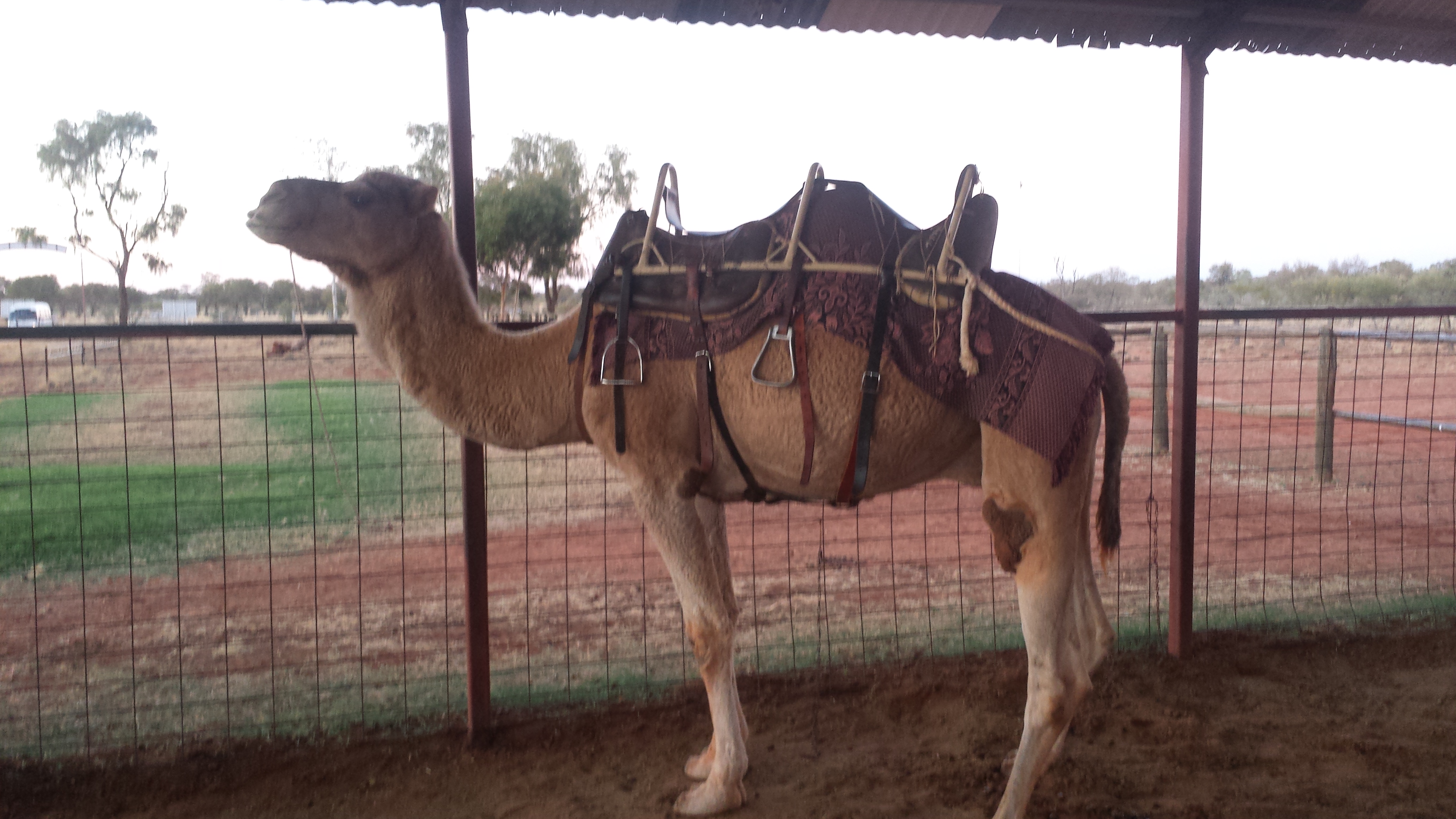
Day 1 – Journey to the centre of the Earth.
My trip to Australia’s red centre started before the sun had even risen in Sydney when I woke up and headed to the train station. Unfortunately, there was a problem with the train line so I had to catch a replacement bus instead. I had some trouble finding the stop for it but luckily I had got there in plenty of time so I managed to make it to the airport without a hitch. I got on my plane and was off!
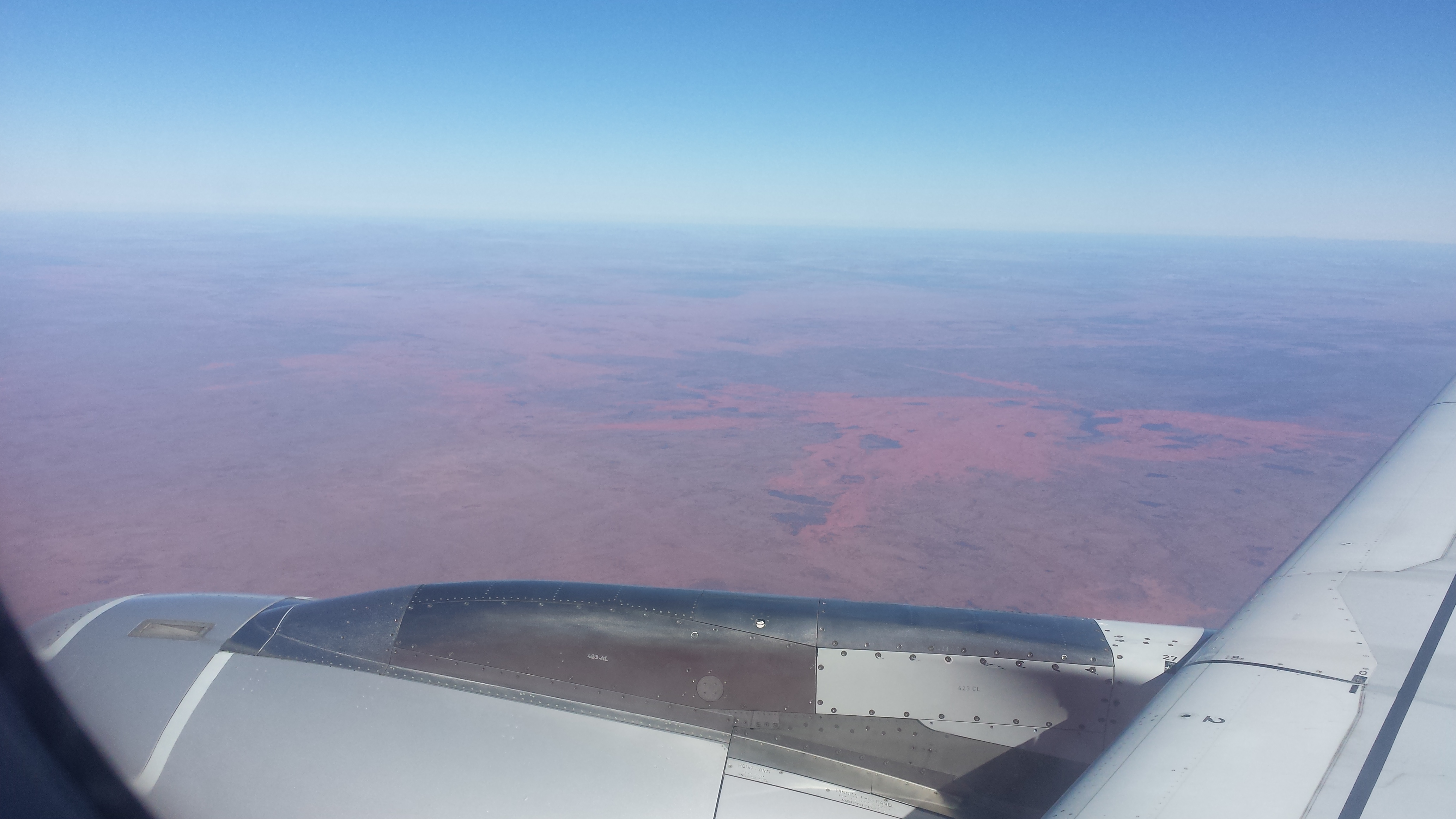
As the plane landed, the first thing that I noticed was how red the ground actually was. I mean they don’t call it Australia’s red centre for nothing! I had seen pictures of the place before but I always thought they must have been edited to get such vibrant colours. They are really not and nothing could have prepared me for it. It was absolutely incredible and I had never seen anywhere quite like it. And that’s before I even got to see any of the landmarks!
As I took the free shuttle bus to the resort, I got my first glimpses (and some super blurry photos) of Kata Tjuta and Uluru. Since there were no flights that could get me there for the pickup time, I had a day to explore before my tour started. I had decided to stay at the Ayers Rock Resort as that was the pickup location for Adventure Tours so it was the simplest option although there is other accommodation nearby. I booked the cheapest bed that I could which was in a 20 person female dorm room in the Outback Pioneer Lodge which is affiliated with YHA hostels .
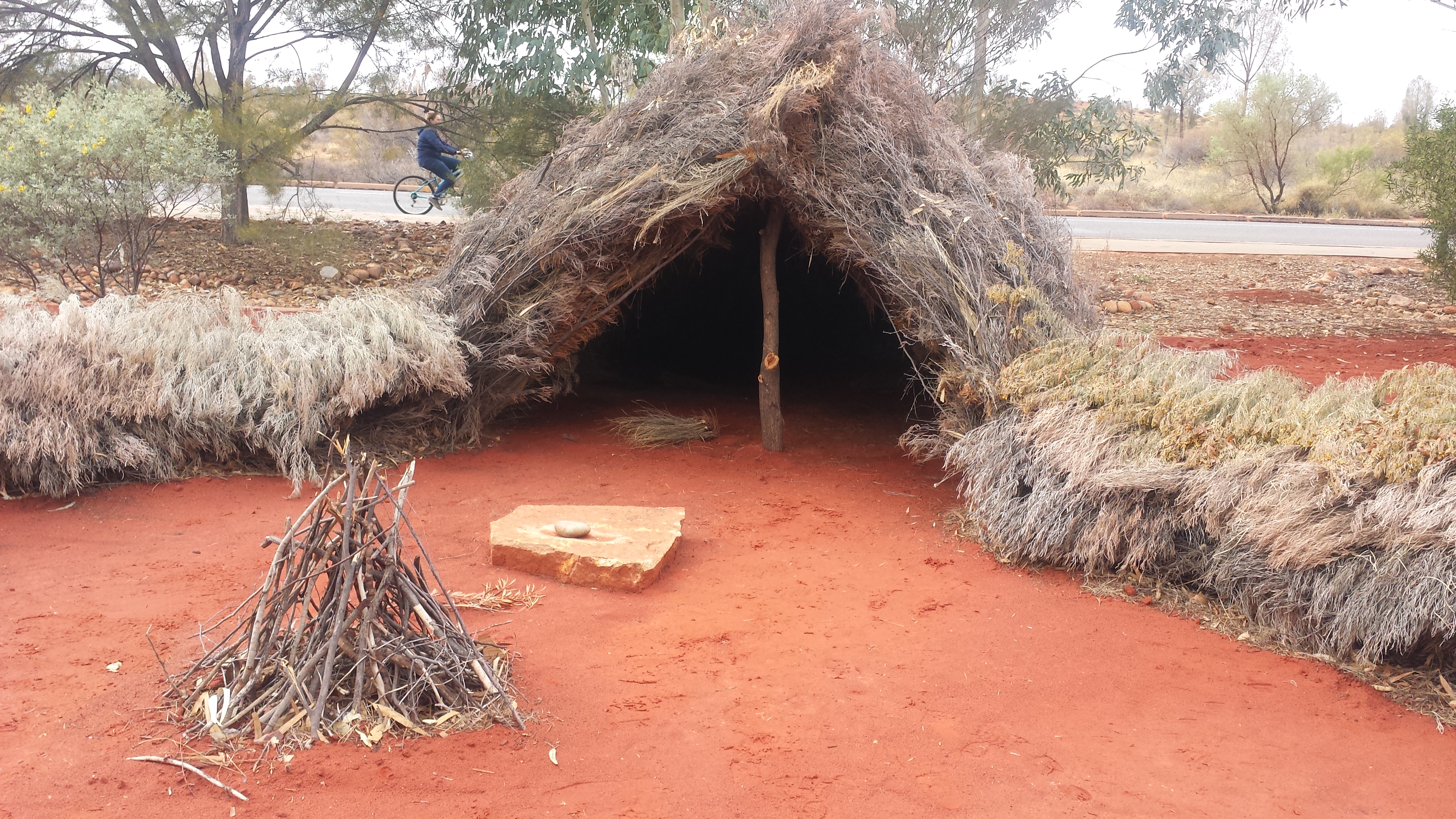
I checked in and headed to the nearest lookout point then went to explore the resort. The Outback Pioneer Lodge is a 2-star hostel but when you stay there you also get access to everywhere in the resort including swimming pools, gardens, shops and a museum. Ayers Rock Resort also host several free cultural activities that you can take part in like spear and boomerang throwing, traditional dance shows and bushcraft lessons. I attended a few of these, picked up some supplies from the shop and had dinner at the restaurant before returning to my bunk and turning in for the night.
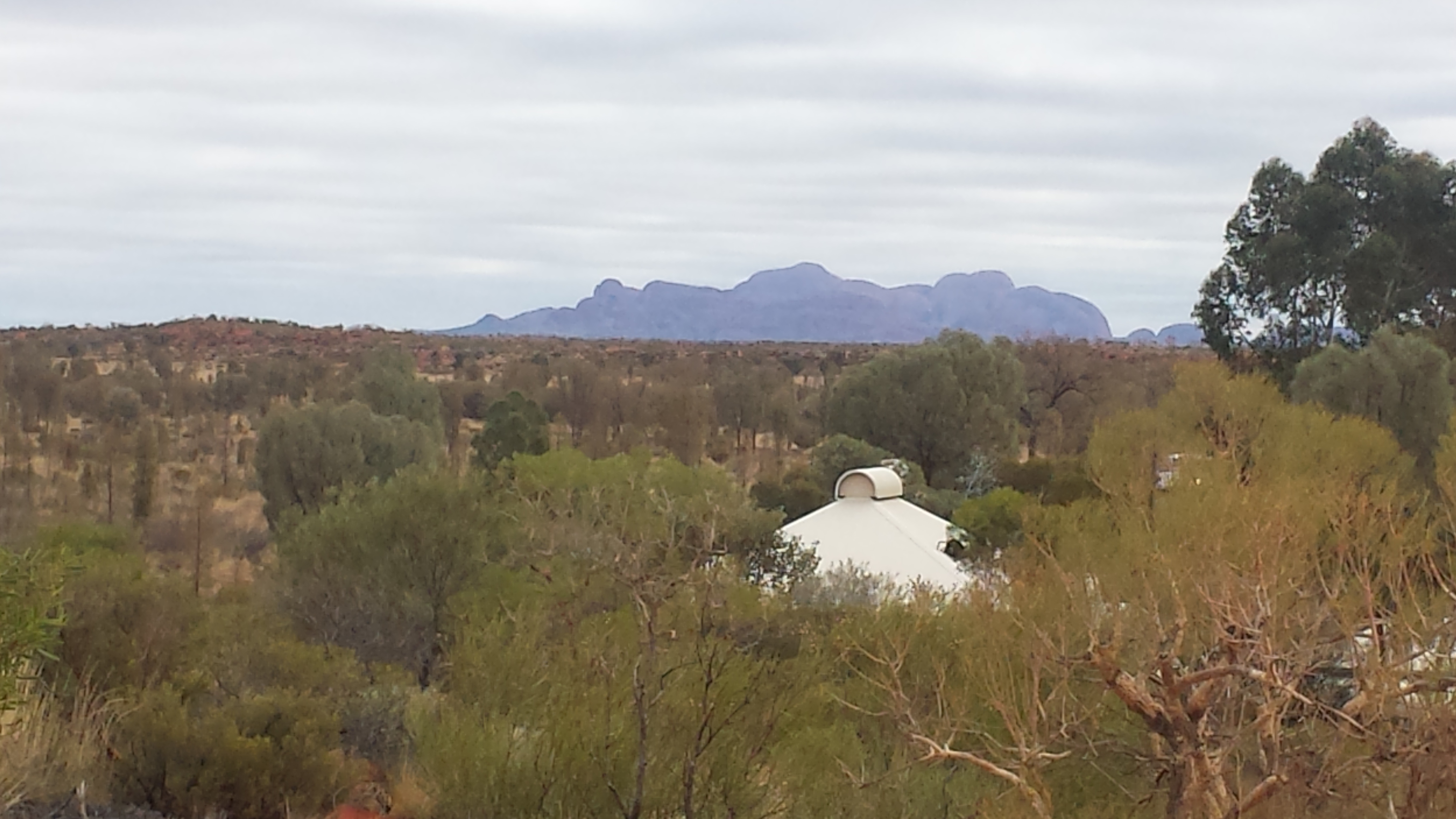
Day 2 – Kata Tjuta (The Olgas)
I woke up bright and early and began the day with a guided walk around one of the hotel gardens. Top tip for setting an early alarm in a hostel: put your phone on vibrate and put it under your pillow. It will wake you up without waking the whole dorm and that’s definitely not the way to make friends in hostels! I did a few bits and bobs around the resort then made my way to the meeting spot. There were a few people waiting already but it turned out none of them were on the same tour as me. It turns out a lot of tours pick up from Ayers Rock Resort!
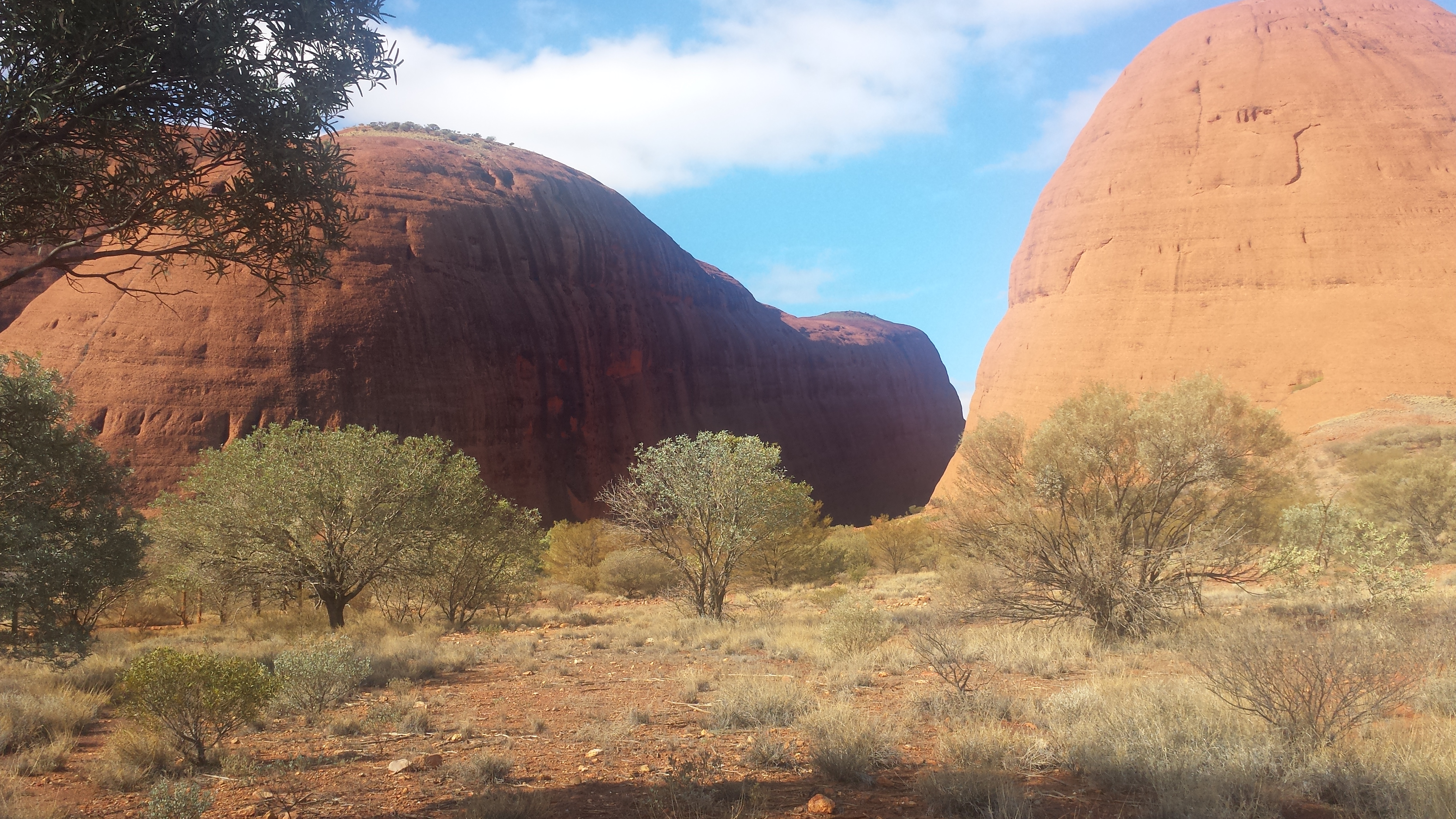
The tour guide, Leah picked me up and as I was the last one to arrive we set off for our first stop at Kata Tjuta. To get into Uluru-Kata Tjuta National park you need a permit but if you go with a group tour they will have already sorted this. Kata Tjuta is a group of 36 domes with several walks of varying difficulties. We went on the Valley of the Winds trail which leads through the monoliths to some of the most spectacular viewing points and takes about 3 hours in total.
After this hike, we headed to one the viewing points for Uluru. There, we had refreshments of a glass of bubbles and cheese platter and watched the sunset. I didn’t realise this when I had booked my trip but it was actually a full moon while I was there. As we watched the sunset, the full moon could be seen right next to Uluru which meant we got some great photographs. It was an absolutely incredible experience watching the colours of the rock change and one that I will never forget. The group got some individual pictures and group shots then we headed to the campsite we would be staying in.
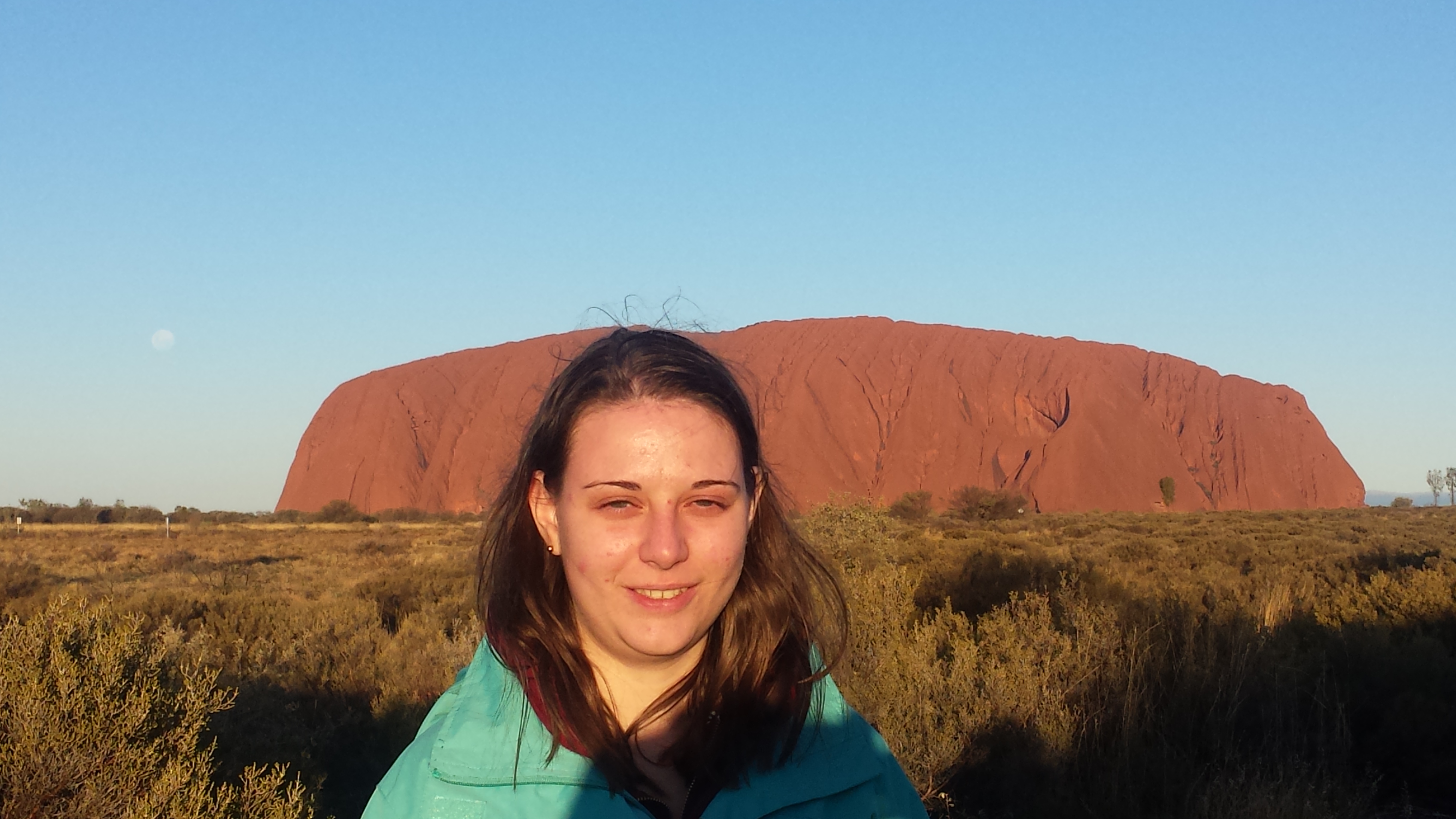
Dinner was included in the tour so we had a bit of food back at camp and got to know each other a bit better over dinner. Most of our tour group consisted of people that were currently living in Australia which according to our guide is actually pretty rare. After talking for a while, we lit a bonfire and turned in for the night. There was an option when booking to stay in tents but I chose instead to sleep under the stars in a swag. These are like thick, waterproof sleeping bags although an actual sleeping bag is still required underneath. In the summer it can be a little dangerous to sleep in the open due to all the creatures that want to kill you in Australia! But in the winter it is too cold for snakes and the fire keeps the spiders away making it the perfect time for an outback camping trip.
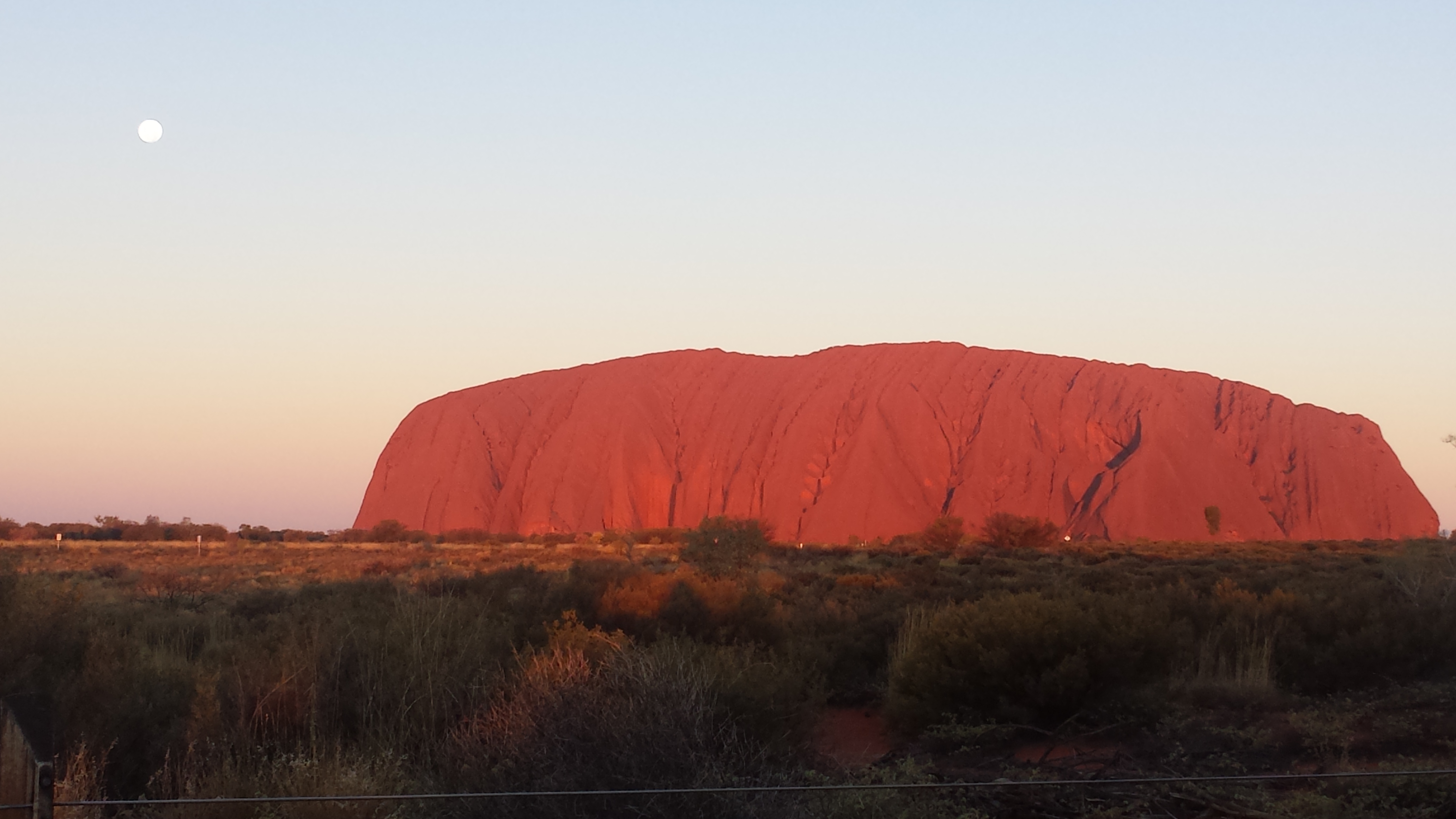
Day 3 – Uluru (Ayers Rock)
The next morning we got up bright and early so we could make it to Uluru before the sun rose. It is recommended that you bring a torch with you for this very reason as you need to be getting ready in the dark to make it anywhere by sunrise. We were dropped off by our guide to begin our base walk as the sun was rising. We had a good group so we all stuck together throughout the walk and helped to support and encourage each other when it got a little tough. I think we were pretty lucky in this sense as I can imagine with no guide many people would just head off on their own.
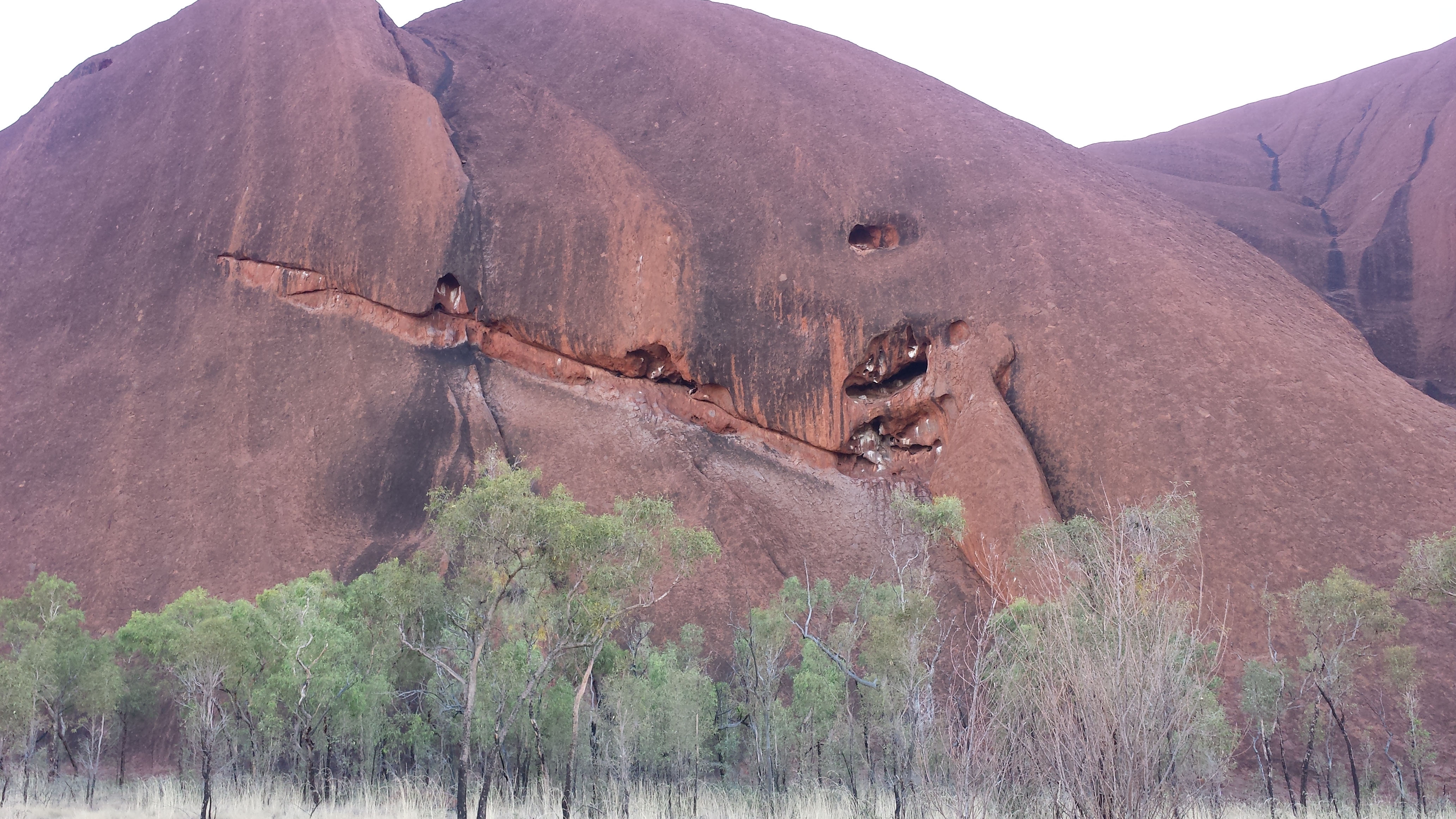
From afar, Uluru looks like just a large, blank rock but as you are walking around it you see how diverse it actually is. The route takes you past rivers and caves and through forest groves and sandy areas. Even the rock itself is dotted with unique crevices, fissures and cracks. Around Uluru, there are several areas where you shouldn’t take photos as a mark of respect for the Traditional Owners of the land which are clearly marked with signs showing the start and end of no picture zones. Likewise, you shouldn’t climb the rock as it is incredibly offensive for the local people. From October 2019, climbing Uluru will actually be banned completely. We ended our base walk at the start of the summit climb and we saw several people starting the hike despite it being closed that day due to high winds making it incredibly dangerous.
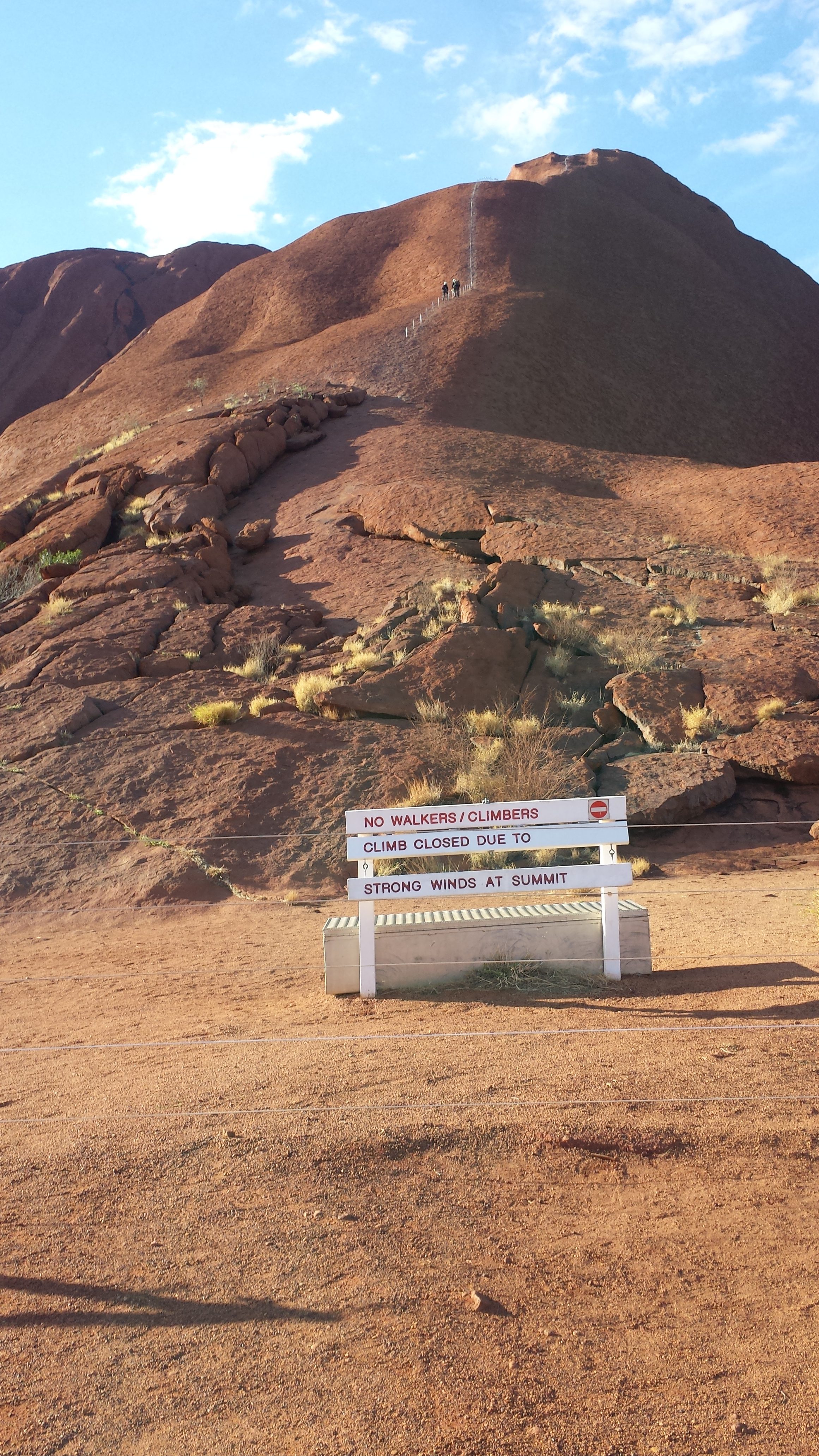
Leah met us at this point with a local Aboriginal tour guide. He led us to a nearby cave where there were paintings across the walls. He went over what the painting meant, a little bit of the history of his people and told us a few Dreamtime stories. The talk lasted roughly 45 minutes and it was incredibly interesting and informative. That afternoon, we also headed to the Uluru Cultural Center which is a kind of art gallery and store.
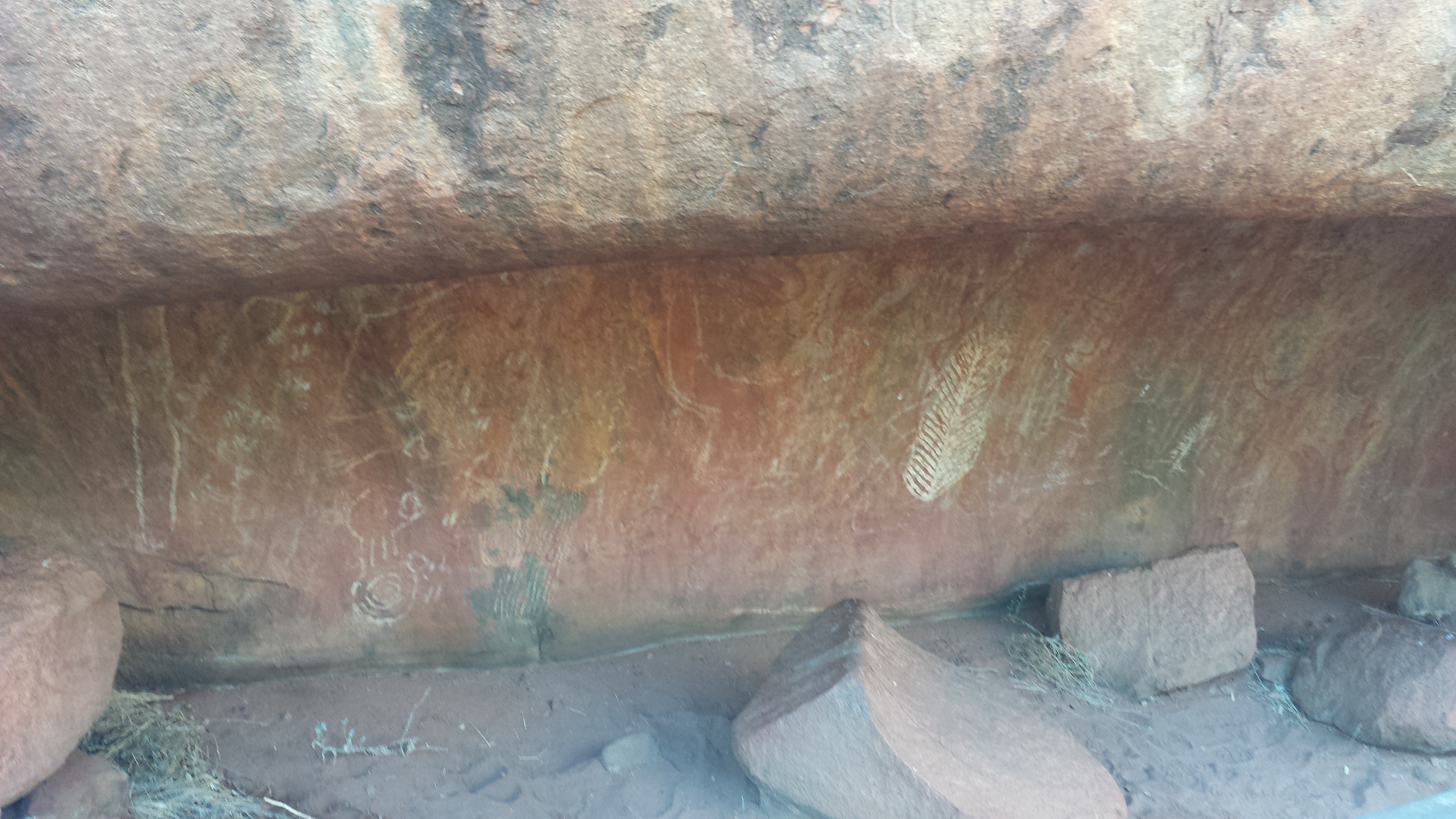
After visiting the Cultural Center, we started the long drive to the Watarrka National park stopping at a few interesting places on the way. Leah was a great guide at this point and pointed out the best places on the journey to stop. We visited sand dunes, viewpoints of the local area, a small farm and an art shop and cafe which were looking after a baby kangaroo! We made it to the campsite that was close to Kings Canyon for dinner time. After eating, we headed to a nearby pub which had a great sunset spot. There was a bit of free time before the sun started to set so some people got drinks and a few of us went for a little walk around the area. That was where I saw my first ever wild dingoes! We headed back in time to see a huge moon beginning to rise and watch the sunset with the rest of the group. That night again we slept under the stars but this time whilst being serenaded by the dingoes howling at the full moon! As I stared up into the sky, I only wished I didn’t have to wear glasses so I could actually see it!
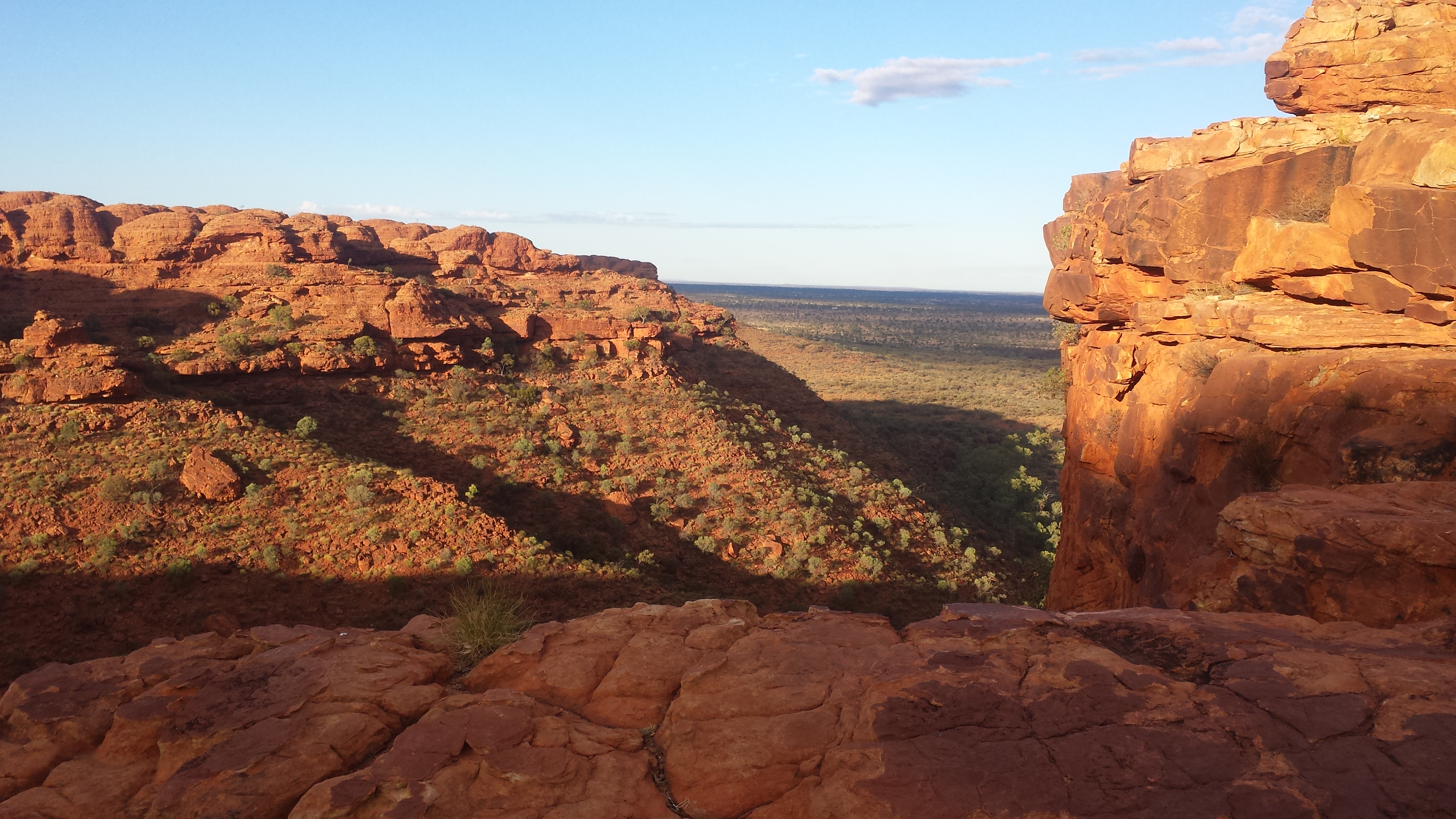
Day 4 – King’s Canyon in Watarrka National Park
Another early start on day 4 to get us to King’s Canyon before sunrise. Even in the winter, King’s Canyon can get pretty hot and there isn’t a lot of shade so it is recommended that you start early to avoid being out in the midday sun. I was told previous to booking, that we needed to take at least 3 litres of water with us to stay hydrated but when we got there Leah made sure we had at least 2 litres each. She stayed with us throughout this hike and we could not have asked for a better guide. Leah had so much knowledge of local flora and fauna and talked throughout the hike about the area. King’s Canyon was probably my favourite part of the whole trip as every turn we took, found something new and interesting. Australia used to have a huge inland sea where the outback currently is and fossilised fish, shells and waves can be found in the rocks that make up King’s Canyon.
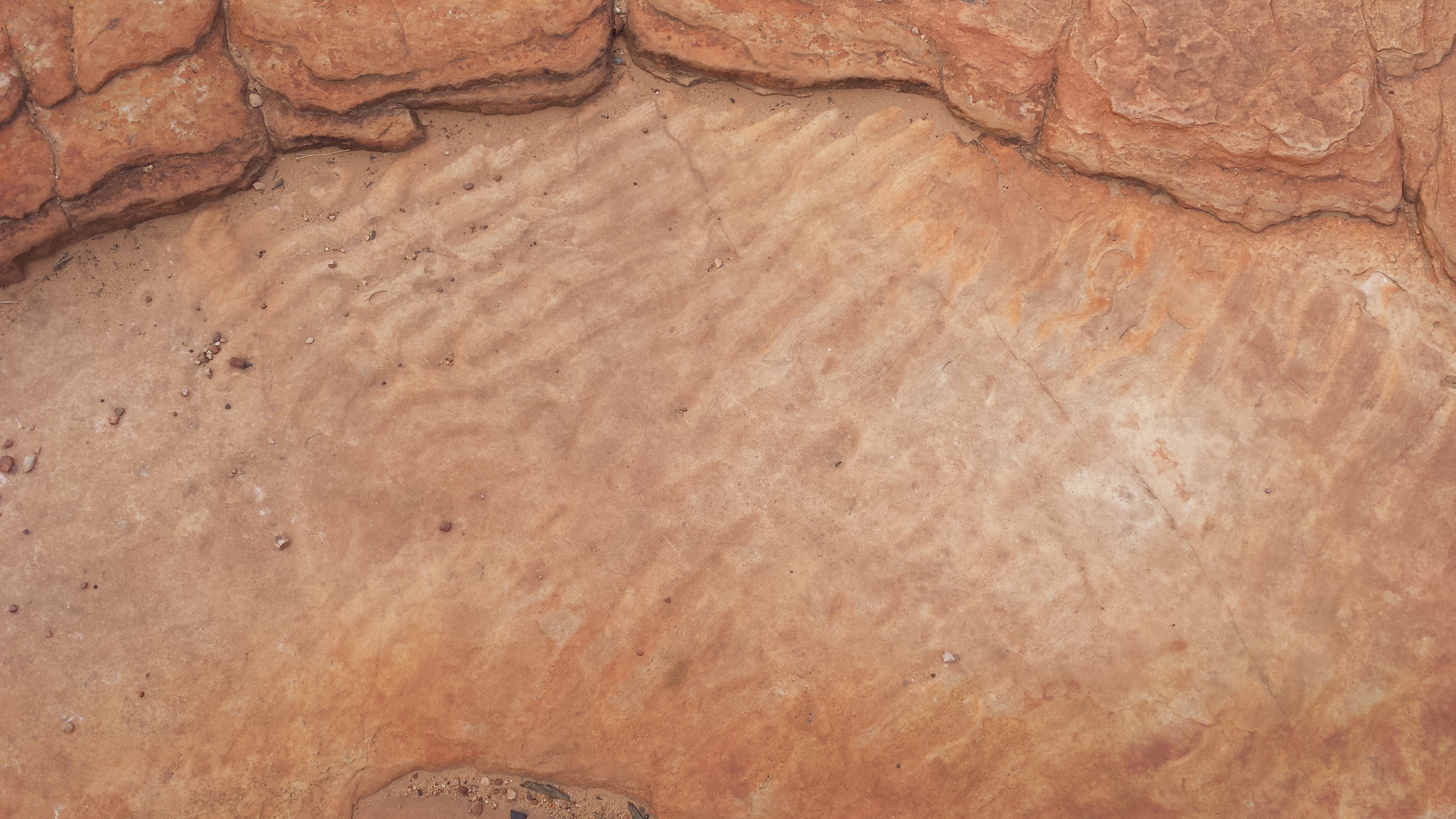
We did the King’s Canyon Rim Walk which is approximately 6km and takes 3-4 hours. It starts with a steep stair climb up ‘Heartbreak Hill’ which we began just before sunrise. As we climbed, we could see the sun start to hit the other side of the canyon wall and an orange glow came over the whole place. A few of us struggled with this first part but the whole tour group was incredibly supportive so with several short breaks everyone made it to the top. From there, the walk is relatively easy going and wasn’t much of a struggle at all. The first interesting element of the walk you will come across is Priscilla’s gap. This was made famous due to the film Priscilla Queen of the Desert which was set in outback Australia. This is a great place to take some wonderful pictures showing off your inner Priscilla. Roughly halfway through the walk is a small detour to a place called the Garden of Eden. It is a small valley in the canyon with a lake and filled with lush greenery. On the way down the canyon, you will then pass through the Lost City, a series of rock domes that look like houses from a long-extinct civilisation but are actually just natural formations.
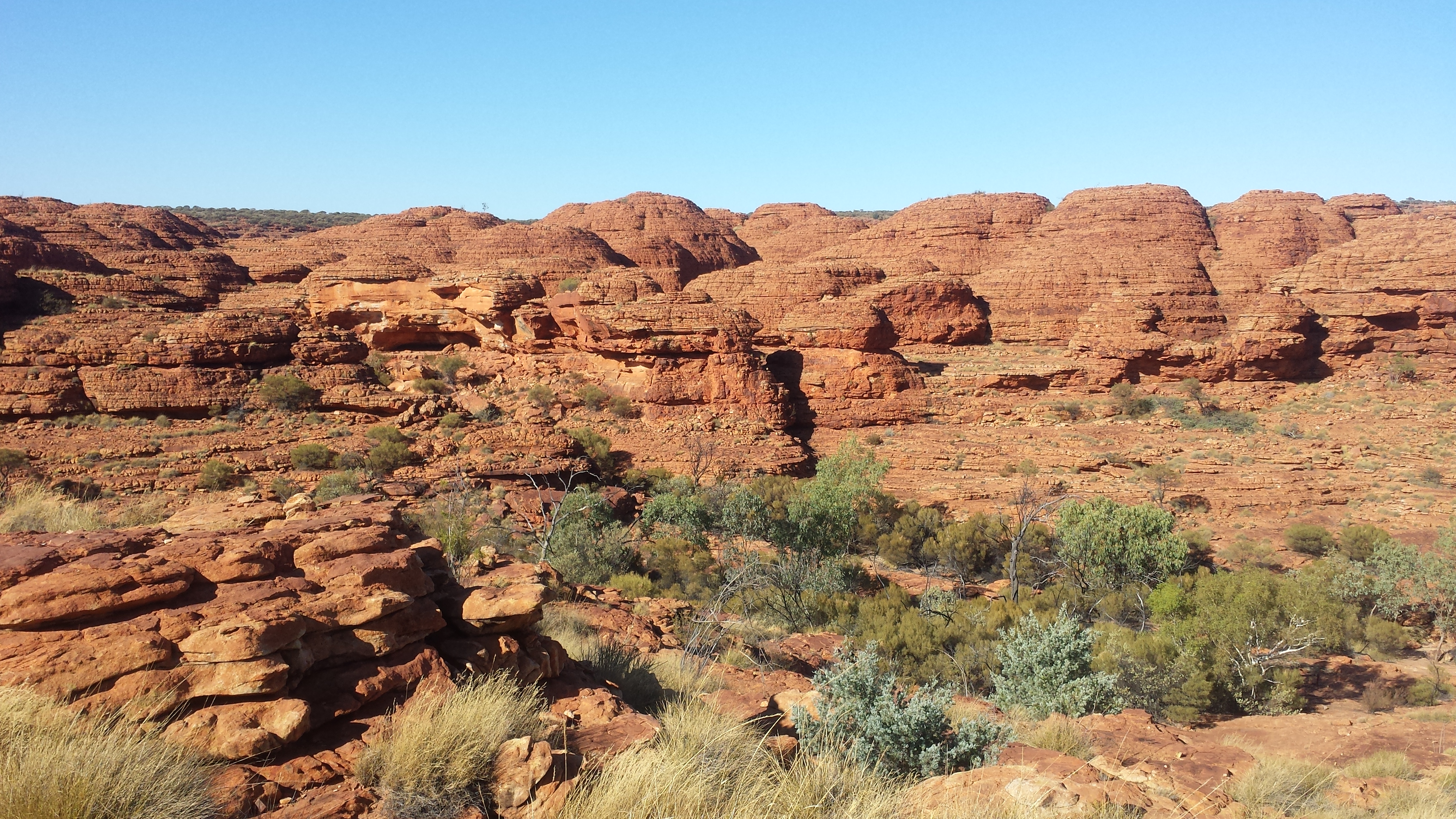
After completing this hike, we made our way towards Alice Springs stopping at a few rest stops and sites on the way. Again it was a long drive and took most of the day but it was nice to have a bit of relaxation after the strenuous activities of the last few days. We arrived in Alice Springs pretty late and as I had originally booked through a different company, I ended up staying in a completely different hostel to everyone else from my group. We said our goodbyes and I was sent the group photos we had taken together (unfortunately I had some technical issues so never actually received these which was a real shame) before I checked into my hostel. Unfortunately, as it was so late, there was nowhere still serving food so I had to walk to the service station and pick up some snacks. I’m not sure if it was the area I was in or just because I was nervous being by myself, in a new place, quite late but it felt a little sketchy and I was a bit worried about being alone there. I was planning on exploring a little bit but decided against this and just returned back to the hostel to eat. I was surprised to find my hostel had mixed gendered dorm rooms which I hadn’t been informed of but after the initial shock, it was fine for the amount of time I spent there.
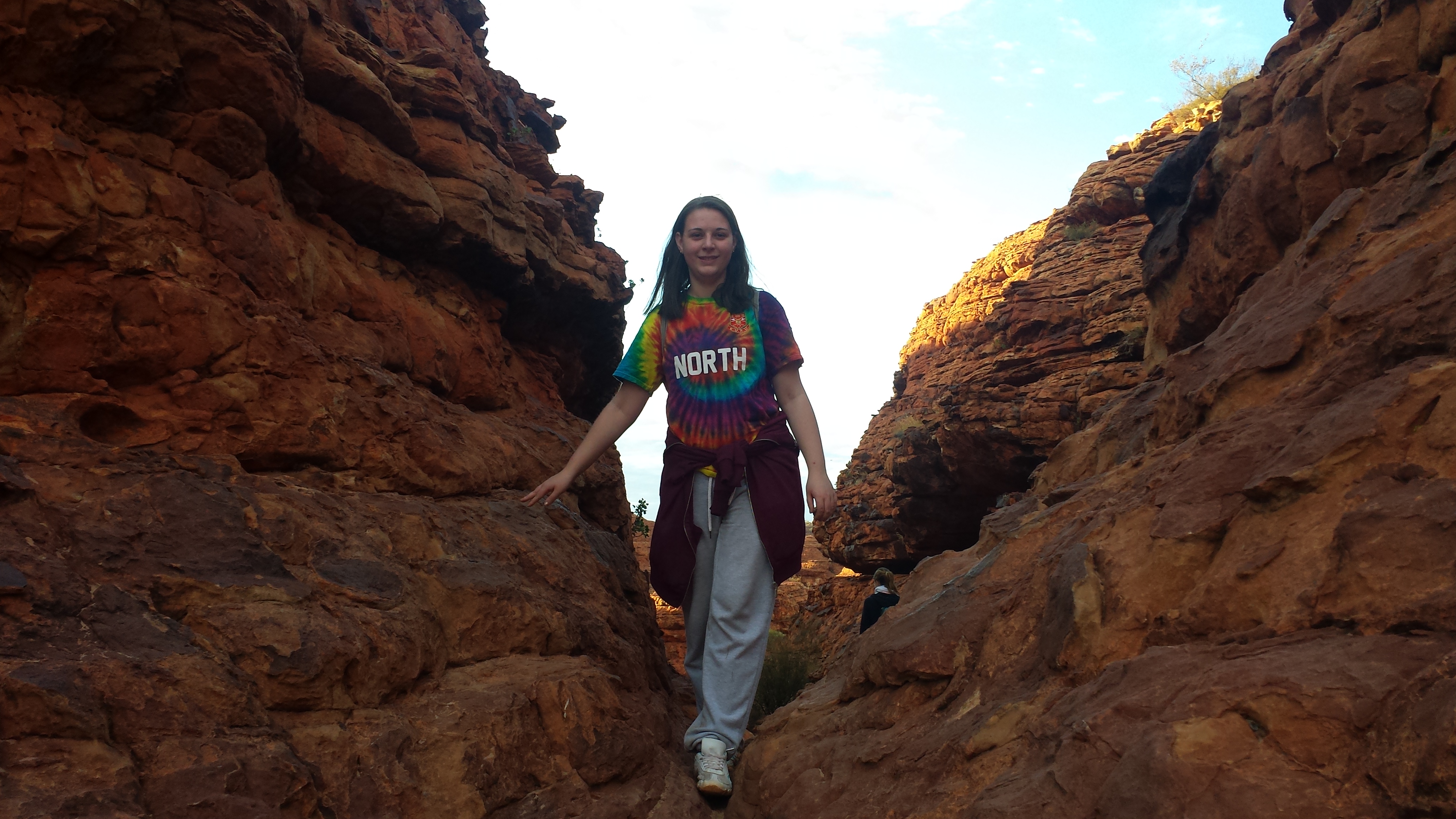
Day 5 – Goodbye to Australia’s Red Centre.
My final day in Australia’s Red Centre was a little on the quiet side. I was being picked up by the Rock Tours this time to head back to the airport so woke up before dawn to find the meeting place. I got the front seat on the tour bus which gave me excellent views of the open road but I felt like this tour group wasn’t as friendly as the ones I had originally been with. Maybe it was just because it was the first day so no one knew each other yet but I didn’t get to know anybody on the bus that day. We stopped at a camel farm where we had the option to ride them. I would have taken this offer up but no one else on the whole bus wanted to so I didn’t want to be the only one. If I had been with my original tour group I think others may have been up for this and I wouldn’t have felt so alone. In the end, I made it to the airport and while the last day was a little disappointing, the overall trip was so great.
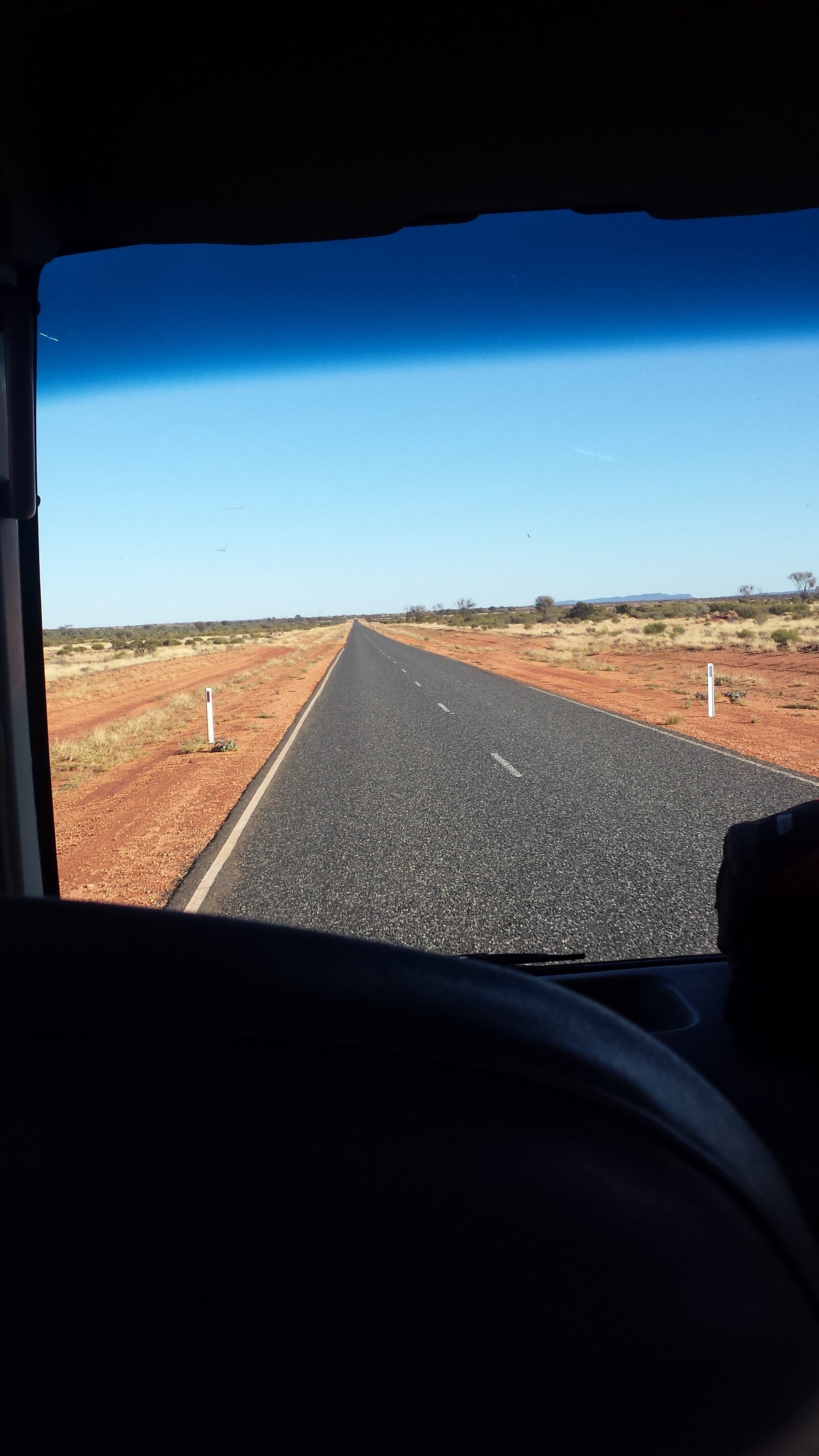
Overall, my outback experience in Australia’s Red Centre was one of the best things that I did whilst in the country. I really loved Adventure Tours and I thought the guides were really great. It may have been cheaper to self-drive, but as a solo traveler (especially as one who is not used to outback driving) I think a group tour like this is a great way to see this part of the country. There are several different tour groups which do similar itineraries to this but I can highly recommend Adventure Tours due to their expert tour guides.
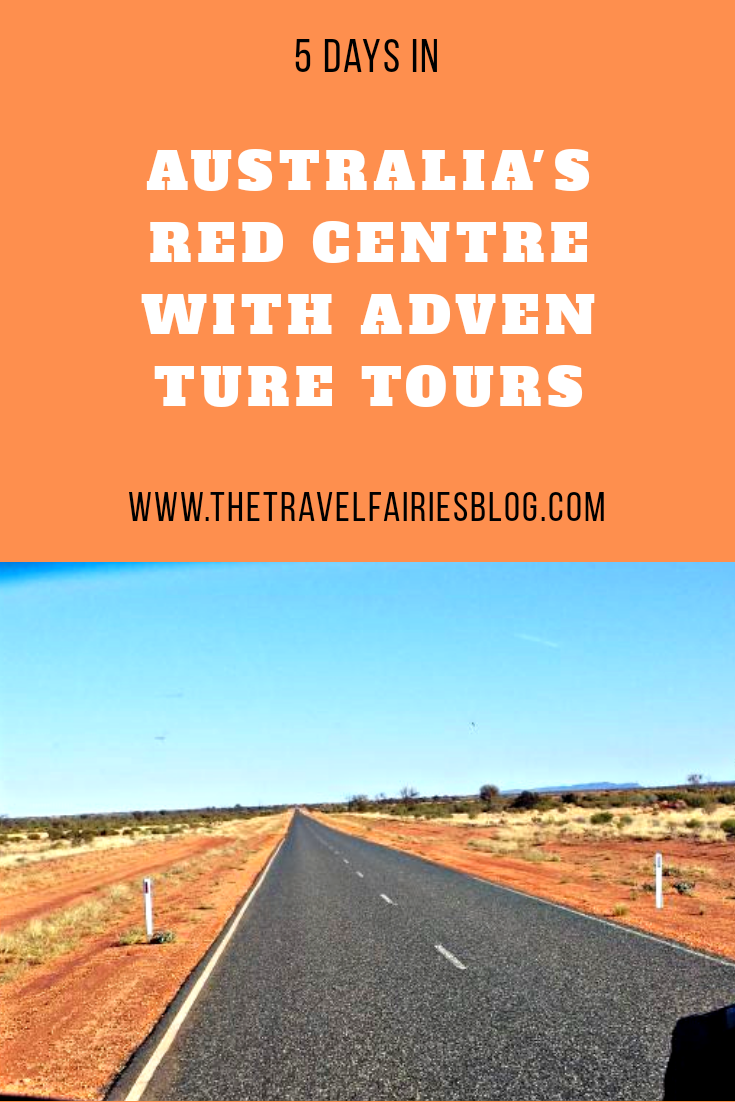
You may also like...
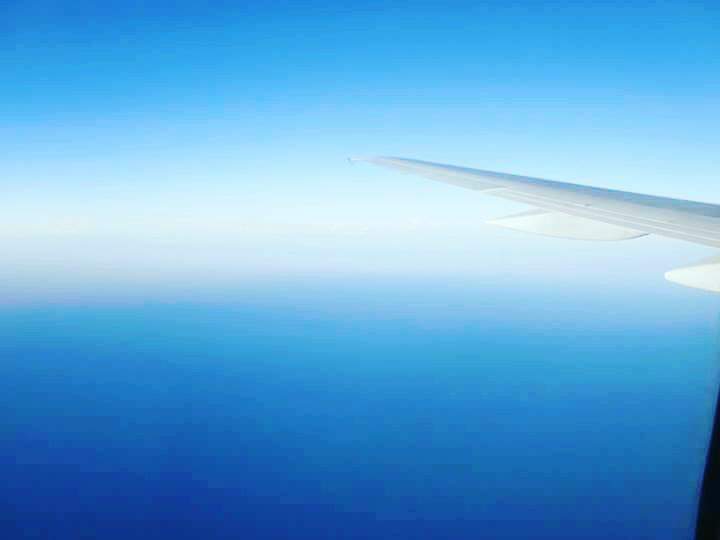
How to Travel Albania on a Budget
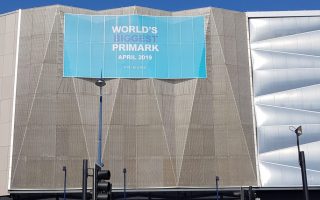
A Trip to the World’s Largest Primark in Birmingham

The Bear Grylls Adventure in Birmingham is now open
It looks amazing to visit Australia. Each and every time Australia blog posts inspire me to visit this place. This is my dream now. Keep posting.
Leave a Reply Cancel reply
Your email address will not be published. Required fields are marked *
Privacy Overview


A Guide To The Red Centre of Australia
The striking Red Centre of Australia is an extraordinary natural treasure. It is packed with desert adventures, Aboriginal sacred sites, and will dazzle you with its gorgeous colours. One of the most memorable attractions of Australia beautiful Red Centre is Uluru Ayers Rock . It has a peaceful and spiritual atmosphere which creates an unforgettable experience for travellers. Alice Springs is another great spot for many fascinating adventures.
This travel guide will take you on a virtual tour to the very best places in Australia’s Outback.
Where is the Red Centre located and how to get there
There are many viable options that you can use to get to the astounding red centre of Australia. You can take a direct flight to your destination or plan a road trip. Buses and trains are also available.
Here is a Red Centre travel guide on how to get there and around:
Taking a flight
The Red Centre can easily be reached from all of the major airports in Australia. There are many direct flights from the main cities to Alice Springs or Ayers Rock airport. Once you arrive, you could hire a car and drive to your accommodation. If you are heading to Uluru Australia, the Ayers Rock Airport is just 25kms away.

Self-Driving Trip
There are many beautiful things to see on your fun-filled Red Centre trip to Alice Springs. You can choose to take the Stuart Highway from Adelaide or Darwin to get to there. A good part about this is that you can have some of the best road trips without a 4WD, from Sydney or Melbourne on the sealed roads. Driving to Uluru is also very easy, and you will traverse through some of the most beautiful streets in Australia.
A-train journey
If you are looking for a budget-friendly travel option, then hop on a bus . Some buses travel down the Stuart Highway directly to Alice Springs. And from there you can take the bus to visit Uluru. This is because there aren’t any that ply from Adelaide or Melbourne to Ayers Rock. You can even buy a Kilometre Pass from Greyhound which lasts for 12 months and allows you to hop on and off as much as you want. There are backpacker bus options packed with hostel or camping accommodation, sightseeing opportunities, and meals.
How to discover the striking Red Centre Australia
The best way to travel to the heart of Australia is to hire a car and take a road trip to Uluru . This is not only one of the cheapest ways to enjoy your trip, but it also allows you to have a better itinerary.
You can cruise along the 1135km Red Centre Way from Alice Springs to Uluru in a 4WD or 1750km on a 2WD. Your road trip via the Kings Canyon will be along 1200km without visiting the McDonnell Ranges. There are so many astounding things to see on this journey.
The Australian Red Continent icons like the West MacDonnell Ranges, Uluru, Kata Tjuta, Kings Canyon, and Alice Springs are explored.
Travelling By 2WD
Many tourists have a misconception that you need a 4WD to get to Central Australia, which is not true. Hiring a 4WD is expensive, and it is best to rent a 2WD to get to specific locations.
Travelling by 4WD or campervan
You can hire a 4WD or a campervan to drive across the Australian Outback on the unsealed roads. It will allow you to explore the rugged landscape of the Western MacDonnell Ranges. On your way don’t forget to explore the enchanting Palm Valley, Rainbow Valley, see the Aboriginal rock art of Roma Gorge, and even camp at 2-Mile. Some 4WD only locations should only be undertaken by experienced drivers who have the right equipment and supplies. Going with a local tour guide is also great for such trips.
A Round Trip Itinerary From Alice Springs To Uluru
Make the most of your Red Centre trip by self-driving from Alice Springs to Uluru. A 2WD can take the 445km journey from Australia’s centre on the Stuart and Lasseter Highways. It is an easy stress-free route with four fuel stations along the way. Just be aware that fuel prices are quite steep! If you decide to take the Mereenie Loop to get to Ayers Rock, you will need a 4WD.
Alice Springs Travel Guide: what to do and see
Located in Australia’s Northern Territory Alice Springs is a popular tourist gateway. Most people fly into Alice Springs and hire a car to set off to Uluru and Kings Canyon. But there are loads of things that you can do during your stop here too.
Here is an Alice Spring travel guide with the best things to do on our visit:
Botanic Gardens
Kangaroo spotting, aboriginal artwork, hot air balloon sights, desert park activities, west macdonnell ranges.
Going on a day-tour of the Western Mc Donnell Ranges is a great way to explore Alice Springs surroundings, especially if you travel alone, it gives you a nice break from your road trip adventures. The West MacDonnell Ranges offer many beautiful spots for swimming in a rock pool and walking through towering red cliffs and gorges. You can go on a self-drive road trip and stop at Ormiston Gorge and Glen Helen to mention a couple of beautiful gorges.
Cool things to do at Uluru and Katja Tjuta National Park
From beautiful Alice Springs head to Uluru Ayers Rock. You will not fall short of things to do and places to see here. Here are some of the best attractions for a fantastic Uluru itinerary :
Interesting Uluru walks
The best thing about Ayers Rock is its numerous walking trails. It is an excellent place for hiking or taking long sightseeing trips.
The Base Walk goes around the base of the big rock, which is about 9km in circumference and 348 metres in height. It takes about 3-4 hours to go round. Start early after sunrise and take lots of water with you. You will come to many boulders, cliffs, and cave formations with painted and marked walls illustrating the ancient people’s stories and legends.
The Mala Walk along Uluru’s base allows you to follow the Aboriginal Ancestors footsteps. It is a place of great cultural and natural beauty and is also wheelchair accessible. This walk starts at 8.00 am (Oct-Apr), and 10.00 am (Sept-Mai). From the base to the northern face of the big Rock, this daily free guided walk tells about the arrival of Mala people at Uluru, their climb to the top of Uluru to erect a special ceremonial pole, their attack and killing among indigenous tribes.
The Kuniya Walk is another cultural route which will teach you a lot about the dramatic creation story of Uluru.
Browse through All Day-Tours and activities at Uluru
The Uluru Cultural Centre
Uluru has a magnificent cultural centre. If you want to learn more about the Anangu people , the ancient aboriginal owners of the land, there are audio and visual displays providing a fascinating insight into the relationship to their land through rituals and ceremonies.
Moreover, there is the Maruku Arts and Crafts , an arts co-operative representing aboriginal people from West, South and Central Australia. Inside the centre, you can also buy unique clothing, books, paintings and if you wish you can join the Anangu Tours , their guided walks are really worth it.
Cooling Waterhole
One of the biggest attractions at Uluru is watching it at sunset. The same for Katja Tjuta. In my experience, Uluru sunset and Kata Tjuta sunrise are the best. At Uluru there are 2 viewing platforms: one for the sunset and one for the sunrise, and there is 10 min drive distance between them.
The experience is always different depending on the weather conditions. It can glow a fiery red, to a deep purple and change dramatic colouring, especially when heavy storm clouds and sunlight break through the horizon. If you prefer not driving, book the shuttle transfer from your hotel. Or join one of the sunset tours, click here below see our pick.
Book a Uluru Sacred Sited and Sunset Tour
Camel Rides
You can start your day by enjoying a sunrise camel ride against the incredible backdrop of Ayers Rock. You will be led through the Outback by an expert guide as you can take in the changing colours at dawn. This fantastic Uluru tour will teach you a lot about the desert’s ecology and wildlife while enjoying a camel ride.
Starry Dining
The night-time is a brilliant opportunity to have the ultimate “ starry-dining experience “. The Sounds of Silence dinner at Ayers Rock takes place atop a red desert dune. You can sip on wine while watching the beauty of the setting sun.
Walpa Gorge
The valley of the winds walk.
This walk is a more strenuous walk than the shorter Walpa Walk, but worth it. The 4 hours walk will reward you with spectacular scenery, colourful vegetation and birdlife are prolific around the base of the domes and within the gorges. At the Olgas, you will not find crowds like at Uluru, but it’s best to plan this walk early morning, soon after sunrise.
The Sunrise from the Dunes Viewing Area
What to do and see at kings canyon.
Just three hours from Uluru is the majestic Watarrka National Park. This national park is home to Kings Canyon which is its biggest attraction. It will help to have a good pair of walking shoes with you if you want to visit here.
If you don’t drive, from Ayers Rock there is a comfy shuttle bus transfer to Kings Canyon .
Take the Kings Canyon Rim Walk
Enjoy the garden of eden, visit the general grant grove, do the kings creek walk.
This is an easy walk to take along the red rock cliffs . This route follows the floor of the canyon and allows you to enjoy the vegetation along the way. At the end is a fabulous lookout point where you have astounding views of the towering walls. It is also wheelchair accessible.
Here are a few more reasons why you should visit Kings Canyon Australia.
Where to stay in the Red Centre of Australia
When putting together your itinerary, keep in mind all the attractions you want to visit. You will need enough time to explore all of the remarkable Red Centre highlights. When planning your Central Australia itinerary , make sure that you spend at least two days at Alice Springs. If you visit the Western McDonnell Ranges, it will make sense to spend more time exploring it, adding one more day to exploring it.
Best Places to stay in Alice Springs.
Alice Springs has many beautiful accommodation options. There are multiple resorts, and inns for travellers to spend the night. If luxury hotels aren’t your things, there are budget-friendly hotels in Alice Spring, Australia. Staying at hostels is also a great place to stay without making a dent in your budget. The Alice Springs YHA is a hostel that used to be an outdoor movie theatre. Very often, movies are still screened there!
After you visit the West MacDonnell Ranges, you wind down at the BIG4 MacDonnell Range Holiday Park , just a 5-minute drive away from Alice Springs. Beautiful MacDonnell Ranges surround it.
Book your accommodation in Alice Springs
Best places to stay at Uluru
There are many well equipped Ayers Rock accommodation options. The most famous place to stay in the Ayers Rock Resort or Yulara . It is 25km away from Uluru. It is a great place to stay with a supermarket, multiple shops, a petrol station, restaurants, and a host of other essential services.
Within the resort, you could choose to stay in an apartment, a luxury hotel, or check out its cheaper hotel options. The budget accommodation at Yulara costing around 55 Euros or 60 Dollars is the cheapest place to stay at shared rooms and shared facilities.
This resort holds tours for guests and has many other fun activities. Many people wonder how many days to spend in Uluru. Since there is so much to do here, it is best to keep aside at least two days to enjoy this splendid location fully.
Book accommodation at Ayers Rock Resort
Best places to stay in Kings Canyon
There are some fascinating places to stay at while in Kings Canyon. The Kings Canyon Resort is just a few kilometres from the there. It has powered sites for caravans, unpowered tent sites, and many camping options available.
The Kings Creek Station is 40kms from the canyon. It has a campground available and safari-style tents and cabins. These Kings Canyon camping grounds are fantastic to get the feel of the beautiful Red Centre.
Book your accommodation at Kings Canyon
What is the best time to visit the Red Centre Australia?
The best time to visit the magnificent Red Centre of Australia is between April and September. This is a pleasant time to visit since the temperature is between 20-30degrees. Since the weather is cool, you can go walking, hiking, or swimming. From October to March, the heat during the day soars, and it can get scorching. Summer also brings along with it flies that can make camping a nightmare.
Winter is also not the wrong time to be in the Outback. The desert will be cold during these months and is a good hiking time. Springs and autumn are beautiful times to visit, and you can even take a self-guided road trip by car or campervan in these seasons.
How much time for exploring
When putting together your itinerary, keep in mind all the attractions you want to visit. You will need enough time to explore all of the remarkable Red Centre highlights. When planning your Central Australia itinerary, make sure that you spend at least two days at Alice Springs . If you visit the Western McDonnell Ranges, it will make sense to spend more time exploring it, adding one more day to exploring it.
first published in 2012, last updated Jan 2021
More Related Guides:
All Destinations of Australia
Rocky Travel Homepage
If you find this article helpful for your trip, I’d appreciate it if you could support Rocky Travel and book your tour, accommodation, rental car, or purchase my book using the links in the box below, thank you!
BOOK YOUR TRIP WITH THESE RESOURCES
Get Travel Insurance For Your Trip
Travel with peace of mind: 👉 Compare and Buy Travel Insurance .
Book Accommodation WorldWide
Find the best deals for hotel, homes, villas with 👉 booking.com .
Join Small Group Tours Of Italy For Over 50
Explore Italy with our 👉 Small Group Tours Of Italy .
Find The Best Tours Deals For Australia
Scout for the best guided trips and tours with our 👉 Australian Tours Guide .
Plan & Book Your Australian Adventure
Create the perfect Australia Trip Itinerary with 👉 Your Australia Itinerary eBook and/or Book A Trip Planning Call .
Plan Any Trip With These Resources
Check out our 👉 Travel Planning Bible .
Privacy Overview
6 Unmissable Red Centre Experiences
To discover the real Australia, you need to leave the coastline behind. Here are six experiences you can only have in the heart of Oz - the Red Centre.
Swag camping
Forget tents, campervans and caravans. The only way to experience camping in the outback is sleeping in a swag. Swags are similar to sleeping bags but extra thick and durable with a comfy foam mattress inside. Just slip a sleeping bag and pillow inside and you’ll stay nice and warm during the cool outback nights. Best of all without a tent canopy and light pollution ruining your view you’ll see the stars more clearly than ever before and it’s more than likely you’ll see a shooting star or two!
Kata-Tjuta is actually a site bigger than Uluru, and is found in the same national park - so is definitely worth the visit even though it's less famous! Hike around the base of Kata-Tjuta on the Valley of the Winds walk, and take in the awesome views of the 36 500 million year old domes.
Sunrise at Uluru
Uluru is an impressive sight at any time of day but watching the sun rise at Uluru - changing it into a rainbow of gorgeous colour - is a seriously special experience.
Hike through Kings Canyon
Kings Canyon attracts half as many visitors as Uluru, but many who take the time to visit the Canyon find it just as incredible. Take the 6km Kings Canyon Rim Walk in Watarrka National Park which will lead you 150m above the canyon’s depths. The red sandstone rocks of the Canyon were formed by millions of years erosion creating unusual and interesting rock formations known as the Lost City. Don’t forget to check out the Garden of Eden, a sacred and permanent waterhole in the canyon.
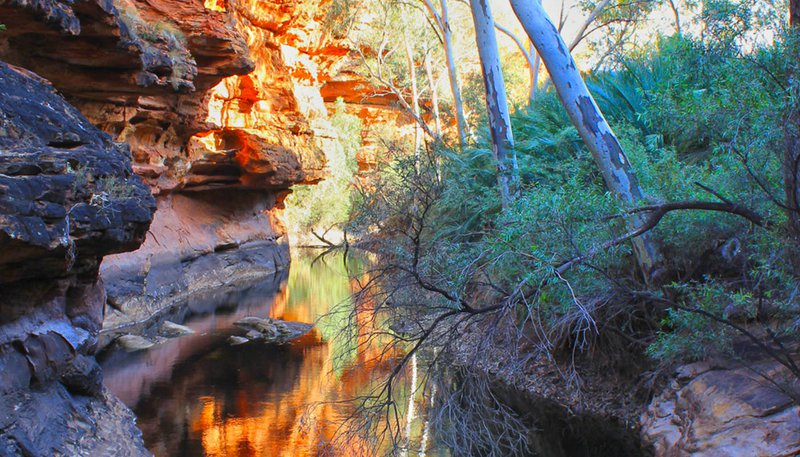
Spend the night in Coober Pedy
Coober Pedy, the world’s largest opal mining town, is a bizarre sight. The town is surrounded by mine shafts and mounds of red rubble which makes it look like something from outer space-it’s not surprising the town was used as the set for Mad Max: Beyond Thunderdome. 70% of the town has been built underground to escape the heat, you can visit an underground church, art gallery, library and pub and sleep in an underground hostel to get the full Coober Pedy experience. You can also search for opals yourself and play golf on the town’s course (which looks like it was built on Mars). Make sure you visit the kangaroo orphanage at Josephine’s Gallery at feeding time to hand feed the super cute kangaroos.
Build a bush camp fire
No outback road trip is complete without an evening spent building a fire and cooking a meal on it. With no phone signal, shops or pubs about the campfire is the perfect place to gather for beers, banter and to indulge in the Aussie version of smores (a toasted marshmallow between two Tim Tams).
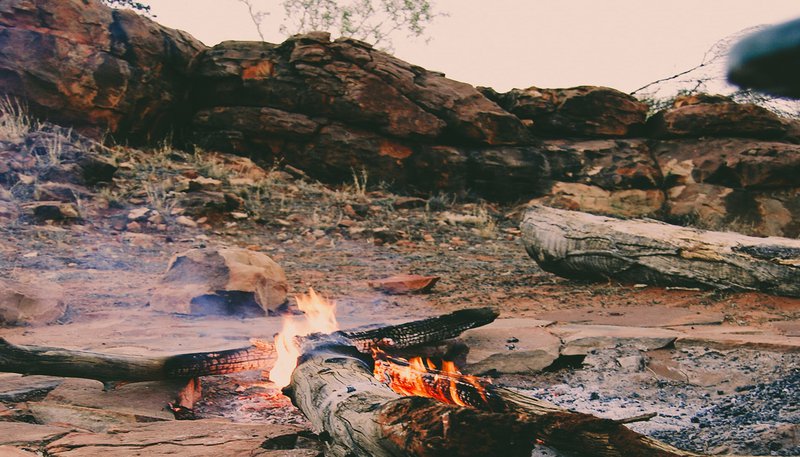
Get a little closer to understanding Aboriginal culture
The Red Centre has many landmarks considered sacred by Aboriginal people. Although the Anangu, the traditional owners of Uluru, do not share all of their laws and principles with outsiders, visiting the Cultural Centre at Uluru or taking a guided tour of Uluru’s base is a great step towards understanding the significance of Uluru to the Anangu. Definitely take the opportunity to learn from elders from the world's longest continuing culture and traditional custodians of the land we live and work on. Australia always was, and always will be, Aboriginal land.
Check out our Ultimate Guide to Backpacking Australia for more info on awesome destinations in Oz, plus advice about when to go, how to get around and how to land yourself a job if you're on a Working Holiday Visa.
Ready to start exploring? Click here to start your experience of a lifetime Down Under!

To discover the real Australia, you need to leave the coastline behind. Here are six experiences you can only have in the heart of Oz - the Red Centre.
Kata-Tjuta is actually a site bigger than Uluru, and is found in the same national park - so is definitely worth the visit even though it's less famous! Hike around the base of Kata-Tjuta on the Valley of the Winds walk, and take in the awesome views of the 36 500 million year old domes.

Build a bush camp fire

The Red Centre has many landmarks considered sacred by Aboriginal people. Although the Anangu, the traditional owners of Uluru, do not share all of their laws and principles with outsiders, visiting the Cultural Centre at Uluru or taking a guided tour of Uluru’s base is a great step towards understanding the significance of Uluru to the Anangu. Definitely take the opportunity to learn from elders from the world's longest continuing culture and traditional custodians of the land we live and work on. Australia always was, and always will be, Aboriginal land.
Check out our Ultimate Guide to Backpacking Australia for more info on awesome destinations in Oz, plus advice about when to go, how to get around and how to land yourself a job if you're on a Working Holiday Visa.

DOWNLOAD A BROCHURE

8 things to do around Uluru and the Red Centre
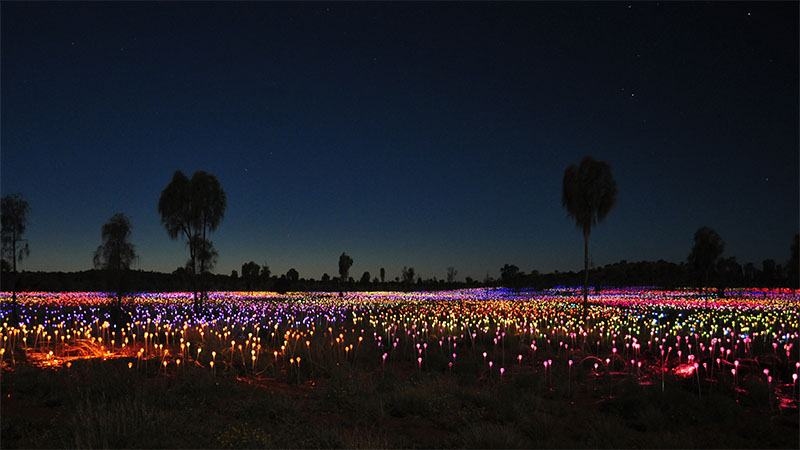
It is impossible not to be touched by the ancient beauty and spiritual significance of Australia’s Red Centre.
Watching Uluru shed its dark cloak and glow in the first light of dawn, discovering natural medicines with the Luritja people near Kings Canyon and finding the Garden of Eden in the middle of a desert are just some of the ways you can experience this vast and surprisingly diverse part of Australia .
From marvelling at the world’s most famous rock at Uluru-Kata Tjuta National Park to strolling through an internationally acclaimed artwork and dining at linen-napped tables surrounded under stars, here are eight incredible ways to immerse yourself in the magnificence of Uluru and the Red Centre with Intrepid Premium .
1. Experience the magic of Australia’s famous monolith
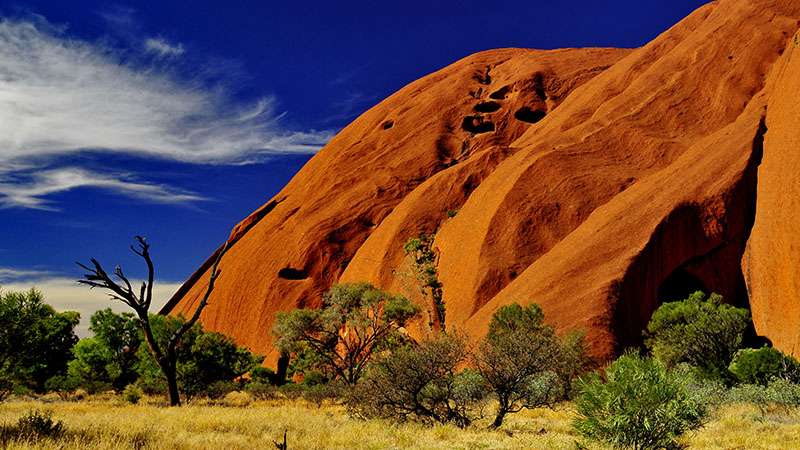
Uluru is a monolith that’s around the same height as the Eiffel Tower but only a small part of it is visible; it is said to extend up to six kilometres underground. Most people are familiar with Uluru’s iconic picture postcard sunset or sunrise view but these look nothing like the opposite side of the rock with its rugged valleys and craters. This northern section hasn’t been photographed commercially for years due to its spiritual significance, which means the only way to truly ‘see’ Uluru is to walk around its base.
2. Stroll through a carpet of lights
Field of Light was originally conceived as a pop-up art installation by British artist Bruce Munro. Since its debut in 2018, it has been extended indefinitely due to its overwhelming popularity. The installation is called Tili Wiru Tjuta Nyakutjaku by the Anangu people, which means ‘looking at lots of beautiful lights’ in the local Pitjantjatjara language. Consisting of 50,000 hand-blown light bulbs interconnected with fibre optic cables, this stunning masterpiece slowly pulses and changes colour. Stroll along the trails which travel through this massive installation after enjoying a special dinner under the stars.
Dine under the stars on our Premium Red Centre tour
3. Explore the dreamy Garden of Eden
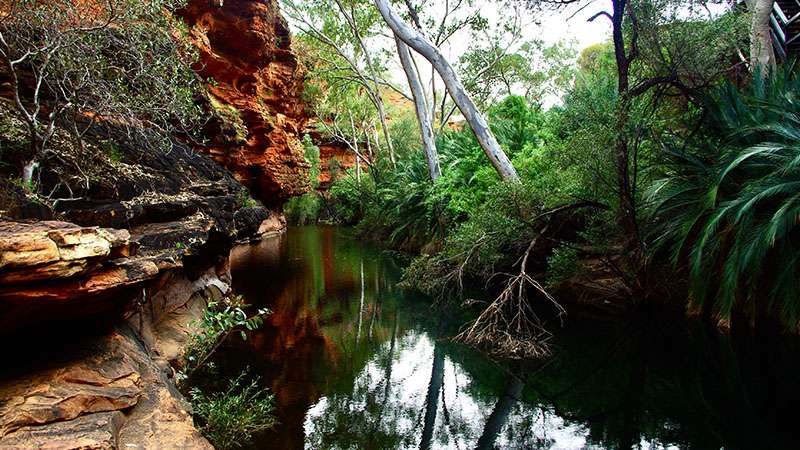
The Garden of Eden is real and you’ll find it in the Red Centre. Kings Canyon is far from the desert wasteland some visitors expect. This aptly named waterhole at Kings Canyon is like an oasis, tucked into a crevice of rocks and surrounded by huge cycads and other lush flora, and home to more than 600 species of plants and animals. Years ago, the Garden of Eden was part of a vast yet shallow sea. Look carefully and you’ll see the fossilised ripples of a once-sandy ocean floor.
See the Garden of Eden on our Premium Red Centre tour
4. Dine on native bush foods
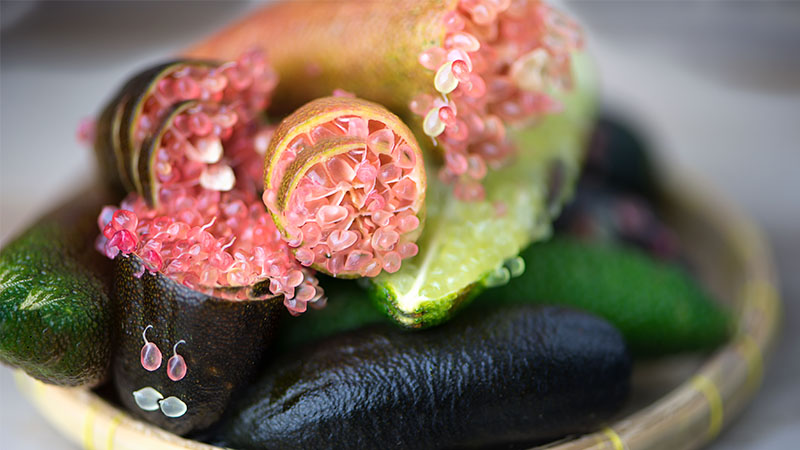
Australia’s appreciation of native bush foods has come a long way since the late 1800s when colonial botanist Joseph Madden said, “Native food plants are nothing to boast of as eatables”. Back then, locally sourced ingredients such as finger lime and kangaroo were considered little more than a source of nutrition. Now they draw international acclaim from diners, enthusiastic home cooks and some of the world’s best chefs. In the Red Centre, you can sample delicacies such as lemon myrtle feta, finger lime margaritas and spicy bush tomato chutney, and learn from specialist suppliers like Kungkas Can Cook .
Meet specialist suppliers, Kungkas Can Cook, on our Premium Red Centre trip
5. Discover the Dark Sky
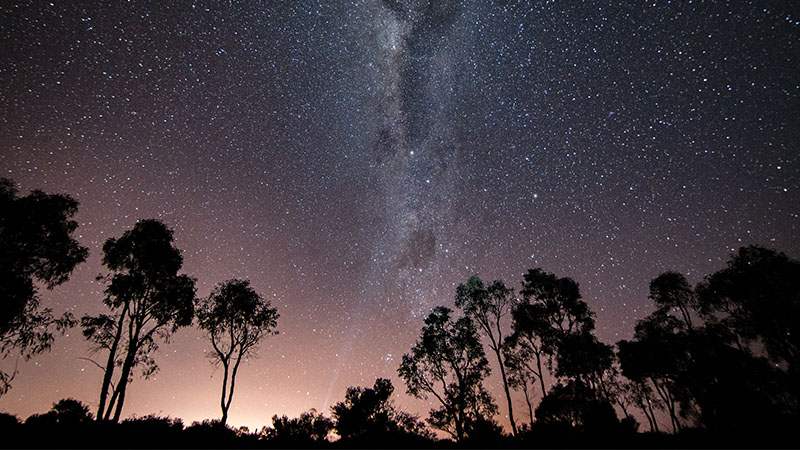
Home to its very own Dark Skies Festival, Alice Springs is one of the best places in Australia to take a virtual trip to the moon and beyond. Get an introduction to all things celestial, learn how to navigate using the night sky, and see if you can spot your zodiac sign. If you’ve ever wondered just how big the universe is, now is your chance to find out. You’ll also get the chance to look through a very, very big and very impressive telescope for a superb view of the night sky.
6. Experience the spirituality of Kata Tjuta
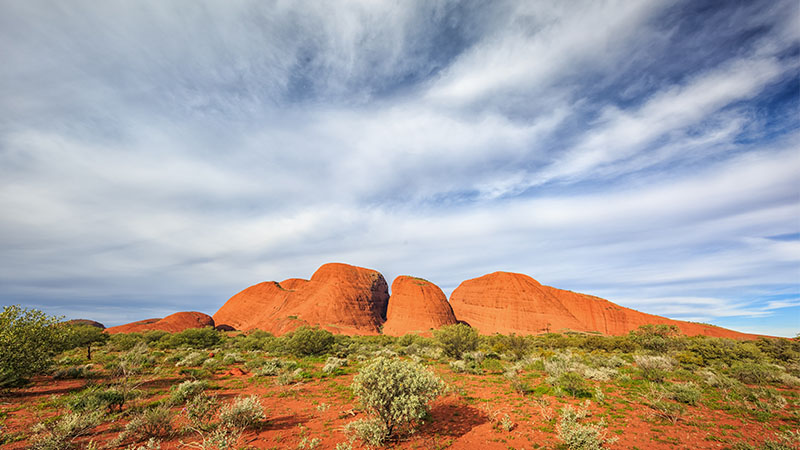
For most travellers who visit the Red Centre, the focus is almost always Uluru and seeing the rock at sunrise and sunset in all its colourful glory. While there’s no doubt Uluru is spectacular and a special place, especially for Australia’s Anangu people, what surprises many visitors is that Kata Tjuta (The Olgas) holds even more spiritual significance. Seeing this amazing formation of rocks will have you mesmerised and completely captivated. Perhaps even more so than Uluru. Join a guided walk into Walpa Gorge in the centre of Kata Tjuta or conquer the longer Valley of the Winds walk.
Experience the magic of Kata Tjuta on our premium Red Centre tour
7. Walk around the rim of Kings Canyon
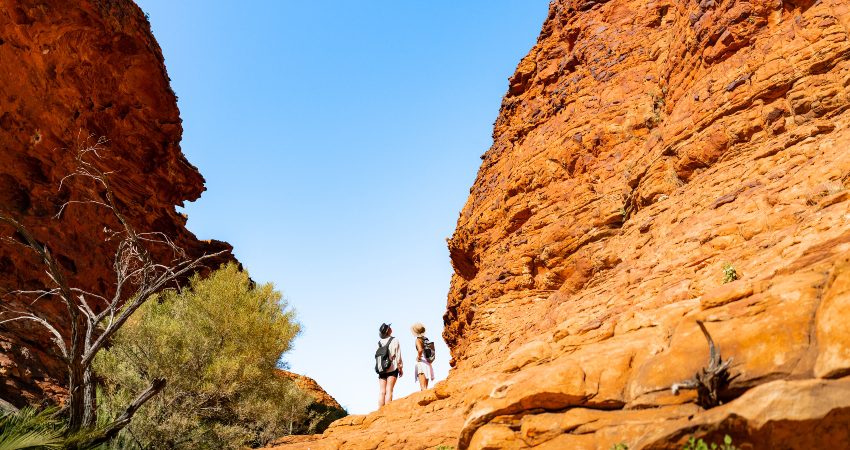
Grab a few litres of water, pull on your hiking boots and get ready for one of Australia’s best walks. Join your leader as you climb the stairs to the top of Kings Canyon where you can walk around the canyon rim and take in the view which seems to go on forever. It’s a heart-pumping climb taking approximately 3 hours but it’s definitely worth it. You can also saunter through Priscilla’s Crack, made famous after featuring in Priscilla Queen of the Desert, a classic Australian film.
8. Learn about First Nations culture with the Luritja and Pertame people
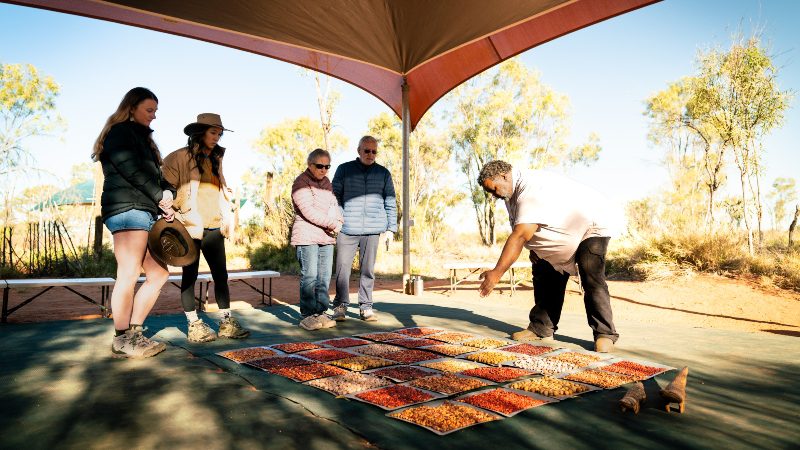
The Luritja people have lived in the area around Kings Canyon for more than 20,000 years, surrounded by a mountain range that was formed around 300 million years ago. Join a local Luritja guide and gain a unique insight into First Nations culture as you learn about the local landscapes, bush tucker, and bush medicines and how they are used for healing. Along with extracting witchetty grubs from acacia tree roots and learning how to cure common ills with native plants, you’ll also see local artwork and discover how the Luritja and Pertame people use spears and boomerangs used to hunt wildlife.
Meet a Luritja guide on our Red Centre Explorer tour
Feeling inspired?
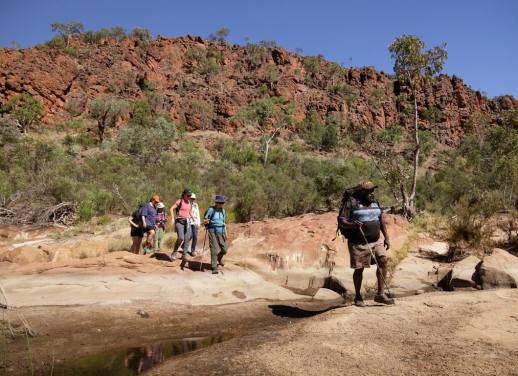
Intrepid Travel
Intrepid has been leading small group adventures for over 30 years. We’re a certified B Corp, which means we want to be the best travel company not just in the world, but for the world. To create positive change through the joy of travel. You can read our latest adventures right here.
You might also like
7 incredible hikes in denali national park, unique getaways for your next girls’ trip, how to visit europe in the off-season, best places to travel in march, best places to travel in may, best places to travel in february, best places to travel in april, best places to travel in june, inca trail trek permits: how to secure the..., best places to travel in july, best places to travel in january.
How families can spend a fun 7 or 14 days in the Red Centre
Jennifer Ennion
Travel Journalist
31 October 2023
From exploring the base of Uluru to marvelling at the Devils Marbles, here’s a Red Centre itinerary the whole family can get excited about.
The Northern Territory is not a place to turn up and see what takes your fancy. It requires planning, which can be daunting for travelling families. To make it stress-free, here’s our awesome self-drive itinerary for a seven- or 14-day Red Centre adventure.
Alice Springs – Days 1 & 2
The best place to kick off your outback holiday is Alice Springs , the epicentre of the NT. Stroll through Todd Mall Markets, popping into the Aboriginal art galleries, souvenir shops and cafes. Parents and teenagers will enjoy learning about the town’s history at Alice Springs Telegraph Station, only four kilometres north of the CBD. Younger children, however, will get more of a kick out of catching a birds of prey show at Alice Springs Desert Park. The park also runs a great bush tucker program that’s bound to fascinate the whole family.
Don’t miss: Heading up high in a hot-air balloon for spectacular outback views.
Alice to Glen Helen – Day 3
132 kilometres.
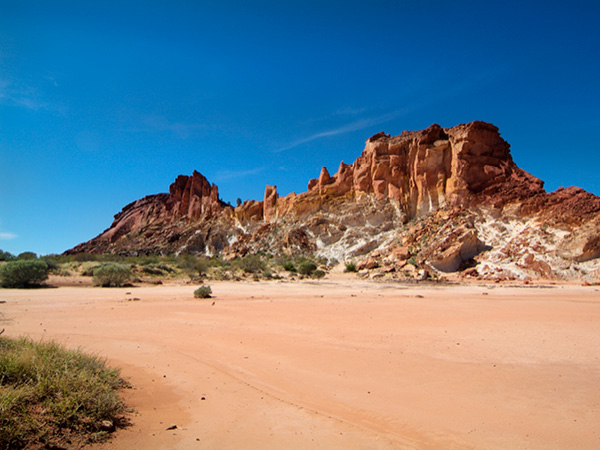
How’s the serenity? Breathtaking, really.
Start your journey along the Red Centre Way , a 1135-kilometre loop, by pointing your vehicle toward the majestic West MacDonnell National Park and the town of Glen Helen. The national park is riddled with walks, and young families will appreciate the easy Waterhole Walk, just five minutes and wheelchair-friendly, as well as the 20-minute (one way) Ghost Gum Lookout Walk. If you have a tiny tot, don’t forget to take a hiking backpack and high-energy treats to motivate little legs mid-scramble.
Don’t miss: Swimming in the near-permanent waterhole only 500 metres from the Walks Information Shelter.
Glen Helen to Kings Canyon – Day 4
234 kilometres.
Also known as Watarrka National Park, Kings Canyon is a Red Centre must-visit. Spend the morning getting there and the afternoon chilling out in the pool at Kings Canyon Resort.
Don’t miss: Popping into the resort’s Thirsty Dingo Bar, where you’ll meet other travelling families and sing along to the live music.
Kings Canyon – Day 5
The Kings Canyon Rim Walk is the highlight of any stay here as it offers hikers stunning 360-degree views of the sandstone walls. It’s a six-kilometre trail, with 500 steep steps at the start, so most suited to active older families. If you’re keen to do a walk but want something easier, the 2.6-kilometre Kings Creek Hike is a better option.
Don’t miss: Sunrise from the rim, when the light paints the landscape with red and orange brush strokes.
Kings Canyon to Uluru – Day 6
300 kilometres.
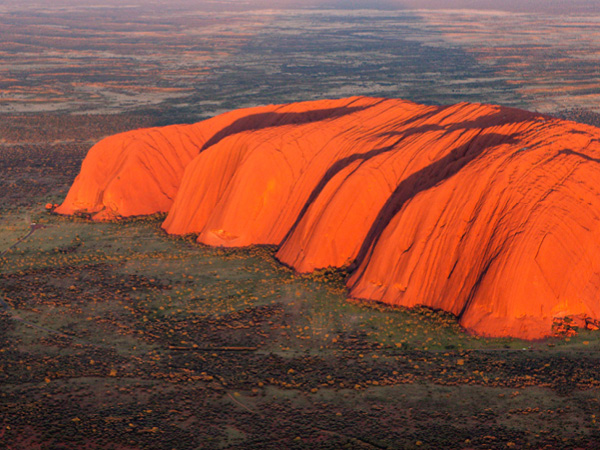
A bird’s eye view of Uluru.
Nothing can prepare you for the first time you set eyes on the Northern Territory’s most impressive landmark – Uluru . This 348-metre-high monolith, with a 9.4km circumference, isn’t any old rock, but a sacred site to the Anangu Aboriginal people. After your long drive there, stretch your legs and view Uluru from a distance at Talinguru Nyakunytjaku lookout.
Don’t miss: At night-time, wow the entire family at the Field of Light Uluru art installation. Seeing 50,000 coloured solar lights illuminate the desert is a holiday experience you’ll remember for years.
Uluru – Day 7
Wake early and hop atop a dromedary for an iconic camel ride to Uluru . Plod across the ochre sand as the sun casts shadows down Uluru’s face and turns the sky shades of pomegranate, mandarin and lemon. Uluru Camel Tours’ sunrise excursion is suitable for children aged five and over. Afterwards, join a free ranger-guided Mala Walk (8am or 10am), during which you’ll learn about Aboriginal culture and rock art. It’s an easy two-kilometre (return) route and is wheelchair accessible. You can also take a Segway around the rock, a fun alternative for children 12 and over.
Don’t miss: A Maruku Arts dot-painting workshop held at Ayers Rock Resort or the Cultural Centre. It’s an experience that will enrichen your time while visiting Uluru and a fun activity for all ages.
*Note: You can no longer climb Uluru. The Anangu community has long since urged people to circumnavigate the rock on foot, rather than climb it due to its spiritual significance and for their own safety. To understand why and to help you plan your trip, check out 5 reasons the Uluru climbing ban makes total sense and 11 things to do in Uluru that aren’t climbing .
If you have 14 days…
Uluru to kata tjuta (return) – day 8, 59 kilometres.
It’d be a shame to visit Uluru and not make the extra effort to see Kata Tjuta , 36 rock domes that rise out of the desert. Also called the Olgas, it’s a fascinating formation big and little hikers will love. Older families may be keen to tackle the 7.4-kilometre Valley of the Winds walk, while those with young kids can amble to Karu Lookout (2.2-kilometre return).
Don’t miss: The Cultural Centre while exploring Uluru-Kata Tjuta National Park to learn more about the cultural history of the area.
Uluru to Rainbow Valley – Day 9
405 kilometres.
Marvel at the colourful sandstone cliffs that give this little-known valley its name. Arrive in the afternoon when the softening sunlight brings out the purple, red and orange shades in the bands of stone. Rainbow Valley Conservation Reserve has two campgrounds. If you need a hotel, you’ll have to push on to Alice Springs, about three hours’ drive to the north.
Don’t miss: Mushroom Rock, which has been sculpted by the weather over millennia.
Rainbow Valley to Alice – Day 10
100 kilometres.
It may not seem far on the map, but a mix of unsealed and sealed roads means you still have some ground to cover before returning to Alice. Once you arrive, give yourself some downtime by wandering the quirky National Road Transport Hall of Fame. Expect to be gobsmacked by the rows of number plates climbing to the ceiling, the truck museum and other motoring relics.
Don’t miss: Bertha, the restored road train.
Alice to the Devils Marbles – Days 11 & 12
400 kilometres.
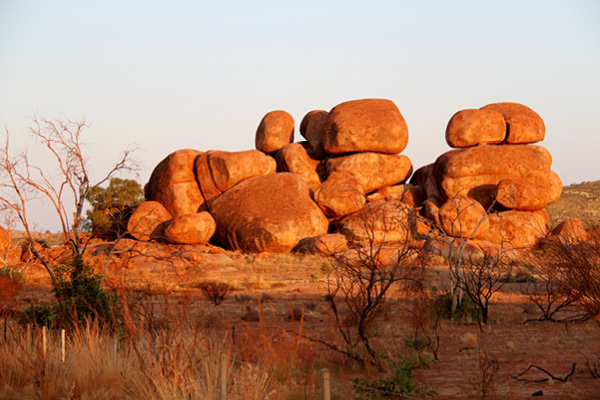
The Devils Marbles are huge granite boulders scattered across a wide, shallow valley, 100 kilometers south of Tennant Creek in the Northern Territory.
Slicing north from Alice Springs (where the Red Centre Way ends), head along the Stuart Highway to another of the NT’s impressive geological features, Karlu Karlu , or the Devils Marbles. These giant rocks appear to be balancing precariously atop one another and will be a highlight for any snap-happy photographers in the family. As Georgia Rickard writes: “To wander through here is to wander through the happenstance of an Alice in Wonderland narrative, where half-broken boulders lie, scattered, as if dropped from a careless child’s pocket as she skipped across the sky.”
Don’t miss: Seeing the Marbles at night; they’re magical. To do so, stay at Devils Marbles Hotel (formerly Wauchope Hotel), eight kilometres south.
Karlu Karlu to Tennant Creek – Day 13
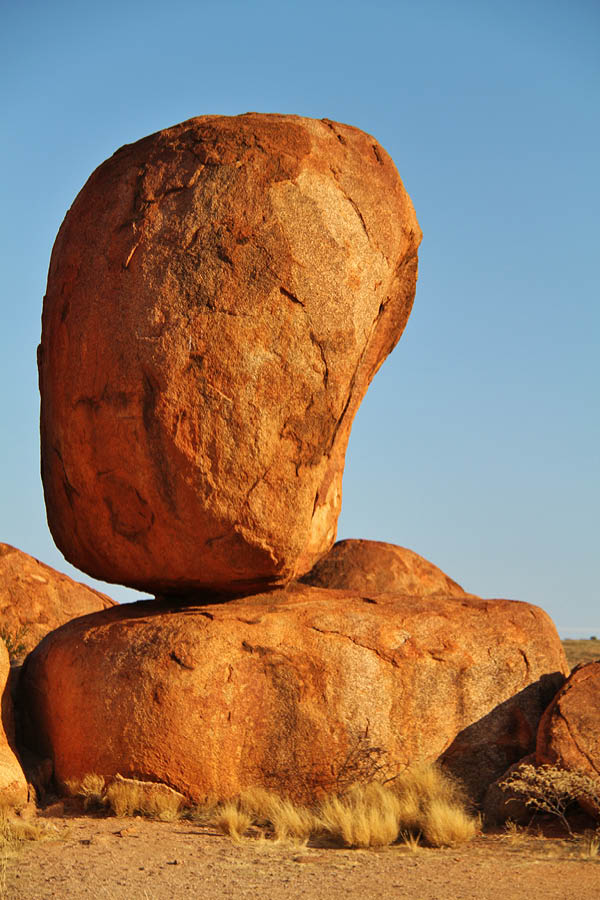
Devils Marbles: they’ll get your attention every time.
Return to Karlu Karlu for sunrise before heading to Tennant Creek , the location of Australia’s last gold rush in the 1930s. Give the kids a fun history lesson by signing up for an underground tour at Battery Hill Mining Centre, a quirky little museum.
Don’t miss: The Nyinkka Nyunyu Art and Culture Centre located on the main street of Tennant Creek.
Tennant Creek to Alice – Day 14
500 kilometres.
It’s time to say farewell to the Red Centre and return your hire vehicle to Alice Springs. Along the way, call into the strange outpost of Wycliffe Well , not far from Karlu Karlu. Considered the UFO capital of Australia, parents and kids will get a thrill out of the alien-themed roadhouse.
*If you don’t want to drive, there are a large number of companies that offer Red Centre tours, including G Adventures and AAT Kings .
For more information on the Red Centre with kids & things to do in the NT, visit the official Northern Territory website at northernterritory.com
Jennifer Ennion is a freelance travel and ski journalist who loves encouraging people to spend more time outdoors. From snorkelling with belugas in sub-Arctic Canada to hiking the Himalayas, Jennifer is constantly searching for stories that inspire readers to push their boundaries.

LEAVE YOUR COMMENT
Cancel reply.
Save my name, email, and website in this browser for the next time I comment.
You might also like

The ultimate guide to exploring the West MacDonnell Ranges
The immense Tjoritja/West MacDonnell National Park boasts some of Central Australia’s most spectacular scenery. Stretching for 160 kilometres west ...
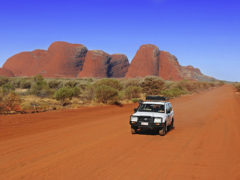
Australia’s best Red Centre outback road trip
Australian Traveller drives The Red Centre Way from Alice Springs to Uluru and back on one of Australia's greatest outback journeys. The Red Centre ...
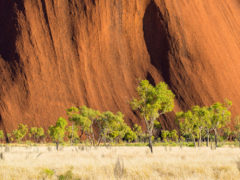
You can visit the Red Centre in comfort on a budget
Explore the heart of Australia without camping or getting a second mortgage with our comfortable travellers’ affordable guide to the Red Centre. Ou...
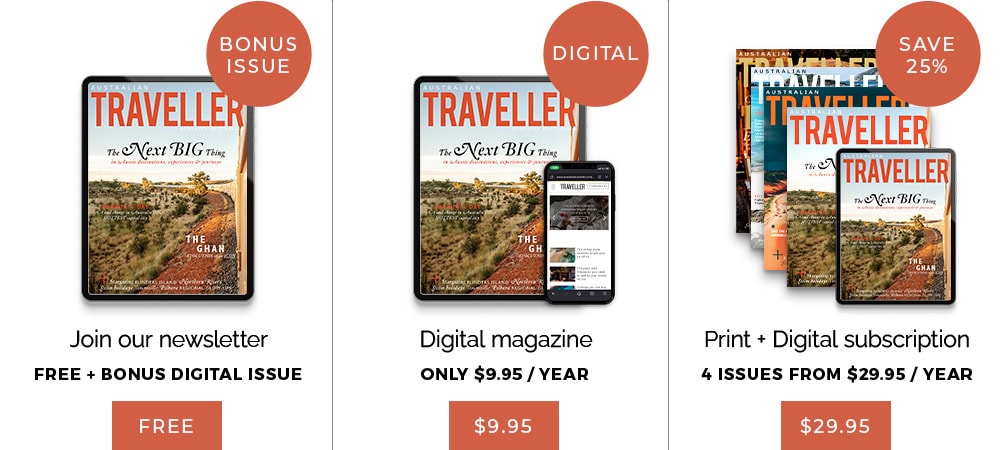
© Australian Traveller Media 2024. All rights reserved.
The Ultimate Central Australia Road Trip – The Red Centre Way
Are you thinking about doing a Central Australia Road Trip? Have you always dreamed about visiting the Red Centre, watching the sunset over Uluru or hiking Kings Canyon ? Are you interested in indigenous art and culture, or learning about the geology, plants and animals of this region?
We’ve road-tripped the Northern Territory several times in the last three years. In mid 2022 we did a budget trip in our self-converted Campervan, and in March 2023 we did a Central Australia Road Trip in a hire car, staying at some of the best accommodation in the region. Whatever style of Central Australia Road Trip you’re planning, you’ve come to the right place.
Central Australia is a vast desert region, also known as the Red Centre, due to the colour of the landscape. This region is home to the rugged mountains and gorges of the East and West MacDonnell ranges , the World Heritage Uluru-Kata Tjuta National Park , rich aboriginal culture and abundant wildlife. This is the heart of Australia!
Disclaimer : This post may contain affiliate links. If you purchase through these links, we may earn a small commission, at no extra cost to you. Purchasing through these links supports our work and allows us to continue bringing you travel guides, like this, for free. Thank you for your support.
Best time to visit Central Australia
The best time to visit the Red Centre is during the cooler winter months, between May and September. Daytime temperatures will be between 20-30 degrees, though the nights can be surprisingly chilly, as in any desert environment.
We did a Central Australia trip in July and also in March. It was definitely more comfortable in July, however, with the better weather comes more visitors. You’ll need to plan ahead if visiting in the popular months.
Getting there
You can fly to Alice Springs or Yulara (the “town” at Uluru) from any major city in Australia. If you’re planning to visit Central Australia from overseas, you’ll need to connect via Sydney, Melbourne or Cairns if you’re going straight to Ayers Rock (Yulara). There are more connections to Alice Springs, but no international flights.
There are not many (sealed) roads that lead in to the Northern Territory. The main North South Highway, the Stuart Highway, passes through Alice Springs on its way from Adelaide to Darwin.
From Sydney or Melbourne to Alice Springs you would drive to Adelaide and then join the Stuart Highway. If you’re doing a Brisbane to Alice Springs road trip the best route is via Mt Isa, into the Northern Territory and then south down the Stuart Highway. From Perth you cross the Nullarbor into SA and then head north up the Stuart Highway
Australia is a big country, and all of these drives will take you several days. Be aware if you’re checking a map, you may find a route that looks shorter, but if the road is unsealed, it may end up taking you a lot longer!
Getting around Central Australia
Central Australia is a big region with not many people around. There is very little public transport. The best way to get around Central Australia is by car – this is the ultimate Australian Road Trip.
If you’re flying into Alice Springs or Yulara, you can hire a car at the airport.
Check car availability and pricing across multiple hire companies.
If you’re not keen on driving yourself, there are plenty of Central Australia tours to choose from. You’ll find tours departing from Alice Springs or Uluru.
The Red Centre Way
The “Red Centre Way” is a series of sealed roads that connect Alice Springs to the main attractions in the area. Lasseter Highway connects Alice Springs with Yulara, and the Luritja Road goes to Kings Canyon . Larapinta Drive and Namatjira Drive head west from Alice and into the West MacDonnell Ranges (Tjoritja National Park) . All these roads are sealed and in good condition.
The Mereenie Loop
There is one section of road west of Alice Springs that sometimes catches unwary drivers out. Beware!! The Mereenie Loop is a section of the Red Centre Way road connecting the Larapinta Drive to Luritja Road.
Looking at a map, it would make perfect sense to leave from Alice, head west, and loop around to Kings Canyon via this road. However, there is almost 200km of unsealed road, which can be fine to drive, but it can also be awful.
Be warned that if you ask Google Maps to direct you from Alice Springs to Kings Canyon it will most likely direct you to go this way. Speaking to locals, we understand a lot of travellers have been caught out heading down this route completely unawares.
When we drove the Mereenie Loop in July 2022 it was pretty nasty. There were a lot of corrugations, and even more sharp, jaggedy rocks. The 200km took us around 4 hours to drive. The key when driving this sort of road is to let your tyres down and find a speed that will allow you to glide over the bumps and corrugations.
However, the scenery along this road is special, and if you’re lucky, you’ll see wild brumbies, donkeys and maybe even camels. We saw ONE donkey only. (We often joke that NAS doesn’t stand for Nigel And Sue, it stands for “No Animals Seen”)
You will require a pass to drive along the Mereenie Loop. You can purchase your permit in Alice Springs at the Visitor Centre, Kings Canyon Resort or the Hermannsburg General Store. The pass costs $5 and is valid for 3 days.
In short, if you have a capable 4wd vehicle, the Mereenie Loop is an adventurous addition to your Red Centre Road Trip.
Where to Stay on a Central Australia Road Trip
There is accommodation for all budgets in Central Australia, from campsites and caravan parks, to hostels and simple motels, right up to luxury five-star resorts. In many of the popular spots, unique accommodation is provided, like the beautiful luxury Safari Tents at Kings Canyon.
There are National Park campsites available in both the East MacDonnell Ranges, and the West MacDonnell Ranges (Tjoritja National Park), otherwise known as the West Macs. These sites can be booked online at Parks NT . There is little internet coverage outside of Alice Springs or Yulara, so it’s worthwhile booking before you go.
We did some Free Camping in the West MacDonnell Ranges. Much of the “empty” land is Aboriginal owned and wild camping is not allowed. You can find official Free Camps on the WikiCamps App
Top things to see in Central Australia
Alice springs.
Alice Spring s (or “The Alice” as its affectionately known) is the gateway to the Red Centre. While a lot of visitors come to the Alice and leave quickly to go check out the more popular sights, the town certainly has a few must-see attractions itself.
It’s also the only place with any half-decent shops for well over a thousand kilometres. If you’re on a long road trip, this will be a great place to re-stock your provisions, or get any repairs done to your vehicle. We had tyres repaired here, we also picked up some electronic computer/camera equipment we needed.
West MacDonnell Ranges – Tjoritja National Park
The West Macs are not high in stature, but loom large over the vast red landscape of Central Australia. A rugged mountain range with an interesting geological story, cut by deep gorges and refreshing waterholes. Home to ancient plant species and animals. The West Macs has some of the best hiking in Central Australia, including the 200 odd km long Larapinta Trail.
Some of our favourite spots to visit include:
Simpson’s Gap Standley Chasm Ellery Creek Big Hole Ormiston Gorge Ochre Pits Serpentine Gorge Redbank Gorge
Read our full West MacDonnell Ranges Itinerary recommendations HERE .
Check out our West Macs video HERE
East MacDonnell Ranges
The East MacDonnell Ranges are way less visited than the West Macs, and we’re really not sure why. We spent a week exploring this area in 2022 and loved it!
Some of our highlights of the East MacDonnell Ranges include:
Corroboree Rock – a culturally significant area for aboriginal men, and an important meeting place. To the uninitiated it is stunning as a geological marvel, a strange rocky outcrop with several holes through it.
Trephina Gorge – known for its laid back bush campsite and incredible hikes.
N’dhala Gorge – one of the best collections of Petroglyphs (ancient rock carvings) we have seen anywhere – the entire place is like a vast open air museum.
Find out more in our Complete Guide to the East MacDonnell Ranges
You can check out our East Macs adventures on our Video Guide HERE
Kings Canyon (Watarrka National Park)
Don’t be surprised if Kings Canyon ends up being your favourite place in the Red Centre. The Kings Canyon Rim hike is one of our favourite hikes in the country.
The majestic red cliffs of Kings Canyon have to be seen to be believed. The walls of the canyon tower 100m above the creek below and were formed over 400 million years ago. The red colour of the cliffs is actually just a sandy coating – the Mereenie Sandstone itself is actually white. You can see the white stone in several places where parts of the soft sandstone has broken off. We were fascinated by the layering of the stone.
The Kings Canyon Rim hike is around 6km and will take you 3-5 hours, depending on how many photo stops you take! There are a couple of optional detours you can take, one to Cotterill’s Lookout which is where you’ll find the best views down the canyon. The other is to the Garden of Eden, where you’ll find a permanent waterhole and several species of rare plants. This waterhole is sacred to the local indigenous people so swimming is forbidden. You may however, splash your face with water if you’re feeling hot.
If you’re not feeling up to the full Rim Walk, there are several shorter hikes which also allow you to get up close to the Canyon.
Uluru-Kata Tjuta National Park
The imposing image of Uluṟu (Ayers Rock) is one of the quintessential images of Australia. What we weren’t prepared for was the feeling, the energy of this place. It really is a special spiritual place.
Watching Uluṟu change colours at sunrise or sunset is a special experience. You will find designated car parks for sunrise and sunset. Be aware that the sunset viewing car park fills up very quickly so we advise getting there early to snag your spot. Set up your camp chairs or a picnic blanket, grab your wine and snacks, and enjoy the show.
During the day there is plenty to see and do around Uluṟu , from hiking around the base of the rock, to indigenous tours and workshops, even helicopter flights.
We do recommend spending a few days at Uluṟu. Also make your way out to Kata-Tjuṯa (The Olgas) to experience some of the beautiful hikes out there.
You can read our guide to the Best things to do in Uluru HERE
For our full run-down on Uluṟu-Kata Tjuṯa, check out our video guide HERE
Suggested Central Australia Road Trip Itinerary
This Central Australia itinerary starts and finishes in Alice Springs, so it’s good if you’re flying in and hiring a car, or if you’re arriving with your own vehicle. You could start and finish this itinerary in Uluru, just change the days around.
Day 1 Arrive Alice Springs
Check out the town, stock up on provisions, and maybe watch the sunset from Anzac Hill.
Another evening option is the Kangaroo Sanctuary (only operates on certain days) where you can cuddle a joey and learn about the important work done to rescue orphaned joeys (baby kangaroos).
Look for Alice Springs accommodation and check availability HERE
Day 2 Alice Springs
Another day to spend in the Alice, check out the Botanic Gardens (have a coffee at the Bean Tree Café) and look for a Euro (wallaby). Perhaps check out the Old Telegraph Station or the Arukuleun Arts Centre. We can definitely recommend the Alice Springs Brewing Company for a cold beer and hot pizza for dinner. If you’re staying at one of the main caravan parks just out of town, the brewery is only a short walk away.
Day 3 West MacDonnell Ranges
Leave early for a full day of checking out the Gorges and Waterholes in the West Macs . This is a beautiful drive as you follow the ridgelines along. It’s pretty much a straight road out to the West Macs with only ONE turnoff. At the Y Junction, turn right. The left road takes you to Hermannsburg and Palm Valley .
If you’re camping there are a number of places for camping in the West MacDonnell Ranges, from free camps to National Park campsites (book online in advance). The Glen Helen Resort, which offered cabins and campsites, has been closed for a while due to a lack of water supply.
Day 4 Drive to Kings Canyon
There are two ways to get to Kings Canyon from the West Macs. The easy but longer route is back via Alice Springs on the sealed road, then down the Stuart Highway to Erldunda Roudhouse, then along the Lasseter Highway and Luritja Drive.
Alternatively, if you’ve stayed somewhere in the West Macs and have a 4wd, you can consider driving the “Mereenie Loop” which includes a 200km unsealed section. You will need a permit to drive this road, in 2022 this cost us $6. The permit is available in Alice Springs, Hermannsburg or Kings Canyon.
There is a free camp about 25km before the Kings Canyon Resort along this dirt road called Ginty’s Lookout. You will find a variety of accommodation from Campsites, to Cabins and luxury Glamping Tents at the Discovery Kings Canyon Resort . There is also accommodation available at Kings Creek Station .
Another alternative route from Alice Springs to Kings Canyon is via the Ernest Giles Road. Looking at a map it seems the obvious choice however, this road is unsealed and can be very corrugated. What you save in kilometres, you may not save in time.
Day 5 Kings Canyon
Spend a full day exploring the natural wonder of Kings Canyon . The Kings Canyon Rim Hike is one of our favourite hikes in Australia. We did this hike twice when we visited in July 2022, and again when we visited in March 2023. The route closes at 9am on days where the temperature is forecast to be above 36 degrees Celsius. When we visited in March the forecast was for 38 degrees so we decided to do the hike for sunrise. This was the best decision and we highly recommend it.
In the afternoon drive down to the Karrke Aboriginal Experience, one of the best tours we have done anywhere, and a great introduction to Indigenous culture and how these people lived off the land for millennia.
Day 6 Kings Canyon to Uluru (Yulara)
If you’re feeling energetic, get up early again and hike up the King’s Canyon South Wall for sunrise before driving to Uluru . We actually thought the sunrise was even better from this side of the canyon.
The drive from Kings Canyon to Yulara passes through more desert and sand dune country. You’ll drive along the Luritja Drive for 125km until you meet the Lasseter Highway again. Shortly after turning onto the Lasseter Highway, you may think you have spotted Uluru, but this will be Atila, Mount Conner, also known as Fool-uru. (Don’t worry, you won’t be the first to be fooled. Both Nigel and I were fooled the first time we saw this odd shaped “mountain”)
The only place to stop for food and fuel along this drive is at Curtin Springs. I can report their veggie burgers with chips are absolutely delicious! The views of Mount Conner are pretty good from here too.
Arriving at Yulara (the town at Uluru) is almost surreal. It’s like an oasis in the desert, and the huge monolith looms overhead, beckoning you to come closer for a look.
Yulara is centred around the Ayers Rock Resort. There is a variety of accommodation here, from 5 star resorts to a campground. There are several places to eat, art galleries, tourist information, even an IGA supermarket.
Check Hotel availability and pricing HERE
Day 7 – 8 Uluru
We strongly believe every Australian should visit Uluru at least once in their lifetime. It really feels like the spiritual heart of Australia. There is actually a lot to do here, both once-in-a-lifetime tours (that can be expensive) and plenty of free activities too.
Here’s some of our favourites:
Sunset at the Uluru Sunset viewing area (free) Ranger-led Mala Walk (free) Valley of the Winds hike (free) Mutijulu Waterhole (free) Sunrise at the Kata Tjuta dune viewing platform (free) Walk/cycle around Uluru (free – or can hire bikes) Maruku Dot Art workshop Sunset Helicopter flight Field of Light Sounds of Silence Dinner
Check out the full list of our favourite Things to do in Uluru .
Day 9 Yulara to Alice Springs
The drive from Uluru to Alice Springs passes back along the Lasseter Highway to Ghan (Erldunda Roadhouse) and then heads north back to Alice Springs. There’s a possible side trip to Rainbow Valley along this journey although that is down 40km of unsealed road. Check the road conditions before you depart.
Watch our Central Australia Road Trip video
Click HERE to watch our latest (2023) Central Australia Road Trip video on YouTube. You can also watch our Central Australia Vanlife video series from 2022 HERE
Top Tips for a Central Australia Road Trip
What to pack for the red centre.
Pack plenty of cool comfortable clothes. The outback is very casual, and even at the Sounds of Silence dinner at Uluru, people were dressed in smart casual. You’ll need a good pair of walking shoes if you’re planning to do some of the many hikes available in the area.
Take a wide-brimmed hat and a fly net! Even in the cooler months, there can be a lot of flies around.
Driving distances in the Red Centre
The distances between fuel stops are a lot longer than you might be used to, and fuel at some of the road-houses is very expensive. The most we paid was $2.89/l for diesel. Make sure you leave Alice Springs with a full fuel tank!
Installing a Fuel finder App might be helpful, but remember to check it while you are still in range (see below on Mobile phone coverage )
Food and water in the Red Centre
The variety is available food is good in Alice Springs, and you can get almost anything in the supermarkets. However, once you leave the Alice, the variety of food choices goes down, and the prices go up! If you are vegetarian, vegan or on a limited diet, you may struggle (or eat a lot of hot chips!)
We learned to always have plenty of snacks in the car, fruit, nuts, chips etc.
Make sure you carry plenty of water. It’s a very dry environment and you will get dehydrated even in cooler weather.
Mobile phone coverage in Central Australia
Outside of Alice Springs and Yulara, mobile phone coverage is very limited. You might find a few bars of 3G around the roadhouses, but in peak times the towers struggle to keep up. Kings Canyon Resort is particularly bad, however, the service at the actual canyon carpark was much better.
In the West Macs you’ll find a couple of booster dishes where you can stand and supposedly get a better signal. This might be strong enough for calls, SMS and emails, but not really for browsing or social media.
We both have Telstra phones, and we did hear from some other travellers that they got better reception in Optus in some places.
How many days do you need for a Central Australia Road Trip?
While it would be possible to see the Red Centre in a week, we recommend spending at least 10 days driving the Red Centre Way. The distances are probably longer than you think, and there is a lot to see.
Do you need a 4wd for the Red Centre?
It is possible to visit all the main attractions in Central Australia with a 2wd vehicle. There are sealed roads from Alice Springs to the West MacDonnell Ranges, Kings Canyon and Uluṟu. You will require a 4wd vehicle if you wish to drive on the Mereenie Loop or to visit Palm Valley and some of the other side attractions
How many days do you need at Uluṟu?
We recommend spending at least three nights at Uluṟu, which will allow you plenty of time to see the sunrise and sunset from the various viewing spots, as well as exploring the area and learning about the fascinating culture.
Do you need a pass to visit Uluṟu-Kata Tjuṯa National Park?
Yes, you will need to purchase a pass to visit the park. The pass costs $38 for 3 days, and you can extend the pass free of charge at the entry gate. Passes are available online or at the entry station. We purchased our pass online, and saved it to the Wallet on our iPhone. Your pass will be checked, as there is an entry barrier to get into the park.
What time does Uluṟu-Kata Tjuṯa National Park open?
The opening time of the park depends on the sunrise time. Be sure to check the time with your accommodation or the visitors centre. We made the mistake of turning up too early and had to wait at the gate for around 30 minutes! (We weren’t alone)
Do I need a pass to visit NT National Parks?
Since 3 April 2023, a valid permit is required to visit the National Parks in the Northern Territory. This pass costs $10 per day, $30 for 2 weeks, or $60 for an annual pass. You can purchase your pass online at the Park Bookings website. NOTE: Uluṟu-Kata Tjuṯa National Park is a federal park, and a separate entry permit applies for this park.
Looking for hidden gems?
If you liked the West MacDonnell Ranges but would prefer less people, check out the East MacDonnell ranges for great hikes, and a beautiful peaceful campsite.
If you have a high-range 4×4 vehicle, don’t miss Palm Valley in the Finke Gorge National Park – this was one of our favourite places in all of Central Australia.
Leave a Comment Cancel reply
Save my name, email, and website in this browser for the next time I comment.
Pre-summer sale! Plan your summer East Coast Australia trip today and save up to $500 – Offer ends soon!

- Cairns & Surrounds
- The Whitsundays
- K'gari (Fraser) Island
- Uluru & Outback
- Darwin & Top End
- Magnetic Island
- South Australia
- North Island
- South Island
- Milford Sound & Fiordland
- South Korea
- Bali & Lombok
- Komodo Islands
- East Coast Packages
- Campervans & Car Rentals
- Greyhound Bus Passes
- Fraser Island 4×4 Tours
- Whitsundays Tours
- Great Barrier Reef
- Wildlife Experiences
- Scuba Diving
- Learn to Surf
- Bungy Jumping
- Uluru & Outback Tours
- Food & Wine Tours
- East Coast Group Tours
- Cultural Experiences
- Snow Sports
- Scenic Flights
- Campervan & Car Hire
- Bungy & Swings
- Jet Boat Tours
- Adventure Combos
- Scenic Day Tours & National Parks
- 21 Day East Coast Package
- 32 Day East Coast Package
- 35 Day Cairns to Melbourne Package
- 14 Day East Coast Express Package
- 17 Day Sydney to Cairns Package
- Fraser Islands & Whitsundays Combo
- Australia Package Builder
- Travel Buddies 32 Day Sydney to Cairns Group Tour
- Travel Buddies 32 Day Cairns to Sydney Group Tour
- 10 Day Adelaide to Perth Adventure
- 10 Day Broome to Darwin Adventure
- Ultimate 10 Day Tasmania Tour
- 6 Day Perth to Exmouth Coral coaster
- Queenstown Combos
- Ski & Snowboard Packages
- Build Your Own Package
- Phillipines
- 7 Day Coconut Cruiser
- 8 Day Yasawa Island Wanderer
- 12 Day Fiji Explorer Package
- 5 Day Island Adventurer Package
- Bula Island Hopper Pass
- Fiji Custom Package Builder
- Build an East Coast Package
- Build an Australia Package
- Build a New Zealand Package
- Build a Fiji Package
- Build an Indonesia Package
- Build a Thailand Package
- Build a Vietnam Package
- Build a Philippines Package
- Work for us
- Travel Blog
- Collaborate
- Work in Australia
1300 HAPPYTRAVELS (+61) 2 5633 1149
Quick Links
- K’Gari Fraser Island
- Whitsunday Islands
- Campervan and Car Hire
- Destination
- Hints & Tips
Top 5 Things To Do In The Red Centre
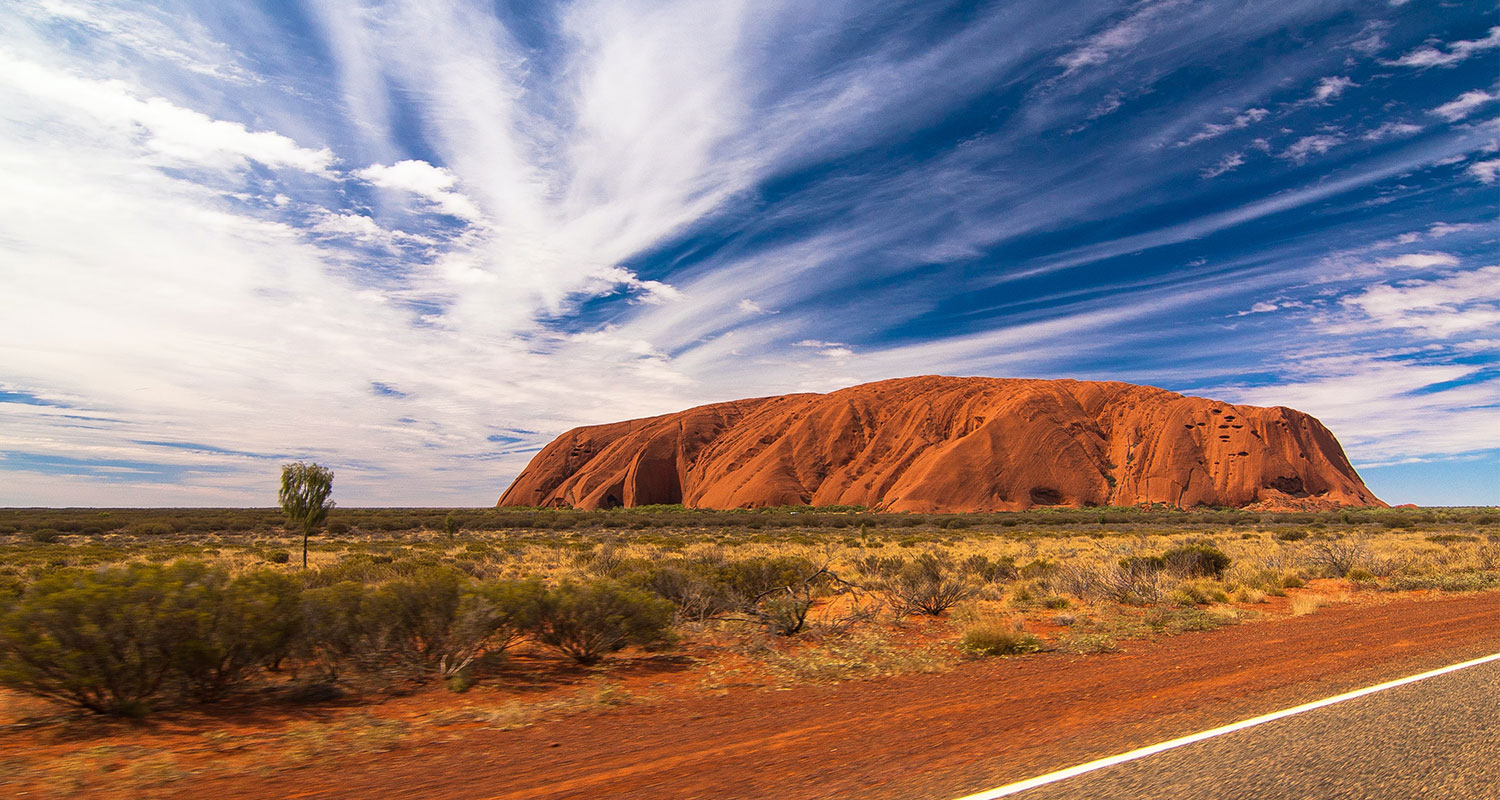
O ut of all the destinations Australia has to offer, there are few as iconic and unique as the Red Centre. With its unmistakable landscape, the Aussie outback is pretty magical and if you’re looking to explore some of the “real” Australia, it doesn’t get much better than that! To help inspire you to stray from the East Coast and discover another side of Oz, here’s our five favourite things to do in the Red Centre…
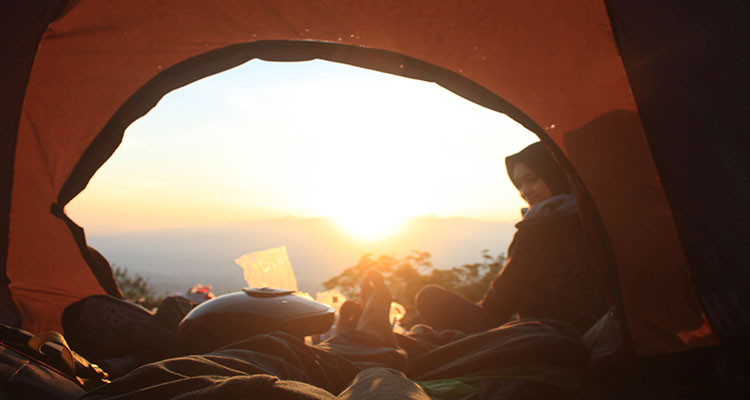
1. Sleep In A Swag
There’s no better way to experience life in the outback than in a traditional swag. A cross between a tent and a sleeping bag, these simple yet incredibly comfortable structures are the perfect place to tuck yourself in next to a roaring campfire and gaze into the magnificent star scape as you fall asleep. It certainly beats a noisy hostel dorm, that’s for sure!
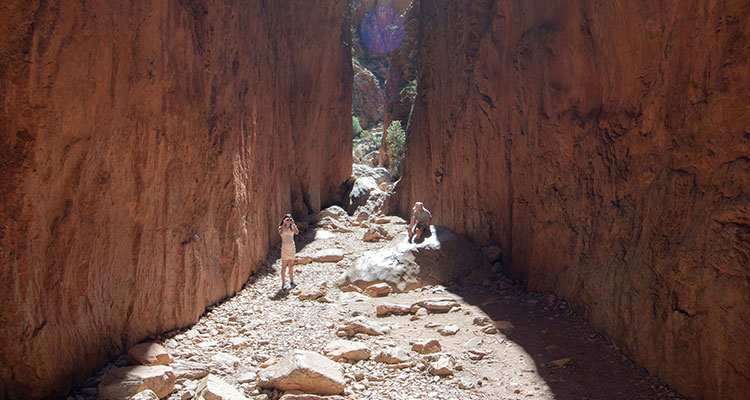
2. Hike The West MacDonnell Ranges
If getting off the beaten track is your thing, then a visit to the West MacDonnell Ranges is a must for your trip, as this untapped destination is only visited by about 15% of people who head to the Red Centre !
With the rare opportunity to swim in the desert at spectacular spots like Ellery Creek Big Hole and a chance to visit the Ochre Pits to discover the source of many Aboriginal Rock Paintings, this alternative landscape is one not to be missed.

3. Learn More From The Locals
The Red Centre is of huge importance to the Aboriginal community of Australia and learning more about the cultural significance of the area will give you a deeper understanding of why this place is so unique.
A glimpse into the dream time stories and lifestyle of the custodians of the land is something that will change your perspective of why Australia is such an incredible country.
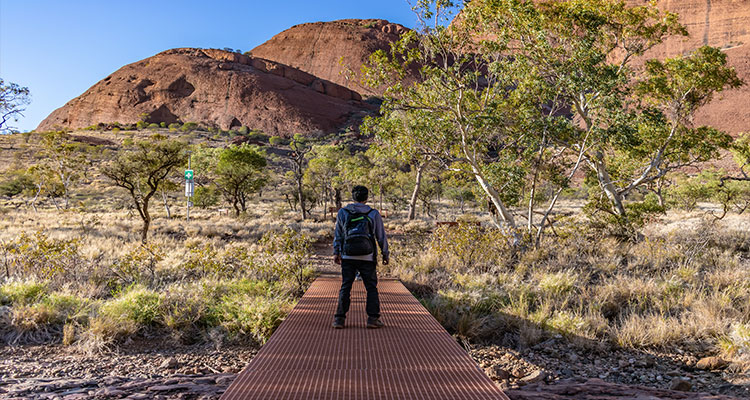
4. Explore The Valley Of The Winds
Often described as the most spectacular hike in the Red Centre , the Katajuta Hike boasts gigantic cliff faces, stunning scenery, and ‘other world’ style landscapes.
If you’re looking for an epic Instagram shot, this is certainly the place to head, but be prepared for some extreme heat, and pack plenty of water for the trek!
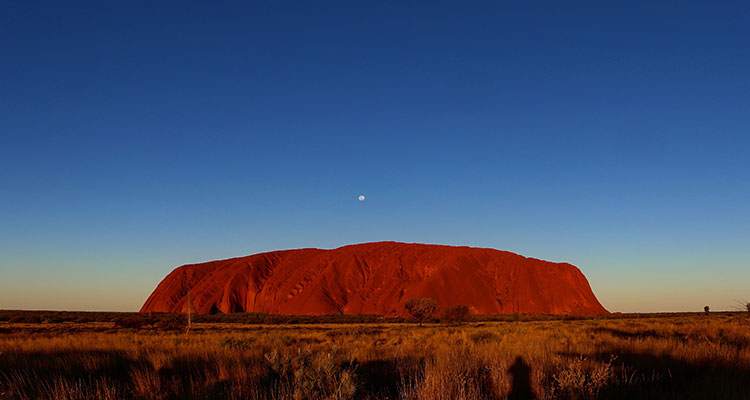
5. Sunrise/Sunset Over Uluru
No visit to the Red Centre is complete without marvelling at the natural wonder that is Uluru! It’s a tough call between whether sunrise or sunset is the best time to check out this incredible spot, but why choose when you can do both?!
Watch as the colours of the rock fade between bright oranges and reds to violets and dark silhouettes, a truly incredible experience no matter how well travelled you are. But whatever you do, respect the heritage and cultural significance of the Red Centre and DON’T climb Uluru.
Dive in and get inspired by our latest travel blogs
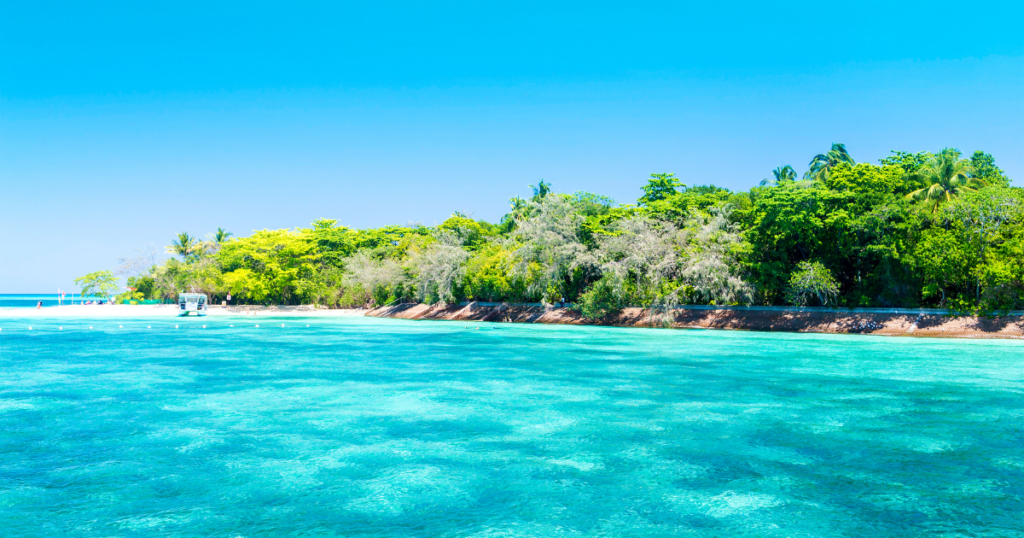
The Top 10 Tours and Activities in Cairns
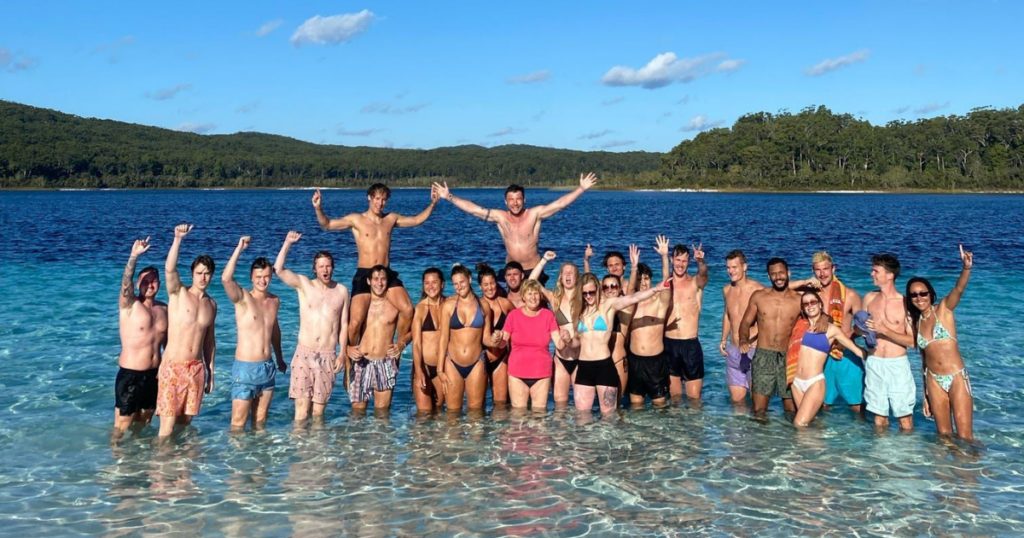
Essential Aussie Packing List: What to Pack to Go Down Under

Ultimate 2024 East Coast Travel Guide
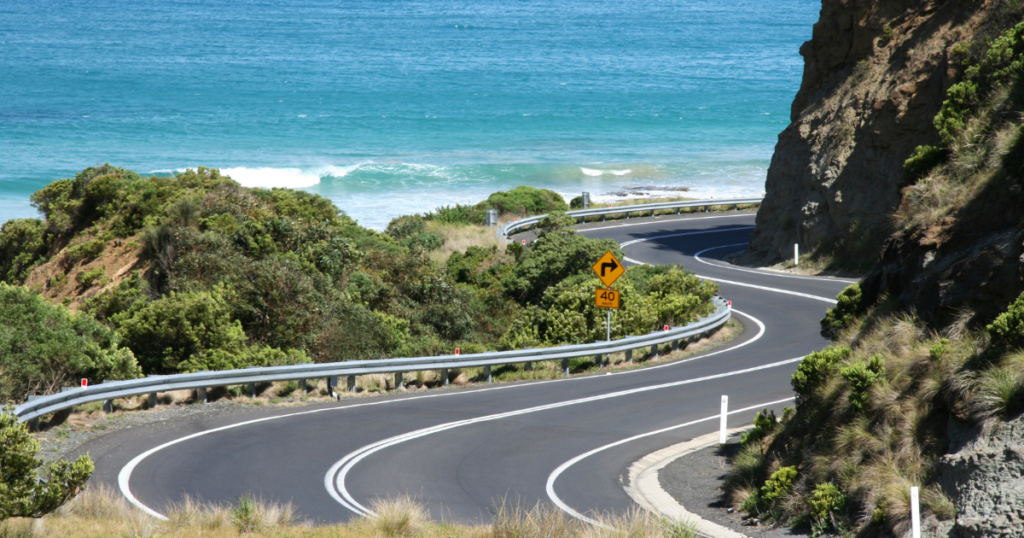
Greyhound Bus Travel in Australia: Everything You Need To Know
Find your perfect travel destination!
Travelmyne is a unique and free search engine for travel destinations, which is able to find the ideal travel destination for you on the basis of over 100,000 data sets from hundreds of travel regions from all over the world!
- Continent Australia >
- Australia >
- Northern Territory >
Travel Offers
Travelmyne featureprint, red centre - the red heart of australia.
The Red Centre is known for its vast red desert landscapes, impressive mountain ranges as well as unique granite and sandstone rocks such as the famous Ayers Rock. Together with the culture of the aborigines, a trip to the Red Centre is the perfect outback adventure.
Geography - The red semi-desert in Central Australia
The Red Centre is a semi-desert in the centre of Australia in the outback of the Northern Territory . It has an area of almost one million km² and accommodates the most significant landmark of the Australian continent, the inselberg Uluru or Ayers Rock (350 m). Other natural wonders and popular destinations are the rock formation of the Kata Tjuta , the MacDonnel Ranges and the King Canyon . The central location and starting point for many expeditions is the town of Alice Springs . The dry climate in the Red Centre is accompanied by hot temperatures and low humidity throughout the year. In winter, temperatures can sink to freezing point at night.
Nature - Numerous tufts of grass, dry soil and impressive granite rocks
The typical landscape in Central Australia is characterised by great sand dunes , vast plains , deep gorges and impressive rocks . The read soil in the region is relatively dry and low in nutrients . Nevertheless, it is vegetated by small shrubs and trees, a few flowers and numerous tufts of grass . Some stretches of land are completely covered in the true grasses of the Spinifex . The semi-desert's fauna consists of kangaroos, emus, birds of prey and reptiles like the thorny devil . You can watch these animals in the Alice Springs Desert Park , for example. Another part of the local (but not native) fauna are the camels . The hoofed animals were imported as working animals by the British in the 19th century and reproduce plentifully because they have no natural enemies on the continent. Unique freaks of nature in the Red Centre are the Uluru and the Kata Tjuta , the Kings Canyon , the MacDonnell Ranges and the granite rocks of the Devil's Marbles (Karlu Karlu). The Uluru-Kata Tjuta National Park , the Uluru (Ayers Rock) and the rock formation of the Kata Tjuta (Mount Olga) have been part of the UNESCO World Natural Heritage since 1994. The Kings Canyon in the Watarrka National Park impresses with harsh, red walls of rock , deep gorges and cliffs as well as with clefts which are overgrown with palms . Several waterholes cause relatively high humidity and a distinct fauna and flora in the deep abysses and the otherwise dry nature of the Red Centre .
Culture - The sanctuaries of the aborigines
The Red Centre was already settled by Australia's native inhabitants thousands of years ago. They still maintain their traditions and customs in reserves which were built for them, including protected sights and sanctuaries , which are of great importance to the aborigines and their faith. Trespassing is strictly forbidden and may be punished with high fines. However, there are a few sites which are open to the public and can be explored, for example on a guided tour. The Ayers Rock , called "Uluru" in the language of the Anangus, is over 500 million years old and due to its unique cultural significance, it is part of both the World Natural Heritage and the World Cultural Heritage of the UNESCO. There are several legends of the rock, which is three kilometres long, two kilometres wide and crossed by furrows, which try to explain its present-day shape (the Uluru myths ), for example. Several caves at the Ayers Rock accommodate rock paintings which tell of these and other myths. Other famous sacred places of Australia's native inhabitants are the rock formation of Devil's Marbles (Karlu Karlu) and Mount Olga ( Kata Tjuta , meaning "many heads"). Like the Ayers Rock, they are part of the aborigines' history of creation and therefore important spiritual and ceremonial places .
Experience - Experiencing the magic of the outback on a camel ride
The Red Centre and its unique, harsh landscape can be explored in many ways. During a flight with a hot-air balloon , a helicopter ride , a tour with a cross-country vehicle or a camel ride , travellers experience the magic of the desert-like Red Centre at first hand. Many visitors consider the spectacular play of colours on the granite rocks, especially on the Uluru, at sunrise and sunset , a particularly impressive experience. Depending on the altitude of the sun, the cloud conditions and the lighting, the sacred mountain assumes a brown, orange or bright red colour. A popular starting point for expeditions is the town of Alice Springs . It has an area of 148 km² and is considered the gateway to an adventure into the red heart of Australia . Cafes, bars, restaurants and shops with names like "aboriginal", "outback" or "bush", reptile exhibitions and markets (Todd Mall Market) with art objects and articles of daily use made by the aborigines invite holidaymakers to spend money and put travellers in the right mood for a trip into the Australian outback.
Activities - Outback adventures
Cycling and motorcycling tours on the Red Centre Way and hikes in the natural landscape are popular ways of exploring the Australian outback. The Kings Canyon in the Watarrka National Park and the Uluru in the Uluru-Kata Tjuta National Park are excellent hiking destinations. During a hike along the Kings Canyon Rim Walk or the Kings Creek Walk , you see impressive gorges, refreshing waterholes like the Garden of Eden and unique rock formations such as the Lost City . The Liru Walk , the Uluru Base Walk and the Mala Walk go along the famous Ayers Rock. The Uluru Climb , which is 1.6 kilometres long, leads up to the top of the i nselberg. This path, however, is a little dangerous and the aborigines do not like to see tourists climb their sacred site.
Information
The best time for travelling the Red Centre are autumn and spring . Warmer days, cooler nights and little temperature fluctuations are common during these seasons. The summer months (December to February), on the other hand, can be very hot , which is why hikes can become very demanding during this time. Holidaymakers who want to experience the region in summer should definitely bring a hat and sun protection . Travellers usually arrive at the airport in Alice Springs but only national flights arrive here. Tourists from abroad can arrive at the airport in Darwin . From there, you can continue your journey by plane, train, bus or in a rental car. The distance between Darwin and Alice Springs is 1,498 km.
The Red Centre is an extraordinary travel destination for active holidaymakers and culture enthusiasts . Camel rides, hikes and motorcycle tours through the red desert landscape constitute a unique outback adventure , while the impressive cultural and natural monuments in the region take you into the culture of the aborigines .
Find your perfect destination!
User rating.

Australia Recommends 2024

Travel Inspiration

G'day, the short film

Discover your Australia

Travel videos

Deals and offers

Australian Capital Territory

New South Wales

Northern Territory

South Australia

Western Australia

External Territories

The Whitsundays

Mornington Peninsula

Port Douglas

Ningaloo Reef

Airlie Beach

Kangaroo Island

Rottnest Island

Hamilton Island

Lord Howe Island

Tiwi Islands

Phillip Island

Bruny Island

Margaret River

Barossa Valley

The Grampians

Hunter Valley

McLaren Vale

Glass House Mountains

Alice Springs

Uluru and Kata Tjuta

The Kimberley

Flinders Ranges

Kakadu National Park

Eyre Peninsula

Karijini National Park

Great Barrier Reef

Blue Mountains

Daintree Rainforest

Great Ocean Road

Purnululu National Park

Cradle Mountain-Lake St Clair National Park

Litchfield National Park

Aboriginal experiences

Arts and culture

Festivals and events

Food and drink

Adventure and sports

Walks and hikes

Road trips and drives

Beaches and islands

Nature and national parks

Eco-friendly travel

Health and wellness

Family travel

Family destinations

Family road trips

Backpacking

Work and holiday

Beginner's guide

Accessible travel

Planning tips
Trip planner

Australian budget guide

Itinerary planner

Find a travel agent

Find accommodation

Find transport

Visitor information centres
Deals and travel packages

Visa and entry requirements FAQ

COVID-19 travel and entry advice

Customs and biosecurity

Working Holiday Maker visas

Facts about Australia

Experiences that will make you feel like an Aussie

People and culture

Health and safety FAQ

Cities, states & territories

Iconic places and attractions

When is the best time to visit Australia?

Seasonal travel

Events and festivals

School holidays

Public holidays
How to get to Australia's most iconic cities

How long do I need for my trip to Australia?

How to travel around Australia

Guide to driving in Australia

How to hire a car or campervan

How to plan a family road trip

How to plan an outback road trip

Uluru-Kata Tjuta National Park, Northern Territory
Guide to the Red Centre
- Share Share on Facebook Share on Messenger Share on Twitter Share on WhatsApp Copy Link
- Getting to the Red Centre
- When to visit
Experience Aboriginal culture, desert adventures and the changing colours of Ulu r u in Australia's Red Centre.
The Red Centre is an extraordinary landscape of desert plains, weathered mountain ranges, rocky gorges and some of Aboriginal Australia's most sacred sites, including Ulu r u and Kata Tjuṯa. Floating in an outback waterhole, dining under a starry sky while being serenaded by didgeridoo, and watching the world's most famous rock change colours at dawn and dusk are just some of the Red Centre's only-in-Australia experiences.
Flying is the quickest and easiest way to get to the Red Centre, with two airports servicing domestic flights. It takes approximately three hours to fly to either airport from Australia's eastern and western cities.
- Alice Springs Airport (ASP), located 14km (9mi) outside of Alice Springs town centre.
- Ayers Rock Airport (AYQ), located 8km (5mi) outside of Yulara (the nearest town to Ulu r u).
- Both airports offer car hire, transfer, and taxi services.
- Ayers Rock Resort offers a complimentary airport shuttle service to your accommodation within Yulara.
Enjoy your journey to The Red Centre by adding it to your Australian road trip, or board the Ghan for a cross-country train ride, stopping at small towns from Adelaide, through the Red Centre, to Darwin.
Due to the central location of the region, the climate can be extreme. During winter, days are warm but nights can get very cold, so pack layers. Summer brings soaring temperatures, so always pack sunscreen, a hat and sunglasses. A trip to the Red Centre during shoulder seasons will provide the most moderate temperatures.
- High season: Winter (June to August)
- Low season: Summer (December to February)
- Don’t miss: The Field of Light (Open year round)
Things to do in the Red Centre
Destinations in the red centre.

Kings Canyon
Trips and itineraries.

7-day road trip on the Red Centre Way

10 days of Aboriginal experiences

Waterhole hopping in the Northern Territory

4-day family holiday in and around Uluru
Travellers' stories.

Planning your trip to Australia?
Get expert help from an aussie specialist who has the knowledge and experience to help you plan and book every detail of your trip., featured articles.

We use cookies on this site to enhance your user experience. Find out more . By clicking any link on this page you are giving your consent for us to set cookies.
Acknowledgement of Country

We acknowledge the Traditional Aboriginal and Torres Strait Islander Owners of the land, sea and waters of the Australian continent, and recognise their custodianship of culture and Country for over 60,000 years.
- New Zealand (English)
- United States (English)
- Canada (English)
- United Kingdom (English)
- India (English)
- Malaysia (English)
- Singapore (English)
- Indonesia (Bahasa Indonesia)
- Deutschland (Deutsch)
- France (Français)
- Italia (Italiano)
- 中国大陆 (简体中文)
*Product Disclaimer: Tourism Australia is not the owner, operator, advertiser or promoter of the listed products and services. Information on listed products and services, including Covid-safe accreditations, are provided by the third-party operator on their website or as published on Australian Tourism Data Warehouse where applicable. Rates are indicative based on the minimum and maximum available prices of products and services. Please visit the operator’s website for further information. All prices quoted are in Australian dollars (AUD). Tourism Australia makes no representations whatsoever about any other websites which you may access through its websites such as australia.com. Some websites which are linked to the Tourism Australia website are independent from Tourism Australia and are not under the control of Tourism Australia. Tourism Australia does not endorse or accept any responsibility for the use of websites which are owned or operated by third parties and makes no representation or warranty in relation to the standard, class or fitness for purpose of any services, nor does it endorse or in any respect warrant any products or services by virtue of any information, material or content linked from or to this site.
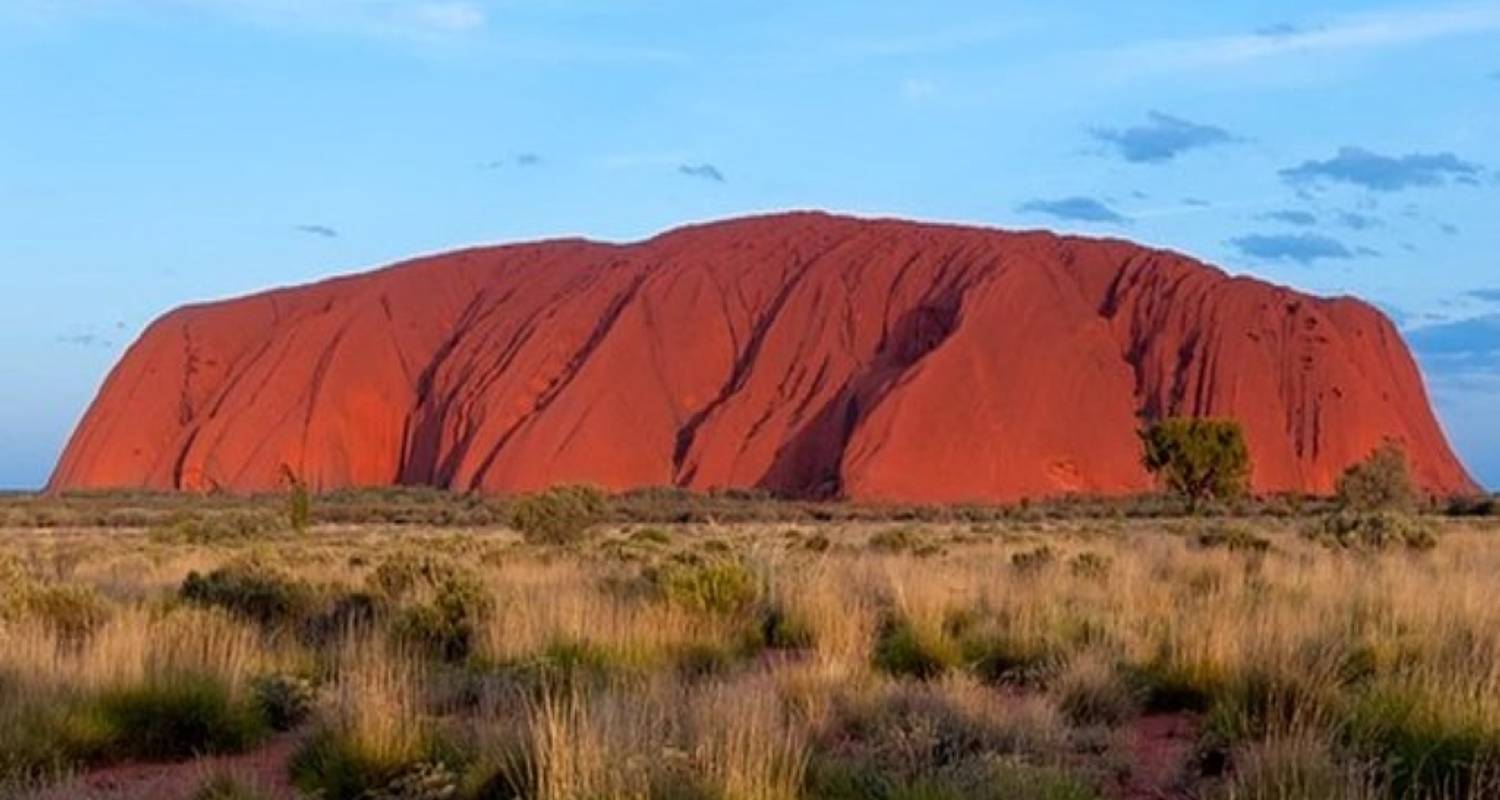
Red Centre Tours & Trips
- Choose from 50+ Red Centre tours
- 100+ verified reviews from TourRadar travelers
- 24/7 customer support
10 best Red Centre tour packages
Compiled by

Melissa Red Centre travel expert at TourRadar
Uluru & Kings Canyon Express (from Yulara to Uluru)
3 day uluru red centre kings canyon (camping) - from ayers rock, outback camping adventure (ex yulara), northern territory escape with uluru tour, upgraded uluru & kata tjuta independent adventure, australia: uluru explorer (4 days), best of uluru & kings canyon (4 destinations), 【the ghan】 territory complete 15 days package, outback camping adventure, 【alice springs】uluru ayers rock & kings canyon 8 days touring package.
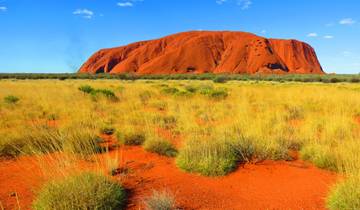
- Sightseeing
- Learn bush skills from Aboriginal guides
- Explore the domes of Kata Tjuta
- Hike around the rim of Kings Canyon
“The tour was amazing, and it was so interesting listening to the guide.” Holger Wettig, traveled in August 2023
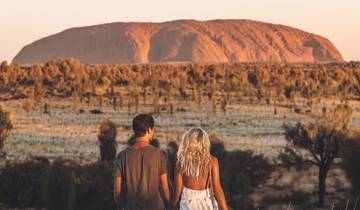
- Christmas & New Year
- Hike through Kata Tjuta's Valley of the Winds
- Experience Kings Canyon's towering cliffs
- Witness Uluru's sunset while dining outdoors
“The tour was perfect, and made the trip so special.” Elizabeth Grun, traveled in August 2022
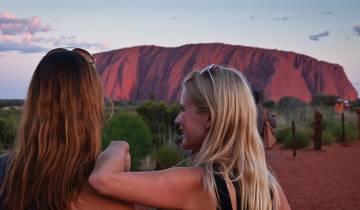
- Discover Aboriginal art at Uluru Cultural Centre
- Explore the ancient rock formations of Kata Tjuta
- Swim in the serene waters of Ellery Creek Big Hole
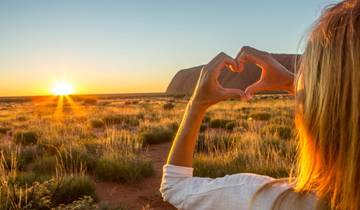
- Discover Uluru with a cultural walk and sunset BBQ
- Hike through Simpsons Gap and Standley Chasm
- Enjoy scenic drives through the West MacDonnell Ranges
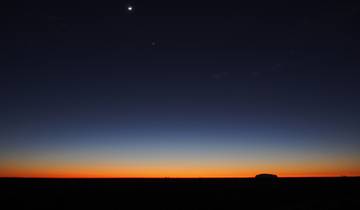
- Visit the Indigenous Cultural Centre
- Walk around Uluru with a local guide
- Catch the sunrise at Uluru
“Such a beautiful place to visit, can't wait to go back. Thanks contiki!” Courtney Johnston, traveled in March 2022

- Explore Uluru at sunrise for stunning views
- Hike through Walpa Gorge and Valley of the Winds
- Trek around King's Canyon and visit Garden of Eden
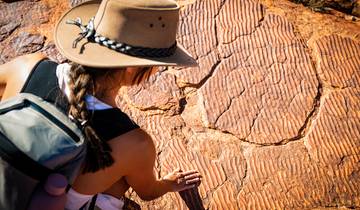
- Walking Adventure
- Learn about native traditions at the Cultural Centre
- Hike the majestic Kings Canyon rim
- Witness Uluru at sunset, a breathtaking sight
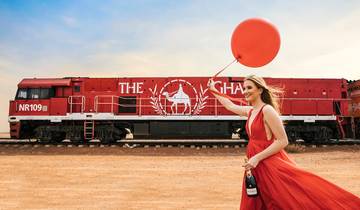
- Watch sunset and dine under Uluru's stars
- Relax with a Darwin Harbour dinner cruise
- Cruise through Kakadu's wildlife-rich waters
“We learned a lot about the fauna, the ancestors, and the communities. Great adventure.” Kathleen May Molloy, traveled in July 2024
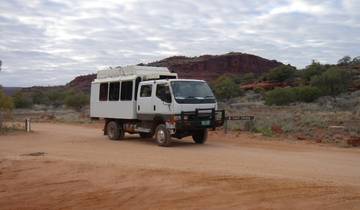
- Camp under the stars in the Outback
- Discover ancient rock paintings
- Watch the sunset at Uluru
“Enjoyed learning and having the transportation and bookings taken care of.” John Salvatore, traveled in September 2022

- Tour West MacDonnell Ranges and historic sites
- Hike Kings Canyon and visit the Garden of Eden
- Witness Uluru at sunrise and explore sacred sites
More about Red Centre
Discover TourRadar

Home » Travel Guides » United States » California (CA) » 15 Things to Do in Santa Clara (CA)
15 Things to Do in Santa Clara (CA)
Santa Clara is a city of nearly 125,000 residents that’s located in Santa Clara County, about 75 kilometers south of San Francisco .
The city was founded more than 200 years ago as a Spanish Mission. Now, it’s most well-known for its booming tech industry that’s commonly referred to around the world as Silicon Valley.
Though it’s common knowledge to most football fans, it’s a surprise to many to discover that the relatively small city is also the home of the National Football League’s San Francisco 49ers.
Visitors to Santa Clara have abundant activity options at their fingertips without venturing outside city limits, so staying engaged and entertained shouldn’t be an issue.
1. Levi’s Stadium

With a capacity of nearly 70,000, Levi’s Stadium on Marie P. DeBartolo Way in Santa Clara is one of the country’s premier professional football stadiums.
The 49ers play their home games here, and during the off-season, the stadium hosts a variety of annual events, including concerts featuring big names in the music industry.
Taking a family to a football game isn’t the least expensive activity option in the area, but for those who’ve never taken in a pro game, it’s an exhilarating experience that may be worth the cost.
Guided tours are also regularly available, and the bars and restaurants around the stadium are fun to visit year-round.
2. Ulistac Natural Area

Despite its large population and the overall hustle and bustle, the Bay Area features plenty of urban parks and natural areas that are convenient options for those interested in enjoying the great outdoors.
The Ulistac Natural Area is located on Lick Mill Road in Santa Clara. It is comprised of more than 40 acres that include a variety of distinct environments.
The natural area straddles the Guadalupe River and is home to an array of plants and animals that are well-suited to its riparian habitat.
A particularly popular attraction for bird watchers, it features a number of well-marked nature trails dotted with interpretive signs.
3. Santa Clara Art & Wine Festival

Californians take their art and wine seriously, and there’s no better way to combine the two than by visiting the Santa Clara Art & Wine Festival.
The event is held in the city’s Central Park and features nearly 200 vendors from across the country selling fine art and crafts, gourmet food, and a vast selection of California’s best wines.
Proceeds are donated to worthwhile causes that benefit residents in need. It all takes place in the early fall when the central California weather is perfect for outdoor activities.
Other highlights include live entertainment and lots of art-related activities for kids.
4. The de Saisset Museum
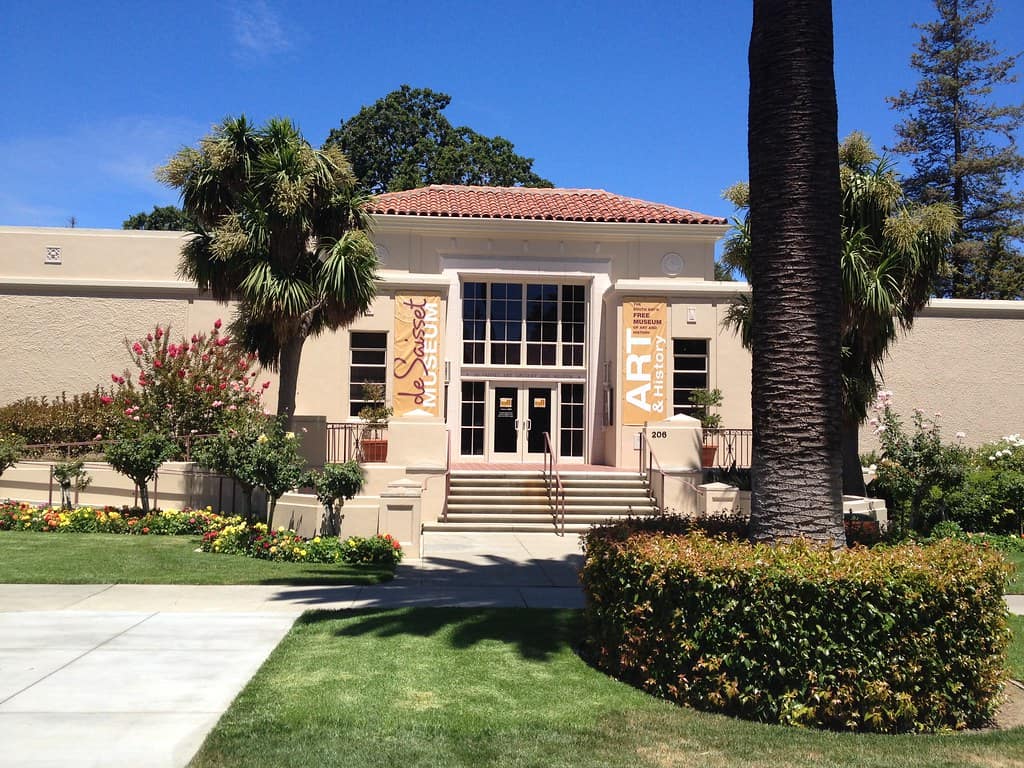
Though he’s not exactly a household name for those who don’t typically travel in West Coast art circles, Ernest de Saisset was one of the Bay Area’s most prominent artists in the 19th century.
Saisset was a French immigrant who enrolled in Santa Clara University and studied painting as a young man.
The museum that now bears his name is located on the university’s campus. It includes a collection of more than 100 of his most impressive works.
It’s as much a historical attraction as it is an art one, and it also has other works from European and American artists dating back hundreds of years.
5. Intel Museum

Intel is one of the titans of the tech world. Over the years, it has been responsible for some of the most significant technological leaps forward in computer hardware.
The Intel Museum is located on the campus of the company’s world headquarters in Santa Clara, and it’s regularly open to the public.
Even for those who don’t fall into the tech-savvy category, it’s a fascinating place that’s definitely worth an hour or two of time.
Though it may sound dry to technophobes, it’s packed with interactive exhibits for visitors of all ages, so it’s great for kids with short attention spans too.
6. Santa Clara Farmers’ Market

There’s really no better way to rub elbows with locals, enjoy pleasant weather, and have access to tons of great products you won’t find elsewhere than by visiting a farmers’ market.
The Santa Clara Farmers’ Market is open year-round and features a little bit of everything – from seasonal produce and fresh baked goods to health and body products and prepared food items.
Held on Jackson Street near the downtown area, it’s common to find different items each time you go.
Spending a few bucks is a great way to support local farmers and entrepreneurs, and don’t be shy about asking them for suggestions for things to see and do while in town.
7. California’s Great America

There’s no shortage of theme parks in the Golden State, but there’s one clear choice for those visiting Santa Clara.
California’s Great America is located on Great America Parkway just outside of town. It features tons of rides, dining options, kid’s activities, and a water park that’s a huge draw during the hot summer months.
Though Great America can really draw a crowd during peak times when kids are enjoying their summer vacations, previous guests have noted that wait times for rides weren’t overly long.
Many families choose to spend an entire day on-site to avoid wasting valuable recreational time in the car.
8. Mission Santa Clara

Mission Santa Clara is one of the city’s premier historic sites, and it’s now conveniently located on the campus of Santa Clara University.
The mission was established by Franciscans in the 1770s to spread Christianity to the area’s Native American population.
Sadly, things didn’t go according to plan; due to several natural disasters, the mission was forced to move from its original site to where it is now.
Over the years, it was also run by the Jesuits. Though it’s no longer functioning in its original role, it now doubles as a museum and chapel that are open to visitors.
9. The Triton Museum of Art

Though guests tend to visit the Triton Museum of Art for the works in its collection, its stunning contemporary architecture usually makes a big impression as well.
The museum’s collection includes works from all over the country, but its emphasis is on pieces created by Bay Area artists using local people and scenery as inspiration.
The grounds also include a sprawling outdoor sculpture garden spread over nearly seven acres, and a home from the mid-1860s that’s among the most well-preserved examples of historic American architecture in the area.
The museum is located on Warburton Avenue, and most visitors spend a few hours on-site.
10. Santa Clara Players
The Santa Clara Players traces its roots all the way back to the early ‘60s, when a group of local performers began putting on small shows for the community.
Now nearly seven decades later, they’re still going strong. Their annual performances run the gamut from dramatic theater and mystery to satire and humor.
The players are part of a community theater group staffed by talented volunteers dedicated to providing high-quality, family-friendly entertainment at a reasonable cost.
They’re located on Don Avenue in Santa Clara and offer lots of volunteer opportunities for budding actors and stagehands.
11. Central Park

Featuring lots of wide-open spaces and massive swimming and community rec centers, Santa Clara’s Central Park is a go-to destination for activity minded visitors looking to make the most of their limited vacation time without traveling to more distant attractions.
The park is centrally located on Keily Boulevard, has ample parking, and features lots of outdoor amenities and recreational activity options.
From tennis and basketball to softball, lawn bowling, and a big playground, there’s really no excuse for getting bored while on-site. For those looking to spend a relaxing afternoon, there are a lake, built-in BBQs, and public restrooms.
12. The 49ers Museum

Even for those who won’t be in Santa Clara during the regular season, the 49ers stadium and museum are fun attractions worth visiting for sports-minded visitors.
The museum is located inside Levi’s Stadium and features nearly a dozen distinct galleries that are open to the public year-round.
It’s a fun and educational experience for visitors of all ages. In addition to football, its exhibits touch on science, technology, and art in a way that engages and entertains young and old minds alike.
Most guests check out the introductory video in the visitor’s center before showing themselves through the impressive collection of trophies, balls, and Super Bowl memorabilia on display.
13. The Santa Clara Fire Museum

The Santa Clara Fire Department’s roots run all the way back to the 1850s when it was founded.
The museum is now located on Walsh Avenue in an unused training center behind the city’s new fire station.
It sports an impressive collection of equipment and historical memorabilia that give visitors unique insights into the lives of fire and rescue personnel in years past.
The museum’s highlights include a fully restored Model-T fire truck that served for two decades, beginning in the 1920s.
The knowledgeable local volunteer staff also offer regular programs geared at educating the public about fire safety and prevention issues.
14. Edward Peterman Museum of Railroad History

The Edward Peterman Museum of Railroad History is run by a local historical society. It is housed in the depot of a now-defunct railroad on Railroad Avenue in Santa Clara.
Like many local historical attractions, the museum is staffed by local volunteers who love answering questions and showing first-time visitors around.
The museum’s exhibits include a variety of railroad equipment and memorabilia, including signals, safety equipment, and historical photographs dating back over 100 years.
The museum is regularly open to the public. It maintains an extensive library of books relating to railroad development and local history as well.
15. Voyager Coffee

Though it has only been around since 2016, Voyager Coffee’s owner and staff are dedicated to the noble pursuit of making their customers happy.
They do this largely by providing world-class coffee, but also by offering a comfortable space in which guests have opportunities to build relationships with like-minded customers.
Many of their coffees sport internationally influenced flavors, and they’re often infused with things like orange essence and cherry blossom water.
Don’t worry if you prefer your coffee straight-up, because they’ve got more traditional brews as well.
They offer fresh pastry and baked goods, tea, and other non-coffee drinks too.
15 Things to Do in Santa Clara (CA):
- Levi's Stadium
- Ulistac Natural Area
- Santa Clara Art & Wine Festival
- The de Saisset Museum
- Intel Museum
- Santa Clara Farmers’ Market
- California's Great America
- Mission Santa Clara
- The Triton Museum of Art
- Santa Clara Players
- Central Park
- The 49ers Museum
- The Santa Clara Fire Museum
- Edward Peterman Museum of Railroad History
- Voyager Coffee

Where to eat: the 50 best restaurants in Santa Clara
Navigate forward to interact with the calendar and select a date. Press the question mark key to get the keyboard shortcuts for changing dates.
Navigate backward to interact with the calendar and select a date. Press the question mark key to get the keyboard shortcuts for changing dates.

Attractions

1 Mio Vicino
2 Birk's

3 Holder’s Mission City Grill
4 sara's kitchen, 5 orenchi ramen, 6 china stix, 7 puesto santa clara, 10 il fornaio santa clara, 11 fleming’s prime steakhouse & wine bar, 12 dusita thai cuisine, 14 la veracruzana restaurant, 15 burma bistro, 17 achilles, 18 eureka santa clara, 19 restaurant gish, 20 falafel's drive in, 21 maggiano's little italy, 22 fogo de chão brazilian steakhouse, 23 henry's world famous hi-life, 24 alexander's steakhouse, 25 yard house, 26 le papillon, 27 tomatina, 28 sushi o sushi japanese cuisine, 29 el camino mongolian bbq, 30 pho kim long, 31 yuki sushi santa clara, 33 fiorillo's restaurant and banquet facilities, 34 greenlee's bakery, 35 crepes bistro, 37 rice junky - santa clara (korean restaurant), 38 kobe japanese restaurant and sushi, 39 poke poke fish bar, 40 ox 9 lanzhou hand pulled noodles, 41 santo market inc, 42 fugetsu - san jose, 43 madras café, 44 smoking pig bbq - san jose coleman, 46 taichi pot shabu shabu, 48 pedro's restaurant & cantina, 50 din tai fung, popular road trips from santa clara, what's the weather like in santa clara.
It depends on when you visit! We've compiled data from NASA on what the weather is like in Santa Clara for each month of the year: see the links below for more information.
- Weather in Santa Clara in January
- Weather in Santa Clara in February
- Weather in Santa Clara in March
- Weather in Santa Clara in April
- Weather in Santa Clara in May
- Weather in Santa Clara in June
- Weather in Santa Clara in July
- Weather in Santa Clara in August
- Weather in Santa Clara in September
- Weather in Santa Clara in October
- Weather in Santa Clara in November
- Weather in Santa Clara in December
All road trips from Santa Clara
- Santa Clara to Las Vegas drive
- Santa Clara to Los Angeles drive
- Santa Clara to San Diego drive
- Santa Clara to Monterey drive
- Santa Clara to Yosemite National Park drive
- Santa Clara to Sacramento drive
- Santa Clara to Napa drive
- Santa Clara to Santa Barbara drive
- Santa Clara to Portland drive
- Santa Clara to Phoenix drive
- Santa Clara to Palm Springs drive
- Santa Clara to Reno drive
- Santa Clara to Paso Robles drive
- Santa Clara to the Death Valley National Park drive
- Santa Clara to Anaheim drive
- Santa Clara to Salt Lake City drive
- Santa Clara to South Lake Tahoe drive
- Santa Clara to Santa Monica drive
- Santa Clara to Carmel drive
- Santa Clara to Santa Clarita drive
- Santa Clara to Fresno drive
- Santa Clara to Sonoma drive
- Santa Clara to Pismo Beach drive
- Santa Clara to Redding drive
- Santa Clara to Crater Lake National Park drive
- Santa Clara to Lodi drive
- Santa Clara to Eugene drive
- Santa Clara to Ventura drive
- Santa Clara to Bakersfield drive
- Santa Clara to Modesto drive
Explore nearby places
- Santa Clara
- Mountain View
- Monte Sereno
- Los Altos Hills
- East Palo Alto
- Mount Hamilton
- the Portola Valley
- Redwood City
- Boulder Creek
All related maps of Santa Clara
- Map of Santa Clara
- Map of San Jose
- Map of Campbell
- Map of Sunnyvale
- Map of Cupertino
- Map of Alviso
- Map of Milpitas
- Map of Saratoga
- Map of Mountain View
- Map of Monte Sereno
- Map of Los Altos
- Map of Los Gatos
- Map of Los Altos Hills
- Map of Stanford
- Map of Palo Alto
- Map of East Palo Alto
- Map of Mount Hamilton
- Map of Newark
- Map of Fremont
- Map of Menlo Park
- Map of the Portola Valley
- Map of Atherton
- Map of Union City
- Map of Sunol
- Map of Woodside
- Map of Redwood City
- Map of La Honda
- Map of Boulder Creek
- Map of San Carlos
- Map of Ben Lomond
- Map of Loma Mar
Santa Clara throughout the year
- Santa Clara in January
- Santa Clara in February
- Santa Clara in March
- Santa Clara in April
- Santa Clara in May
- Santa Clara in June
- Santa Clara in July
- Santa Clara in August
- Santa Clara in September
- Santa Clara in October
- Santa Clara in November
- Santa Clara in December
Looking for day-by-day itineraries in Santa Clara?
Get inspired for your trip to Santa Clara with our curated itineraries that are jam-packed with popular attractions everyday! Check them out here:
- 1-Day Santa Clara Itinerary
- 2-Day Santa Clara Itinerary
- 3-Day Santa Clara Itinerary
- 4-Day Santa Clara Itinerary
- 5-Day Santa Clara Itinerary
Best attractions in nearby cities
- Top things to do and attractions in Los Angeles
- Top things to do and attractions in San Francisco
- Top things to do and attractions in Napa
- Top things to do and attractions in San Jose
- Top things to do and attractions in Carmel
- Top things to do and attractions in Monterey
- Top things to do and attractions in Sonoma
- Top things to do and attractions in Santa Cruz
- Top things to do and attractions in St. Helena
- Top things to do and attractions in Berkeley
- Top things to do and attractions in Calistoga
- Top things to do and attractions in Palo Alto
- Top things to do and attractions in Los Gatos
- Top things to do and attractions in Fremont
- Top things to do and attractions in the Mill Valley
- Top things to do and attractions in Mountain View
- Top things to do and attractions in Cupertino
Best restaurants in nearby cities
- Where to eat: the best restaurants in Los Angeles
- Where to eat: the best restaurants in San Francisco
- Where to eat: the best restaurants in Napa
- Where to eat: the best restaurants in San Jose
- Where to eat: the best restaurants in Carmel
- Where to eat: the best restaurants in Monterey
- Where to eat: the best restaurants in Sonoma
- Where to eat: the best restaurants in Santa Cruz
- Where to eat: the best restaurants in St. Helena
- Where to eat: the best restaurants in Berkeley
- Where to eat: the best restaurants in Calistoga
- Where to eat: the best restaurants in Livermore
- Where to eat: the best restaurants in Half Moon Bay
- Where to eat: the best restaurants in Palo Alto
- Where to eat: the best restaurants in Los Gatos
- Where to eat: the best restaurants in Fremont
- Where to eat: the best restaurants in the Mill Valley
- Where to eat: the best restaurants in Mountain View
- Where to eat: the best restaurants in San Mateo
- Where to eat: the best restaurants in Cupertino
- Where to eat: the best restaurants in Milpitas
- Where to eat: the best restaurants in Woodside

- Itinerary + map in one view
- Live collaboration
- Auto-import hotels and reservations
- Optimize your route
- Offline access on mobile
- See time and distance between all your places

COMMENTS
Red Centre Road Trip - Day 1: Yulara - Alice Springs. Our first day was a pretty standard travel day, flying from Melbourne to Yulara, arriving at 11.30am. The flight took 2.15hrs and was the fist plane we had been on in over a year. We didn't realise how much we missed sitting on a plane for hours on end!
Australia Red Centre itinerary - OVERVIEW. Day 1: Alice Springs. Day 2: Alice Springs - MacDonnel Ranges - Glen Helen. Day 3: Glen Helen - Kings Canyon. DAy 4: Kings Canyon - Uluru - Kata Tjuta National Park. Day 5: Uluru - Kata Tjuta National Park. Day 6: Uluru and back to Alice Springs. Australia's Red Centre on a Budget.
If you're driving north on the Stuart Highway from Coober Pedy in South Australia, your Red Centre road trip begins once you reach Erldunda Roadhouse on the highway. This is where the Lasseter Highway turnoff and detour to Uluru begins! 1. Erldunda Roadhouse to Yulara. Distance: 246km or 2.5 hour drive.
The ultimate Red Centre road trip. A Red Centre road trip is a rite of passage for every Australian, and for most young people the adventure hovers in the lower sections of buckets lists with a note "I'll do it one day" pencilled next to it. We believe it's a helluva experience to do now. Don't wait until the grey hairs take over and ...
And the long open road is great for a road trip! 8. Once in a Lifetime Experience. It sounds cliche but it's true, visiting Australia's Red Centre really is a once in a lifetime experience. It does take some effort to get to because of the 3-4 hour flight from any major city into Alice Springs, or the 30 hour journey by car from Sydney for ...
The Red Centre Way, 6 day itinerary
The Red Centre of Australia is a land of endless possibilities, incredible colours and unforgettable adventures. For many, it's the perfect place to go on a road trip, where the expansive landscapes force you to slow down and enjoy the moment. Even if you don't have much time to play with, experiencing even a small part of the remoteness and wilderness of the area is sure to thrill you.
The Mereenie Loop. Distance: 154 kilometres, 1 hour 43 minutes. The Mereenie Loop is an unsealed dirt road that continues the Red Centre Way out towards Kings Canyon. It takes you along the road less travelled, through some really beautiful landscapes in the Central Australian Outback.
Day 3. Watch the sunrise during the Uluru base walk before having a guided nature walk with a local Aboriginal. Visit the Uluru Cultural Center to view some arts and crafts. Drive to kings canyon and watch the sunset from the local bar. Sleep under the stars in a swag at the nearby campsite.
The best time to visit the magnificent Red Centre of Australia is between April and September. This is a pleasant time to visit since the temperature is between 20-30degrees. Since the weather is cool, you can go walking, hiking, or swimming. From October to March, the heat during the day soars, and it can get scorching.
The Red Centre has many landmarks considered sacred by Aboriginal people. Although the Anangu, the traditional owners of Uluru, do not share all of their laws and principles with outsiders, visiting the Cultural Centre at Uluru or taking a guided tour of Uluru's base is a great step towards understanding the significance of Uluru to the Anangu.
Experience the magic of Kata Tjuta on our premium Red Centre tour. 7. Walk around the rim of Kings Canyon. Grab a few litres of water, pull on your hiking boots and get ready for one of Australia's best walks. Join your leader as you climb the stairs to the top of Kings Canyon where you can walk around the canyon rim and take in the view ...
The Devils Marbles are huge granite boulders scattered across a wide, shallow valley, 100 kilometers south of Tennant Creek in the Northern Territory. Slicing north from Alice Springs (where the Red Centre Way ends), head along the Stuart Highway to another of the NT's impressive geological features, Karlu Karlu, or the Devils Marbles.
The Red Centre Way. The "Red Centre Way" is a series of sealed roads that connect Alice Springs to the main attractions in the area. Lasseter Highway connects Alice Springs with Yulara, and the Luritja Road goes to Kings Canyon. Larapinta Drive and Namatjira Drive head west from Alice and into the West MacDonnell Ranges (Tjoritja National ...
2. Hike The West MacDonnell Ranges. If getting off the beaten track is your thing, then a visit to the West MacDonnell Ranges is a must for your trip, as this untapped destination is only visited by about 15% of people who head to the Red Centre!. With the rare opportunity to swim in the desert at spectacular spots like Ellery Creek Big Hole and a chance to visit the Ochre Pits to discover the ...
The Red Centre is a semi-desert in the centre of Australia in the outback of the Northern Territory.It has an area of almost one million km² and accommodates the most significant landmark of the Australian continent, the inselberg Uluru or Ayers Rock (350 m). Other natural wonders and popular destinations are the rock formation of the Kata Tjuta, the MacDonnel Ranges and the King Canyon.
Red Centre Way Alice Springs - Uluru - Kings Canyon. Red Centre Way. Discover Australia's icons and explore further on an unforgettable road trip along the Red Centre Way. Drive from Alice Springs to Uluru-Kata Tjuta National Park and Watarrka National Park to see the highlights and venture further into the heart of Australia.
Experience Aboriginal culture, desert adventures and the changing colours of Uluru in Australia's Red Centre.. The Red Centre is an extraordinary landscape of desert plains, weathered mountain ranges, rocky gorges and some of Aboriginal Australia's most sacred sites, including Ulur u and Kata Tjuṯa. Floating in an outback waterhole, dining under a starry sky while being serenaded by ...
Browse 63 tours from the best tour operators in Red Centre with 106 reviews visiting places like Uluru and Alice Springs. Compare & book now! Home / Australia/Oceania tours / Australia ... Melissa Red Centre travel expert at TourRadar. 3 Day Uluru Kata-Tjuta Kings Canyon (Camping) - from Alice Springs; 3 Night Uluru Adventure (Yulara to Yulara)
A particularly popular attraction for bird watchers, it features a number of well-marked nature trails dotted with interpretive signs. 3. Santa Clara Art & Wine Festival. Californians take their art and wine seriously, and there's no better way to combine the two than by visiting the Santa Clara Art & Wine Festival.
Traveling since 1997 | 16 years with kids | Professional travel blog since 2010. Sharing travel tips and destination ideas to help you travel more and create better memories.
Italian restaurant. Pizza restaurant. Mio Vicino is a charming Italian restaurant located in Santa Clara's old town, offering a variety of traditional Italian dishes such as pizzas, pastas, sandwiches, and a selection of wines. The casual space provides outdoor seating and indoor dining options.
Visit Santa Clara